
デジデリウス・エラスムス
Desiderius Erasmus Roterodamus, 1466-1536

Portrait of Desiderius Erasmus of Rotterdam with Renaissance Pilaster by Hans Holbein the Younger
| 1466 | デジデリウス・エラスムス
(Desiderius Erasmus Roterodamus)ロッテルダムで生まれる。 |
| 1487 |
この年に流行した疾病で両親を亡くし
た。エラスムスと兄は後見人により共同生活兄弟団付属の寄宿学校に入れられ、「デヴォツィオ・モデルナ」(Devotio
Moderna:新しき信心)の教育を受けた。 |
| 1487 |
親族の意思に従ってデルフトに近いステ
インにあった聖アウグスチノ修道会の修道院に入る。『反蛮族論』の執筆 |
| 1492 |
司祭叙階を受けると、卓抜したラテン語
能力を認められてカンブレー (Cambray) の司教秘書に抜擢され、合法的に修道会を離れることができた。 |
| 1495 |
カンブレー司教の許しを得、神学博士号
の取得を目指してパリ大学へ入学し、モンテーギュ学寮に入った |
| 1496 |
自らを「デジデリウス」と名乗るように
なり、『古典名句集』(Collectanea Adagiorum) を書き始める。貧しかったエラスムスはパリへ出てラテン語の個人教授を始めた。 |
| 1499 |
イングランドへ渡り、同地の上流社会に多くの知己を得た。人文主義者
ジョン・コレット (John
Colet)、終生の友となった政治家トマス・モア、若きヘンリー王子(後のヘンリー8
世)などと交わった。ジョン・コレットはエラスムスのギリシア語の
知識不足を指摘し、さらに研鑽を積むよう促す。エラスムスは聖書研究に着手し、キリスト教的著作を発表するようになる。 |
| 1500 |
『古典名句集』 |
| 1504 |
『エンキリディオン』。ルーヴァンでロレンツォ・ヴァッラの手による
『新約聖書註解』の写本を見出した |
| 1506 |
少年時代から憧れたイタリア行きを果たし、訪れたトリノ大学で神学博士
号を授与された。その後イギリスに向かうためアルプスを越えたが、その道中で『痴愚神礼賛』の構想を得た。1511同書が刊行。 |
| 1514 |
スイスのバーゼルに到着したエラスムスは書店店主ヨハン・フローベン
(Johan Froben) と知り合う。フローベンとエラスムスは意気投合し、以後のエラスムスの著作はフローベンの書店から出版されることになる |
| 1516 |
『校訂版 新約聖書』(Novum Instrumentum)
と9巻からなる『ヒエロニムス著作集』は学識者の間で高く評価され、人文主義者としてのエラスムスの評価を決定付ける。ブルゴーニュ公シャルル(後のカー
ル5世)の名誉参議官に任命 |
| 1517 |
聖アウグスチノ修道会員マルティン・ルターが発表した『95ヶ条の論
題』 |
| 1521 |
1521年にルーヴァン大学を去り、バーゼルへ移った。のちにバーゼル
で宗教改革が進展するとそれに耐えられずフライブルクへ移った。 |
| 1524 | ヘンリー8世の考えとトマス・モアの書簡に触発され、エラスムスは カトリック教会内で古代から議論が続けられてきた自由意志の問題についての著作『自 由意志論』(De lebero Arbitrio, 1524年)を執筆した。自由意志の問題はルター思想の骨子であったため、ルターはこれを看過できず、対抗する形で『奴隷意志論』(De servo Arbitrio) を発表。 |
| 1526 | エラスムスはさらにそれに対する『反論』 (Hyperaspistes, 1526年)を著しているが、結局これを最後にエラスムスは泥沼化したルター問題から手を引いた |
| 1535 |
再びバーゼルに戻る |
| 1536 |
1536年7月12日にバーゼルで死去 |
Portrait
of Erasmus of Rotterdam (1523) by Hans Holbein the Younger
デジデリウス・エラスムス・ロテロダムス(Desiderius
Erasmus Roterodamus /ˌdɛzɪˈɪəriəs ɪˈ; Dutch: [ˌdeˈˈDʌdeˈ [ˌdeˈ
eˈˈ];
英語: Erasmus of Rotterdam or Erasmus; 1466年10月28日頃 -
1536年7月12日)は、オランダのキリスト教人文主義者、カトリック神学者、教育学者、風刺家、哲学者: 1466年10月28日頃 -
1536年7月12日)は、オランダのキリスト教人文主義者、カトリック神学者、教育者、風刺家、哲学者。膨大な数の翻訳、著書、エッセイ、祈り、書簡を
通して、北方ルネサンス期の最も影響力のある思想家の一人であり、オランダ文化および西洋文化の主要人物の一人とみなされている[2][3]。
古典研究における重要な人物であり、自然なラテン語の文体で、のびのびとした文章を書いた。カトリックの司祭として人文主義的なテクストを開発し、重要な
新約聖書のラテン語版とギリシア語版を作成した。また、『自由意志について』、『愚行礼賛』、『キリスト教騎士の手引書』、『子供の礼節について』、『コ
ピア』などの著作もある: その他多くの著作がある。
エラスムスは、ヨーロッパの宗教改革の高まりを背景に生きた。彼は聖書的人文主義神学を展開し、その中で寛容、和合、無関心な事柄に対する自由な思考を提
唱した。彼は生涯カトリック教会の信徒であり、教会の内部からの改革に尽力した。彼は、マルティン・ルターやジョン・カルヴァンといった著名な改革者たち
が単子論の教義を支持して否定した、伝統的な教義である相乗論を推進した。彼の中道的なアプローチは、両陣営の党派を失望させ、さらには怒らせた。
エラスムスの約70年間は、4つの時期に分けることができる。
第一に、孤児となり困窮していた中世オランダの子供時代;
第二に、カノン(一種の半修道士)、書記官、司祭、落ちこぼれで病弱な大学生、詩人志望者、家庭教師としての苦闘の日々;
第三に、1499年にイギリスの改革派サークル、次いでフランスの急進派フランシスコ会士ジャン・ヴィトリエ(またはヴォワリエ)、そして後にヴェネツィ アのギリシャ語圏のアルディン新アカデミーと接触した後、ますます集中し、文学的生産性を高めていった、華やかではあったが放浪的な時期。
第四に、『新約聖書』を著し、ルター派への反発を強めながら、ヨーロッパ思想に多大な影響を及ぼした、より安定し落ち着いた最後の黒い森の時代である。
| Desiderius Erasmus
Roterodamus (/ˌdɛzɪˈdɪəriəs ɪˈræzməs/; Dutch: [ˌdeːziˈdeːriʏs
eˈrɑsmʏs]; English: Erasmus of Rotterdam or Erasmus; 28 October c.1466
– 12 July 1536) was a Dutch Christian humanist, Catholic theologian,
educationalist, satirist, and philosopher. Through his vast number of
translations, books, essays, prayers and letters, he is considered one
of the most influential thinkers of the Northern Renaissance and one of
the major figures of Dutch and Western culture.[2][3] He was an important figure in classical scholarship who wrote in a spontaneous, copious and natural Latin style. As a Catholic priest developing humanist techniques for working on texts, he prepared important new Latin and Greek editions of the New Testament, which raised questions that would be influential in the Reformation and Counter-Reformation. He also wrote On Free Will, The Praise of Folly, Handbook of a Christian Knight, On Civility in Children, Copia: Foundations of the Abundant Style and many other works. Erasmus lived against the backdrop of the growing European religious Reformation. He developed a biblical humanistic theology in which he advocated tolerance, concord and free thinking on matters of indifference. He remained a member of the Catholic Church all his life, remaining committed to reforming the Church from within. He promoted the traditional doctrine of synergism, which some prominent Reformers such as Martin Luther and John Calvin rejected in favor of the doctrine of monergism. His middle-road approach disappointed, and even angered, partisans in both camps. |
デジデリウス・エラスムス・ロテロダムス(Desiderius
Erasmus Roterodamus /ˌdɛzɪˈɪəriəs ɪˈ; Dutch: [ˌdeˈˈDʌdeˈ [ˌdeˈ
eˈˈ];
英語: Erasmus of Rotterdam or Erasmus; 1466年10月28日頃 -
1536年7月12日)は、オランダのキリスト教人文主義者、カトリック神学者、教育学者、風刺家、哲学者: 1466年10月28日頃 -
1536年7月12日)は、オランダのキリスト教人文主義者、カトリック神学者、教育者、風刺家、哲学者。膨大な数の翻訳、著書、エッセイ、祈り、書簡を
通して、北方ルネサンス期の最も影響力のある思想家の一人であり、オランダ文化および西洋文化の主要人物の一人とみなされている[2][3]。 古典研究における重要な人物であり、自然なラテン語の文体で、のびのびとした文章を書いた。カトリックの司祭として人文主義的なテクストを開発し、重要な 新約聖書のラテン語版とギリシア語版を作成した。また、『自由意志について』、『愚行礼賛』、『キリスト教騎士の手引書』、『子供の礼節について』、『コ ピア』などの著作もある: その他多くの著作がある。 エラスムスは、ヨーロッパの宗教改革の高まりを背景に生きた。彼は聖書的人文主義神学を展開し、その中で寛容、和合、無関心な事柄に対する自由な思考を提 唱した。彼は生涯カトリック教会の信徒であり、教会の内部からの改革に尽力した。彼は、マルティン・ルターやジョン・カルヴァンといった著名な改革者たち が単子論の教義を支持して否定した、伝統的な教義である相乗論を推進した。彼の中道的なアプローチは、両陣営の党派を失望させ、さらには怒らせた。 |
| Biography Erasmus's almost 70 years can be divided into four quarters. First was his medieval Dutch childhood, ending with his being orphaned and impoverished; second, his struggling years as a canon (a kind of semi-monk), a clerk, a priest, a failing and sickly university student, a would-be poet, and a tutor; third, his flourishing but peripatetic years of increasing focus and literary productivity following his 1499 contact with a reformist English circle, then with radical French Franciscan Jean Vitrier (or Voirier) and later with the Greek-speaking Aldine New Academy in Venice; and fourth, his final more secure and settled Black Forest years as a prime influencer of European thought through his New Testament and increasing opposition to Lutheranism. |
バイオグラフィー エラスムスの約70年間は、4つの時期に分けることができる。 第一に、孤児となり困窮していた中世オランダの子供時代; 第二に、カノン(一種の半修道士)、書記官、司祭、落ちこぼれで病弱な大学生、詩人志望者、家庭教師としての苦闘の日々; 第三に、1499年にイギリスの改革派サークル、次いでフランスの急進派フランシスコ会士ジャン・ヴィトリエ(またはヴォワリエ)、そして後にヴェネツィ アのギリシャ語圏のアルディン新アカデミーと接触した後、ますます集中し、文学的生産性を高めていった、華やかではあったが放浪的な時期。 第四に、『新約聖書』を著し、ルター派への反発を強めながら、ヨーロッパ思想に多大な影響を及ぼした、より安定し落ち着いた最後の黒い森の時代である。 |
Early life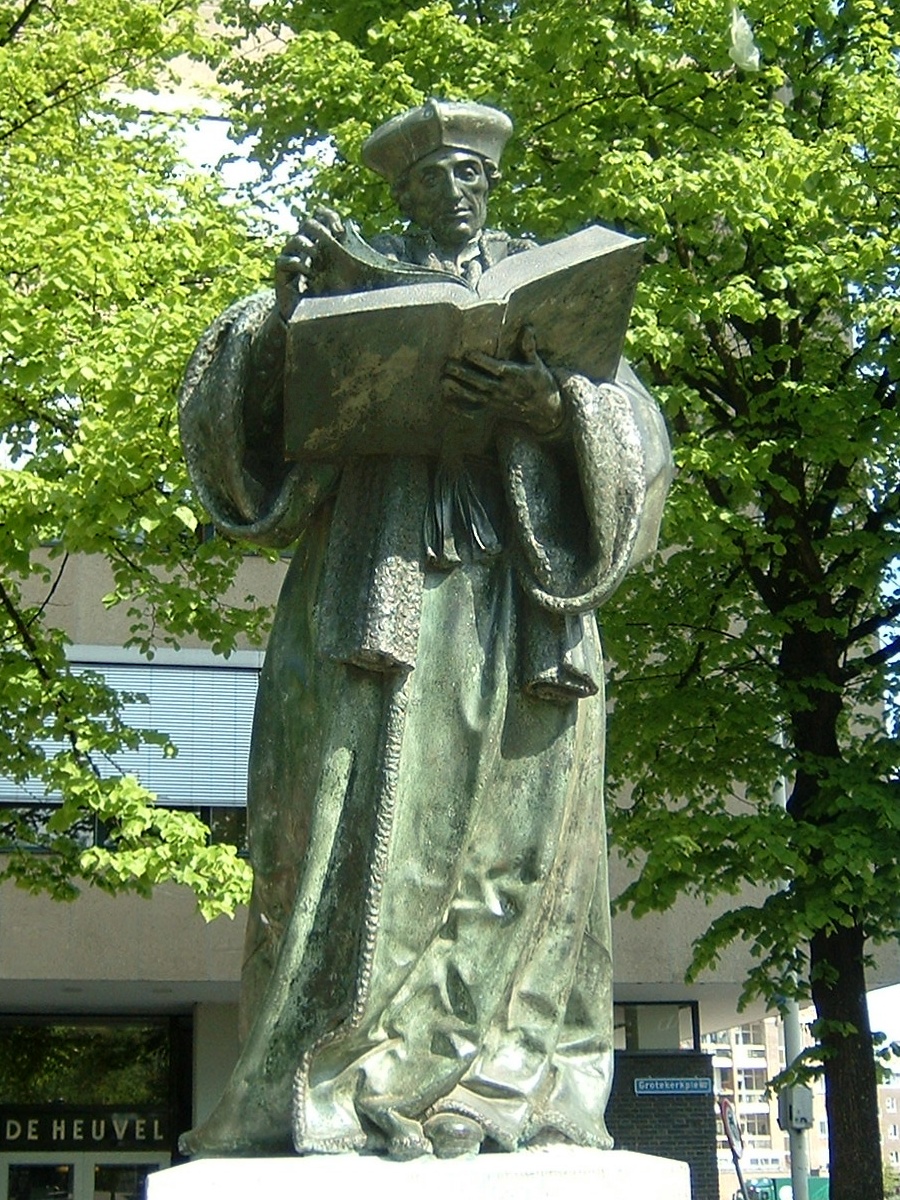 Statue of Erasmus in Rotterdam. Gilded bronze statue by Hendrick de Keyser (1622), replacing a stone (1557), and a wooden (1549). Desiderius Erasmus is reported to have been born in Rotterdam on 27 or 28 October ("the vigil of Simon and Jude")[4] in the late-1460s. He was named[note 1] after Erasmus of Formiae, whom Erasmus' father Gerard (Gerardus Helye)[5] personally favored.[6][7] Although associated closely with Rotterdam, he lived there for only four years, never to return afterwards. The year of Erasmus' birth is unclear: in later life he calculated his age as if born in 1466, but frequently his remembered age at major events actually implies 1469.[8][9]: 8 (This article currently gives 1466 as the birth year.[10][11] To handle this disagreement, ages are given first based on 1469, then in parentheses based on 1466: e.g., "20 (or 23)".) Furthermore, many details of his early life must be gleaned from a fictionalized third-person account he wrote in 1516 (published in 1529) in a letter to a fictitious Papal secretary, Lambertus Grunnius ("Mr. Grunt").[12] His parents could not be legally married: his father, Gerard, was a Catholic priest[13] who may have spent up to six years in the 1450s or 60s in Italy as a scribe and scholar.[14]: 196 His mother was Margaretha Rogerius (Latinized form of Dutch surname Rutgers),[15] the daughter of a doctor from Zevenbergen. She may have been Gerard's housekeeper.[13][16] Although he was born out of wedlock, Erasmus was cared for by his parents, with a loving household and the best education, until their early deaths from the bubonic plague in 1483. His only sibling Peter might have been born in 1463, and some writers suggest Margaret was a widow and Peter was the half-brother of Erasmus; Erasmus on the other side called him his brother.[9] There were legal and social restrictions on the careers and opportunities open to the children of unwed parents. Erasmus' own story, in the possibly forged 1524 Compendium vitae Erasmi was along the lines that his parents were engaged, with the formal marriage blocked by his relatives (presumably a young widow or unmarried mother with a child was not an advantageous match); his father went to Italy to study Latin and Greek, and the relatives mislead Gerard that Margaretha had died, on which news grieving Gerard romantically took Holy Orders, only to find on his return that Margaretha was alive; many scholars dispute this account.[17]: 89 In 1471 his father became the vice-curate of the small town of Woerden (where young Erasmus may have attended the local vernacular school to learn to read and write) and in 1476 was promoted to the vice-curate of Gouda.[5] Erasmus was given the highest education available to a young man of his day, in a series of monastic or semi-monastic schools. In 1476, at the age of 6 (or 9), his family moved to Gouda and he started at the school of Mr Pieter Winckel,[5] who later became his guardian (and, perhaps, diverted Erasmus and Peter's inheritance.) (Historians who date his birth in 1466 have Erasmus in Utrecht at the choir school at this period.[18]) In 1478, at the age of 9 (or 12), he and his older brother Peter were sent to one of the best Latin schools in the Netherlands, located at Deventer and owned by the chapter clergy of the Lebuïnuskerk (St. Lebuin's Church).[10] Towards the end of his stay there the curriculum was renewed by the new principal of the school, Alexander Hegius, a correspondent of pioneering rhetorician Rudolphus Agricola. For the first time in Europe north of the Alps, Greek was taught at a lower level than a university[19] and this is where he began learning it.[20] His education there ended when plague struck the city about 1483,[21] and his mother, who had moved to provide a home for her sons, died from the infection. Following the death of his parents and 20 students at his school[9] he moved back to his patria (Rotterdam?)[5] where he was supported by Berthe de Heyden,[22] a compassionate widow.[9] 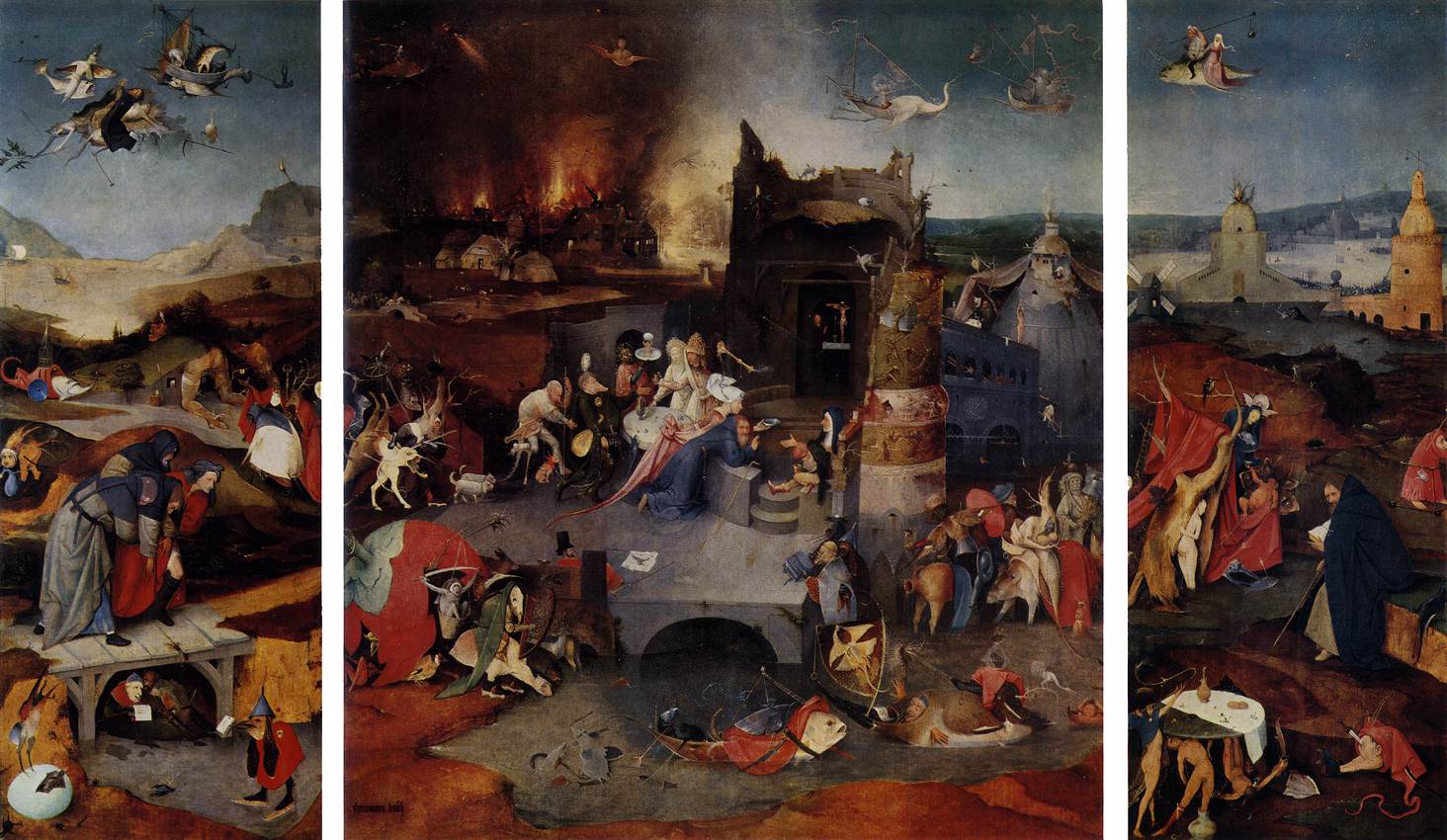 Hieronymous Bosch, Temptation of St Anthony, triptych (c. 1501), painted in 's-Hertogenbosch, later owned by friend Damião de Gois In 1484, around the age 14 (or 17), he and his brother went to a cheaper[23] grammar school or seminary at 's-Hertogenbosch run by the Brethren of the Common Life:[24][note 2] Erasmus' Epistle to Grunnius satirizes them as the "Collationary Brethren"[12] who select and sort boys for monkhood. He was exposed there to the Devotio moderna movement and the Brethren's famous book The Imitation of Christ but resented the harsh rules and strict methods of the religious brothers and educators.[10] The two brothers made an agreement that they would resist the clergy but attend the university;[22] Erasmus longed to study in Italy, the birthplace of Latin, and have a degree from an Italian university.[8]: 804 Instead, Peter left for the Augustinian canonry in Stein, which left Erasmus feeling betrayed.[22] Around this time he wrote forlornly to his friend Elizabeth de Heyden "Shipwrecked am I, and lost, 'mid waters chill'."[9] He suffered Quartan fever for over a year. Eventually Erasmus moved to the same abbey as a postulant in or before 1487,[5] around the age of 16 (or 19.)[note 3] Vows, ordination and canonry experience 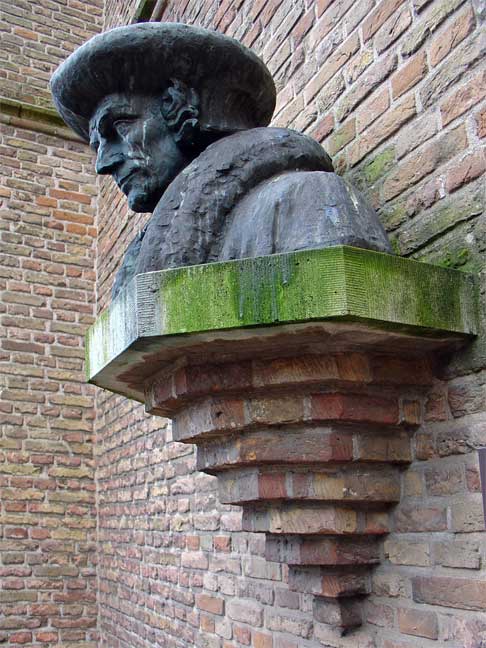 Bust by Hildo Krop (1950) in Gouda, where Erasmus spent his youth Poverty[25] had forced Erasmus into the consecrated life, entering the novitiate in 1487[26] at the canonry at rural Stein, very near Gouda, South Holland: the Chapter of Sion community largely borrowed its rule from the larger monkish Congregation of Windesheim.[note 4] In 1488–1490, the surrounding region was plundered badly by armies fighting the Jonker Fransen war of succession and then suffered a famine.[8]: 759 Erasmus professed his vows as a Canon Regular of St. Augustine[note 5] there in late 1488 at age 19 (or 22).[26] Historian Fr. Aiden Gasquet later wrote: "One thing, however, would seem to be quite clear; he could never have had any vocation for the religious life. His whole subsequent history shows this unmistakeably."[30] According to one Catholic biographer, Erasmus had a spiritual awakening at the monastery.[31] Certain abuses in religious orders were among the chief objects of his later calls to reform the Western Church from within, particularly coerced or tricked recruitment of immature boys (the fictionalized account in the Letter to Grunnius calls them "victims of Dominic and Francis and Benedict"): Erasmus felt he had belonged to this class, joining "voluntarily but not freely" and so considered himself, if not morally bound by his vows, certainly legally, socially and honour- bound to keep them, yet to look for his true vocation.[27]: 439 While at Stein, 18-(or 21-)year-old Erasmus fell in unrequited love, forming what he called a "passionate attachment" (Latin: fervidos amores), with a fellow canon, Servatius Rogerus,[note 6] and wrote a series of love letters[note 7][33] in which he called Rogerus "half my soul",[note 8] writing that "it was not for the sake of reward or out of a desire for any favour that I have wooed you both unhappily and relentlessly. What is it then? Why, that you love him who loves you."[34][note 9] This correspondence contrasts with the generally detached and much more restrained attitude he usually showed in his later life, though he had a capacity to form and maintain deep male friendships,[note 10] such as with More, Colet, and Ammonio.[note 11] No mentions or sexual accusations were ever made of Erasmus during his lifetime. His works notably praise moderate sexual desire in marriage between men and women.[35] Circle of Latin Secretaries Juan de Vergara • Pietro Carmeliano[36] • Guillaume Budé • Pietro Bembo • Jacopo Sadoleto • Richard Pace • Andrea Ammonio • Hieronymus Emser • Cornelius Grapheus • Johannes Secundus • Juan de Valdés, Alfonso de Valdés • Peter Vannes • Gentian Hervetus • Jan Łaski • Lambert Grunnius (fictitious)[12]: 337 Latin Secretaries became a significant part of Erasmus' later network of correspondents and friends.[note 12] In 1493, his Prior arranged for him to leave the Stein house[38] and take up the post of Latin Secretary to the ambitious Bishop of Cambrai, Henry of Bergen, on account of his great skill in Latin and his reputation as a man of letters.[39][note 13] He was ordained to the Catholic priesthood either on 25 April 1492,[25] or 25 April 1495, at age 25 (or 28.)[note 14] Either way, he did not actively work as a choir priest for very long,[41] though his many works on confession and penance suggests experience of dispensing them. From 1500, he avoided returning to the canonry at Stein even insisting the diet and hours would kill him,[note 15] though he did stay with other Augustinian communities and at monasteries of other orders in his travels. Rogerus, who became prior at Stein in 1504, and Erasmus corresponded over the years, with Rogerus demanding Erasmus return after his studies were complete. Nevertheless, the library of the canonry[note 16] ended up with by far the largest collection of Erasmus' publications in the Gouda region.[42] In 1505 Pope Julius II granted a dispensation from the vow of poverty to the extent of allowing Erasmus to hold certain benefices, and from the control and habit of his order, though he remained a priest and, formally, an Augustinian canon regular[note 17] the rest his life.[27] In 1517 Pope Leo X granted legal dispensations for Erasmus' defects of natality[note 18] and confirmed the previous dispensation, allowing the 48-(or 51-)year-old his independence[43] but still, as a canon, capable of holding office as a prior or abbot.[27] ↓Birth? ↓Orphaned ↓Vows ↓Ordained? ↓Dispensations ↓ ↓Death ↓ ↓ Netherlands France Italy England Brabant Basel Freiburg England Brabant England France Basel Basel England Basel England Basel │ 1465 │ 1475 │ 1485 │ 1495 │ 1505 │ 1515 │ 1525 │ 1535  Approximate timeline of Erasmus Many of Erasmus' convictions seem to spring from his early biography: esteem for the married state and appropriate marriages, support for priestly marriage, concern for improving marriage prospects for females, opposition to inconsiderate rules notably institutional dietary rules, a desire to make education engaging for the participants, interest in classical languages, horror of poverty and spiritual hopelessness, distaste for friars begging when they could study or work, unwillingness to be in the control of authorities, laicism, the need for those in authority to act in the best interest of their charges, a prizing of mercy and peace, an anger over unnecessary war especially between avaricious princes, an awareness of mortality, etc. Travels Cities and Routes of Erasmus Oxford, Cambridge London Reading Canterbury Deventer Woerden Calais Stein, Gouda Rotterdam St Omer 's-Hertogenbosch Paris, Cambrai Brussels, Antwerp Orléans Louvain Turin Cologne Bologna Mainz Strasbourg Florence Freiburg im Breisgau Sienna, Padua Basel Rome, Venice Konstanz Cumae Green: early life Dark circles: residence Thin line: Alpine crossing Blue lines: Rhine and English Channel Erasmus traveled widely and regularly, for reasons of poverty, "escape" from his Stein canonry (to Cambrai), education (to Paris, Turin), escape from the sweating sickness plague (to Orléans), employment (to England), searching libraries for manuscripts, writing (Brabant), royal counsel (Cologne), patronage, tutoring and chaperoning (North Italy), networking (Rome), seeing books through printing in person (Paris, Venice, Louvain, Basel), and avoiding the persecution of religious fanatics (to Freiburg.) He enjoyed horseback riding[44] 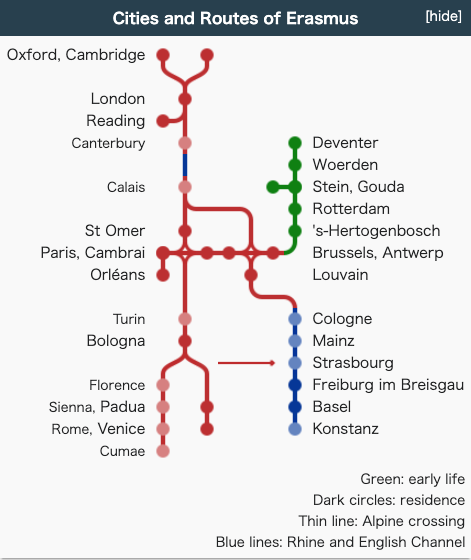 Paris In 1495 with Bishop Henry's consent and a stipend, Erasmus went on to study at the University of Paris in the Collège de Montaigu, a centre of reforming zeal,[note 19] under the direction of the ascetic Jan Standonck, of whose rigors he complained.[45] The university was then the chief seat of Scholastic learning but already coming under the influence of Renaissance humanism.[46] For instance, Erasmus became an intimate friend of an Italian humanist Publio Fausto Andrelini, poet and "professor of humanity" in Paris.[47] During this time, Erasmus developed a deep aversion to exclusive or excessive Aristotelianism and Scholasticism[48] and started finding work as a tutor/chaperone to visiting English and Scottish aristocrats. England English circle.[49] Thomas More • John Colet • Thomas Linacre • William Grocyn • William Lily • Andrea Ammonio • Juan Luis Vives • Cuthbert Tunstall • Henry Bullock • Thomas Lupset • Richard Foxe • Christopher Urswick • Robert Aldrich • Richard Whitford • Lorenzo Campeggio • Richard Reynolds • Polydore Vergil Patrons: William Blount • William Warham • John Fisher • John Longland • Margaret Beaufort • Catherine of Aragon "I can truly say that no place in the world has given me so many friends—true, learned, helpful, and illustrious friends—as the single city of London." Letter to Colet, 1509[30] Erasmus stayed in England at least three times.[note 20] In between he had periods studying in Paris, Orléans, Leuven and other cities. 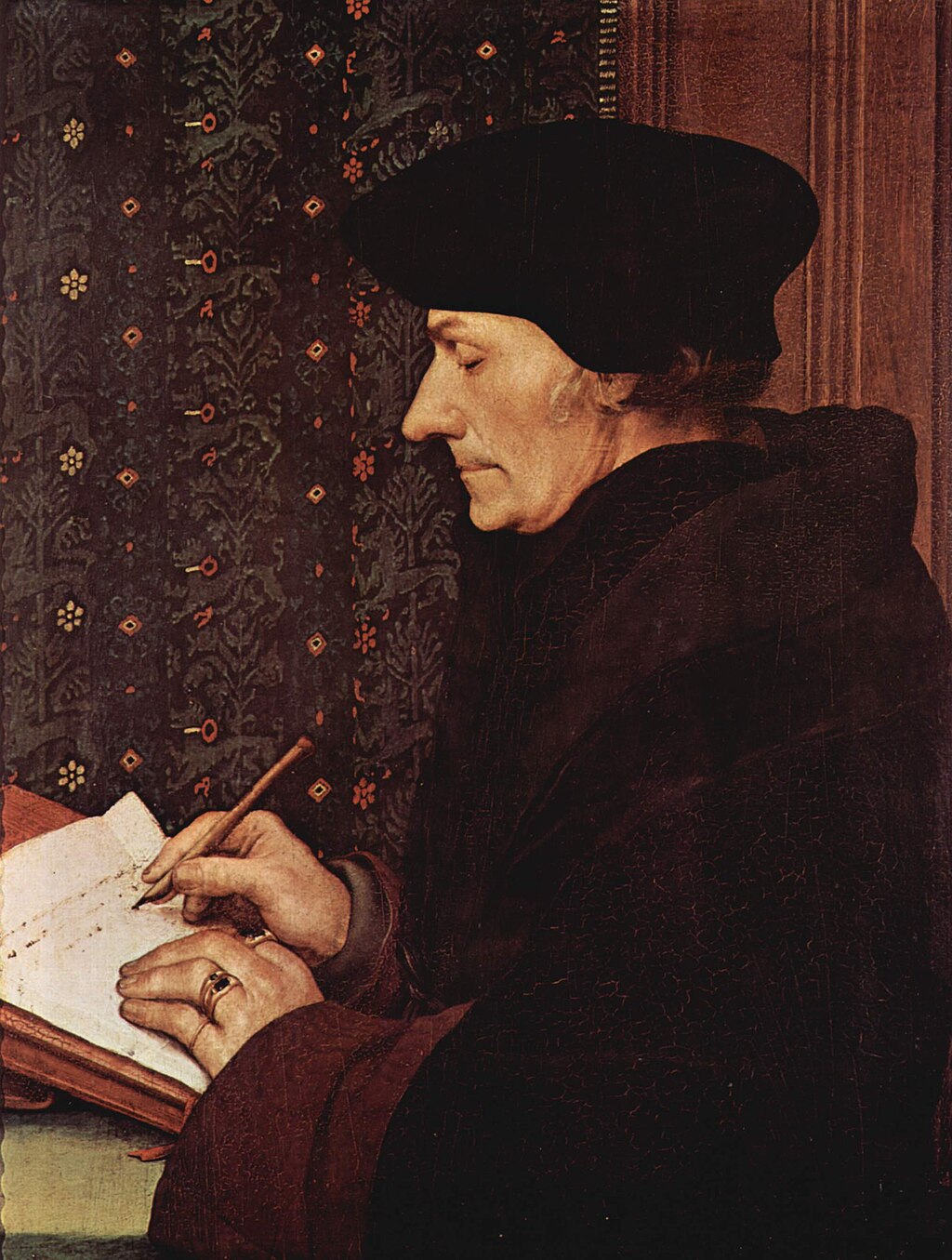 Erasmus by Hans Holbein the Younger. Louvre, Paris. First visit - 1499-1500 In 1499 he was invited to England by William Blount, 4th Baron Mountjoy, who offered to accompany him on his trip to England.[50] His time in England was fruitful in the making of lifelong friendships with the leaders of English thought in the days of King Henry VIII. During his first visit to England in 1499, he studied or taught at the University of Oxford. Erasmus was particularly impressed by the Bible teaching of John Colet, who pursued a style more akin to the church fathers than the Scholastics. Through the influence of the humanist John Colet, his interests turned towards theology.[50] Other distinctive features of Colet's thought that may have influenced Erasmus are his pacifism,[51] reform-mindedness,[52] anti-Scholasticism and pastoral esteem for the sacrament of Confession.[53]: 94 This prompted him, upon his return from England to Paris, to intensively study the Greek language, which would enable him to study theology on a more profound level.[54]: 518 Erasmus also became fast friends with Thomas More, a young law student considering becoming a monk, whose thought (e.g., on conscience and equity) had been influenced by 14th century French theologian Jean Gerson,[55][56] and whose intellect had been developed by his powerful patron Cardinal John Morton (d. 1500) who had famously attempted reforms of English monasteries.[57] Erasmus left London with a full purse from his generous friends, to allow him to complete his studies. However, he had been provided with bad legal advice by his friends: the English Customs officials confiscated all the gold and silver, leaving him with nothing except a night fever that lasted several months. Second visit - 1505-1506 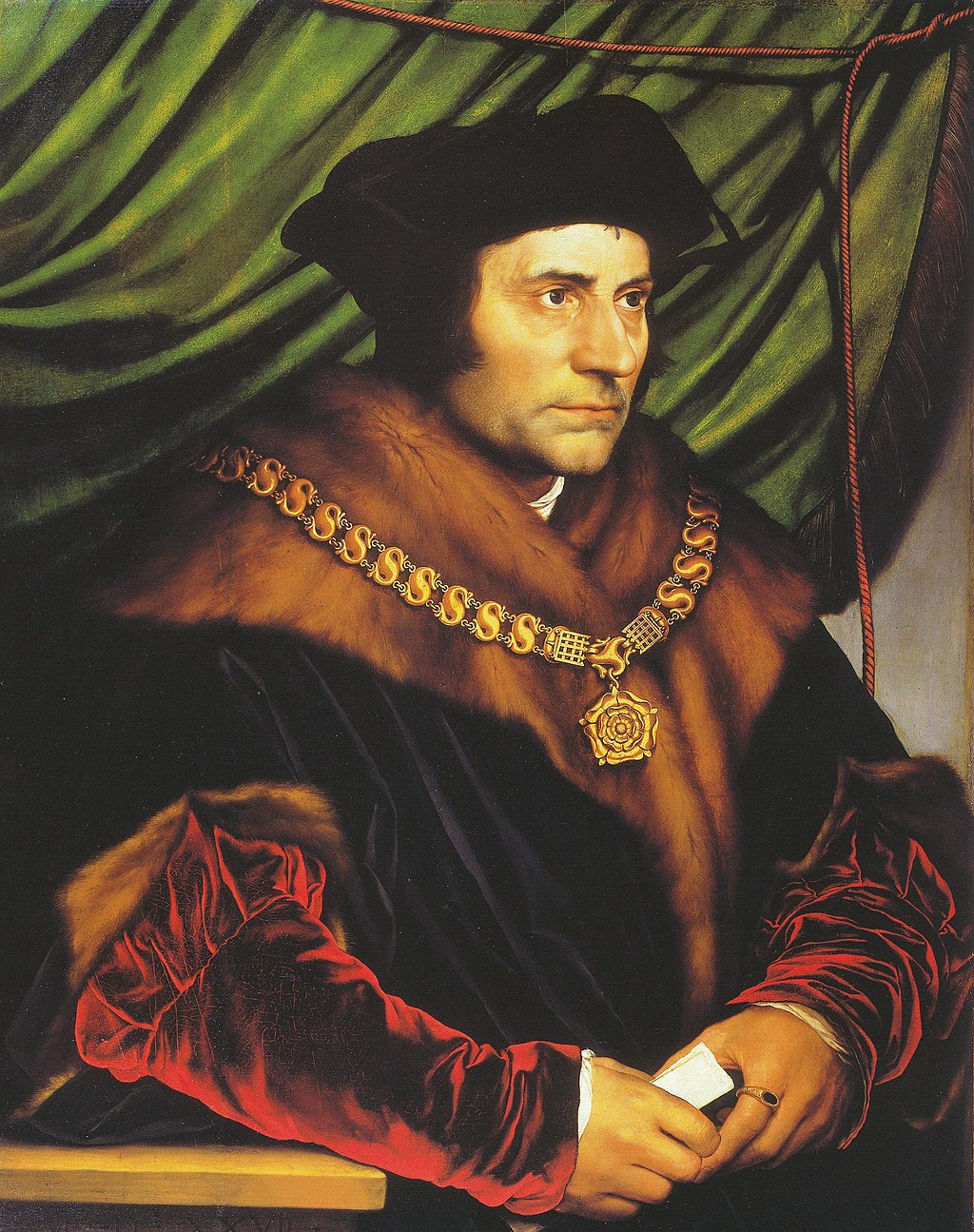 Sir Thomas More, by Hans Holbein the Younger For Erasmus' second visit, he spent over a year staying at recently married Thomas More's house, now a lawyer and Member of Parliament, honing his translation skills.[49] Erasmus preferred to live the life of an independent scholar and made a conscious effort to avoid any actions or formal ties that might inhibit his individual freedom.[58] In England Erasmus was approached with prominent offices but he declined them all, until the King himself offered his support.[58] He was inclined, but eventually did not accept and longed for a stay in Italy.[58] Third visit - 1510-1515 In 1510, Erasmus arrived at More's bustling house, was parked in bed to recover from his recurrent illness, and wrote The Praise of Folly, which was to be a best-seller. More was at that time the undersheriff of the City of London. After his glorious reception in Italy, Erasmus had returned broke and jobless,[note 21] with strained relations with former friends and benefactors on the continent, and he regretted leaving Italy, despite being horrified by papal warfare. There is a gap in his usually voluminous correspondence: his so-called "two lost years", perhaps due to self-censorship of dangerous or disgruntled opinions;[note 11] he shared lodgings with his friend Andrea Ammonio (Latin secretary to Mountjoy, and the next year, to Henry VIII) provided at the London Austin Friars' compound, skipping out after a disagreement with the friars over rent that caused bad blood.[note 22] He assisted his friend John Colet by authoring Greek textbooks and securing members of staff for the newly established St Paul's School[60] and was in contact when Colet gave his notorious 1512 Convocation sermon which called for a reformation of ecclesiastical affairs.[61]: 230–250 At Colet's instigation, Erasmus started work on De copia. In 1511, the University of Cambridge's Chancellor John Fisher arranged for Erasmus to be the Lady Margaret's Professor of Divinity, though Erasmus turned down the option of spending the rest of his life as a professor there. He studied and taught Greek and researched and lectured on Jerome.[49][note 23] Erasmus mainly stayed at Queens' College while lecturing at the university,[63] between 1511 and 1515.[note 24] Erasmus' rooms were located in the "I" staircase of Old Court.[64] Despite a chronic shortage of money, he succeeded in mastering Greek by an intensive, day-and-night study of three years, taught by Thomas Linacre, continuously begging in letters that his friends send him books and money for teachers.[65] Erasmus suffered from poor health and was especially concerned with heating, clean air, ventilation, draughts, fresh food and unspoiled wine: he complained about the draughtiness of English buildings.[66] He complained that Queens' College could not supply him with enough decent wine[note 25] (wine was the Renaissance medicine for gallstones, from which Erasmus suffered).[67] As Queens' was an unusually humanist-leaning institution in the 16th century, Queens' College Old Library still houses many first editions of Erasmus's publications, many of which were acquired during that period by bequest or purchase, including Erasmus's New Testament translation, which is signed by friend and Polish religious reformer Jan Łaski.[68] By this time More was a judge on the poorman's equity court (Master of Requests) and a Privy Counsellor. France and Brabant French circle Jean Vitrier (or Vourier) • Jacob/James Batt • Publio Fausto Andrelini • Josse Bade • Louis de Berquin • Robert Fisher • Richard Whitford • Guillaume Budé • Thomas Grey • Hector Boece • Robert Gaguin Opponents: Noël Béda Patrons: Bishop Henry of Bergen,Thomas Grey, Lady of Veere Following his first trip to England, Erasmus returned first to poverty in Paris, where he started to compile the Adagio for his students, then to Orleans to escape the plague, and then to semi-monastic life, scholarly studies and writing in France, notably at the Benedictine Abbey of Saint Bertin at St Omer (1501,1502) where he wrote the initial version of the Enchiridion (Handbook of the Christian Knight.) A particular influence was his encounter in 1501 with Jean (Jehan) Vitrier, a radical Franciscan who consolidated Erasmus' thoughts against excessive valorization of monasticism,[53]: 94, 95 ceremonialism[note 26] and fasting[note 27] in a kind of conversion experience,[14]: 213, 219 and introduced him to Origen.[70] In 1502, Erasmus went to Brabant, ultimately to the university at Louvain, then back to Paris in 1504. Italy Italian circle Aldus Manutius • Giulio Camillo • Alexander Stewart • Pietro Bembo • Bombasius • Marcus Musurus • Janus Lascaris • Giles of Viterbo • Egnazio • Germain de Brie • Ferry Carondelet • Urbano Valeriani • Tommaso Inghiram • Carteromachus Opponents: Aleander, Alberto Pío, Sepúlveda Patrons: Popes Leo X, Adrian VI, Clement VII, Paul III, King James IV In 1506 he was able to accompany and tutor the sons of the personal physician of the English King through Italy to Bologna.[58] His discovery en route of Lorenzo Valla's New Testament Notes was a major event in his career and prompted Erasmus to study the New Testament using philology.[71] In 1506 they passed through Turin and he arranged to be awarded the degree of Doctor of Sacred Theology (Sacra Theologia)[72]: 638 from the University of Turin per saltum[58] at age 37 (or 40.) Erasmus stayed tutoring in Bologna for a year; in the Winter, Erasmus was present when Pope Julius II entered victorious into the conquered Bologna which he had besieged before.[58] 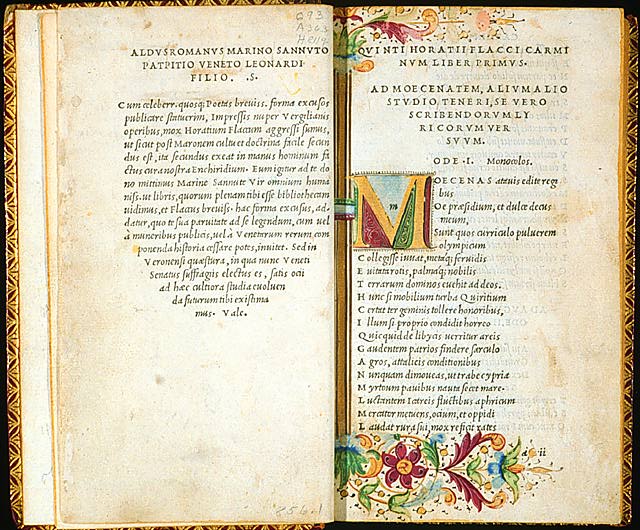 Book printed and illuminated at Aldine press, Venice (1501), Horace, Works Erasmus traveled on to Venice, working on an expanded version of his Adagia at the Aldine Press of the famous printer Aldus Manutius, advised him which manuscripts to publish,[73] and was an honorary member of the graecophone Aldine "New Academy" (Greek: Neakadêmia (Νεακαδημία)).[74] From Aldus he learned the in-person workflow that made him productive at Froben: making last-minute changes, and immediately checking and correcting printed page proofs as soon as the ink had dried. Aldus wrote that Erasmus could do twice as much work in a given time as any other man he had ever met.[30] In 1507, according to his letters, he studied advanced Greek in Padua with the Venetian natural philosopher, Giulio Camillo.[75] He found employment tutoring and escorting Scottish nobleman Alexander Stewart, the 24-year old Archbishop of St Andrews, through Padua, Florence, and Siena[note 28] Erasmus made it to Rome in 1509, visiting some notable libraries and cardinals, but having a less active association with Italian scholars than might have been expected. In 1510, William Warham, Archbishop of Canterbury, and Lord Mountjoy lured him back to England, now under its new humanist king, paying £10 journey money.[77] On his trip back over the Alps, down the Rhein, to England, Erasmus mentally composed The Praise of Folly. Brabant (Flanders) Burgundy/Louvain circle Adrian of Utrecht • Pieter Gillis • Martin Dorp • Hieronymus van Busleyden • Albrecht Dürer • Dirk Martens • Nicolas Cleynaerts • Cornelius Grapheus Opponents: Latomus • Edward Lee • Ulrich von Hutten • Nicolaas Baechem (Egmondanus) Patrons: Charles V His residence at Leuven, where he lectured at the University, exposed Erasmus to much criticism from those ascetics, academics and clerics hostile to the principles of literary and religious reform to which he was devoting his life.[78] In 1514, en route to Basel, he made the acquaintance of Hermannus Buschius, Ulrich von Hutten and Johann Reuchlin who introduced him to the Hebrew language in Mainz.[79] In 1514, he suffered a fall from his horse and injured his back. 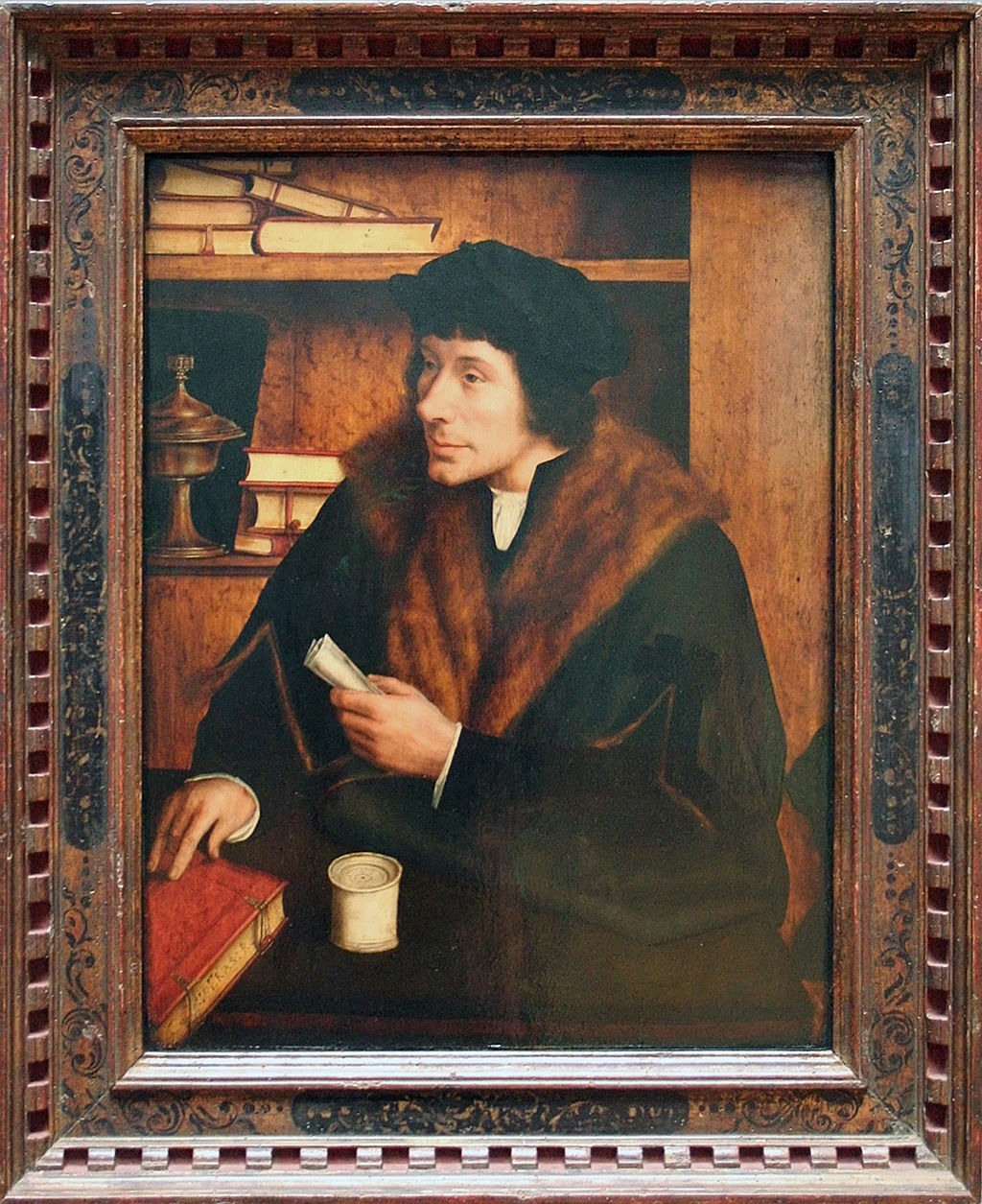 Quinten Massijs - Portrait of Peter Gillis or Gilles (1517), half of a diptych with portrait of Erasmus below, painted as a gift from them for Thomas More.[80] Erasmus may have made several other short visits to England or English territory while living in Brabant.[49] Happily for Erasmus, More and Tunstall were posted in Brussels or Antwerp on government missions around 1516, More for six months, Tunstall for longer. Their circle include Pieter Gillis of Antwerp, in whose house Thomas More's wrote Utopia (pub. 1516) with Erasmus' encouragement,[note 29] Erasmus editing and perhaps even contributing fragments.[82] However, in 1517, his great friend Ammonio died in England of the Sweating Sickness. Erasmus had accepted an honorary position as a Councillor to Charles V with an annuity of 200 guilders,[83] and tutored his brother, the teenage future Holy Roman Emperor Ferdinand of Hapsburg. At this time he wrote The Education of a Christian Prince (Institutio principis Christiani). In 1517, he supported the foundation at the university of the Collegium Trilingue for the study of Hebrew, Latin, and Greek[84]: s1.14.14 —after the model of Cisneros' College of the Three Languages at the University of Alcalá—financed by his late friend Hieronymus van Busleyden's will.[85] 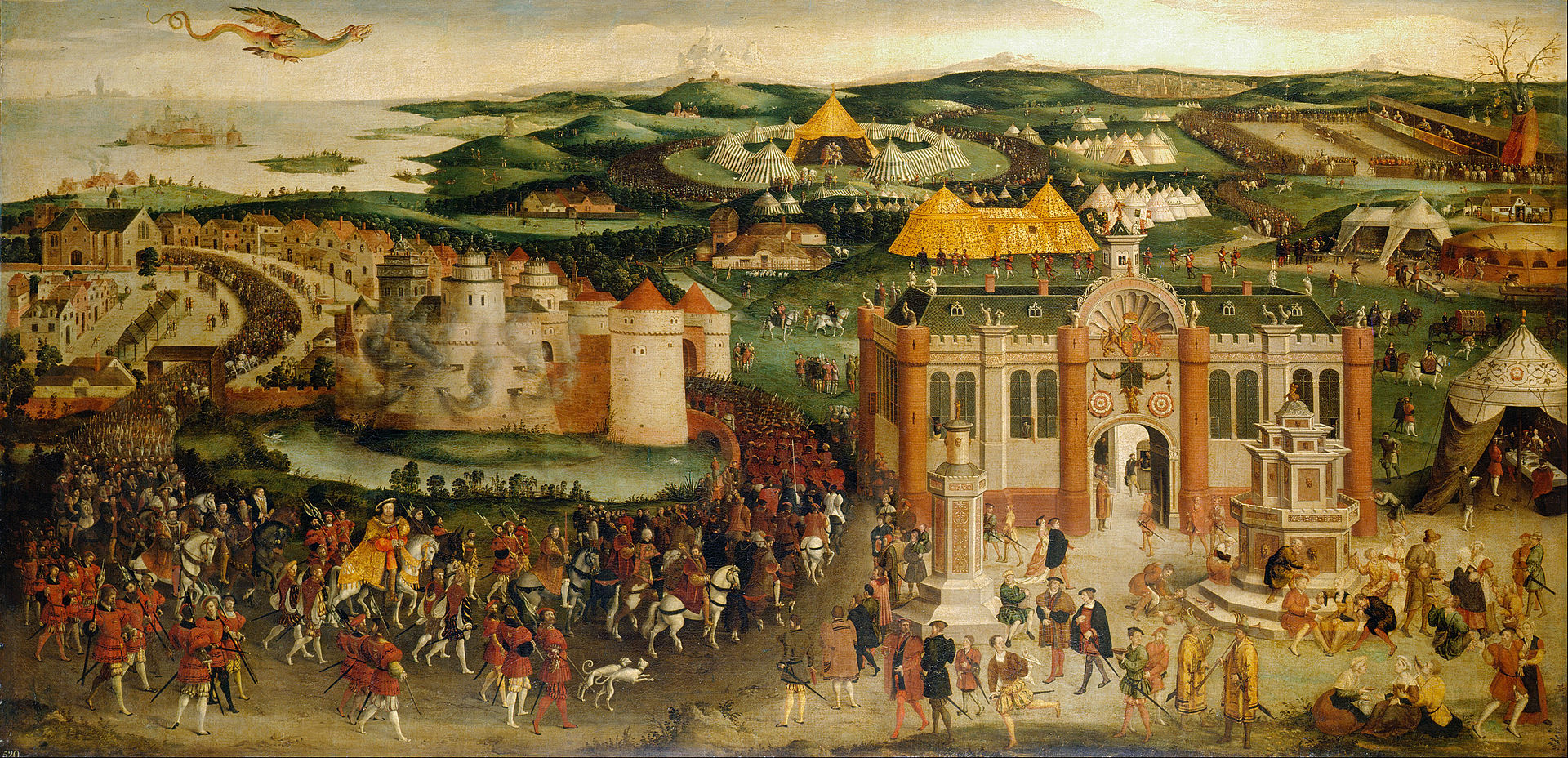 Field of the Cloth of Gold, w. Henry VIII (British - prev. attrib. Hans Holbein the Younger) In 1520 he was present at the Field of the Cloth of Gold with Guillaume Budé, probably his last meetings with Thomas More[86] and William Warham. His friends and former students and old correspondents were the incoming political elite, and he had risen with them.[note 30] He stayed in various locations including Anderlecht (near Brussels) in the Summer of 1521.[87] Basel Swiss circle[88]: 56, 63 Johannes Froben • Hieronymus Froben • Beatus Rhenanus • Bonifacius Amerbach • Bruno Amerbach • Hans Holbein the Younger • Simon Grynaeus • Sebastian Brandt • Wolfgang Capito • Damião de Góis • Gilbert Cousin • Jakob Näf • Augustinus Marius Opponents: Œcolampadius Patrons: Antoine I. de Vergy, Christoph von Utenheim  Desiderius Erasmus dictating to his ammenuensis Gilbert Cousin or Cognatus. From a book by Cousin, and itself claimed to be based on fresco in Cousin's house in Nozeroy, Burgundy. Engraving possibly by fr:Claude Luc. From 1514, Erasmus regularly traveled to Basel to coordinate the printing of his books with Froben. He developed a lasting association with the great Basel publisher Johann Froben and later his son Hieronymus Froben (Eramus' godson) who together published over 200 works with Erasmus,[89] working with expert scholar-correctors who went on to illustrious careers.[88] His initial interest in Froben's operation was aroused by his discovery of the printer's folio edition of the Adagiorum Chiliades tres (Adagia) (1513).[90] Froben's work was notable for using the new Roman type (rather than blackletter) and Aldine-like Italic and Greek fonts, as well as elegant layouts using borders and fancy capitals;[88]: 59 Hans Holbein (the Younger) cut several woodblock capitals for Erasmus' editions. The printing of many his books was supervised by his Alsatian friend, the Greek scholar Beatus Rhenanus.[note 31] In 1521 he settled in Basel.[91] He was weary of the controversies and hostility at Louvain, and feared being dragged further into the Lutheran controversy.[92] He agreed to be the Froben press' literary superintendent writing dedications and prefaces[30] for an annuity and profit share.[62] Apart from Froben's production team, he had his own household[note 32]with a formidable housekeeper, stable of horses, and up to eight boarders or paid servants: who acted as assistants, correctors, amanuenses, dining companions, international couriers, and carers.[94] It was his habit to sit at times by a ground-floor window, to make it easier to see and be seen by strolling humanists for chatting.[95] In collaboration with Froben and his team, the scope and ambition of Erasmus' Annotations, Erasmus' long-researched project of philological notes of the New Testament along the lines of Valla's Adnotations, had grown to also include a lightly revised Latin Vulgate, then the Greek text, then several edifying essays on methodology, then a highly revised Vulgate—all bundled as his Novum testamentum omne and pirated individually throughout Europe— then finally his amplified Paraphrases. 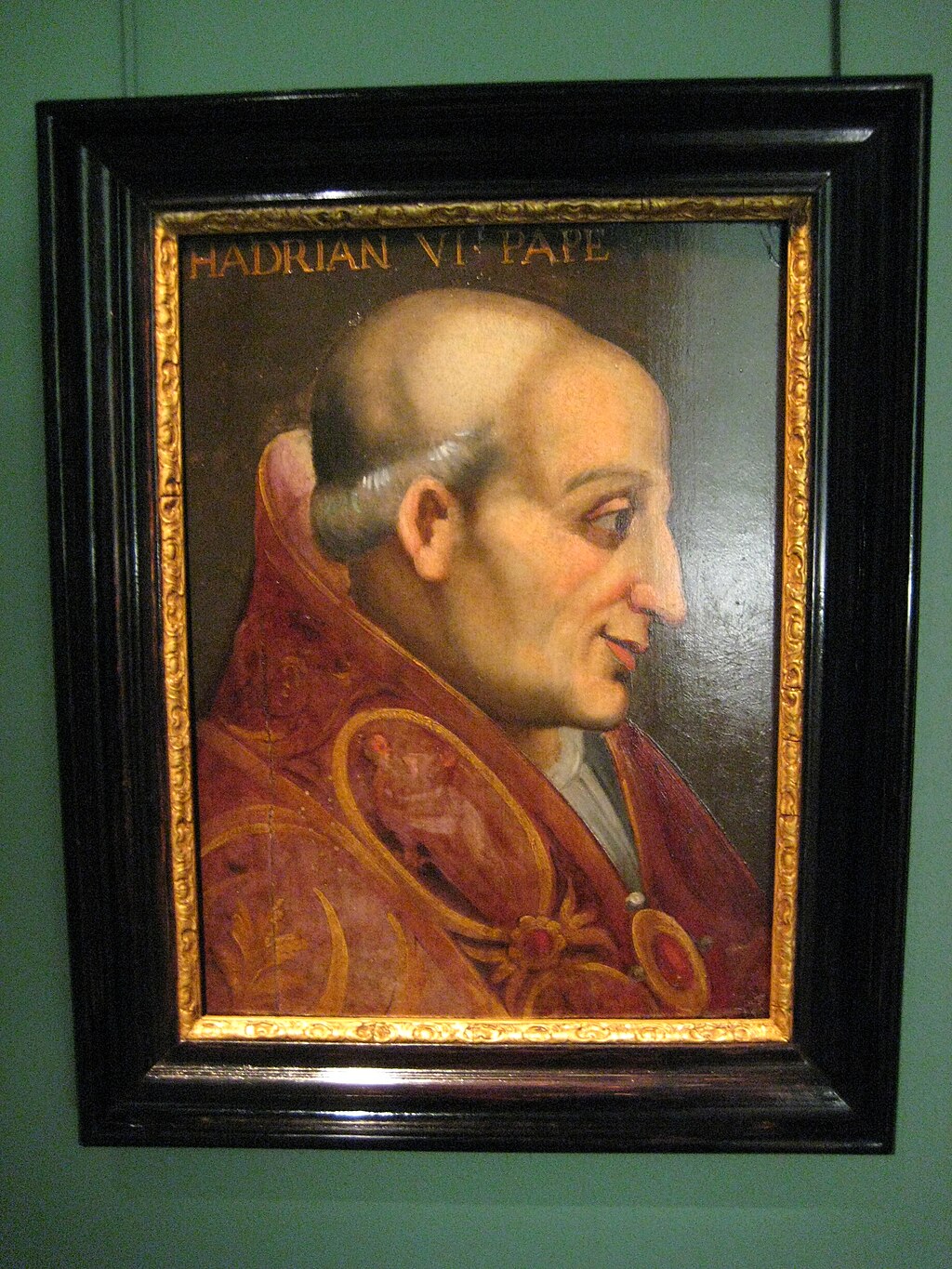 Pope Adrian VI (1522-1523) In 1522, Erasmus' compatriot, former teacher (c. 1502) and friend from University of Louvain unexpectedly became Pope Adrian VI,[note 33] after having served as Regent (and/or Grand Inquisitor) of Spain for six years. Like Erasmus and Luther, he had been influenced by the Brethren of the Common Life. He tried to entice Erasmus to Rome. His reforms of the Roman Curia which he hoped would meet the objections of many Lutherans were stymied (party because the Holy See was broke), though re-worked at the Council of Trent, and he died in 1523.[97] As the popular and nationalist responses to Luther gathered momentum, the social disorders, which Erasmus dreaded and Luther disassociated himself from, began to appear, including the German Peasants' War (1524–1525), the Anabaptist insurrections in Germany and in the Low Countries, iconoclasm, and the radicalisation of peasants across Europe. If these were the outcomes of reform, Erasmus was thankful that he had kept out of it. Yet he was ever more bitterly accused of having started the whole "tragedy" (as Erasmus dubbed the matter).[note 34] In 1523, he provided financial support to the impoverished and disgraced former Latin Secretary of Antwerp Cornelius Grapheus, on his release from the newly introduced Inquisition.[98]: 558 In 1525, a former student of Erasmus who had served at Erasmus' father's former church at Woerden, Jan de Bakker (Pistorius) was the first priest to be executed as a heretic in the Netherlands. In 1529, his French translator and friend Louis de Berquin was burnt in Paris, following his condemnation as an anti-Rome heretic by the Sorbonne theologians. Freiburg  Portrait of Damião de Góis by Albrecht Dürer Following iconoclastic rioting in 1529 led by Œcolampadius his former assistant,[note 35] the city of Basel definitely adopted the Reformation, and banned the Catholic mass on April 1, 1529.[99] Erasmus left Basel on the 13 April 1529 and departed by ship to the Catholic university town of Freiburg im Breisgau to be under the protection of his former student, Archduke Ferdinand of Austria,[14]: 210 staying for two years on the top floor of the Whale House,[100] then buying and refurbishing a house of his own,[note 36] where he took in scholar/assistants as table-boarders[101] such as Cornelius Grapheus' friend Damião de Góis, some of them fleeing persecution. Despite increasing frailty[note 37] Erasmus continued to work productively, notably on a new magnum opus, his manual on preaching Ecclesiastes, and his small book on preparing for death. His boarder for five months, the Portuguese scholar/diplomat Damião de Góis,[98] worked on his lobbying on the plight of the Sámi in Sweden and the Ethiopian church, and stimulated[103]: 82 Erasmus' increasing awareness of foreign missions.[note 38] There are no extant letters between More and Erasmus from the start of More's period as Chancellor until his resignation (1529–1523), almost to the day. Erasmus wrote several important non-political works under the surprising patronage of Thomas Bolyn: his Ennaratio triplex in Psalmum XXII or Triple Commentary on Psalm 23 (1529); his catechism to counter Luther Explanatio Symboli or A Playne and Godly Exposition or Declaration of the Commune Crede (1533) which sold out in three hours at the Frankfurt Book Fair, and Praeparatio ad mortem or Preparation for Death (1534) which would be one of Erasmus' most popular and most hijacked works.[105][note 39] Fates of Friends 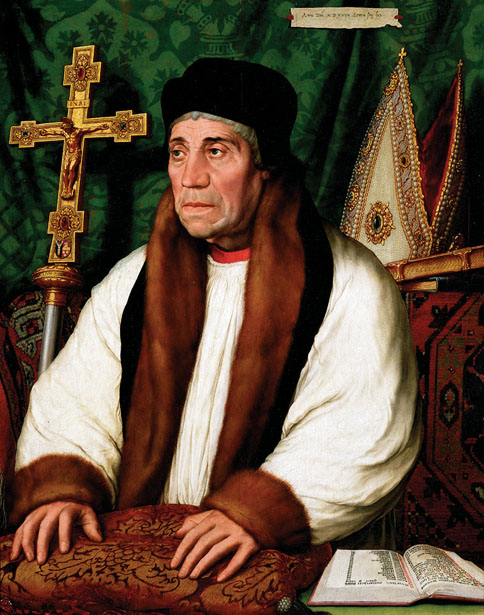 William Warham (c.1450–1532), Archbishop of Canterbury, after Hans Holbein 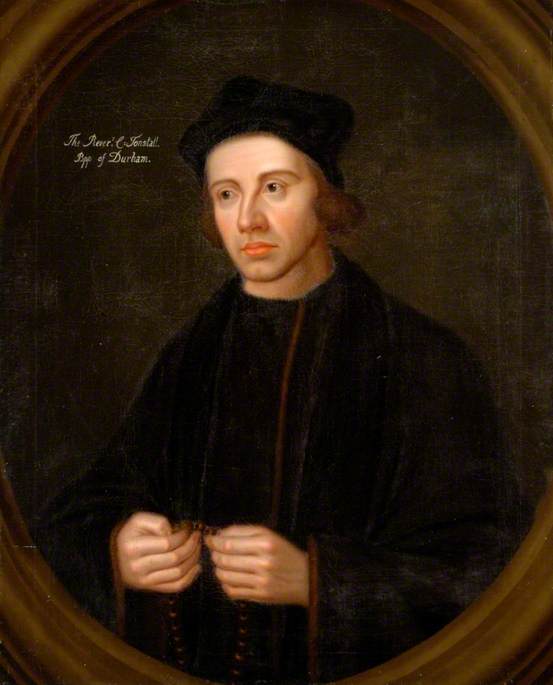 Cuthbert Tunstall (1474–1559), Bishop of Durham In the 1530s, life became more dangerous for Spanish Erasmians when Erasmus' protector, the Inquisitor General Alonso Manrique de Lara fell out of favour with the royal court and lost power within his own organization to friar-theologians. In 1532 Erasmus' friend, conversos Juan de Vergara (Cisneros' Latin secretary who had worked on the Complutensian Polyglot and published Stunica's criticism of Erasmus,) was arrested by the Spanish Inquisition and had to be ransomed from them by the humanist Archbishop of Toledo Alonso III Fonseca, also a correspondent of Erasmus', who had previously rescued Ignatius of Loyola from them.[106]: 80 There was a generational change in the Catholic hierarchy. In 1530, the reforming French bishop Guillaume Briçonnet died. In 1532 his beloved long-time mentor English Primate Warham died of old age,[note 40] as did reforming cardinal Giles of Viterbo and Swiss bishop Hugo von Hohenlandenberg. In 1534 his distrusted protector Clement IV died, his recent Italian ally Cardinal Cajetan died, and his old ally Cardinal Campeggio retired. As more friends died (in 1533, his friend Pieter Gillis; in 1534, William Blount; in early 1536, Catherine of Aragon;) and as Luther and some Lutherans and some powerful Catholic theologians renewed their personal attacks on Erasmus, his letters are increasingly focused on concerns on the status of friendships and safety as he considered moving from bland Freiburg despite his health.[note 41] In 1535, Erasmus' friends Thomas More, Bishop John Fisher and Brigittine Richard Reynolds[note 42] were executed as pro-Rome traitors by Henry VIII, who Erasmus and More had first met as a boy. Despite illness Erasmus wrote the first biography of More (and Fisher), the short, anonymous Expositio Fidelis, which Froben published, at the instigation of de Góis.[98] After Erasmus' time, numerous of Erasmus' translators later met similar fates at the hands of Anglican, Catholic and Reformed sectarians and autocrats: including Margaret Pole, William Tyndale, Michael Servetus. Others, such as Charles V's Latin secretary Juan de Valdés, fled and died in self-exile. Erasmus' friend and collaborator Bishop Cuthbert Tunstall eventually died in prison under Elizabeth I for refusing the Oath of Supremacy. Erasmus' correspondent Bishop Stephen Gardiner, who he had known as a teenaged student in Paris and Cambridge,[108] was later imprisoned in the Tower of London for five years under Edward VI for impeding Protestantism.[note 43] Damião de Góis was tried before the Portuguese Inquisition at age 72,[98] detained almost incommunicado, finally exiled to a monastery, and on release perhaps murdered.[110] His amanuensis Gilbert Cousin died in prison at age 66, shortly after being arrested on the personal order of Pope Pius V.[94] Death in Basel 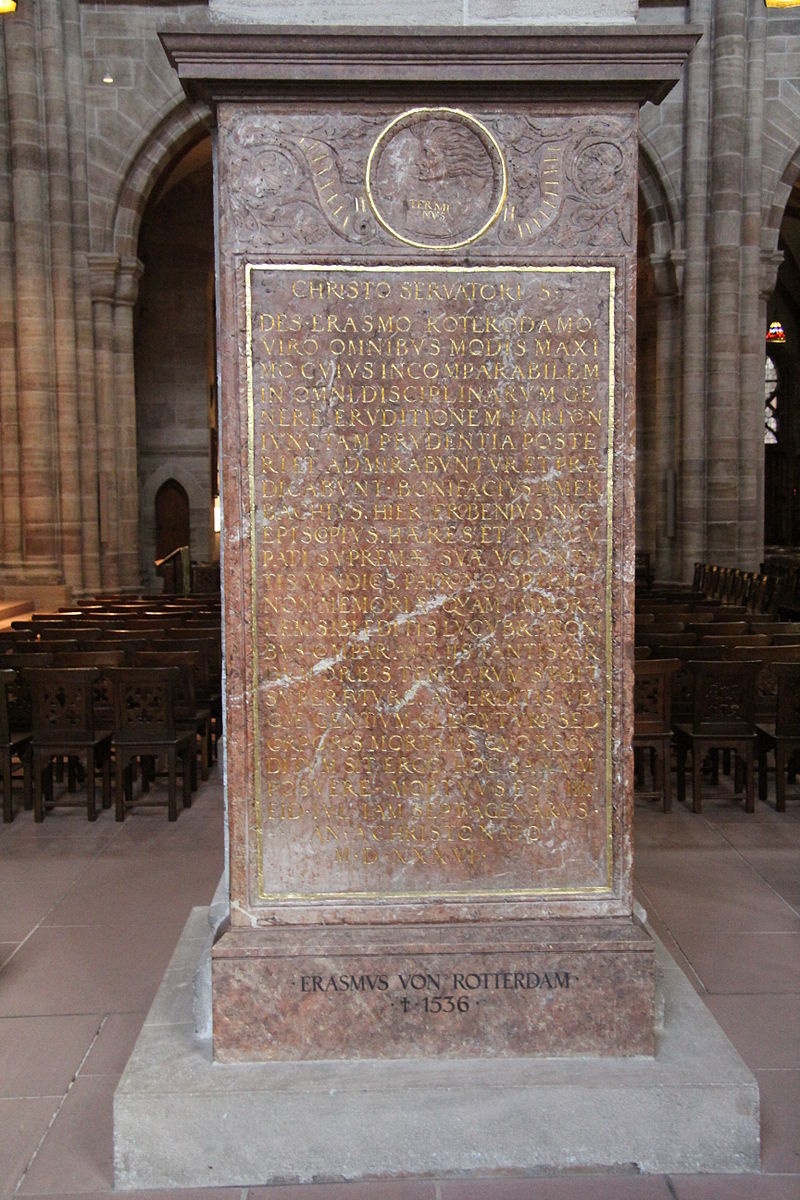 Epitaph for Erasmus in the Basel Minster When his strength began to fail, he finally decided to accept an invitation by Queen Mary of Hungary, Regent of the Netherlands (sister of his former student Archduke Ferdinand I and Emperor Charles V), to move from Freiburg to Brabant. In 1535, he moved back to the Froben compound in Basel in preparation (Œcolampadius having died, and private practice of his religion now possible) and saw his last major works such as Ecclesiastes through publication, though he grew more frail. On July 12, 1536, he died at an attack of dysentery.[111] He had remained loyal to Roman Catholicism,[112] but biographers have disagreed whether to treat him as an insider or an outsider.[note 44] He may not have received or had the opportunity to receive the last rites of the Catholic Church;[note 45] the contemporary reports of his death do not mention whether he asked for a Catholic priest or not,[note 46] if any were secretly or privately in Basel. His last words, as recorded by his friend and biographer Beatus Rhenanus, were apparently "Dear God" (Dutch: Lieve God).[114] He was buried with great ceremony in the Basel Minster (the former cathedral). The Protestant city authorities remarkably allowed his funeral to be an ecumenical Catholic requiem Mass.[115] As his heir he instated Bonifacius Amerbach to give seed money[note 47] to students and the needy;[note 48] he had received a dispensation to make a will rather than have his wealth revert to his order, the Chapter of Sion, and had long pre-sold most of his personal library of almost 500 books to Jan Łaski.[116][117] One of the eventual recipients was the impoverished Protestant humanist Sebastian Castellio, who had fled from Geneva to Basel, who subsequently translated the Bible into Latin and French, and who worked for the repair of the breach and divide of Christianity in its Catholic, Anabaptist, and Protestant branches.[118] |
生い立ち ロッテルダムにあるエラスムス像。石像(1557年)、木像(1549年)に代わるヘンドリック・デ・カイザー作の金メッキブロンズ像(1622年)。 デジデリウス・エラスムスは、1460年代後半の10月27日か28日(「シモンとユダの夜」)[4]にロッテルダムで生まれたと伝えられている。名前 は、エラスムスの父ゲラルト(Gerardus Helye)[5]が個人的に好意を寄せていたフォルミアエのエラスムスにちなんで付けられた[注釈 1]。 エラスムスの生年ははっきりしない。後年、彼は1466年生まれとして年齢を計算したが、主要な出来事における彼の記憶年齢は実際には1469年を意味す ることが多い[8][9]: 8 (この記事では現在1466年を生年としている[10][11]。この不一致を扱うため、年齢はまず1469年に基づいて与えられ、次に1466年に基づ いて括弧書きで与えられている:例えば「20(または23)」)。さらに、彼の生い立ちの多くの詳細は、1516年に彼が架空の教皇庁書記官ランベルトゥ ス・グルニウス(「グラント氏」)に宛てた手紙の中で書いた架空の三人称の記述(1529年に出版)から得なければならない[12]。 父ジェラールはカトリックの司祭で[13]、1450年代から60年代にかけて6年間、書記や学者としてイタリアに滞在していた可能性がある[14]: 196 母親はゼーヴェンバーゲン出身の医師の娘マルガレータ・ロジェリウス(オランダ姓ルトガースのラテン語化)[15]。エラスムスは婚外子であったが、 1483年に両親がペストで早くに亡くなるまで、愛情深い家庭と最良の教育によって養育された。マーガレットは未亡人で、ピーターはエラスムスの腹違いの 兄であったとする作家もいる[9]。 エラスムス自身は、1524年の『Compendium vitae Erasmi』の中で、両親は婚約していたが、親族によって正式な結婚は阻止された(おそらく若い未亡人や未婚の子持ちの母親は有利な結婚相手ではなかっ た)、父親はラテン語とギリシア語を勉強するためにイタリアに行き、親族はマルガレータが亡くなったとジェラルドに誤解させ、悲嘆に暮れるジェラルドはロ マンチックに聖職に就いたが、帰国後にマルガレータが生きていたことを知ったという筋書きであった。 [17]: 89 1471年、父親は小さな町ヴォールデンの副教皇となり(幼いエラスムスは読み書きを学ぶために地元の方言学校に通っていたと思われる)、1476年には ゴーダの副教皇に昇格した[5]。 エラスムスは、修道院や半修道院のような学校で、当時の若者にとって最高の教育を受けた。1476年、6歳(または9歳)で家族はゴーダに移り住み、ピー テル・ヴィンケル氏[5]の学校に通い始めるが、彼は後にエラスムスの後見人となる(そしておそらく、エラスムスとピーテルの遺産を横流しした) (1466年に生まれたとする歴史家は、この時期、エラスムスはユトレヒトの聖歌隊学校にいたとする[18])。 1478年、9歳(または12歳)のエラスムスは、兄のピーターとともに、オランダで最も優れたラテン語学校のひとつ、デヴェンターにあるレビュイヌス教 会(Lebuïnuskerk)[10]の支部聖職者が所有するラテン語学校に送られた。アルプス以北のヨーロッパで初めてギリシア語が大学よりも低いレ ベルで教えられるようになり[19]、そこで彼はギリシア語を学び始めた[20]。1483年頃、ペストが街を襲い[21]、息子たちに家を与えるために 引っ越していた母親が感染症で亡くなったため、そこでの教育は終わった。両親と学校の20人の生徒[9]の死後、彼は故郷(ロッテルダム?)[5]に戻 り、そこで慈愛に満ちた未亡人ベルト・デ・ヘイデン[22]に支えられた[9]。  ヒエロニマス・ボス《聖アントニウスの誘惑》三幅対(1501年頃)、ヘルトーヘンボスで描かれ、後に友人のダミアン・デ・ゴイスが所有。 1484年、14歳(または17歳)の頃、彼は弟とともに、共同生活の兄弟たち[24][注釈 2]が運営する、's-ヘルトーヘンボッシュの安価な[23]文法学校または神学校に通った。エラスムスは、そこでデヴォティオ・モデルナ運動やブレザレ ンたちの名著『キリストの模倣』に触れるが、修道兄弟や教育者たちの厳しい規則や厳格なやり方に憤慨する[10]。2人の兄弟は、聖職者には抵抗するが大 学には通うという協定を結ぶ[22]。 [8]: 804 代わりに、ピーターはシュタインのアウグスティヌス派のカノン会修道院に向かったため、エラスムスは裏切られたと感じた[22]。この頃、エラスムスは友 人のエリザベス・デ・ヘイデンに「私は難破し、"冷たい水の中で "道に迷っている」と寂しげに書き送っている[9]。やがてエラスムスは1487年以前、16歳(または19歳)[5]の頃にポスチュアントとして同じ修 道院に移った[注釈 3]。 誓願、叙階、カノナリーの経験  エラスムスが青年期を過ごしたゴーダでのヒルド・クロップ作の胸像(1950年) 貧しさ[25]のためにエラスムスは奉献生活に入ることを余儀なくされ、1487年[26]、南ホラント州ゴーダにほど近いシュタインにある修道院で修練 院に入った。1488年から1490年にかけて、周辺地域はヨンカー・フランセン継承戦争を戦う軍隊によってひどい略奪を受け、その後飢饉に見舞われた。 [8]: 759年、エラスムスは1488年末に19歳(あるいは22歳)で聖アウグスティヌス修道会正教会士[注釈 5]として誓願を立てた[26]。エラスムスは修道院で精神的に目覚めたのである」[31]。 修道会におけるある種の虐待は、後に彼が西方教会を内部から改革しようと呼びかけた主な対象のひとつであり、特に未成熟の少年たちを強制的に、あるいは騙 して勧誘していた(『グルニウスへの手紙』の架空の記述では、彼らを「ドミニコとフランシスコとベネディクトの犠牲者」と呼んでいる): エラスムスは、自分がこのような階層に属していると感じ、「自発的に、しかし自由には」入信しなかったので、道徳的に誓願に縛られていないとしても、法 的、社会的、名誉的に誓願を守る義務があることは確かであり、自分の真の召命を探す義務があると考えた[27]: 439 スタイン在学中、18歳(あるいは21歳)のエラスムスは、同じカノンであったセルヴァティウス・ロジェルスと、彼が「熱烈な愛」(ラテン語: fervidos amores)と呼ぶ片思いをし[註6]、一連の恋文[註7][33]を書き、その中でロジェルスを「私の魂の半分」と呼び[註8]、「私があなた方を不 幸にも執拗に口説いたのは、報酬のためでも、好意のためでもありません。では何なのか?この書簡は、モア、コレット、アンモニオなど[注釈 10]、深い男同士の友情を築き、維持する能力を持っていたとはいえ、後世のエラスムスが通常見せる、一般的に冷淡ではるかに抑制された態度とは対照的で ある[注釈 11]。エラスムスが生前に言及されたり性的な非難を受けたりしたことはない。彼の著作では、男女間の結婚生活における適度な性欲を賞賛するものが目立つ [35]。 ラテン秘書のサークル フアン・デ・ベルガラ - ピエトロ・カルメリアーノ[36] - ギョーム・ブデ - ピエトロ・ベンボ - ヤコポ・サドレト - リチャード・パーチェ - アンドレア・アンモニオ - ヒエロニムス・エムサー - コルネリウス・グラフェウス - ヨハネス・セクンドゥス - フアン・デ・バルデス、アルフォンソ・デ・バルデス - ペーテル・ヴァネス - ゲンチアン・ヘルヴェトゥス - ヤン・ワスキ - ランベルト・グルニウス(架空)[12]: 337 ラテン語の秘書は、後にエラスムスの文通相手や友人のネットワークの重要な一部となった[注釈 12]。 1493年、修道院長はエラスムスがシュタイン家を去り[38]、野心的なカンブライ司教ベルゲンのラテン語秘書となるよう取り計らった。 1492年4月25日[25]、あるいは1495年4月25日、25歳(あるいは28歳)でカトリック司祭に叙階された[14]。 1500年以降、彼は食事と時間によって命を落とすと主張してシュタインのカノン座に戻ることを避けたが[註 15]、他のアウグスチノ会の共同体や他の修道会の修道院に滞在した。1504年にシュタインの修道院長に就任したロジェルスとエラスムスは何年にもわ たって文通を続け、ロジェルスはエラスムスが学業を終えた後に戻ることを要求した。それにもかかわらず、カノナリーの図書館[注釈 16]には、ゴーダ地方でエラスムスの出版物が圧倒的に多く収蔵されることになった[42]。 1505年、教皇ユリウス2世は、エラスムスが特定の聖職に就くことを認める程度に清貧の誓願から免除し、修道会の統制と習慣から免除することを認めた が、彼は司祭であり、形式的にはアウグスチノ会の正教会司祭[注釈 17]であり続けた。 [27] 1517年、教皇レオ10世はエラスムスの生まれつきの欠点[注釈 18]に対して法的な免除を与え、48歳(または51歳)のエラスムスの独立を認め[43]、それでもなおカノンとして司祭や修道院長の職に就くことを認 めた[27]。 ↓出生? ↓孤児 ↓誓願 ↓出家? ↓処分 ↓ ↓死 ↓ ↓ オランダ フランス イタリア イングランド ブラバント バーゼル フライブルク イギリス ブラバント イングランド フランス バーゼル バーゼル イングランド バーゼル イギリス バーゼル │ 1465 │ 1475 │ 1485 │ 1495 │ 1505 │ 1515 │ 1525 │ 1535  エラスムスのおおよその年表(図をクリック) エラスムスの信念の多くは、初期の伝記から生まれたようだ: 既婚状態と適切な結婚への尊敬、司祭の結婚への支持、女性の結婚の可能性を高めることへの関心、思いやりのない規則への反対、特に制度上の食事規則、教育 を参加者にとって魅力的なものにしたいという願望、古典的言語への関心、貧困と精神的絶望への恐怖、 勉強や仕事ができるのに物乞いをする修道士への嫌悪感、権力者の支配下に置かれることへの不本意さ、信心深さ、権力者が自分の担当者の最善の利益のために 行動する必要性、慈悲と平和の尊さ、不必要な戦争、特に欲深い王侯間の戦争への怒り、死への意識など。 旅行記 エラスムスの都市とルート オックスフォード、ケンブリッジ ロンドン 読書 カンタベリー ヴェルデン カレー シュタイン、ゴーダ ロッテルダム サン・オメル ヘルトーゲンボッシュ パリ、カンブレー ブリュッセル、アントワープ オルレアン ルーバン トリノ ケルン ボローニャ マインツ ストラスブール フィレンツェ フライブルク・イム・ブライスガウ シエナ パドヴァ バーゼル ローマ、ヴェネツィア コンスタンツ クマエ 緑: 初期の生活 濃い丸:居住地 細い線 アルプス越え 青い線 ライン川とイギリス海峡 エラスムスは、貧しさ、シュタインのカノン職からの「逃亡」(カンブライへ)、教育(パリ、トリノへ)、発汗病ペストからの逃亡(オルレアンへ)、就職 (イングランドへ)、写本のための図書館探しなどの理由で、広く定期的に旅をした、 執筆(ブラバント)、王室顧問(ケルン)、後援、家庭教師、付き添い(北イタリア)、人脈作り(ローマ)、印刷を通して本を直接見る(パリ、ヴェネツィ ア、ルーヴァン、バーゼル)、宗教狂信者の迫害を避ける(フライブルクへ)。 乗馬を楽しんだ[44]。  パリ 1495年、ヘンリー司教の同意と俸給を得て、エラスムスはパリ大学のコレージュ・ド・モンタイグで学ぶことになるが、ここは改革熱の中心地であった[注 19]。 [例えば、エラスムスは、詩人でありパリの「人間性教授」であったイタリアの人文主義者パブリオ・ファウスト・アンドレリーニと親しい友人となった [47]。 この時期、エラスムスは排他的あるいは過剰なアリストテレス主義やスコラ哲学を深く嫌うようになり[48]、イギリスやスコットランドの貴族を訪問する際 の家庭教師や付き添いとしての仕事を見つけるようになる。 イングランド イングランドのサークル[49]。 トマス・モア - ジョン・コレット - トーマス・リナクル - ウィリアム・グローシン - ウィリアム・リリー - アンドレア・アンモニオ - ファン・ルイス・ヴィヴェス - カスバート・タンストール - ヘンリー・ブロック - トーマス・ルプセット - リチャード・フォックス - クリストファー・アーズウィック - ロバート・アルドリッチ - リチャード・ウィットフォード - ロレンツォ・カンペッジョ - リチャード・レイノルズ - ポリドール・ヴェルジル パトロン ウィリアム・ブラウント、ウィリアム・ウォーハム、ジョン・フィッシャー、ジョン・ロングランド、マーガレット・ボーフォート、キャサリン・オブ・アラゴ ン "ロンドンの街ほど、真の友人、学識ある友人、親切な友人、名高い友人を多く与えてくれた場所は、世界中どこを探してもない。" コレットへの手紙、1509年[30]。 その間、パリ、オルレアン、ルーヴェン、その他の都市に留学した時期もあった[註 20]。  ハンス・ホルベイン作『エラスムス』。パリ、ルーヴル。 最初の訪問 - 1499年から1500年 1499年、第4代マウントジョイ男爵ウィリアム・ブラウントに招かれ、イングランドへの旅に同行することになった[50]。イングランドでの生活は、ヘ ンリー8世時代のイギリス思想の指導者たちと生涯の友好関係を築く上で実り多いものとなった。 1499年に初めてイギリスを訪れたエラスムスは、オックスフォード大学で学んだり教鞭をとったりした。エラスムスは、スコラ学者よりも教父に近いスタイ ルを追求したジョン・コレットの聖書教育に特に感銘を受けた。人文主義者ジョン・コレットの影響により、彼の関心は神学へと向けられていった[50]。エ ラスムスに影響を与えたと思われるコレットの思想の他の特徴としては、平和主義、改革志向、反スコラ学主義、告解の秘跡に対する司牧的尊重[53]などが 挙げられる[94]。 このため、イギリスからパリに戻ったエラスムスは、ギリシャ語を集中的に学び、神学をより深いレベルで研究するようになった[54]: 518 エラスムスはまた、修道士になろうと考えていた若い法学生トマス・モアと急接近し、その思想(良心と衡平性など)は14世紀のフランスの神学者ジャン・ ジェルソンの影響を受けており[55][56]、その知性はイギリスの修道院の改革を試みたことで有名な彼の強力なパトロンであったジョン・モートン枢機 卿(1500年没)によって培われていた[57]。 エラスムスは、寛大な友人たちから学業を全うするための資金を満額もらってロンドンを後にした。しかし、友人たちから間違った法的助言を受けたエラスムス は、イギリスの税関職員に金銀を没収され、数ヶ月続いた夜間発熱以外に何も残らなかった。 二度目の訪問 - 1505年から1506年  ハンス・ホルベイン作「トマス・モア卿 エラスムスの2度目の訪問では、結婚したばかりのトマス・モアの家に1年以上滞在し、翻訳の腕を磨いた。 エラスムスは独立した学者としての生活を好み、個人の自由を阻害するような行動や形式的な結びつきを避けるよう意識的に努力した[58]。 イギリスではエラスムスは著名な役職を打診されたが、国王自身が支援を申し出るまですべて断った[58]。 彼はその気になったが、結局受け入れず、イタリアでの滞在を切望した[58]。 3度目の訪問 - 1510年-1515年 1510年、エラスムスはモアの賑やかな家に到着し、再発した病気を治すためにベッドに寝かされ、ベストセラーとなる『愚行礼賛』を執筆した。モアは当 時、ロンドン市の下屋長だった。 イタリアでの輝かしい歓待の後、エラスムスは無一文で職もなく[注釈 21]、大陸のかつての友人や恩人との関係もぎくしゃくしたまま帰国し、ローマ教皇の戦乱に怯えながらもイタリアを去ることを後悔していた。いわゆる「失 われた2年間」は、おそらく危険な意見や不満な意見を自粛したためであろう[注釈 11]。彼は友人のアンドレア・アンモニオ(マウントジョイのラテン語秘書、翌年はヘンリー8世のラテン語秘書)とロンドンのオースティン修道士の屋敷に 下宿していたが、家賃をめぐって修道士たちと意見が対立し、悪仲になったため、下宿を飛び出した[注釈 22]。 友人であったジョン・コレットを助け、ギリシア語の教科書を執筆したり、新しく設立されたセント・ポール・スクールのスタッフを確保したりした[60]。 コレットが1512年に悪名高い招集説教を行い、教会問題の改革を訴えた際にも連絡を取り合っていた[61]: 230-250 コレットの勧めで、エラスムスは『デ・コピア』の執筆を開始した。 1511年、ケンブリッジ大学のジョン・フィッシャー総長の計らいで、エラスムスはレディ・マーガレット神学教授となる。彼はギリシャ語を学び、教え、 ジェロームについて研究し、講義を行った[49][注 23]。 1511年から1515年にかけて、エラスムスは主にクイーンズ・カレッジに滞在しながら講義を行った[63]。エラスムスの部屋はオールド・コートの 「I」階段にあった[64]。慢性的な資金不足にもかかわらず、彼はトマス・リナクルの指導のもと、3年間昼夜を問わない集中的な学習によってギリシア語 を習得することに成功した。 エラスムスは不健康に悩まされ、特に暖房、きれいな空気、換気、隙間風、新鮮な食べ物、汚れのないワインに気を配り、イギリスの建物の風通しの悪さに不満 を漏らしていた[66]。 彼はクイーンズ・カレッジが十分なワイン[注釈 25]を供給してくれないことに不満を漏らしていた(ワインはエラスムスが苦しんでいた胆石のルネサンス時代の薬であった)。 [67] クイーンズ・カレッジ旧図書館には、16世紀には珍しくヒューマニズムに傾倒した教育機関であったため、エラスムスの出版物の初版本が数多く所蔵されてい る。その多くは、遺贈や購入によってこの時期に入手されたもので、友人でありポーランドの宗教改革者であったヤン・ワスキの署名が入ったエラスムスの新約 聖書の翻訳もそのひとつである[68]。 この頃、モアはポーマンの衡平法判事(Master of Requests)であり、枢密顧問官でもあった。 フランスとブラバント フランスのサークル ジャン・ヴィトリエ(またはヴーリエ) - ヤコブ/ジェームズ・バット - プブリオ・ファウスト・アンドレリーニ - ジョッセ・バデ - ルイ・ド・ベルカン - ロバート・フィッシャー - リチャード・ウィットフォード - ギヨーム・ブデ - トーマス・グレイ - ヘクトール・ボース - ロバート・ガギャン 対戦相手 ノエル・ベダ パトロン ベルゲン司教アンリ、トーマス・グレイ、ヴェール夫人 最初のイギリス旅行の後、エラスムスはまずパリの貧困に戻り、そこで生徒のために『アダージョ』の編纂を始め、ペストから逃れるためにオルレアンへ、そし てフランスでの半修道院生活、学術研究、執筆活動、特にサン・オーメルのサン・ベルタンベネディクト会修道院(1501,1502年)で『エンチリディオ ン(キリスト教騎士の手引書)』の初版を執筆した。 特に影響を受けたのは、1501年に急進的なフランシスコ会士であったジャン(ジェハン)・ヴィトリエとの出会いであり、彼は一種の回心体験[14]: 213, 219において修道制[53]: 94, 95の儀式主義[注釈 26]と断食[注釈 27]の過剰な価値化に反対するエラスムスの考えを統合し、オリゲンに彼を紹介した[70]。 1502年、エラスムスはブラバントへ行き、最終的にはルーヴァンの大学へ、そして1504年にはパリへ戻った。 イタリア イタリアのサークル アルドゥス・マヌティウス - ジュリオ・カミッロ - アレクサンダー・スチュワート - ピエトロ・ベンボ - ボンバシウス - マルクス・ムスルス - ヤヌス・ラスカリス - ヴィテルボのジャイルズ - エグナツィオ - ジェルマン・ド・ブリエ - フェリー・カロンデレ - ウルバノ・ヴァレリアーニ - トマソ・インギラム - カーターマカス 対戦相手 アレアンデル、アルベルト・ピオ、セパルベダ パトロン 教皇レオ10世、アドリアヌス6世、クレメンス7世、パウロ3世、ジェームズ4世 1506年、イギリス国王の主治医の息子たちに同行して、イタリアからボローニャまで家庭教師をすることができた[58]。 その途中、ロレンツォ・ヴァッラの『新約聖書注』を発見したことは、彼のキャリアにおいて大きな出来事であり、エラスムスが言語学を使って新約聖書を研究 するきっかけとなった[71]。 1506年、二人はトリノを通過し、エラスムスは37歳(または40歳)でトリノ大学から聖なる神学博士の学位(Sacra Theologia)[72]: 638を授与された。  ヴェネツィアのアルディン印刷所で印刷され、彩色された本(1501年)、『ホレス著作集』。 エラスムスはヴェネツィアに渡り、有名な印刷業者アルドゥス・マヌティウスのアルディン印刷所で『アダージア』の増補版に取り組み、どの原稿を出版すべき かを助言し[73]、グラコフォンのアルディン「新アカデミー」(ギリシア語: Neakadêmia (Νεακαδημία) )の名誉会員となった。 [74] 彼はアルドゥスから、土壇場で変更を加えたり、インクが乾くとすぐに印刷された校正刷りをチェックして修正したりするという、フローベンで生産性を高めた 対面式のワークフローを学んだ。アルドゥスは、エラスムスはこれまで会ったどの人物よりも、与えられた時間に2倍の仕事をこなすことができたと書いている [30]。 1507年、彼の手紙によれば、彼はパドヴァでヴェネツィアの自然哲学者ジュリオ・カミッロのもとで高度なギリシア語を学んだ[75]。彼はパドヴァ、 フィレンツェ、シエナ[注釈 28]を巡り、24歳のセント・アンドリュース大司教であったスコットランドの貴族アレクサンダー・スチュワートの家庭教師とエスコートの仕事を見つけ た。 1510年、カンタベリー大主教ウィリアム・ウォーハムとマウントジョイ卿は、10ポンドの旅費を支払って、エラスムスを新しい人文主義者の国王の下にあ るイングランドに誘い戻した[77]。 ブラバント(フランドル) ブルゴーニュ/ルーヴァン圏 ユトレヒトのアドリアン - ピーテル・ギリス - マルティン・ドルプ - ヒエロニムス・ファン・ブスレーデン - アルブレヒト・デューラー - ディルク・マルテンス - ニコラ・クレイナールツ - コルネリウス・グラフェウス 対戦相手 ラトムス - エドワード・リー - ウルリッヒ・フォン・ハッテン - ニコラース・ベーケム(エグモンダヌス) パトロン シャルル5世 1514年、バーゼルに向かう途中、ヘルマヌス・ブスキウス、ウルリッヒ・フォン・ハッテン、ヨハン・ロイクリンの知遇を得、マインツでヘブライ語を学ぶ [79]。  Quinten Massijs - Portrait of Peter Gillis or Gilles (1517), 二部作の半分で、下にエラスムスの肖像が描かれている。 49]エラスムスにとって幸運なことに、モアとタンストールは1516年頃に政府の使節団としてブリュッセルかアントワープに赴任し、モアは6ヶ月間、タ ンストールはそれ以上の期間赴任した。彼らの仲間にはアントワープのピーテル・ギリスがおり、その家でトマス・モアはエラスムスの勧めで『ユートピア』 (1516年出版)を執筆し、エラスムスは編集を担当し、おそらく断片を寄稿した[82]。 エラスムスは、200ギルダー[83]の年金を支給されるチャールズ5世の参事官という名誉職を引き受け、彼の弟である10代の後の神聖ローマ皇帝ハプス ブルク家のフェルディナントの家庭教師をしていた。この頃、『キリスト教王子の教育』(Institutio principis Christiani)を著した。 1517年、亡き友人ヒエロニムス・ファン・ブスレーデンの遺言により、ヘブライ語、ラテン語、ギリシア語を学ぶためのコレギウム・トリリンゲ[84]: s1.14.14の設立を支援。  ヘンリー8世作《黄金布の野原》(イギリス - 若きハンス・ホルベインの旧作) 1520年、彼はギヨーム・ブデとともに「黄金布の野原」に立ち会ったが、これはおそらくトマス・モア[86]やウィリアム・ウォーハムとの最後の出会い であった。彼の友人やかつての教え子、古い文通相手は次期政治エリートであり、彼は彼らとともに出世していた[注釈 30]。 1521年の夏にはアンデルレヒト(ブリュッセル近郊)など様々な場所に滞在した[87]。 バーゼル スイス・サークル[88]: 56, 63 ヨハネス・フローベン - ヒエロニムス・フローベン - ベアトゥス・レーナヌス - ボニファシウス・アメルバッハ - ブルーノ・アメルバッハ - 若きハンス・ホルバイン - シモン・グリネウス - セバスチャン・ブラント - ヴォルフガング・カピート - ダミアン・デ・ゴイス - ギルバート・カズン - ヤコブ・ネフ - アウグスティヌス・マリウス 対戦相手 ウコランパディウス パトロン アントワーヌ1世ド・ヴェルジ、クリストフ・フォン・ウテンハイム  デジデリウス・エラスムスが、アンメヌエンシスであるギルバート・クーシンまたはコグナトゥスに口述したもの。ブルゴーニュのノゼロイにあるクーザンの家 のフレスコ画に基づくとされる。おそらくクロード・リュック(fr:Claude Luc)によるエングレーヴィング。 1514年以降、エラスムスは定期的にバーゼルを訪れ、フローベンと本の印刷を調整した。バーゼルの偉大な出版人ヨハン・フローベンと、後にその息子ヒエ ロニムス・フローベン(エラスムスの名付け子)と永続的な関係を築き、エラスムスとともに200以上の著作を出版し[89]、輝かしいキャリアを歩んだ専 門の学者・校訂者たちと仕事をした[88]。 フロベンの仕事は、(ブラックレターではなく)新しいローマン体、アルダイン風のイタリック体やギリシア体、そして縁取りや派手な大文字を使ったエレガン トなレイアウトで知られていた[88]: 59 ハンス・ホルバイン(若)は、エラスムス版のためにいくつかの木版画の大文字を制作した。彼の多くの著書の印刷は、アルザス人の友人であるギリシア人学者 ベアトゥス・レナヌスによって監督された[注釈 31]。 1521年、彼はバーゼルに定住し[91]、ルーヴァンでの論争や敵対関係に疲れ果て、ルター派の論争にこれ以上引きずり込まれることを恐れていた [92]。 年金と利益の分け前を得るために、献辞や序文[30]を書くフローベン印刷所の文芸監督者となることに同意した。 [62]フローベンの制作チームとは別に、彼は自分の家庭[注釈 32]を持ち、手強い家政婦、馬小屋、8人までの下宿人や有給の使用人を抱えていた。 フロベンと彼のチームとの共同作業により、エラスムスの『注釈』の範囲と野心は、ヴァッラの『注釈』に沿った新約聖書の文献学的注釈というエラスムスの長 年の研究プロジェクトであったが、軽く改訂されたラテン語のヴルガータ、次にギリシャ語のテキスト、次に方法論に関するいくつかの有益なエッセイ、次に高 度に改訂されたヴルガータ-これらはすべて彼の『Novum testamentum omne』として束ねられ、ヨーロッパ中で個別に海賊版化された-、そして最後に彼の増幅されたパラフレーズを含むまでに成長した。  教皇アドリアヌス6世 (1522-1523) 1522年、エラスムスの同胞であり、ルーヴァン大学時代の恩師(1502年頃)であり友人であったアドリアヌス6世が、6年間スペインの摂政(および/ または大審問官)を務めた後、思いがけず教皇となった[注 33]。エラスムスやルターと同様、彼は「共同生活の兄弟たち」の影響を受けていた。彼はエラスムスをローマに誘おうとした。多くのルター派の反対を満た すことを期待した彼のローマ教皇庁改革は、トレント公会議で練り直されたものの(教皇庁が破産したため)頓挫し、1523年に死去した[97]。 ルターに対する民衆や民族主義者の反応が勢いを増すにつれ、エラスムスが恐れ、ルターが自らを切り離した社会的な混乱が現れ始めた。これらが改革の成果だ とすれば、エラスムスは自分が改革に関与しなかったことに感謝していた。しかし、この「悲劇」(エラスムスはこの問題をこう呼んだ)を引き起こしたのは自 分であるとして、エラスムスはますます激しく非難されるようになった[注釈 34]。 1523年、新たに導入された異端審問から釈放された、困窮し失脚したアントワープの元ラテン語長官コルネリウス・グラフェウスに財政援助を行った [98]: 558 1525年、エラスムスの元教え子で、エラスムスの父の教会であったヴォールデンの教会で奉仕していたヤン・デ・バッカー(ピストリウス)が、オランダで 異端者として処刑された最初の司祭となる。1529年、彼のフランスの翻訳者であり友人でもあったルイ・ド・ベルカンは、ソルボンヌ大学の神学者たちに よって反ローマ派の異端者として断罪された後、パリで火刑に処された。 フライブルク  ダミアン・デ・ゴイスの肖像(アルブレヒト・デューラー作) 1529年、エラスムスの元助手であったウトコランパディウスが率いるイコノクラスティックな暴動の後[注釈 35]、バーゼル市は宗教改革を確実に採用し、1529年4月1日にカトリックのミサを禁止した。 [99] エラスムスは1529年4月13日にバーゼルを離れ、かつての教え子であったオーストリアのフェルディナント大公[14]の庇護のもと、カトリックの大学 都市フライブルク・イム・ブライスガウへと船で向かった: 210はクジラの家の最上階に2年間滞在し[100]、その後自分の家を買って改装し[注釈 36]、コルネリウス・グラフェウスの友人ダミアン・デ・ゴイスのような学者やアシスタントを食客として受け入れた[101]。 エラスムスは、虚弱[註 37]であったにもかかわらず、新しい大著『伝道の書』や『死の準備』など、生産的な仕事を続けていた。5ヶ月の間、彼の下宿人であったポルトガルの学者 /外交官であったダミアン・デ・ゴイス[98]は、スウェーデンのサーメ人の苦境とエチオピアの教会に関するロビー活動に取り組み、海外宣教に対するエラ スムスの意識の高まりを刺激した[103][注釈 38]。 モアが総長として就任してから辞任するまで(1529-1523年)、モアとエラスムスの間の書簡はほとんど現存していない。エラスムスは、トマス・ボリ ンの驚くべき庇護のもとで、詩篇23篇の三重注解(Ennaratio triplex in Psalmum XXII)(1529年)、フランクフルトのブックフェアで3時間で完売したルターに対抗するためのカテキズム(Explanatio Symboli)、戯曲的で神々しい説明またはコミューン・クレデの宣言(A Playne and Godly Exposition or Declaration of the Commune Crede)(1533年)、そしてエラスムスの最も人気があり、最も乗っ取られた作品のひとつとなる死の準備(Praeparatio ad mortem)(1534年)など、政治以外の重要な作品をいくつか書いた。 [105][注釈 39]がある。 友人たちの運命  ウィリアム・ウォーハム(1450年頃-1532年)、カンタベリー大司教、ハンス・ホルベインによる。  カスバート・タンストール(1474-1559)、ダラム司教 1530年代、エラスムスの庇護者であった奉行総長アロンソ・マンリケ・デ・ララが王宮の寵愛を受けなくなり、自身の組織内でも修道士神学者たちに権力を 奪われたことで、スペインのエラスムス派の生活はより危険なものとなった。1532年、エラスムスの友人であった会話者フアン・デ・ベルガラ(シスネロス のラテン語秘書で、コンプルテンシアン・ポリグロットに取り組み、ストゥニカのエラスムス批判を出版した)はスペイン異端審問所に逮捕され、トレドの人文 主義者アロンソ3世フォンセカ大司教(エラスムスの文通相手でもあり、以前ロヨラのイグナチオを異端審問所から救い出した人物)によって身柄を確保された [106]: 80。 カトリックの階層にも世代交代があった。1530年、改革派のフランス人司教ギヨーム・ブリゾネが死去。1532年、彼の敬愛する長年の指導者であったイ ギリス人主教ウォーラムが老衰で亡くなり[注釈 40]、改革派のヴィテルボ枢機卿ジャイルズやスイス人主教フーゴ・フォン・ホーエンランデンベルクも亡くなった。1534年には、不信を抱いていた庇護 者クレメンス4世が亡くなり、最近の盟友であったイタリアのカジェタン枢機卿が亡くなり、古くからの盟友であったカンペッジョ枢機卿が引退した。 さらに多くの友人が亡くなり(1533年、友人のピーテル・ギリス、1534年、ウィリアム・ブラウント、1536年初頭、アラゴンのカトリーヌ)、ル ターや一部のルター派、一部の有力なカトリック神学者たちがエラスムスに対する個人的な攻撃を再開したため、彼の書簡は、健康であるにもかかわらず、当た り障りのないフライブルクからの移住を検討する中で、友人関係の状況や安全に関する懸念にますます焦点が当てられるようになった[注釈 41]。 1535年、エラスムスの友人であったトマス・モア、司教ジョン・フィッシャー、ブリジット派のリチャード・レイノルズ[注釈 42]が、親ローマ派の反逆者としてヘンリー8世によって処刑された。病気にもかかわらず、エラスムスはモア(とフィッシャー)の最初の伝記 『Expositio Fidelis』を匿名で執筆し、デ・ゴイスの勧めでフローベンが出版した[98]。 エラスムスの時代以降も、マーガレット・ポール、ウィリアム・ティンデール、マイケル・セルヴェトゥスなど、多くのエラスムスの翻訳者たちが聖公会、カト リック、改革派の宗派や独裁者の手によって同様の運命をたどった。また、シャルル5世のラテン語秘書フアン・デ・バルデスのように、逃亡し、亡命先で亡く なった者もいた。 エラスムスの友人であり協力者であったカスバート・タンストール司教は、エリザベス1世の下、覇権の誓いを拒否した罪で獄死した。エラスムスの文通相手で あったスティーヴン・ガーディナー司教は、10代の学生時代にパリとケンブリッジで知り合ったが[108]、後にエドワード6世の下でプロテスタンティズ ムを阻害したとしてロンドン塔に5年間投獄された。 [註43] ダミアン・デ・ゴイスは72歳のときにポルトガルの異端審問にかけられ[98]、ほとんど隔離された状態で拘留され、最終的に修道院に追放され、釈放され た後におそらく殺害された[110]。 アマニエのギルバート・クーザンは教皇ピウス5世の個人的な命令で逮捕された直後、66歳で獄死した[94]。 バーゼルでの死  バーゼルのミンストルにあるエラスムスの墓碑銘 体力が衰え始めた頃、彼はついにオランダ摂政のハンガリー王妃メアリー(かつての教え子であるフェルディナント1世と皇帝シャルル5世の妹)の招待を受 け、フライブルクからブラバントへ移ることを決めた。1535年、彼はバーゼルのフローベンの屋敷に戻り、準備に取りかかった(ウコランパディウスが死去 し、彼の宗教の個人的な実践が可能になった)。1536年7月12日、赤痢の発作で死去した[111]。 彼はローマ・カトリックに忠誠を誓っていたが[112]、伝記作家たちは彼をインサイダーとして扱うかアウトサイダーとして扱うかで意見が分かれている [注釈 44]。 彼はカトリック教会の最後の儀式を受けなかったかもしれないし、受ける機会がなかったかもしれない[注 45]。彼の死に関する同時代の報告書には、彼がカトリック司祭を求めたかどうか、バーゼルに密かにあるいは個人的に司祭がいたのかどうか[注 46]については触れられていない。 彼の友人で伝記作家のベアトゥス・レナヌスによって記録された彼の最後の言葉は、「親愛なる神よ」(オランダ語:Lieve God)であったようだ[114]。プロテスタントの市当局は、彼の葬儀をエキュメニカルなカトリックのレクイエム・ミサとすることを見事に許可した [115]。 相続人としては、ボニファティウス・アマーバッハを任命し、学生や困窮者に種銭[注釈 47]を与えた。[注釈 48]彼は、自分の財産が自分の修道会であるシオン会に戻るよりも、遺言書を作成する方が良いという免除を受けており、500冊近い個人蔵書のほとんどを ヤン・ワスキに事前に売却していた。 [116][117]最終的な受取人の一人は、ジュネーヴからバーゼルに逃れてきた貧しいプロテスタントの人文主義者セバスチャン・カステリオであり、彼 はその後聖書をラテン語とフランス語に翻訳し、カトリック、アナバプティスト、プロテスタントにおけるキリスト教の分裂と分裂の修復のために働いた [118]。 |
| Thought and views Erasmus had a distinctive manner of thinking, a Catholic historian suggests: one that is capacious in its perception, agile in its judgments, and unsettling in its irony with "a deep and abiding commitment to human flourishing"[119] "In all spheres, his outlook was essentially pastoral."[14]: 225 Erasmus has been called a seminal rather than a consistent or systematic thinker,[120] notably averse to over-extending from the specific to the general; who nevertheless should be taken very seriously as a pastoral[note 49] and rhetorical theologian, with a philological and historical approach—rather than a metaphysical approach—to interpreting Scripture[122][note 50] and interested in the literal and tropological senses.[14]: 145 French theologian Louis Bouyer commented "Erasmus was to be one of those who can get no edification from exegesis where they suspect some misinterpretation."[123] A theologian has written of "Erasmus’ preparedness completely to satisfy no-one but himself."[124] He has been called moderate, judicious and constructive even when being critical or when mocking extremes.[125][note 51] Pacifism Peace, peaceableness and peacemaking, in all spheres from the domestic to the religious to the political, were central distinctives of Erasmus' writing on Christian living and his mystical theology:[126] "the sum and summary of our religion is peace and unanimity" [note 52] At the Nativity of Jesus "the angels sang not the glories of war, nor a song of triumph, but a hymn of peace.":[127] He (Christ) conquered by gentleness; He conquered by kindness; he conquered by truth itself — Method of True Theology, 4 [note 53]: 570 Erasmus was not an absolute Pacifist but promoted political Pacificism and religious Irenicism.[128] Notable writings on irenicism include de Concordia, On the War with the Turks, The Education of a Christian Prince, On Restoring the Concord of the Church, and The Complaint of Peace. Erasmus' ecclesiology of peacemaking held that the church authorities had a divine mandate to settle religious disputes,[note 54] in an as non-excluding way as possible, including by the preferably-minimal development of doctrine. In the latter, Lady Peace insists on peace as the crux of Christian life and for understanding Christ: I give you my peace, I leave you my peace" (John 14:27). You hear what he leaves his people? Not horses, bodyguards, empire or riches – none of these. What then? He gives peace, leaves peace – peace with friends, peace with enemies. — The Complaint of Peace[129] A historian has called him "The 16th Century's Pioneer of Peace Education and a Culture of Peace".[note 55] War See also: Erasmus § The Complaint of Peace (1517) Erasmus had experienced war as a child and was particularly concerned about wars between Christian kings, who should be brothers and not start wars; a theme in his book The Education of a Christian Prince. His Adages included "War is sweet to those who have never tasted it" (Dulce bellum inexpertis from Pindar's Greek.)[note 56] He promoted and was present at the Field of Cloth of Gold,[131] and his wide-ranging correspondence frequently related to issues of peacemaking.[note 57] He saw a key role of the Church in peacemaking by arbitration,[133] and the office of the Pope was necessary to reign in tyrannical princes and bishops.[30]: 195 He questioned the practical usefulness and abuses[note 58] of Just War theory, further limiting it to feasible defensive actions with popular support and that "war should never be undertaken unless, as a last resort, it cannot be avoided."[134] In his Adages he discusses (common translation) "A disadvantageous peace is better than a just war", which owes to Cicero and John Colet's "Better an unjust peace than the justest war." Erasmus was extremely critical of the warlike way of important European princes of his era, including some princes of the church.[note 59] He described these princes as corrupt and greedy. Erasmus believed that these princes "collude in a game, of which the outcome is to exhaust and oppress the commonwealth".[84]: s1.7.4 He spoke more freely about this matter in letters sent to his friends like Thomas More, Beatus Rhenanus and Adrianus Barlandus: a particular target of his criticisms was the Emperor Maximilian I, whom Erasmus blamed for allegedly preventing the Netherlands from signing a peace treaty with Guelders[135] and other schemes to cause wars in order to extract money from his subjects.[note 60] One of his approaches was to send, and publish, congratulatory and lionizing letters to princes who, though in a position of strength, negotiated peace with neighbours: such as to King Sigismund I the Old of Poland in 1527.[103]: 75 Christian religious toleration 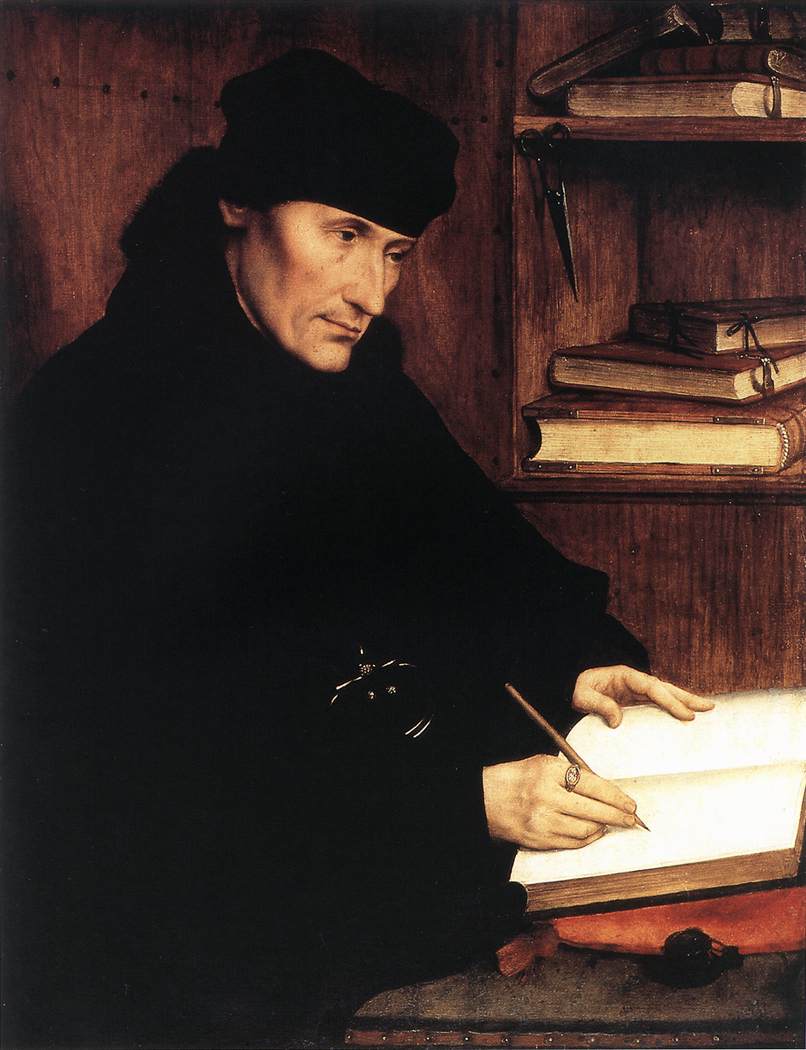 Portrait of Erasmus, after Quinten Massijs (1517) He referred to his irenical disposition in the Preface to On Free Will as a secret inclination of nature that would make him even prefer the views of the Sceptics over intolerant assertions, though he sharply distinguished adiaphora from what was uncontentiously explicit in the New Testament or absolutely mandated by Church teaching.[136] Concord demanded unity and assent: Erasmus was anti-sectarian[note 61] as well as non-sectarian.[137] To follow the law of love, our intellects must be humble and friendly when making any assertions: he called contention "earthly, beastly, demonic"[138]: 739 and a good-enough reason to reject a teacher or their followers. In Melancthon's view, Erasmus taught charity not faith.[139]: 10 Certain works of Erasmus laid a foundation for religious toleration of private opinions and ecumenism. For example, in De libero arbitrio, opposing certain views of Martin Luther, Erasmus noted that religious disputants should be temperate in their language, "because in this way the truth, which is often lost amidst too much wrangling may be more surely perceived." Gary Remer writes, "Like Cicero, Erasmus concludes that truth is furthered by a more harmonious relationship between interlocutors."[140] Erasmus' pacificism included a particular dislike for sedition, which caused warfare: It was the duty of the leaders of this (reforming) movement, if Christ was their goal, to refrain not only from vice, but even from every appearance of evil; and to offer not the slightest stumbling block to the Gospel, studiously avoiding even practices which, although allowed, are yet not expedient. Above all they should have guarded against all sedition. — Letter to Martin Bucer[141] Erasmus had been involved in early attempts to protect Luther and his sympathisers from charges of heresy. Erasmus wrote Inquisitio de fide to limit what should be considered heresy to fractiously agitating against essential doctrines (e.g., those of the Creed), with malice and persistence. As with St Theodore the Studite,[142] Erasmus was against the death penalty merely for private or peaceable heresy, or for dissent on non-essentials: "It is better to cure a sick man than to kill him."[143] The Church has the duty to protect believers and convert or heal heretics; he invoked Jesus' parable of the wheat and tares.[14]: 200 Nevertheless, he allowed the death penalty against violent seditionists, to prevent bloodshed and war: he allowed that the state has the right to execute those who are a necessary danger to public order—whether heretic or orthodox—but noted (e.g., to fr:Noël Béda) that Augustine had been against the execution of even violent Donatists: Johannes Trapman states that Erasmus' endorsement of suppression of the Anabaptists springs from their refusal to heed magistrates and the criminal violence of the Münster rebellion not because of their heretical views on baptism.[144] Despite these concessions to state power, he suggested that religious persecution could still be challenged as inexpedient (ineffective).[145] In a letter to Cardial Lorenzo Campeggio, Erasmus lobbied diplomatically for toleration: "If the sects could be tolerated under certain conditions (as the Bohemians pretend), it would, I admit, be a grievous misfortune, but one more endurable than war."[citation needed] Jews and Turks While the focus of most of his writing was about peace within Christendom with a sole focus on Europe until his last decade, he was involved in the public policy debate on war with the Ottoman Empire, which was then invading Western Europe, notably in his book On the war against the Turks (1530), with Pope Leo X promoting going on the offensive with a new crusade.[note 62] Erasmus re-worked Luther's rhetoric that the invading Turks represent God's judgment of decadent Christendom, but without Luther's fatalism: Erasmus not only accused Western leaders of kingdom-threatening hypocrisy, he proposed a remedy: anti-expansionist moral reforms by Europe's disunited leaders as a necessary unitive political step before aggressive warfare against the Ottoman threat, reforms which might themselves, if sincere, prevent both the internecine and foreign warfare.[103]  Juan Luis Vives In common with his times,[146] Erasmus regarded the Jewish and Islamic religions as Christian heresies rather than separate religions, using the inclusive term half-Christian for the latter. However, there is a wide range of scholarly opinion on the extent and nature of antisemitic and anti-Moslem prejudice in his writings: Erasmus scholar Shimon Markish wrote that the charge of antisemitism could not be sustained in Erasmus' public writings,[147] however historian Nathan Ron has found his writing to be harsh and racial in its implications, with contempt and hostility to Islam.[148] Biographer James Tracy sees an anti-semitic edge in Erasmus' comments against Johannes Pfefferkorn in the Ruechlin affair, which expresses Erasmus' general "suspicion of those who, behind the scenes, manipulate influence and opinion for nefarious ends."[note 63] Erasmus was not vehemently antisemitic in the way of the later post-Catholic Martin Luther; it was not a topic or theme of his public writing. Erasmus claimed not to be personally xenophobic: "For I am of such a nature that I could love even a Jew, were he a pleasant companion and did not spew out blasphemy against Christ"[note 64] however Markish suggests that it is probable Erasmus never actually encountered a (practicing) Jew.[149][note 65] Unusually for a Christian theologian of any time, he perceived and championed strong Hellenistic rather than exclusively Hebraic influences on the intellectual milieux of Jesus, Paul and the early church.[note 66] Interpretation caveats: analogy, irony, foils The picture is complicated because when Erasmus wrote of Judaism, he frequently was not referring to contemporary Jews but allegorically, by analogy with Second Temple Judaism, to Christians of his time who mistakenly promoted external ritualism over interior piety,[note 67] notably in the monastic lifestyle.[note 68] Erasmus' pervasive anti-ceremonialism treated the early Church debates on circumcision, food and special days as manifestations of cultural chauvinism, a general human characteristic, by the initial Jewish Christians.[note 69] Erasmus often wrote in a highly ironical idiom,[119] especially in his letters,[note 70] which makes them prone to different interpretations when taken literally rather than ironically.[note 71] Erasmus chided Ulrich von Hutten's claims that Erasmus was a Lutheran, saying that von Hutten had not detected the irony in Erasmus' public letters enough.[95]: 27 Terence J. Martin identifies an "Erasmian pattern" that the supposed (by the reader) otherness (of Jews, Turks, Lapplanders, Indians, and even women and heretics) "provides a foil against which the failures of Christian culture can be exposed and criticized."[152] In de bello Turcico, Erasmus allegorizes that we should "kill the Turk, not the man."[note 72] On the subject of slavery, Erasmus characteristically treated it in passing when dealing with tyranny: Christians were not allowed to be tyrants, which slave-owning required, but especially not to be the masters of other Christians.[153] Erasmus had various other piecemeal arguments against slavery: for example, that it was not legitimate to have slaves taken in an unjust war, but it was not a subject that occupied him. Domestic and community peace Further information: § On the Institution of Christian Marriage (1526) Further information: Pre-Tridentine Mass § Vernacular and laity in the medieval and Reformation eras Erasmus' emphasis on peacemaking reflects a typical pre-occupation of medieval lay spirituality as historian John Bossy (as summarized by Eamon Duffy) puts it: "medieval Christianity had been fundamentally concerned with the creation and maintenance of peace in a violent world. “Christianity” in medieval Europe denoted neither an ideology nor an institution, but a community of believers whose religious ideal—constantly aspired to if seldom attained—was peace and mutual love."[154] In marriage, Erasmus' two significant innovations, according to historian Nathan Ron, were that "matrimony can and should be a joyous bond, and that this goal can be achieved by a relationship between spouses based on mutuality, conversation, and persuasion."[155]: 4:43 |
思想と見解 あるカトリック史家は、エラスムスには独特の思考様式があったと指摘する。それは、「人間の繁栄に対する深く変わらぬコミットメント」[119]をもっ て、広い認識力、機敏な判断力、不穏な皮肉[119]を持つものであり、「あらゆる領域において、彼の見通しは本質的に司牧的であった」[14]: 225。 エラスムスは、一貫した、あるいは体系的な思想家というよりは、むしろ精液的な思想家と呼ばれており[120]、特に特定のものから一般的なものへと拡張 しすぎることを嫌っていた。それにもかかわらず、聖書の解釈に対して形而上学的なアプローチというよりはむしろ言語学的・歴史学的なアプローチを持ち [122][注釈 50]、文字通りの意味とトロポロジー的な意味に関心を持つ牧会的[注釈 49]かつ修辞学的な神学者として、非常に真剣に受け止めるべきである[14]: 145 フランスの神学者ルイ・ブイエは「エラスムスは、誤訳を疑うような釈義からは何の啓発も得られない人々の一人であった」とコメントしている[123]。 ある神学者は「エラスムスは自分以外の誰も満足させることができないことを覚悟していた」と書いている[124]。彼は批判的であったり、極端なものを嘲 笑するときでさえ、穏健で、判断力があり、建設的であると呼ばれている[125][注釈 51]。 平和主義 家庭的なものから宗教的なもの、政治的なものまで、あらゆる領域における平和、平和主義、平和創造は、キリスト教的生活に関するエラスムスの著作と神秘主 義神学の中心的な特徴であった。 彼(キリスト)は優しさによって征服し、優しさによって征服し、真理そのものによって征服した。 - 真の神学の方法』4 [注 53]: 570 エラスムスは絶対的平和主義者ではなかったが、政治的太平洋主義と宗教的イレニシズムを推進した[128]。イレニシズムに関する著名な著作には、『デ・ コンコルディア』、『トルコとの戦争について』、『キリスト教王子の教育』、『教会のコンコルドの回復について』、『平和の不満』などがある。エラスムス の平和創造に関する教会論は、教会当局には宗教的紛争を解決する神の使命があるとし[注 54]、教義をできれば最小限に発展させるなど、できるだけ排除しない方法で解決することを求めた。 後者において、平和婦人は、キリスト教生活の核心として、またキリストを理解するための平和を主張している: わたしはあなたがたにわたしの平和を与え、わたしの平和をあなたがたに残す」(ヨハネ14:27)。私の平和を与え、私の平和を残す」(ヨハネ14: 27)。馬でも、護衛でも、帝国でも、富でもない。では何なのか?彼は平和を与え、平和を残す-友との平和、敵との平和。 - 平和への不満[129] ある歴史家は彼を「16世紀の平和教育と平和文化の先駆者」と呼んだ[注釈 55]。 戦争 も参照: エラスムス§『平和の訴え』(1517年) エラスムスは幼い頃に戦争を経験し、特にキリスト教国王同士の戦争に懸念を抱いていた。彼の格言には「戦争は味わったことのない者にとっては甘いものであ る」(ピンダルのギリシャ語からDulce bellum inexpertis)などがある[注 56]。 彼は「金の布の野原」を推進し、その場に立ち会った[131]。彼の幅広い書簡はしばしば平和構築の問題に関連していた[注釈 57]。彼は仲裁による平和構築において教会が重要な役割を果たすと考えており[133]、教皇の地位は専制的な王侯や司教を統治するために必要であった [30]: 195 彼は正義の戦争理論の実際的な有用性と濫用[注 58]に疑問を呈し、さらに人民の支持を得た実現可能な防衛行動に限定し、「戦争は、最後の手段として、それを避けることができない場合を除き、決して引 き受けるべきでない」とした[134]。彼の格言の中で(一般的な訳語)"A disadvantageous peace is better than a just war"(不利な平和は正義の戦争にまさる)について論じており、これはキケロとジョン・コレットの "Better an unjust peace than the justest war "に負っている。 エラスムスは、教会の諸侯を含む同時代のヨーロッパの重要な諸侯の戦争的なやり方を非常に批判していた[注 59]。エラスムスは、これらの諸侯は「ゲームに結託しており、その結果は連邦を疲弊させ、抑圧することである」と考えていた[84]: s1.7。 4 彼はトマス・モア、ベアトゥス・レナヌス、アドリアヌス・バーランドゥスといった友人たちに送った書簡の中で、この問題についてより自由に語っていた。特 に批判の対象となったのは皇帝マクシミリアン1世であり、エラスムスはオランダがゲルダース[135]と和平条約を結ぶのを妨げたとされることや、臣民か ら金を引き出すために戦争を引き起こそうとするその他の企てを非難していた[注釈 60]。 エラスムスのアプローチのひとつは、1527年にポーランド王ジギスムント1世に宛てた手紙のように、強大な立場にありながら隣国と和平交渉を行った諸侯 に祝賀や讃美の手紙を送り、それを公表することであった[103]。 キリスト教の宗教的寛容  クインテン・マサイス(?)によるエラスムスの肖像画(1517年) エラスムスは、『自由意志について』の序文で、不寛容な主張よりも懐疑主義者の見解を好むような本性のひそかな傾きとして、自分のアイレン主義的な性格に ついて言及しているが、彼はアディアフォラと、新約聖書の中で議論の余地のないほど明示されているもの、あるいは教会の教えによって絶対的に義務づけられ ているものとを峻別していた[136]: エラスムスは反宗教主義者[注釈 61]であると同時に非宗教主義者であった[137]。 愛の法則に従うためには、私たちの知性はいかなる主張をするときにも謙虚で友好的でなければならない:彼は論争を「地上の、獣のような、悪魔のような」 [138]:739と呼び、教師やその信者を拒絶する十分な理由とした。メランクトンの見解では、エラスムスは信仰ではなく慈愛を教えていた[139]: 10 エラスムスのある著作は、私見に対する宗教的寛容とエキュメニズムの基礎を築いた。例えば、マルティン・ルターのある見解に反対した『De libero arbitrio』において、エラスムスは宗教論争者は言葉を慎むべきであると述べている。ゲーリー・レマーは、「キケロと同様に、エラスムスも、真理は 対話者間のより調和的な関係によって促進されると結論づけている」[140]と書いている。 エラスムスの平和主義には、戦争を引き起こす扇動に対する特別な嫌悪が含まれていた: キリストが彼らの目標であるならば、この(改革)運動の指導者たちの義務は、悪を慎むだけでなく、あらゆる悪の外観さえも慎むことであった。とりわけ、彼 らはあらゆる扇動から身を守るべきである。 - マルティン・ブッカーへの手紙[141]。 エラスムスは、ルターとその同調者を異端容疑から守ろうとする初期の試みに関わっていた。エラスムスは『Inquisitio de fide』を書き、異端とみなされるべきものを、悪意と執着をもって、本質的な教義(たとえば信条の教義)に対して分裂的に扇動することに限定した。聖テ オドール修道士[142]と同様に、エラスムスは、単に私的な異端や平和的な異端、あるいは本質的でない異端に対する死刑に反対していた: 「教会は信者を保護し、異端者を改宗させたり治癒したりする義務がある。 とはいえ、流血や戦争を防ぐために、暴力的な扇動者に対しては死刑を認めた。異端であろうと正統派であろうと、公序良俗に必要な危険をもたらす者を国家が 処刑する権利は認めるが、アウグスティヌスは暴力的なドナティストでさえも処刑することに反対していたことを(例えば、ノエル・ベダに対して)指摘した: ヨハネス・トラップマンは、エラスムスがアナバプテスト派の弾圧を支持したのは、彼らが洗礼に関する異端的な見解のためではなく、彼らが判事に従うことを 拒否したことと、ミュンスターの反乱の犯罪的暴力に起因すると述べている[144]。こうした国家権力への譲歩にもかかわらず、彼は宗教的迫害が依然とし て不都合(効果がない)として異議を唱えられる可能性があることを示唆していた[145]。 カーディアル・ロレンツォ・カンペッジョに宛てた手紙の中で、エラスムスは寛容を外交的に働きかけた: 「もし(ボヘミア人が装っているように)一定の条件のもとで諸宗派が容認されるのであれば、それは痛ましい不幸であることは認めますが、戦争よりは耐えら れるものです」[要出典]。 ユダヤ人とトルコ人 エラスムスは、晩年の10年間まで、キリスト教圏内の平和に焦点を当て、ヨーロッパにのみ焦点を当てていたが、当時西ヨーロッパに侵攻していたオスマン帝 国との戦争に関する公の政策論争に関与しており、特に『トルコとの戦争について』(1530年)では、教皇レオ10世が新たな十字軍による攻勢を推進して いた[注釈 62]。 エラスムスは、侵入してくるトルコ人が退廃したキリスト教に対する神の裁きを象徴しているというルターのレトリックを、ルターの宿命論抜きで再構築した: エラスムスは、西欧の指導者たちの王国を脅かす偽善を非難しただけでなく、オスマン帝国の脅威に対する積極的な戦争の前に必要な統一的な政治的ステップと して、ヨーロッパの分裂した指導者たちによる反拡大主義的な道徳的改革を、それ自体が、誠実であれば、内戦と外戦の両方を防ぐかもしれない改革として、救 済策を提案した[103]。  フアン・ルイス・ビベス 当時と同様に[146]、エラスムスはユダヤ教とイスラム教を別個の宗教というよりもむしろキリスト教の異端とみなし、後者にはハーフ・クリスチャンとい う包括的な用語を用いた。しかし、エラスムスの著作に見られる反ユダヤ的、反モスレム的偏見の程度や性質については、学者によってさまざまな見解がある: エラスムスの研究者であるシモン・マルキシュは、エラスムスの公的な著作において反ユダヤ主義を主張することはできないと書いているが[147]、歴史家 のネイサン・ロンは、エラスムスの著作は辛辣で人種差別的な意味合いが強く、イスラム教を侮蔑し敵視していると指摘している[148]。 [148] 伝記作家のジェームス・トレーシーは、エラスムスのリューヒリン事件におけるヨハネス・プフェフェルコルンに対する発言に反ユダヤ主義的な側面があると見 ており、これはエラスムスの一般的な「陰で影響力と世論を操り、邪悪な目的を達成しようとする者に対する疑念」[注釈 63]を表現している。 エラスムスは、後のポスト・カトリックのマルティン・ルターのように激しく反ユダヤ主義者というわけではなく、それは彼の公的な著作の話題やテーマではな かった。エラスムスは個人的には排外主義者ではないと主張している。「私はユダヤ人であっても、その人が愉快な仲間であり、キリストに対する冒涜を吐き出 さなければ、愛することができるような性質だからである」[注釈 64]が、マーキッシュはエラスムスが実際に(実践的な)ユダヤ人に出会ったことはない可能性が高いと指摘している[149][注釈 65]。 当時のキリスト教神学者としては珍しく、彼はイエス、パウロ、そして初代教会の知的環境において、ヘブライ的な影響というよりもむしろヘレニズム的な影響 を強く受け、それを支持していた[注 66]。 解釈の注意点:類推、皮肉、箔 エラスムスがユダヤ教について書いたとき、彼はしばしば現代のユダヤ人についてではなく、第二神殿ユダヤ教との類推によって、特に修道生活において、内面 的な敬虔さよりも外面的な儀式主義[注釈 67]を誤って推進した当時のキリスト教徒について寓意的に言及していたため、その図式は複雑であった[注釈 68] 。 エラスムスはしばしば非常に皮肉な慣用句で書いており[119]、特に書簡においては[注釈 70]、そのため皮肉的にではなく文字通りに解釈すると異なる解釈がなされやすい[注釈 71]。 エラスムスはウルリッヒ・フォン・ハッテンがエラスムスはルター派であったと主張していることを非難し、フォン・ハッテンがエラスムスの公の書簡における 皮肉を十分に見抜いていなかったと述べている[95]: 27。 テレンス・J・マーティンは、(読者が)想定する他者性(ユダヤ人、トルコ人、ラップランド人、インド人、さらには女性や異端者)が「キリスト教文化の失 敗を暴露し批判するための箔を提供する」という「エラスムス的パターン」を特定している[152]。 de bello Turcicoにおいて、エラスムスは「人間ではなくトルコ人を殺すべきである」と寓意している[注釈 72]。 奴隷制については、エラスムスは専制政治を扱う際に、一応の扱いをするのが特徴的であった: エラスムスは奴隷制に反対する様々な断片的な議論を持っていた。例えば、不当な戦争で奴隷を連行することは正当ではないというような議論であった。 国内と地域社会の平和 さらなる情報 § キリスト教の結婚制度について (1526) さらに詳しい情報 三位一体以前のミサ § 中世と宗教改革の時代における言語と信徒 エラスムスが平和創造を強調したのは、歴史家ジョン・ボッシー(イーモン・ダフィーの要約)が言うように、中世の信徒霊性の典型的な先入観を反映してい る: 「中世キリスト教は、暴力的な世界における平和の創造と維持に基本的な関心を持っていた。「中世ヨーロッパにおける "キリスト教 "は、イデオロギーでも制度でもなく、信者の共同体を示していた。 歴史家ネイサン・ロンによれば、結婚におけるエラスムスの2つの重要な革新は、「結婚は喜びの絆でありうるし、そうあるべきであり、この目標は相互性、会 話、説得に基づく配偶者間の関係によって達成されうる」ということであった[155]: 4:43 |
| Religious reform Erasmus expressed much of his reform program in terms of the proper attitude towards the sacraments, and their ramifications:[156] notably for the underappreciated sacraments of Baptism and Marriage (see On the Institution of Christian Marriage) considered as vocations more than events; and for the mysterious Eucharist, pragmatic Confession, the dangerous Last Rites (writing On the Preparation for Death),[note 73] and the pastoral Holy Orders (see Ecclesiastes.)[157] Historians have noted that Erasmus commended the benefits of immersive, docile scripture-reading in sacramental terms.[note 74] Anti-fraternalism Reacting from his own experiences, Erasmus came to believe that monastic life and institutions no longer served the positive spiritual or social purpose they once may have:[159]: 669 in the Enchiridion he controversially put it "Monkishness is not piety."[note 75] At this time, it was better to live as "a monk in the world" than in the monastery.[note 76] Many of his works contain diatribes against supposed monastic corruption, and particularly against the mendicant friars (Franciscans and Dominicans): these orders also typically ran the university Scholastic theology programs and from whose ranks came his most dangerous enemies. He was scandalized by superstitions, such as that if you were buried in a Franciscan habit you would go direct to heaven, crime[161] and child novices. He advocated various reforms, including a ban on taking orders until the 30th year, the closure of corrupt and smaller monasteries, respect for bishops, requiring work not begging (reflecting the practice of his own order of Augustinian Canons,) the downplaying of monastic hours, fasts and ceremonies, and a less mendacious approach to gullible pilgrims and tenants. However, he was not in favour of speedy closures: in his account of his pilgrimage to Walsingham, he noted that the funds extracted from pilgrims typically supported houses for the poor and elderly.[162] These ideas widely influenced his generation of humanists, both Catholic and Protestant,[163]: 152 and the lurid hyperbolic attacks in his half-satire The Praise of Folly were later treated by Protestants as objective reports of near-universal corruption. Furthermore, "what is said over a glass of wine, ought not to be remembered and written down as a serious statement of belief," such as his proposal to marry all monks to all nuns or to send them all away to fight the Turks and colonize new islands.[30] He believed the only vow necessary for Christians should be the vow of Baptism, and others such as the vows of the evangelical counsels, while admirable in intent and content, were now mainly counter-productive. Catholic reform 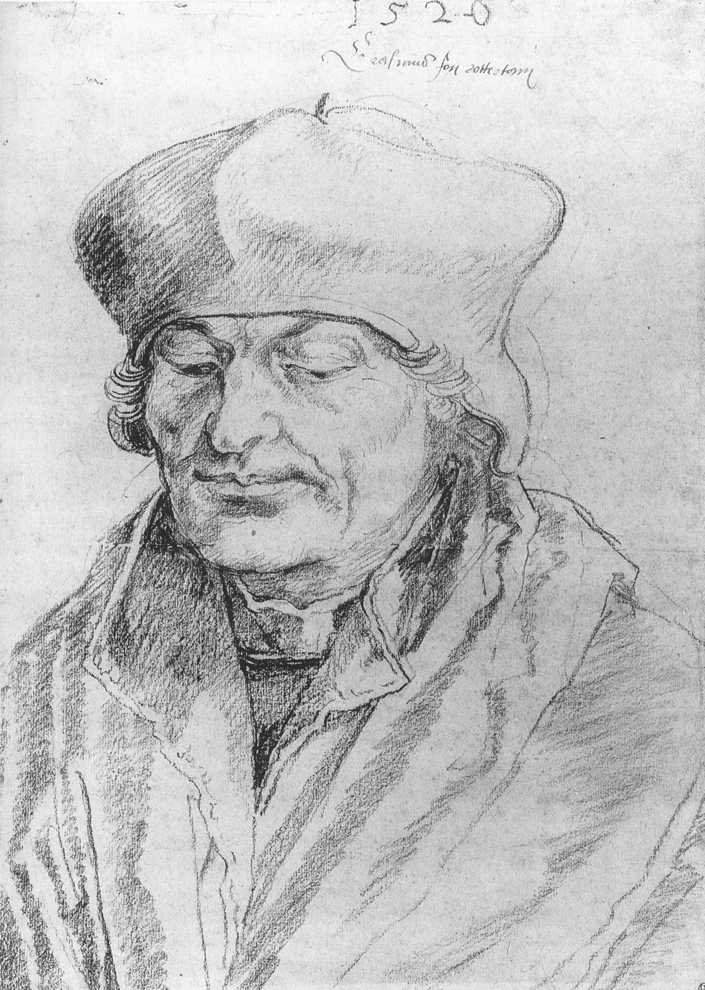 Albrecht Dürer, Portrait of Erasmus, sketch: black chalk on paper, 1520. The Protestant Reformation began in the year following the publication of his pathbreaking edition of the New Testament in Latin and Greek (1516). The issues between the reforming and reactionary tendencies of the church, from which Protestantism later emerged, had become so clear that many intellectuals and churchmen could not escape the summons to join the debate. According to historian C. Scott Dixon, Erasmus' not only criticized church failings but questioned many of his Church's basic teachings;[note 77] however, according to biographer Erika Rummel, "Erasmus was aiming at the correction of abuses rather than at doctrinal innovation or institutional change."[note 78] In theologian Louis Bouyer's interpretation[123] Erasmus' agenda was "to reform the Church from within by a renewal of biblical theology, based on philological study of the New Testament text, and supported by a knowledge of patristics, itself renewed by the same methods. The final object of it all was to nourish...chiefly moral and spiritual reform..."[note 79] Erasmus, at the height of his literary fame, was called upon to take one side, but partisanship was foreign to his beliefs, his nature and his habits. Despite all his criticism of clerical corruption and abuses within the Western Church,[note 80] especially at first he sided unambiguously with neither Luther nor the anti-Lutherans publicly (though in private he lobbied assiduously against extremism from both parties), but eventually shunned the breakaway Protestant Reformation movements along with their most radical offshoots.[112] "I have constantly declared, in countless letters, booklets, and personal statements, that I do not want to be involved with either party." — Erasmus, Spongia (1523) The world had laughed at his satire, The Praise of Folly, but few had interfered with his activities. He believed that his work so far had commended itself to the best minds and also to the dominant powers in the religious world. Erasmus chose to write in Latin (and Greek), the languages of scholars. He did not build a large body of supporters in the unlettered; his critiques reached a small but elite audience.[165] Disagreement with Luther  Cranach (1520), Portraits of Martin Luther and Philip Melanchthon Erasmus and Luther impacted each other greatly. Each had misgivings about each other from the beginning (Erasmus on Luther's rash and antagonistic character, Luther on Erasmus' focus on morality rather than grace) but strategically agreed not to be negative about the other in public. The early reformers built their theology by generalizing Erasmus' philological analyses of specific verses in the New Testament: repentance over penance (the basis of the first thesis of the Luther's 95 Theses), justification by imputation, grace as favour or clemency, faith as hoping trust,[166] human transformation over reformation, congregation over church, mystery over sacrament, etc. In Erasmus' view, they went too far and irresponsibly fomented bloodshed. Noting Luther's criticisms of corruption in the Church, Erasmus (before Luther's On the Babylonian Captivity of the Church (1520))[167] described Luther to Pope Leo X as "a mighty trumpet of gospel truth" while agreeing, "It is clear that many of the reforms for which Luther calls" (e.g., the sale of indulgences) "are urgently needed."[168] Behind the scenes Erasmus forbade his publisher Froben from handling the works of Luther[88]: 64 and tried to keep the reform movement focused on institutional rather than theological issues, yet he also privately wrote to authorities to prevent Luther's persecution. In the words of one historian, "at this earlier period he was more concerned with the fate of Luther than his theology."[169] Luther hoped for his cooperation in a work which seemed only the natural outcome of Erasmus' own,[note 81] and spoke with admiration of Erasmus's superior learning. In their early correspondence, Luther expressed boundless admiration for all Erasmus had done in the cause of a sound and reasonable Christianity and urged him to join the Lutheran party. Erasmus declined to commit himself, arguing his usual "small target" excuse, that to do so would endanger the cause of bonae litterae[note 82][170] which he regarded as one of his purposes in life. Only as an independent scholar could he hope to influence the reform of religion. When Erasmus declined to support him, the straightforward Luther became angered that Erasmus was avoiding the responsibility due either to cowardice or a lack of purpose. However, any hesitancy on the part of Erasmus may have stemmed, not from lack of courage or conviction, but rather from a concern over the mounting disorder and violence of the reform movement. To Philip Melanchthon in 1524 he wrote: I know nothing of your church; at the very least it contains people who will, I fear, overturn the whole system and drive the princes into using force to restrain good men and bad alike. The gospel, the word of God, faith, Christ, and Holy Spirit – these words are always on their lips; look at their lives and they speak quite another language.[171] Catholic theologian George Chantraine notes that where Luther quotes Luke 11:21 "He that is not with me is against me" Erasmus takes Mark 9:40 "For he that is not against us, is on our part."[172]: 86 Though he sought to remain accommodative in doctrinal disputes, each side accused him of siding with the other, perhaps because of his perceived influence and what they regarded as his dissembling neutrality,[note 83] which he regarded as peacemaking accommodation: I detest dissension because it goes both against the teachings of Christ and against a secret inclination of nature. I doubt that either side in the dispute can be suppressed without grave loss. — "On Free Will"[168] Dispute on free will Main article: De libero arbitrio diatribe sive collatio Further information: § On Free Will (1524) By 1523, and first suggested in a letter from Henry VIII, Erasmus had been convinced that Luther's ideas on necessity/free will were a subject of core disagreement deserving a public airing, and strategized with friends and correspondents[173] on how to respond with proper moderation[174] without making the situation worse for all, especially for the humanist reform agenda. He eventually chose a campaign that involved an irenical 'dialogue' "The Inquisition of Faith", a positive, evangelical model sermon "On the Measureless Mercy of God", and a gently critical 'diatribe' "On Free Will." The publication of his brief book On Free Will initiated what has been called "The greatest debate of that era" [175] which still has ramifications today.[176] They bypassed discussion on reforms which they both agreed on in general, and instead dealt with authority and biblical justifications of synergism versus monergism in relation to salvation. Luther responded with On the Bondage of the Will (De servo arbitrio) (1525). Erasmus replied to this in his lengthy two volume Hyperaspistes and other works, which Luther ignored. Apart from the perceived moral failings among followers of the Reformers—an important sign for Erasmus—he also dreaded any change in doctrine, citing the long history of the Church as a bulwark against innovation. He put the matter bluntly to Luther: We are dealing with this: Would a stable mind depart from the opinion handed down by so many men famous for holiness and miracles, depart from the decisions of the Church, and commit our souls to the faith of someone like you who has sprung up just now with a few followers, although the leading men of your flock do not agree either with you or among themselves – indeed though you do not even agree with yourself, since in this same Assertion[177] you say one thing in the beginning and something else later on, recanting what you said before. — Hyperaspistes I[178] Continuing his chastisement of Luther – and undoubtedly put off by the notion of there being "no pure interpretation of Scripture anywhere but in Wittenberg"[179] – Erasmus touches upon another important point of the controversy: You stipulate that we should not ask for or accept anything but Holy Scripture, but you do it in such a way as to require that we permit you to be its sole interpreter, renouncing all others. Thus the victory will be yours if we allow you to be not the steward but the lord of Holy Scripture. — Hyperaspistes, Book I[180] "False evangelicals" In 1529, Erasmus wrote "An epistle against those who falsely boast they are Evangelicals" to Vulturius Neocomus (Gerardus Geldenhouwer). You declaim bitterly against the luxury of priests, the ambition of bishops, the tyranny of the Roman Pontiff, and the babbling of the sophists; against our prayers, fasts, and Masses; and you are not content to retrench the abuses that may be in these things, but must needs abolish them entirely. ...[181] Here Erasmus complains of the doctrines and morals of the Reformers, applying the same critique he had made about public Scholastic disputations: Look around on this 'Evangelical' generation,[182] and observe whether amongst them less indulgence is given to luxury, lust, or avarice, than amongst those whom you so detest. Show me any one person who by that Gospel has been reclaimed from drunkenness to sobriety, from fury and passion to meekness, from avarice to liberality, from reviling to well-speaking, from wantonness to modesty. I will show you a great many who have become worse through following it. ...The solemn prayers of the Church are abolished, but now there are very many who never pray at all. ... I have never entered their conventicles, but I have sometimes seen them returning from their sermons, the countenances of all of them displaying rage, and wonderful ferocity, as though they were animated by the evil spirit. ... Who ever beheld in their meetings any one of them shedding tears, smiting his breast, or grieving for his sins? ...Confession to the priest is abolished, but very few now confess to God. ...They have fled from Judaism that they may become Epicureans. — Epistola contra quosdam qui se falso iactant evangelicos.[183] Sacraments 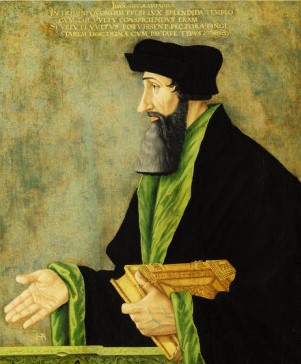 Johannes Œcolampadius by Asper (1550) A test of the Reformation was the doctrine of the sacraments, and the crux of this question was the observance of the Eucharist. Erasmus was concerned that the sacramentarians, headed by Œcolampadius of Basel, were claiming Erasmus held views similar to their own in order to try to claim him for their schismatic and "erroneous" movement. In 1530, Erasmus published a new edition of the orthodox treatise of Algerus against the heretic Berengar of Tours in the eleventh century. He added a dedication, affirming his belief in the reality of the Body of Christ after consecration in the Eucharist, commonly referred to as transubstantiation. [184] Other Erasmus wrote books against aspects of the teaching, impacts or threats of several other Reformers:[185] Ulrich von Hutten Spongia adversus aspergines Hutteni (1523) see below Martin Bucer Responsio ad fratres Inferioris Germaniae ad epistolam apologeticam incerto autoreproditam (1530) Heinrich Eppendorf Admonitio adversus mendacium et obstrectationem (1530) However, Erasmus maintained friendly relations with other Protestants, notably the irenic Melancthon and Albrecht Duerer. A common accusation, supposedly started by antagonistic monk-theologians,[note 84] made Erasmus responsible for Martin Luther and the Reformation: "Erasmus laid the egg, and Luther hatched it." Erasmus wittily dismissed the charge, claiming that Luther had "hatched a different bird entirely."[187] Erasmus-reader Peter Canisius commented: "Certainly there was no lack of eggs for Luther to hatch."[188][note 85] Philosophy and Erasmus 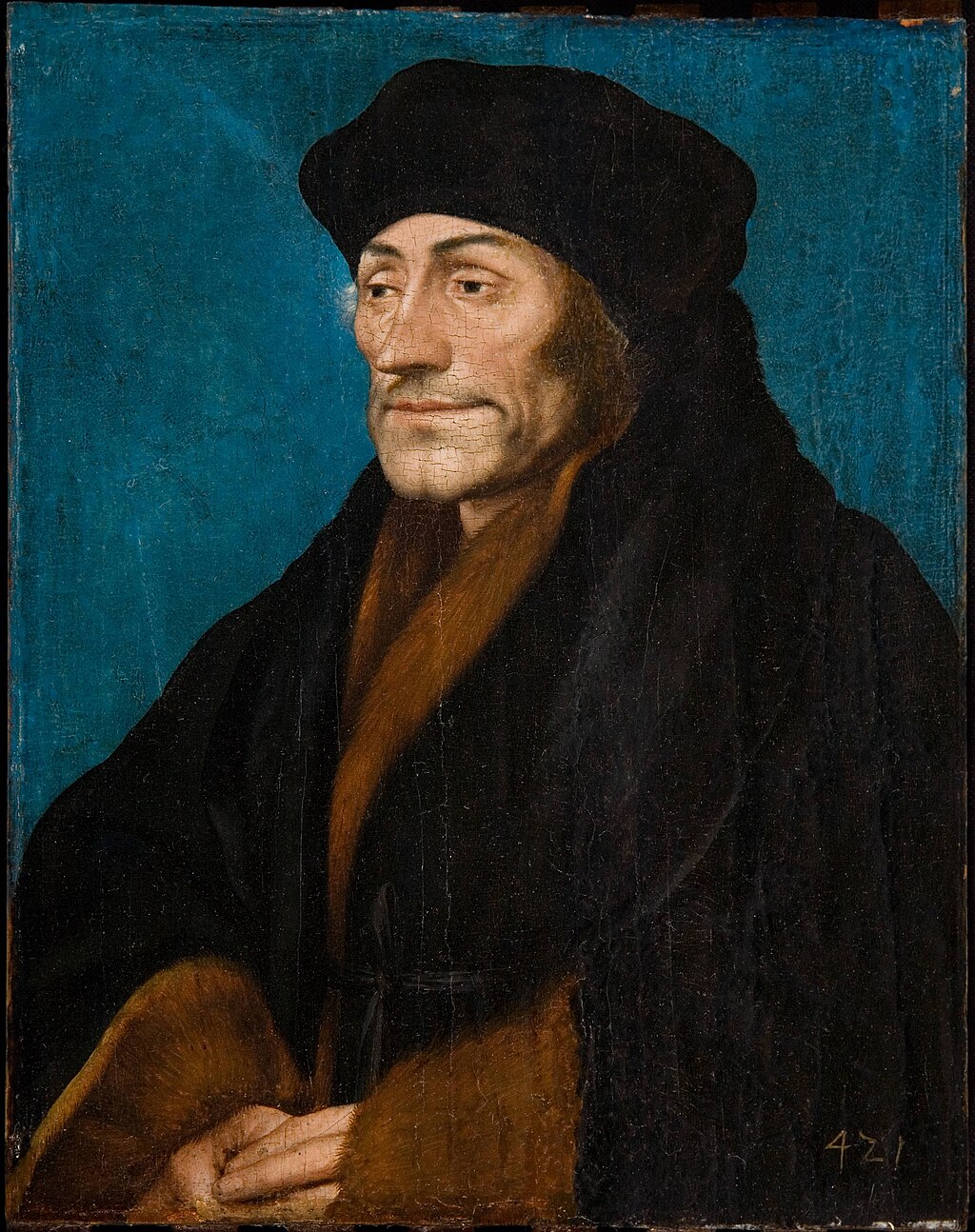 Portrait by Hans Holbein the Younger and workshop Erasmus has a problematic standing in the history of philosophy: whether he should be called a philosopher at all,[note 86] (as, indeed, some question whether he should be considered a theologian either.[14]: 205 ) Erasmus deemed himself to be a rhetorician or grammarian rather than a philosopher.[189]: 66 He was particularly influenced by satirist and rhetorician Lucian.[note 87] Erasmus' writings shifted "an intellectual culture from logical disputation about things to quarrels about texts, contexts, and words."[186] Classical Erasmus syncretistically took phrases, ideas and motifs from many classical philosophers to furnish discussions of Christian themes:[note 88] academics have identified aspects of his thought as variously Platonist (duality),[note 89] Cynical (asceticism),[191] [192] Stoic (adiaphora),[193] Epicurean (ataraxia,[note 90] pleasure as virtue),[194] realist/non-voluntarist,[195] and Isocratic (rhetoric, political education, syncretism.)[196]: 19 However, his Christianized version of Epicureanism is regarded as his own.[197] Erasmus was sympathetic to a kind of Scepticism:[note 91] A Sceptic is not someone who doesn't care to know what is true or false…but rather someone who does not make a final decision easily or fight to the death for his own opinion, but rather accepts as probable what someone else accepts as certain…I explicitly exclude from Scepticism whatever is set forth in Sacred Scripture or whatever has been handed down to us by the authority of the Church. — Erasmus[199] Historian Kirk Essary has noted that from his earliest to last works Erasmus "regularly denounced the Stoics as specifically unchristian in their hardline position and advocacy of apatheia": warm affection and an appropriately fiery heart being inalienable parts of human sincerity;[200]: 17 however historian Ross Dealy sees Erasmus' decrial of other non-gentle "perverse affections" as having Stoical roots.[193] He eschewed metaphysical, epistemological and logical philosophy as found in Aristotle,[note 92] in particular the curriculum and systematic methods of the post-Aquinas Schoolmen (Scholastics)[note 93] and their frigid, counter-productive Aristoteleanism: "What has Aristotle to do with Christ?"[202] We should avoid philosophical factionalism and so "make the whole world Christian."[203]: 851 Indeed, Erasmus thought that Scholastic philosophy actually distracted participants from their proper focus on immediate morality,[note 94][note 95] unless used moderately.[note 96] And, by "excluding the Platonists from their commentaries, they strangle the beauty of revelation."[note 97] Erasmus wrote in terms of a tri-partite nature of man, with the soul the seat of free will: The body is purely material; the spirit is purely divine; the soul…is tossed back and forwards between the two according to whether it resists or gives way to the temptations of the flesh. The spirit makes us gods; the body makes us beasts; the soul makes us men. — Erasmus[205] According to theologian George van Kooten, Erasmus was the first modern scholar "to note the similarities between Plato's Symposium and John's Gospel", first in the Enchiridion then in the Adagia, pre-dating other scholarly interest by 400 years.[206][citation needed] Philosophia Christi (Not to be confused with his Italian contemporary Chrysostom Javelli's Philosophia Christiana.) Erasmus approached classical philosophers theologically and rhetorically: their value was in how they pre-saged, explained or amplified the unique teachings of Christ (particularly the Sermon on the Mount[14]: 117 ): the philosophia Christi.[note 98][note 99] "A great part of the teaching of Christ is to be found in some of the philosophers, particularly Socrates, Diogenes and Epictetus. But Christ taught it much more fully, and exemplified it better..." (Paraclesis) In fact, Christ was "the very father of philosophy" (Anti-Barbieri.)[note 100] In works such as his Enchiridion, The Education of a Christian Prince and the Colloquies, Erasmus developed his idea of the philosophia Christi, a life lived according to the teachings of Jesus taken as a (spiritual-ethical-social-political-legal[207]) philosophy:[note 101] Christ the heavenly teacher has founded a new people on earth,…Having eyes without guile, these folk know no spite or envy; having freely castrated themselves, and aiming at a life of angels while in the flesh, they know no unchaste lust; they know not divorce, since there is no evil they will not endure or turn to the good; they have not the use of oaths, since they neither distrust nor deceive anyone; they know not the hunger for money, since their treasure is in heaven, nor do they itch for empty glory, since they refer all things to the glory of Christ.…these are the new teachings of our founder, such as no school of philosophy has ever brought forth. — Erasmus, Method of True Theology In philosopher Étienne Gilson's summary: "the quite precise goal he pursues is to reject Greek philosophy outside of Christianity, into which the Middle Ages introduced Greek philosophy with the risk of corrupting this Christian Wisdom."[209] Useful "philosophy" needed to be limited to (or re-defined as) the practical and moral: You must realize that 'philosopher' does not mean someone who is clever at dialectics or science but someone who rejects illusory appearance and undauntedly seeks out and follows what is true and good. Being a philosopher is in practice the same as being a Christian; only the terminology is different." — Erasmus, Anti-Barbieri Theology of Erasmus Three key distinctive features of Erasmus' theology are accommodation, inverbation, and scopus christi. [note 102] (Scopus is the unifying reference point, the navigation goal, or the organizing principle of topics.) In the view of literary historian Chester Chapin, Erasmus' tendency of thought was "towards cautious dulcification of the traditional view."[note 103] Accommodation Historian Manfred Hoffmann has described accommodation as "the single most important concept in Erasmus' hermeneutic." [note 104] For Erasmus, accommodation is a universal concept: humans must accommodate each other, we must accommodate the church and vice versa, and we must take as our model how Christ accommodated the disciples in his interactions with them, and accommodated humans in his incarnation, which in turn merely reflects the eternal mutual accommodation within the Trinity. And the primary mechanism of accommodation is language,[note 105]: 6 which mediates between reality and abstraction, which allows disputes of all kinds to be resolved and the gospel to be transmitted:[213] in his New Testament, Erasmus notably translated the Greek logos in John 1:1 "In the beginning was the Word" using Latin sermo (discourse, conversation, language) not verbum (word) emphasizing the dynamic and interpersonal communication rather than static principle: more like "In the beginning was Speech".[214] The role models of accommodation[note 106] were Paul, that "chameleon"[215]: 385 (or "slippery squid"[216]) and Christ, who was "more mutable than Proteus himself."[215]: 386 In this light, Erasmus' ability to have friendly correspondence with both Thomas More and Thomas Bolyn,[105] and with both Philip Melancthon and Pope Adrian VI, can be seen as outworkings of his theology, rather than slippery insincerity[note 70] or flattery of potential patrons. Similarly, it shows the theological basis of his pacificism, and his view of ecclesiastical authorities—from priests like himself to Church Councils—as necessary mediating peace-brokers. Inverbation For Erasmus, further to accommodating humans in his Incarnation, Christ accommodated us by a kind of inverbation:[note 107] being captured in the Gospels in a way that we can know him better by reading him (in the awareness of the resurrection) than those who actually heard him speak;[note 108] this will or may transform us.[note 109] Since the Gospels become, in effect, like sacraments:[217][note 110] for Erasmus reading them becomes a form of prayer which is spoiled by taking single sentences in isolation and using them as syllogisms. Instead, learning to understand the genres and literary expression in the New Testament becomes a spiritual exercise.[213] Erasmus' has been called rhetorical theology (theologia rhetorica.)[160]: 32 Scopus christi In Hoffmann's words, for Erasmus "Christ is the scopus of everything": "the focus in which both dimensions of reality, the human and the divine, intersect" and so he himself is the hermeneutical principle of scripture": "the middle is the medium, the medium is the mediator, the mediator is the reconciler."[213]: 9 In Erasmus' early Enchiridion he had given this scopus in typical medieval terms of an ascent of being to God (vertical), but from the mid-1510s life he moved to an analogy of Copernican planetary circling around Christ the centre (horizontal) or Columbian navigation towards a destination.[14]: 135 One effect is that scriptural interpretation must be done starting with the teachings and interactions of Jesus in the Gospels,[219]: 78 with the Sermon on the Mount serving as the starting point,[note 111][138] and arguably with the Beatitudes and the Lord's Prayer at the head of the queue.[citation needed] This privileges peacemaking, mercy, meekness,[note 112] purity of heart, hungering after righteousness, poverty of spirit, etc. as the unassailable core of Christianity and piety and true theology.[note 113] The Sermon on the Mount provides the axioms on which every legitimate theology must be built, as well as the ethics governing theological discourse, and the rules for validating theological products; Erasmus' philosophia christi treats the primary and initial teaching of Jesus in the first Gospel as a theological methodology.[note 114] For example, "peacemaking" is a possible topic in any Christian theology; but for Erasmus, from the Beatitude, it must be a starting-, reference- and ending-point when discussing all other theological notions, such as church authority, the Trinity, etc. Moreover, Christian theology must only be done in a peacemaking fashion for peacemaking purposes; and any theology that promotes division and warmongering is thereby anti-Christian. [note 115] Mystical Theology Another important concept to Erasmus was "the Folly of the Cross"[14]: 119 (which The Praise of Folly explored):[note 116] the view that Truth belongs to the exuberant, perhaps ecstatic,[14]: 140 world of what is foolish, strange and unexpected to us,[222] rather than to the frigid worlds which intricate scholastic dialectical and syllogistic philosophical argument generate; this produced in Erasmus a profound disinterest in hyper-rationality,[note 117] and an emphasis on verbal, rhetorical, mystical, pastoral and personal/political moral concerns instead. Theological Writings We may distinguish four different lines of work, parallel with each other, and complementary. First, the establishing and critical elucidation of the biblical texts; alongside it, the editions of the great patristic commentators; then, the exegetical works properly so called, in which these two fundamental researches yield their fruit; and finally, the methodological works, which in their first state constitute a sort of preface to the various other studies, but which—in return—were nourished and enlarged by them as they went along. — Louis Bouyer[123]: 498 Apart from these programmatic works, Erasmus also produce a number of prayers, sermons, essays, masses and poems for specific benefactors and occasions, often on topics where Erasmus and his benefactor agreed. For example, in his Paean in Honour of the Virgin Mary (1503) Erasmus elaborated his theme that the Incarnation had been hinted far and wide, which could impact the theology of the fate of the remote unbaptized and grace, and the place of classical philosophy:[223] "You are assuredly the Woman of renown: both heaven and earth and the succession of all the ages uniquely join to celebrate your praise in a musical concord. [...] During the centuries of the previous age the oracles of the gentiles spoke of you in obscure riddles. Egyptian prophecies, Apollo’s tripod, the Sibylline books, gave hints of you. The mouths of learned poets predicted your coming in oracles they did not understand. [...] Both the Old and the New Testament, like two cherubim with wings joined and unanimous voices, repeatedly sing your praise. [...] Thus indeed have writers religiously vied to proclaim you, on the one hand inspired prophets, on the other eloquent Doctors of the church, both filled with the same spirit, as the former foretold your coming in joyful oracles before your birth and the latter heaped prayerful praise on you when you appeared." — Erasmus, Paean in Honour of the Virgin Mary (1503)[223] |
宗教改革 特に、洗礼と結婚(『キリスト教的結婚の制度について』参照)という、出来事というよりも召命とみなされる、過小評価されている秘跡について、また神秘的 な聖体、実際的な告解、危険な最後の儀式(『死の準備について』を執筆)[注釈 73]、司牧的な聖職叙階(『伝道者の書』参照)についてである。 歴史家たちは、エラスムスが没頭的で従順な読経の利点を秘跡的な用語で称賛していたことを指摘している[注釈 74]。 反友愛主義 エラスムスは自身の経験から、修道院生活や制度はもはやかつてそうであったような積極的な精神的あるいは社会的な目的を果たすものではないと考えるように なった[159]。 彼の著作の多くには、修道院の堕落、特に托鉢修道士(フランシスコ会とドミニコ会)に対する誹謗中傷が含まれており、これらの修道会は一般的に大学のスコ ラ神学課程も運営しており、その中から彼の最も危険な敵が生まれた。フランシスコ会の修道服を着て埋葬されると天国に直行できるといった迷信や、犯罪 [161]、子供の修道士に心を痛めた。彼は、30年目までの修道禁止、堕落した小規模修道院の閉鎖、司教の尊重、物乞いではなく労働の義務付け(アウグ スティノ会修道士の修道会の慣習を反映したもの)、修道時間、断食、儀式の軽視、騙されやすい巡礼者や借家人に対する托鉢的なアプローチの緩和など、さま ざまな改革を提唱した。 しかし、彼は早急な閉鎖には賛成していなかった。ウォルシンガムへの巡礼についての記述の中で、彼は巡礼者から引き出した資金が、一般的に貧しい人々や高 齢者のための家を支えていることを指摘している[162]。 こうした考えは、カトリックとプロテスタントを問わず、同世代の人文主義者たちに広く影響を与えた[163]: 152と、彼の半分風刺劇である『愚行礼 賛』における薄気味悪い誇張された攻撃は、後にプロテスタントによって、ほぼ普遍的な腐敗の客観的な報告として扱われた。さらに、すべての修道士をすべて の尼僧と結婚させることや、トルコ軍と戦い新しい島々を植民地化するためにすべての修道士を送り出すことを提案するなど、「ワインを飲みながら語ったこと は、真剣な信念の表明として記憶され、書き留められるべきものではない」[30]。 彼はキリスト教徒に必要な誓願は洗礼の誓願だけであるべきだと考え、福音的助言の誓願のような他の誓願は、その意図と内容においては賞賛に値するもので あったが、現在では主に逆効果であった。 カトリックの改革  アルブレヒト・デューラー、エラスムスの肖像、スケッチ:紙に黒チョーク、1520年。 プロテスタント宗教改革は、エラスムスがラテン語とギリシア語による新約聖書の画期的な版を出版(1516年)した翌年に始まった。後にプロテスタンティ ズムが生まれた教会の改革的傾向と反動的傾向の間の問題は、多くの知識人や教会関係者が議論に加わるよう呼びかけられるのを免れないほど明確になってい た。 歴史家のC・スコット・ディクソンによれば、エラスムスは教会の欠点を批判しただけでなく、教会の基本的な教えの多くに疑問を呈していた[注釈 77]。しかし伝記作家のエリカ・ルンメルによれば、「エラスムスが目指していたのは、教義の革新や制度の変更というよりも、むしろ悪弊の是正であった」 [注釈 78]。 神学者ルイス・ブイヤーの解釈[123]によれば、エラスムスの目的は「新約聖書本文の文献学的研究に基づく聖書神学の刷新によって教会を内部から改革す ることであり、同じ方法によって刷新された教父学の知識によって支えられていた。そのすべての最終的な目的は、...主として道徳的・精神的改革を養うこ とであった...」[注 79]。 エラスムスは、その文学的名声の絶頂期において、一方の側に立つことを求められたが、党派性は彼の信条、性質、習慣とは異質なものであった。西方教会内の 聖職者の腐敗や虐待を批判していたにもかかわらず[注釈 80]、特に最初のうちは、公の場ではルター派にも反ルター派にも明確に味方しなかったが(私的な場では両派の過激主義に対して熱心に働きかけたが)、最 終的には、最も急進的な分派とともに、プロテスタント宗教改革の分派運動を敬遠した[112]。 "私は、数え切れないほどの手紙、小冊子、個人的な声明の中で、どちらの党とも関わりたくないと常に宣言してきた。" - エラスムス『スポンジア』(1523年) 世間は彼の風刺小説『愚行礼賛』を笑ったが、彼の活動を妨害する者はほとんどいなかった。エラスムスは、これまでの自分の著作が、宗教界における支配的な 権力者たちにも、最高の知性にも認められたと信じていた。エラスムスは学者の言語であるラテン語(とギリシャ語)で書くことを選んだ。エラスムスの批評 は、少数ではあるがエリートの読者に届いた[165]。 ルターとの不一致  クラーナハ(1520年)『マルティン・ルターとフィリップ・メランヒトンの肖像』 エラスムスとルターは互いに大きな影響を与え合っていた。エラスムスはルターの猪突猛進で敵対的な性格に、ルターはエラスムスが恩寵よりも道徳に重点を置 いていることに)。しかし戦略的には、公の場では相手を否定しないことで一致していた。 初期の改革者たちは、エラスムスの新約聖書の特定の箇所に関する文献学的分析を一般化することによって、自分たちの神学を構築していった。懺悔よりも悔い 改め(ルターの「95ヶ条の論題」の第一テーゼの基礎)、付与による義認、恩寵や寛容としての恵み、希望的信頼としての信仰、改革よりも人間の変革、教会 よりも信徒、秘跡よりも神秘などである。エラスムスの見解では、彼らは行き過ぎであり、無責任に流血を煽った。 エラスムスは(ルターの『教会のバビロン的捕囚について』(1520年)以前の)教会の腐敗に対するルターの批判に注目し、教皇レオ10世にルターを「福 音の真理の力強いラッパ」と評したが[167]、その一方で、「ルターが求めている改革の多く」(たとえば、免罪符の販売)については「明らかである」と 同意している、 裏では、エラスムスは出版社のフローベンにルターの著作を扱うことを禁じ[88][64]、改革運動を神学的な問題よりも制度的な問題に集中させようとし たが、ルターが迫害されるのを防ぐために当局に内々に手紙を書いたりもしていた。ある歴史家の言葉を借りれば、「この初期の時期、彼はルターの神学よりも ルターの運命に関心を寄せていた」[169]。 ルターは、エラスムス自身の自然な成果に過ぎないと思われる仕事への彼の協力を望み[注釈 81]、エラスムスの優れた学識に感嘆の念を込めて語った。ルターは、初期の書簡の中で、エラスムスが健全で合理的なキリスト教の大義のために行ったすべ てのことに限りない賞賛を表し、ルター派に加わるよう促した。エラスムスは、そうすることは、彼が人生の目的のひとつとみなしていたボナエ・リテラエ[注 釈 82][170]の大義を危うくすることになるという、いつもの「小さな目標」の言い訳を主張し、身を投じることを辞退した。独立した学者としてのみ、彼 は宗教改革に影響を与えることを望むことができた。エラスムスが彼を支援することを断ると、素直なルターは、エラスムスは臆病なのか目的がないのか、責任 を回避しているのだと怒った。 しかし、エラスムスが躊躇したのは、勇気や信念の欠如からではなく、むしろ改革運動が無秩序で暴力的になりつつあることへの懸念からだったのかもしれな い。1524年、フィリップ・メランヒトンに宛てて、彼はこう書いた: 私はあなたがたの教会のことを何も知らない。少なくとも、この教会には、体制全体を覆し、善人も悪人も同じように抑制するために諸侯を武力行使に駆り立て るような人々がいるのではないかと私は恐れている。福音、神の言葉、信仰、キリスト、聖霊、これらの言葉は常に彼らの口から出てくるが、彼らの生活を見て みると、まったく別の言葉を話している[171]。 カトリックの神学者ジョージ・シャントレーヌは、ルターがルカ11:21「わたしとともにいない者は、わたしに敵対する者である」を引用しているのに対 し、エラスムスはマルコ9:40「わたしたちに敵対しない者は、わたしたちの味方である」[172]: 86を引用していると指摘している。 エラスムスは教義上の論争において融和的であり続けようと努めたが、おそらくは彼の影響力の大きさと、和平のための融和とみなされた彼の曖昧な中立性[注 釈 83]のために、各陣営は彼が他方の味方をしていると非難した: 不和はキリストの教えにも、自然の秘めたる傾向にも反するので、私は嫌悪する。キリストの教えに反し、また自然のひそかな傾向にも反するからである。 - 自由意志について」[168] 自由意志に関する論争 主な記事 自由意志に関する論争 さらなる情報 § 自由意志について (1524) 1523年までに、ヘンリー8世からの手紙で初めて示唆されたことであるが、エラスムスは、必然性/自由意志に関するルターの考えが、公の場に公表するに 値する核心的な意見の相違の対象であると確信し、友人や文通相手[173]と、特に人文主義改革の課題にとって、状況を悪化させることなく、適切な節度 [174]をもって対応する方法について戦略を練った。彼は最終的に、宗教的な「対話」"The Inquisition of Faith"、肯定的で福音主義的な模範的説教 "On the Measureless Mercy of God"、優しく批判的な「独白」"On Free Will "を含むキャンペーンを選択した。 ルターの短い著書『自由意志について』の出版は、「その時代における最大の論争」[175]と呼ばれる、今日でも影響を及ぼしている論争を引き起こした [176]。両者は、一般的には同意していた改革に関する議論を回避し、その代わりに、救いに関する相乗主義対単性主義の権威と聖書的正当性を扱った。 ルターは『意志の束縛について』(De servo arbitrio)(1525年)でこれに反論した。 これに対してエラスムスは、2巻からなる長大な『Hyperaspistes』やその他の著作で反論したが、ルターは無視した。エラスムスにとって重要な 徴候である、改革派の信者の道徳的な欠点が認識されたこととは別に、彼はまた、教会の長い歴史を革新に対する防波堤として挙げて、教義の変更を恐れた。彼 はルターに単刀直入にこう言った: 私たちはこれを扱っているのです: 安定した精神が、聖性と奇跡で有名な多くの人々によって受け継がれてきた意見から離れ、教会の決定から離れ、あなたの群れの主要な人々があなたとも彼ら自 身とも同意していないにもかかわらず、あなたのような少数の信奉者を伴ってたった今現れた人物の信仰に私たちの魂を委ねるだろうか。 - ハイペラスピステス一[178]」。 エラスムスは、ルターに対する折檻を続けながら、「聖書の純粋な解釈はヴィッテンベルク以外にはどこにもない」[179]という考え方に間違いなく気を悪 くしたのであろうが、論争のもう一つの重要な点に触れている: あなたは、われわれが聖典以外のものを求めたり受け入れたりしてはならないと定めているが、それは、われわれが聖典の唯一の解釈者であることを認め、他の すべてのものを放棄することを要求するようなものである。こうして、聖典の執事ではなく、主となることを認めれば、勝利はあなたのものである。 - ハイペラスピステス』第一書[180] "偽の福音派" 1529年、エラスムスはヴルトゥリウス・ネオコムス(ゲラルドゥス・ゲルデンホワー)に宛てて「福音派であると偽って自慢する人々に対する書簡」を書い た。 あなたは、司祭の贅沢、司教の野心、ローマ教皇の専制、詭弁家のおしゃべり、祈り、断食、ミサに対して痛烈に非難している。...[181] ここでエラスムスは、改革派の教義と道徳に苦言を呈し、スコラ派の公開論争について行ったのと同じ批判を適用している: この『福音主義』世代[182]を見回し、彼らの中に、あなたがたが嫌悪する人々の間よりも、贅沢や欲望や貪欲に甘んじる者が少ないかどうかを観察しなさ い。その福音によって、酩酊から節制へ、激情から柔和へ、貪欲から寛大へ、悪口から上手な話し方へ、淫乱から慎み深さへと立ち直った人を誰か一人でも挙げ てみよ。私は、これに従って悪くなった多くの人を、あなたがたに見せよう。...教会の厳粛な祈りは廃止されたが、今ではまったく祈らない者が非常に多 い。... 私は彼らの修道院に入ったことはないが、彼らが説教から帰ってくるのを見たことがある。... 彼らの集会で、涙を流す者、胸を打つ者、罪を悲しむ者を見たことがあるだろうか。...彼らはエピクロス主義者になるために、ユダヤ教から逃れてきた。 - 福音主義者になるためにユダヤ教から逃げてきたのである[183]。 秘跡  アスペルによるヨハネス・ウコランパディウス(1550年) 宗教改革の試練は秘跡の教義であり、この問題の核心は聖体の遵守であった。エラスムスは、バーゼルのウコランパディウスを筆頭とする聖餐論者たちが、エラ スムスを自分たちの分裂主義的で「誤った」運動に参加させようとするために、エラスムスが自分たちと同じような見解を持っていると主張していることを懸念 していた。1530年、エラスムスは、11世紀の異端者トゥールのベレンガーに対するアルゲロスの正統的な論説の新版を出版した。彼は献辞を付け加え、聖 体において聖別された後のキリストの身体が実在すること、一般に経実体化と呼ばれるものについての信念を確認した。[184] その他 エラスムスは、他の何人かの改革者たちの教えの側面や影響、脅迫に反対する書物を書いた[185]。 ウルリッヒ・フォン・ハッテン Spongia adversus aspergines Hutteni (1523) 下記参照。 マルティン・ビューサー Responsio ad fratres Inferioris Germaniae ad epistolam apologeticam incerto autoreproditam (1530) ハインリヒ・エッペンドルフ Admonitio adversus mendacium et obstrectationem (1530) しかし、エラスムスは他のプロテスタント、特に好戦的なメランションやアルブレヒト・デューラーとは友好的な関係を保っていた。 敵対する修道士神学者たちが始めたとされる一般的な非難[注 84]は、マルティン・ルターと宗教改革の責任をエラスムスに負わせた: "エラスムスが卵を産み、ルターが孵化させた"。エラスムスは、ルターが「まったく別の鳥を孵化させた」と主張し、この告発を機知に富んだ態度で退けた [187]: 「確かにルターが孵化させる卵に不足はなかった」[188][注 85]。 哲学とエラスムス  ハンス・ホルバイン作の肖像画と工房 エラスムスは哲学史の中で、哲学者と呼ぶべきかどうか[注 86]、(実際、神学者と見なすべきかどうか疑問視する声もあるように[14]: 205)哲学者ではなく修辞学者あるいは文法学者であると考えていた。 [189]: 66 彼は風刺家であり修辞学者であったルキアヌスから特に影響を受けていた[注釈 87] エラスムスの著作は「知的文化を、物事についての論理的論争から、テクスト、文脈、言葉についての論争」へと移行させた[186]。 古典的 エラスムスは、キリスト教的なテーマについての議論を行うために、多くの古典哲学者からフレーズ、アイデア、モチーフをシンクレティスティックに取り入れ た: [注88] 学者たちは彼の思想の側面をさまざまなプラトン主義(二元論)、[注89] シニカル主義(禁欲主義)、[191] [192] ストア主義(アディアフォラ)、[193] エピクロス主義(アタラクシア、[注90] 徳としての快楽)、[194] 現実主義/非ボランタリスト、[195] イソクラテス主義(修辞学、政治教育、シンクレティズム。 )[196]: 19 しかし、キリスト教化されたエピクロス主義は彼自身のものとみなされている[197]。 エラスムスは一種の懐疑主義に共感していた[注釈 91]。 懐疑主義者とは、何が真実か偽りかを知ろうとしない人ではなく、むしろ自分の意見のために安易に最終決定を下したり、死闘を繰り広げたりせず、むしろ他の 誰かが確かなものとして受け入れているものを可能性が高いものとして受け入れる人のことである......私は、聖典に定められているもの、あるいは教会 の権威によって私たちに伝えられているものは、すべて懐疑主義から明確に除外する。 - エラスムス[199] 歴史家のカーク・エッサリーは、エラスムスの初期の著作から最後の著作に至るまで、「その強硬な立場とアパテイアの擁護において、特にキリスト教的でない ものとしてストア学派を定期的に非難していた」と指摘している[200]: 17 しかし、歴史家のロス・ディーリーは、エラスムスが他の穏やかでない「倒錯した愛情」を否定したのはストア学派にルーツがあると見ている[193]。 彼はアリストテレスに見られるような形而上学的、認識論的、論理哲学[注 92]、とりわけアキナス以後の学派のカリキュラムと体系的方法[注 93]、そして彼らの冷淡で逆効果的なアリストテレス主義を排斥した。 "203]:851実際、エラスムスは、スコラ哲学は、適度に使用されない限り[注釈 94][注釈 95]、実際、参加者を直接的な道徳への適切な焦点からそらすと考えた[注釈 96]。そして、「プラトン主義者を注釈から排除することによって、彼らは啓示の美を絞め殺す」[注釈 97]。 エラスムスは、魂が自由意志の座にある、人間の三部的本性という観点から書いている: 肉体は純粋に物質的であり、精神は純粋に神的である。魂は...肉の誘惑に抵抗するか屈するかによって、両者の間を行ったり来たりする。精神はわれわれを 神にし、肉体はわれわれを獣にし、魂はわれわれを人間にする。 - エラスムス[205]。 神学者ジョージ・ファン・クーテンによれば、エラスムスは「プラトンの『シンポジウム』とヨハネの『福音書』との類似性に注目した」最初の近代的な学者で あり、最初は『エンキリディオン』において、次に『アダギア』において、他の学者の関心よりも400年も先行していた[206][要出典]。 フィロソフィア・クリスティ (イタリアの同時代人クリソストム・ジャヴェッリの『キリスト教哲学』(Philosophia Christiana)と混同されないように。 エラスムスは古典的な哲学者たちに神学的・修辞学的にアプローチした。彼らの価値は、キリストのユニークな教え(特に山上の説教[14]: 117)をどのように前段階として説明し、あるいは増幅させたかにあった:フィロソフィア・クリスティ[註98][註99]「キリストの教えの大部分は、 哲学者たち、特にソクラテス、ディオゲネス、エピクテトスの中に見出される。しかし、キリストはそれをより完全に教え、よりよく例証した。(パラクレシ ス)事実、キリストは「まさに哲学の父」(アンチ・バルビエリ)であった[注釈 100]。 エラスムスは『エンキリディオン』、『キリスト教王子の教育』、『談話集』などの著作の中で、キリスト哲学(philosophia Christi)、すなわち(精神的-倫理的-社会的-政治的-法律的[207])哲学としてとらえられたイエスの教えに従って生きる人生についての考え を発展させた[注釈 101]。 天の教師であるキリストは、地上に新しい民を創設された。 自由に去勢し、肉体にありながら天使の生活を目指している彼らは、貞節でない欲望を知らず、我慢しない悪はなく、善に転じない悪もないため、離婚を知ら ず、誰にも不信感を抱かず、欺かないため、誓いを用いず、宝は天にあるため、金銭に飢えることを知らず、すべてのものをキリストの栄光のために参照するた め、空虚な栄光にうずうずすることもない。 ......これらは、哲学のどの学派もなしえなかったような、われわれの創始者の新しい教えである。 - エラスムス『真の神学の方法 哲学者エティエンヌ・ジルソンの要約によれば、「彼が追求する極めて正確な目標は、キリスト教の外にあるギリシア哲学を拒絶することであり、中世はこのキ リスト教の叡智を腐敗させる危険を冒してギリシア哲学を導入した」[209]。 有用な「哲学」は、実践的で道徳的なものに限定される(あるいは、そのように再定義される)必要があった: 哲学者』とは、弁証法や科学が得意な人を意味するのではなく、幻想的な見かけを拒絶し、真善美なものを臆することなく探し求め、それに従う人を意味するの だということを理解しなければならない。哲学者であることは、実際にはキリスト教徒であることと同じである。 - エラスムス『反バルビエリ エラスムスの神学 エラスムスの神学の3つの重要な特徴は、収容、反転、そしてスコプス・クリスティである。[注102](スコープスとは、統一的な基準点、航行の目標、あ るいは話題の組織原理である)。 文学史家チェスター・チャピンの見解によれば、エラスムスの思想傾向は「伝統的な見解の慎重な鈍化に向かっていた」[注釈 103]。 収容 歴史家のマンフレッド・ホフマンは、収容を「エラスムスの解釈学において唯一最も重要な概念」であると述べている。[注104]。 エラスムスにとって、融和は普遍的な概念である。人間は互いに融和しなければならないし、私たちは教会を融和しなければならないし、その逆もまた然りであ る。そして、キリストが弟子たちとの交流の中で弟子たちをどのように融和させ、受肉において人間をどのように融和させたかを私たちのモデルとしなければな らない。そして融和の主要なメカニズムは言語であり[注 105]、現実と抽象の間を媒介し、あらゆる種類の論争が解決され、福音が伝達されることを可能にする6。 収容[注釈 106]のロールモデルは、あの「カメレオン」であるパウロであった[215]: 385(あるいは「滑りやすいイカ」[216])であり、「プロテウス 自身よりも変幻自在」であったキリストであった[215]: 386 このように考えると、エラスムスがトマス・モアやトマス・ボリン[105]、またフィリップ・メランションや教皇アドリアヌス6世と友好的な書簡を交わす ことができたのは、潜在的なパトロンに対する滑りやすい不誠実さ[注釈 70]やお世辞ではなく、彼の神学の成果であると見ることができる。同様に、それは彼の平和主義の神学的基礎と、彼のような司祭から教会評議会に至るま で、教会当局を平和の仲介者として必要であると見なしていたことを示している。 転倒 エラスムスにとって、受肉において人間を受容することに加えて、キリストは一種の反転によって私たちを受容したのである。 福音書は事実上、秘跡のようなものである[217][注釈 110]ので、エラスムスにとって福音書を読むことは祈りの一形態となり、それは単一のセンテンスを単独で取り上げ、それを対義語として用いることによっ て台無しにされる。その代わりに、新約聖書におけるジャンルや文学的表現を理解することを学ぶことは、精神的な訓練となる[213]。エラスムスのそれは 修辞神学(theologia rhetorica)と呼ばれている[160]: 32 スコプス・クリスティ ホフマンの言葉を借りれば、エラスムスにとって「キリストはすべてのもののたこ」である: 「人間的なものと神的なものという現実の両側面が交錯する焦点」であり、それゆえ彼自身が聖典の解釈学的原理なのである: 中間は媒介者であり、媒介者は調停者であり、調停者は和解者である」[213]: 9 エラスムスの初期の『エンチリディオン』では、彼はこのスコープスを、神への存在の上昇(垂直)という典型的な中世の用語で与えていたが、1510年代半 ばの生涯からは、キリストを中心とするコペルニクス的な惑星の周回(水平)、あるいは目的地に向かうコロンブスの航海のアナロジーに移行した[14]: 135 一つの効果は、聖典解釈は福音書におけるイエスの教えと相互作用から始められなければならないということである[219]: 山上の説教を出発点として[註111][138]、そして間違いなく、列の先頭には「幸福への道」と「主の祈り」がある[註111][138]。 [これは、平和を作ること、憐れみ、柔和、[注釈 112]心の清さ、義に飢えること、精神の貧しさなどを、キリスト教と敬虔さと真の神学の揺るぎない核心として特権化している[注釈 113]。 エラスムスの『フィロソフィア・クリスティ』は、第一福音書におけるイエスの第一の教えを神学的方法論として扱っている[注釈 114]。 例えば、「平和創造」はどのようなキリスト教神学においても可能なテーマであるが、エラスムスにとっては、「beatitude」から、教会の権威、三位 一体など、他のすべての神学的概念を論じるときの出発点、参照点、終着点でなければならない。さらに、キリスト教神学は、平和を創造する目的のために平和 を創造する方法でのみ行われなければならず、分裂と戦争行為を促進する神学は、それによって反キリスト教的である。[注115]。 神秘主義神学 エラスムスにとってもう一つの重要な概念は「十字架の愚行」であった[14]: 119(『愚行礼賛』はこれを探求していた):[注 116] 真理は高揚した、おそらくは恍惚とした、[14]: 140]、むしろ複雑なスコラ学的弁証法やシロジスティックな哲学的議論が生み出す冷厳な世界ではな く、私たちにとって愚かで奇妙で予期せぬもの[222]の世界にこそ真理が属するという見解。このことはエラスムスに、超合理性への深い無関心[注釈 117]を生み、代わりに言語的、修辞的、神秘的、牧歌的、個人的/政治的な道徳的関心に重きを置いた。 神学的著作 私たちは、互いに平行し、補完し合う4つの異なる系統の仕事を区別することができる。第一に、聖書テクストの確立と批評的解明、それと並行して、偉大な教 父言行録注解者の版、次に、これら二つの基本的研究が実を結ぶ、いわゆる釈義学的著作、最後に、方法論的著作である。 - ルイ・ブワイエ[123]: 498 このようなプログラム的な作品とは別に、エラスムスは特定の恩人や機会のために、多くの祈り、説教、エッセイ、ミサ、詩を制作している。例えば、『聖母マ リアを讃える詩』(1503年)の中で、エラスムスは、受肉が広く示唆されたというテーマを詳しく述べており、それは、洗礼を受けていない遠隔者の運命や 恩寵の神学、古典哲学の位置づけに影響を与えうるものであった[223]。 「天も地も、そしてあらゆる時代の継承者も、音楽的な和声の中であなたの賛美を祝うために一様に参加する。[...] 前世の何世紀もの間、異邦人の神託は曖昧な謎かけの中であなたについて語っていた。エジプトの予言、アポロンの三脚、シビュラ書などが、あなたのことを示 唆していた。学識ある詩人たちの口は、彼らには理解できない託宣で、あなたの到来を予言した。[...] 旧約聖書も新約聖書も、翼を合わせた二頭のケルビムのように、一致した声で、繰り返しあなたを賛美している。[...] 一方は霊感を受けた預言者であり、他方は雄弁な教会の博士たちであり、前者はあなたの誕生前に喜びの神託によってあなたの到来を予言し、後者はあなたが現 れたときに祈りに満ちた賛美を捧げたのである。" - エラスムス『聖母マリアを讃える詩』(1503年)[223]。 |
| Notable writings Erasmus wrote for educated audiences on both Christian subjects and those of general human interest.[note 118][224] From his youth, Erasmus had been a voracious writer. By the 1530s, the writings of Erasmus accounted for 10 to 20 percent of all book sales in Europe.[225] "Undoubtedly he was the most read author of his age."[226]: 608 He usually wrote books in particular classical literary genres with their different rhetorical conventions: complaint, diatribe, dialogue, encomium, epistle, commentary, liturgy, sermon, etc. His letter to Ulrich von Hutten on Thomas More's household has been called "the first real biography in the real modern sense."[227] His writing method (recommended in De copia and De ratio studii)[228] was to make notes on whatever he was reading, categorized by theme: he carted these commonplaces in boxes that accompanied him. When assembling a new book, he would go through the topics and cross out commonplace notes as he used them. This catalog of research notes allowed him to rapidly create books, though woven from the same topics. Towards the end of his life, as he lost dexterity, he employed secretaries or amanuenses who performed the assembly or transcription, re-wrote his writing, and in his last decade, recorded his dictation; letters were usually in his own hand, unless formal. Adages (1500-1520)  Entry in Adagia mentioning honorificabilitudinitatibus Main article: Adagia See also: Paremiography With the collaboration of Publio Fausto Andrelini, he made a collection of Latin proverbs and adages, commonly known as the Adagia. It includes the adage "In the land of the blind, the one-eyed man is king." He coined the adage "Pandora's box", arising through an error in his translation of Hesiod's Pandora in which he confused pithos (storage jar) with pyxis (box).[229] Examples of Adages are: more haste, less speed; a dung beetle hunting an eagle. Erasmus later spent nine months in Venice at the Aldine Press expanding the Adagia to over three thousand entries;[230] in the course of 27 editions, it expanded to over four thousand entries in Basel at the Froben press. It "introduced a fairly wide audience to the actual words and thoughts of the ancients."[231]: 81 An English version was selected and translated by Richard Taverner. Handbook of the Christian Soldier (1501) Main article: Enchiridion militis Christiani His more serious writings begin early with the Enchiridion militis Christiani, the "Handbook of the Christian Soldier" (1501 and re-issued in 1518 with an expanded preface – translated into English in 1533 by the young William Tyndale). (A more literal translation of enchiridion – "dagger" – has been likened to "the spiritual equivalent of the modern Swiss Army knife.")[232] In this short work, Erasmus outlines the views of the normal Christian life, which he was to spend the rest of his days elaborating. He has been described as "evangelical in his beliefs and pietistic in his practise."[note 119]: 82 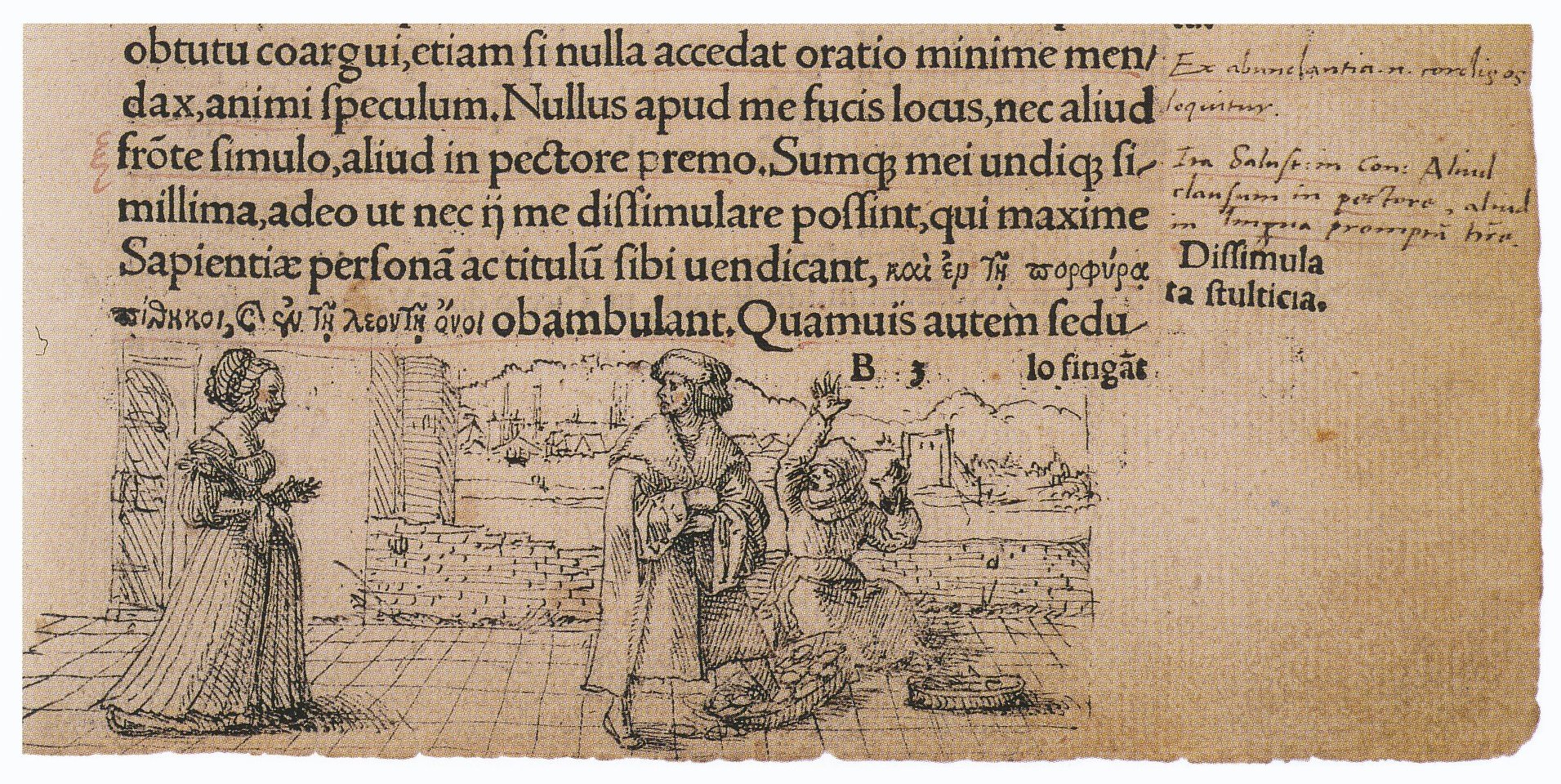 A Scholar Treads on a Market Woman's Basket of Eggs, marginal drawing by Hans Holbein the Younger in The Praise of Folly: Erasmus is foolishly distracted by a woman. The Praise of Folly (1511) Main article: The Praise of Folly Erasmus's best-known work is The Praise of Folly, written in 1509, published in 1511 under the double title Moriae encomium (Greek, Latinised) and Laus stultitiae (Latin). It is inspired by De triumpho stultitiae written by Italian humanist Faustino Perisauli.[233] A satirical attack on superstitions and other traditions of European society in general and in the Western Church in particular, it was dedicated to Sir Thomas More, whose name the title puns.[234][235] de Copia (1512) De Copia (or Foundations of the Abundant Style or On Copiousness) is a textbook designed to teach aspects of classical rhetoric: having a large supply of words, phrases and grammatical forms is a gateway to formulating and expressing thoughts, especially for "forensic oratory", with mastery and freshness. Perhaps as a joke, its full title is "The twofold copia of words and arguments in a double commentary" (Latin: De duplici copia verborum ac rerum commentarii duo).[236]: 118, 119 It was "the most often printed rhetoric textbook written in the renaissance, with 168 editions between 1512 and 1580."[237] The first part of the book is about verborum (words). It famously includes 147 variations on "Your letter pleased me very much",[238] and 203 variations on "Always, as long as I live, I shall remember you."[note 120][236]: 119 The second part of the book is about rerum (arguments) to learn critical thinking and advocacy. Erasmus advised students to practice the rhetorical techniques of copiousness by writing letters to each other arguing both side of an issue (Latin: in utramque parte). Opuscula plutarchi (1514), and Apophthegmatum opus (1531) 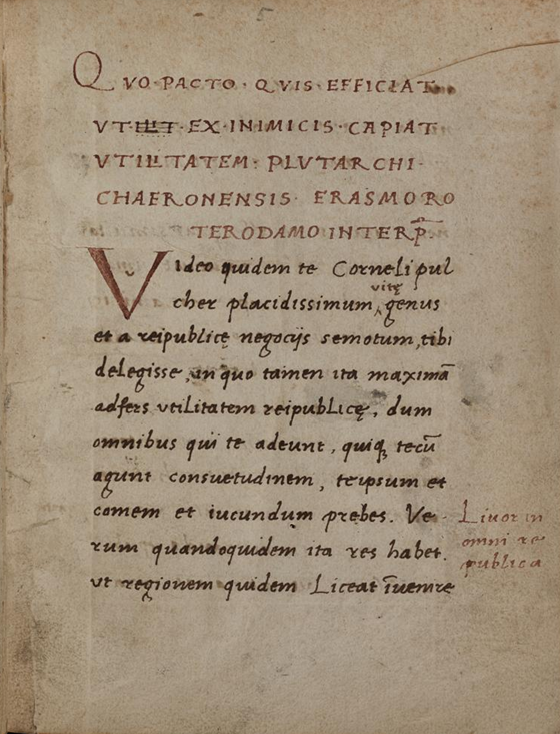 Handwriting of Erasmus of Rotterdam: Plutarch's How to profit from one's enemies In a similar vein to the Adages was his translation of Plutarch's Moralia: parts were published from 1512 onwards and collected as the Opuscula plutarchi[239] (c1514). This was the basis of 1531's Apophthegmatum opus (Apophthegms), which ultimately contained over 3,000 aphophthegms: "certainly the fullest and most influential Renaissance collection of Cynic sayings and anecdotes",[192] particular of Diogenes (from Diogenes Laertius.) One of these was published independently, as How to tell a Flatterer from a Friend, dedicated to England's Henry VIII. Julius exclusus e coelis (1514) attrib. Main article: Julius Excluded from Heaven Julius excluded from Heaven is a biting satire usually attributed to Erasmus[240] perhaps for private circulation, though he publicly denied writing it, calling its author a fool. The recently deceased Pope Julius arrives at the gates of heaven in his armour with his dead army, demanding from St Peter to be let in based on his glory and exploits. St Peter turns him away. Sileni Alcibiadis (1515) 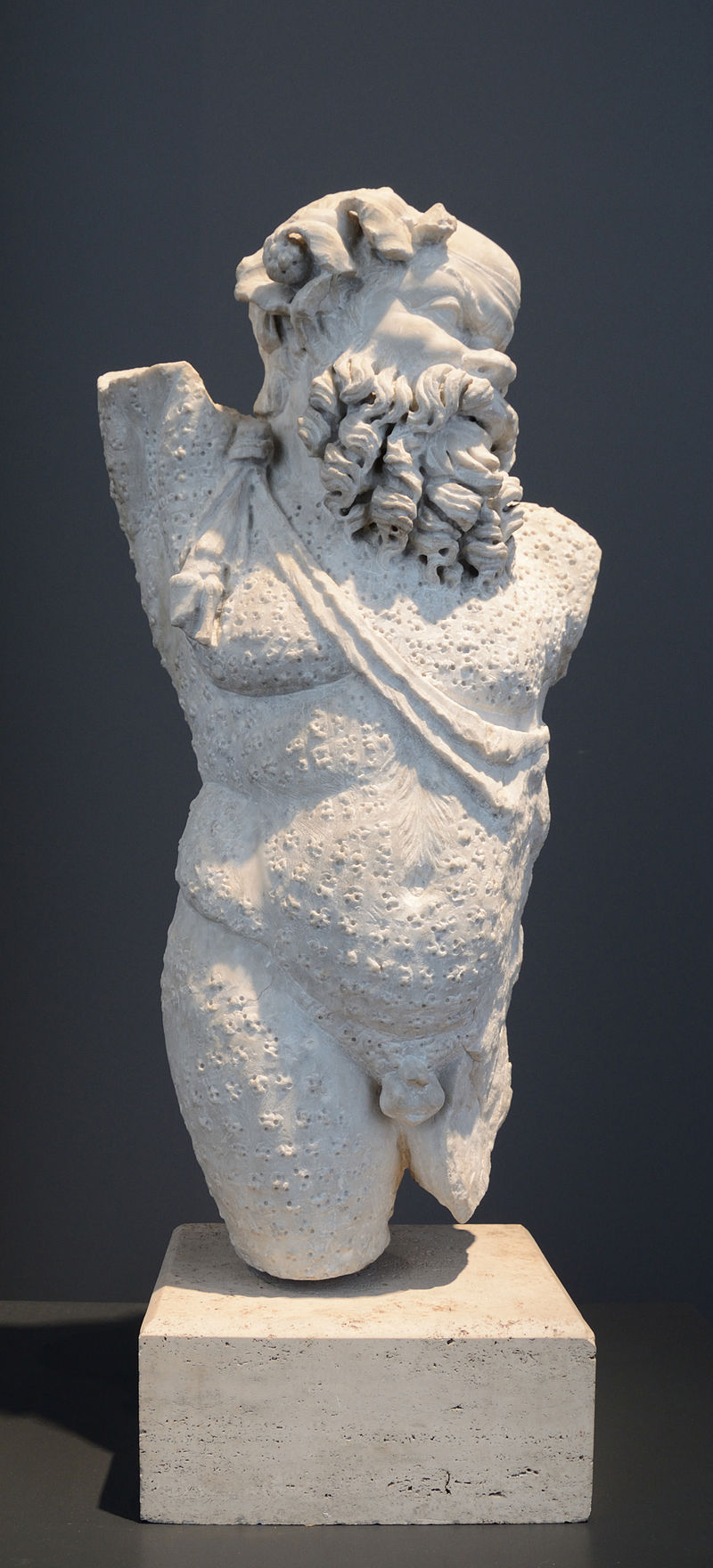 Statue of Silenus in Palazzo Massimo alle Terme 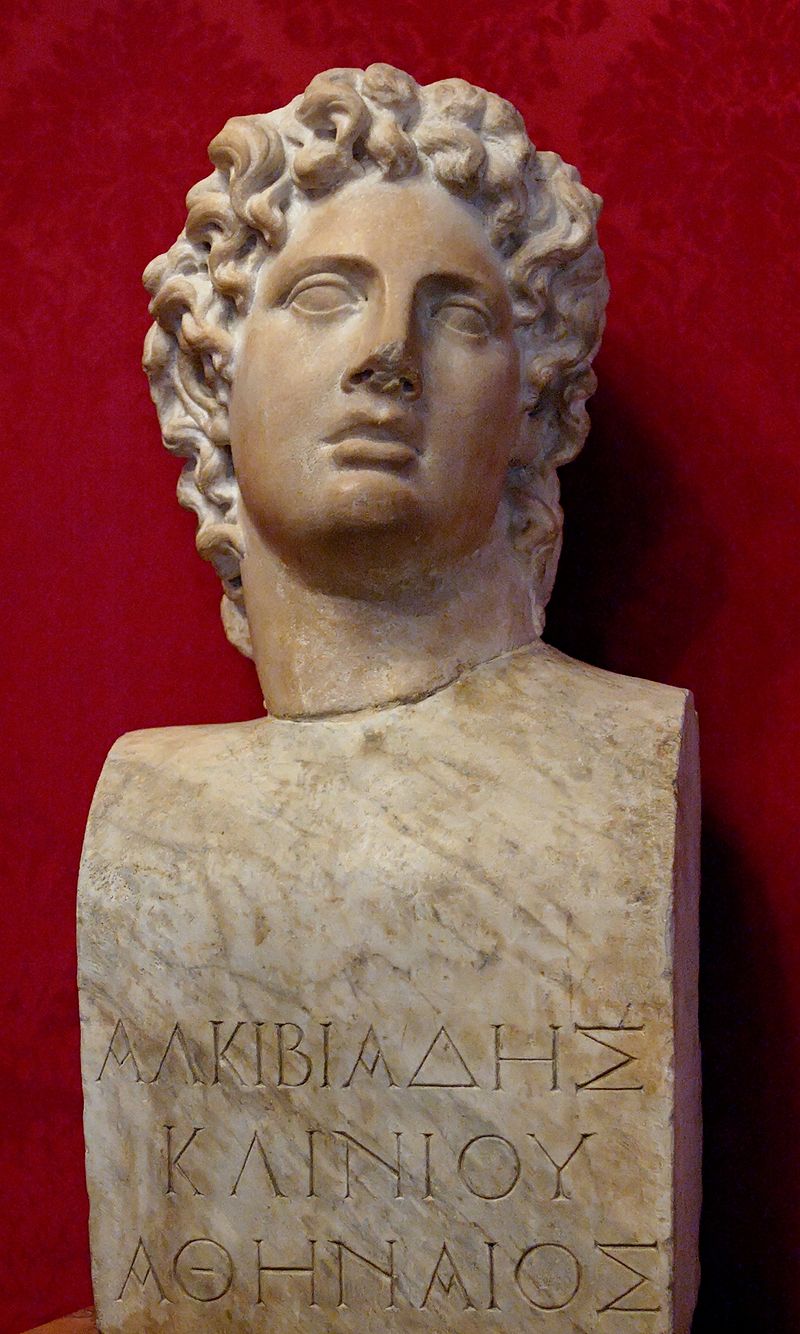 Hern of Alcibiades, Musei Capitolini Erasmus's Sileni Alcibiadis is one of his most direct assessments of the need for Church reform.[241]: 105 It started as a small entry in the 1508 Adagia citing Plato's Symposium and expanded to several hundred sentences.[206] Johann Froben published it first within a revised edition of the Adagia in 1515, then as a stand-alone work in 1517. Sileni is the plural (Latin) form of Silenus, a creature often related to the Roman wine god Bacchus and represented in pictorial art as inebriated, merry revellers, variously mounted on donkeys, singing, dancing, playing flutes, etc. In particular, the Sileni that Erasmus referred to were small, coarse, ugly or distasteful carved figures which opened up to reveal a beautiful deity or valuables inside.[242] Alcibiades was a Greek politician in the 5th century BCE and a general in the Peloponnesian War; he figures here more as a character written into some of Plato's dialogues – an externally-attractive, young, debauched playboy whom Socrates tries to convince to seek truth instead of pleasure, wisdom instead of pomp and splendor.[243] The term Sileni – especially when juxtaposed with the character of Alcibiades – can therefore be understood as an evocation of the notion that something on the inside is more expressive of a person's character than what one sees on the outside. For instance, something or someone ugly on the outside can be beautiful on the inside, which is one of the main points of Plato's dialogues featuring Alcibiades and in the Symposium, in which Alcibiades also appears.[note 121] On the other hand, Erasmus lists several Sileni and then controversially questions whether Christ is the most noticeable Silenus of them all. The Apostles were Sileni since they were ridiculed by others. The scriptures are a Silenus too.[241]: 105 The work then launches into a biting endorsement of the need for high church officials (especially the Pope) to follow the evangelical counsel of poverty (simplicity): this condemnation of wealth and power was a full two years before the notional start of the Reformation; the church must be able to act as a moderating influence on the ambition and selfishness of princes.[note 122] The Education of a Christian Prince (1516) 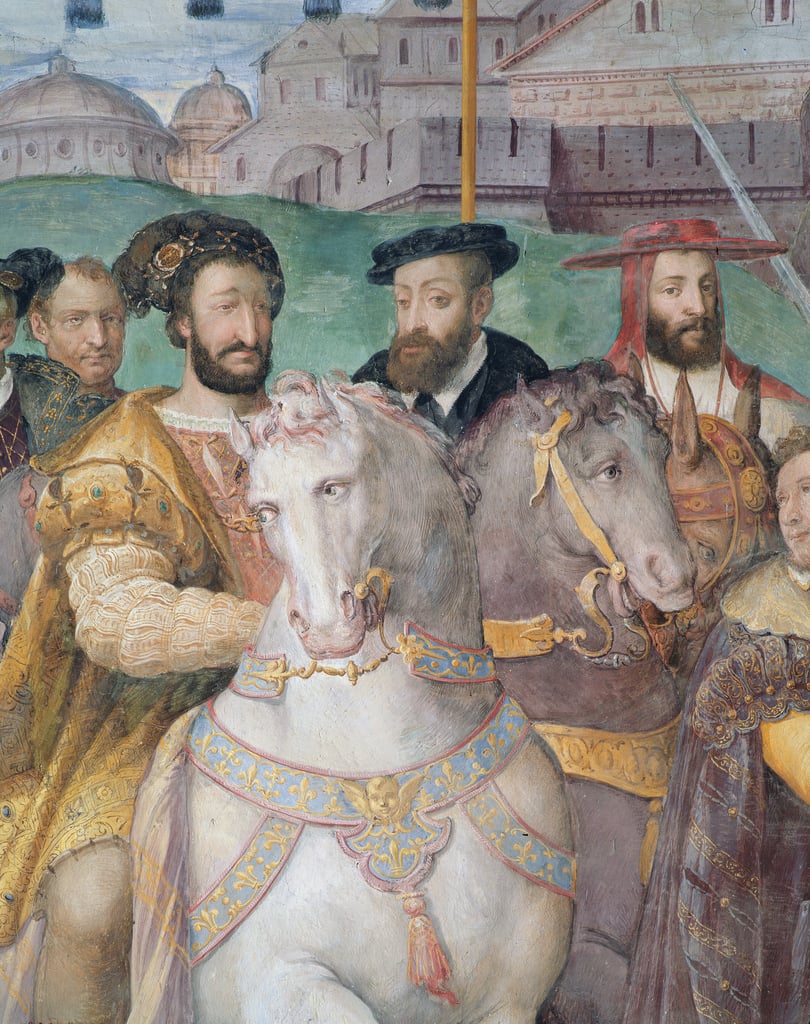 Entry of Francis of France, Emperor Charles V, and Cardinal Farnese (later Pope Paul III) into Paris - 1540 (detail) Main article: Education of a Christian Prince The Institutio principis Christiani or "Education of a Christian Prince" (Basel, 1516) was written as advice to the young king Charles of Spain (later Charles V, Holy Roman Emperor), to whom the Preface is addressed.[244] Erasmus applies the general principles of honor and sincerity to the special functions of the Prince, whom he represents throughout as the servant of the people. Latin and Greek New Testaments 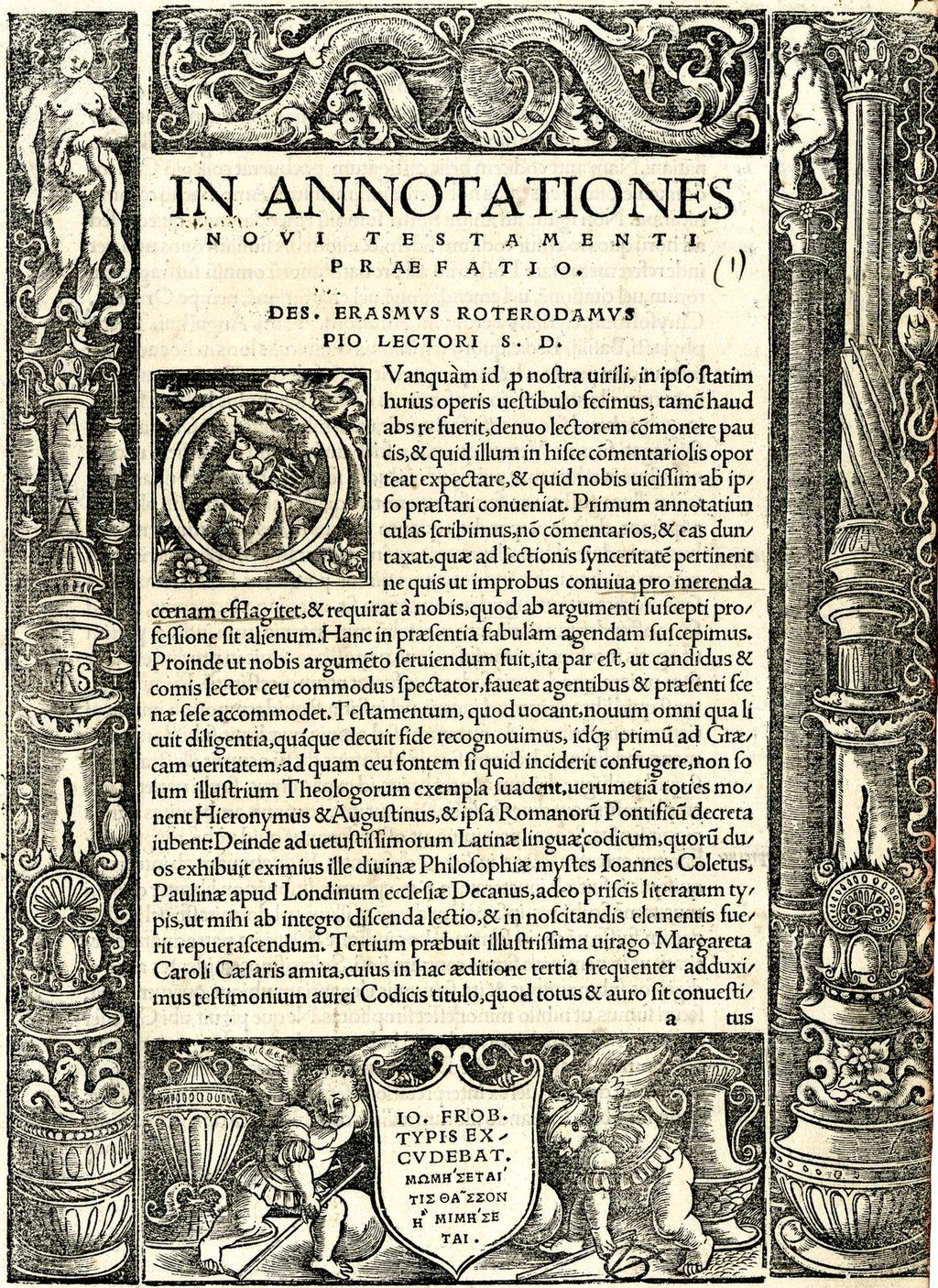 First page of Preface, Annotations of the New Testament (1521), with characteristic Froben decoration Main article: Novum Instrumentum omne Erasmus produced this first edition of his corrected Latin and Greek New Testament in 1516, in Basel at the print of Johann Froben, and took it through multiple revisions and editions.[245][246] For Erasmus, knowledge of the original language was not enough: theologian Gregory Graybill notes "the faithful exegete had to master not only the original tongues, but also the crucial disciplines of grammar and rhetoric."[note 123] Consequently, an integral and motivating part of the work was the substantial philological annotations. Erasmus independently brought out Paraphrases of the books of the New Testament, suited for a less academic readership. Erasmus had, for his time, relatively little interest in the Old Testament, apart from the Psalms.[note 66] Similarly, he was relatively uninterested in the Book of Revelation, which he did not produce a paraphrase for, and he provocatively reported the doubts in the early Greek church about its status in the canon:[249] Erasmus had none of the apocalypticism of his times which so animated Savonarolan and Protestant rhetoric:[250] only one percent of his Annotations on the New Testament concerned the Book of Revelation.[251] New Latin translation 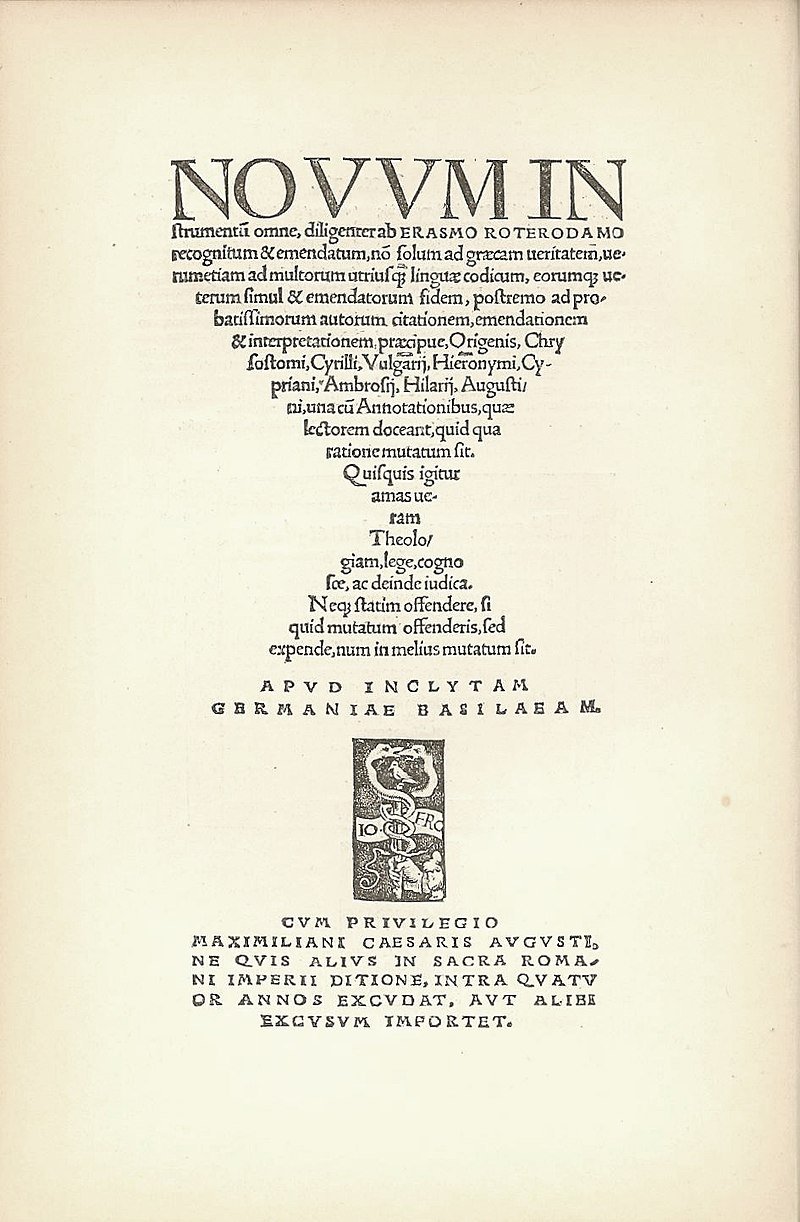 Title page of Erasmus' Novum instrumentum omne Erasmus had been working for years on two related projects to help theologians: philological notes on the Latin and Greek texts[note 124] and a fresh Latin New Testament. He examined all the Latin versions he could find to create a critical text. Then he polished the language. He declared, "It is only fair that Paul should address the Romans in somewhat better Latin."[253] In the earlier phases of the project, he never mentioned a Greek text. While his intentions for publishing a fresh Latin translation are clear,[note 125] it is less clear why he included the Greek text. Though some speculate that he long intended to produce a critical Greek text or that he wanted to beat the Complutensian Polyglot into print, there is no evidence to support this. He wrote, "There remains the New Testament translated by me, with the Greek facing, and notes on it by me."[254] He further demonstrated the reason for the inclusion of the Greek text when defending his work: But one thing the facts cry out, and it can be clear, as they say, even to a blind man, that often through the translator's clumsiness or inattention the Greek has been wrongly rendered; often the true and genuine reading has been corrupted by ignorant scribes, which we see happen every day, or altered by scribes who are half-taught and half-asleep. — Epistle 337[255] So he included the Greek text to permit qualified readers to verify the quality of his Latin version.[256] But by first calling the final product Novum Instrumentum omne ("All of the New Teaching") and later Novum Testamentum omne ("All of the New Testament") he also indicated clearly that he considered a text in which the Greek and the Latin versions were consistently comparable to be the essential core of the church's New Testament tradition. Publication and editions  Portrait of Johannes Froben by Holbein[257] 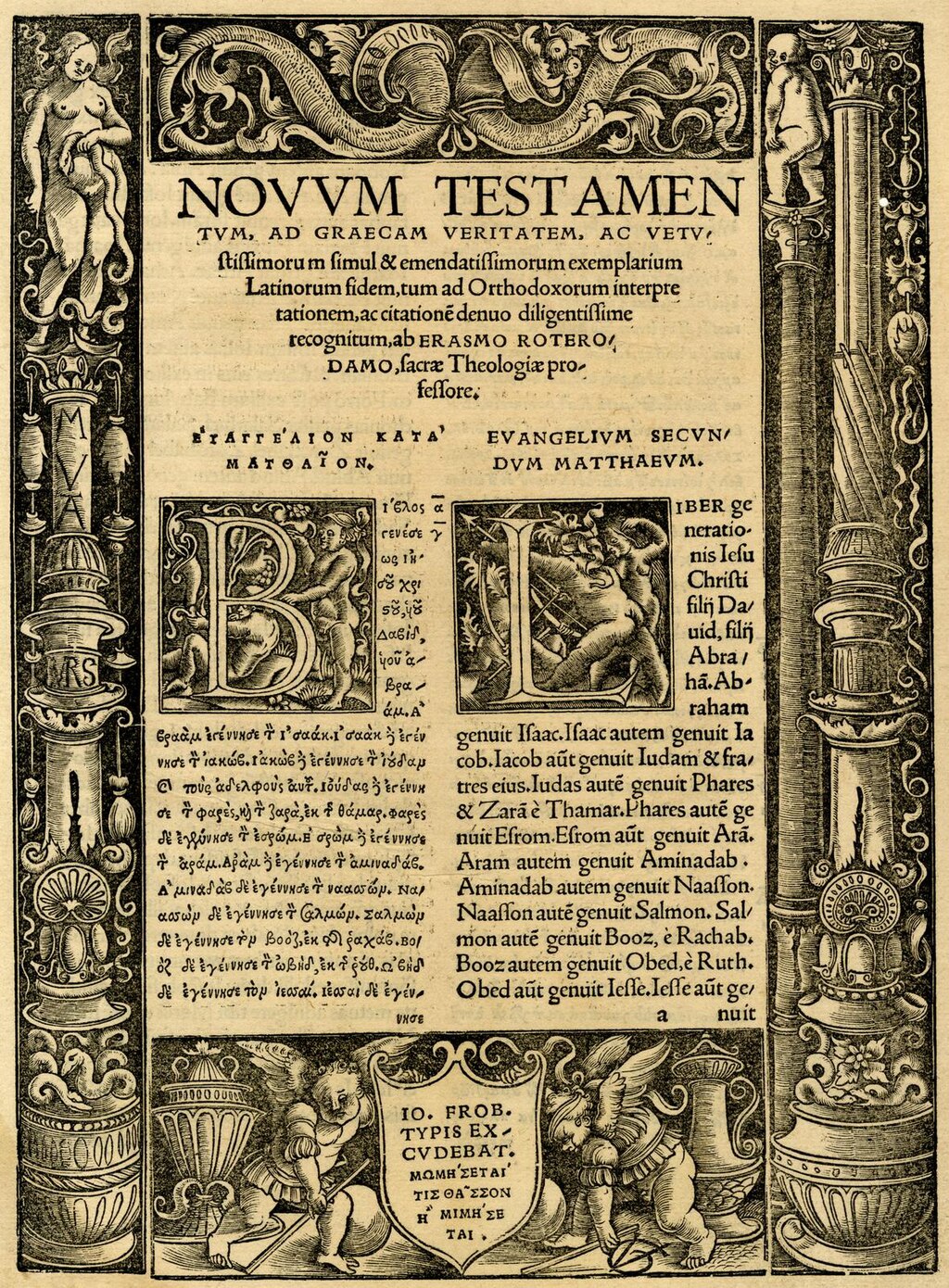 First page of Gospel according to Matthew, Froben (1521) Erasmus said the printing[258]: 105 of the first edition was "precipitated rather than published",[259] resulting in a number of transcription errors. After comparing what writings he could find, Erasmus wrote corrections between the lines of the manuscripts he was using (among which was Minuscule 2) and sent them as proofs to Froben.[260] His access to Greek manuscripts was limited compared to modern scholars and he had to rely on Jerome's late-4th century Vulgate to fill in the blanks.[261] His effort was hurriedly published by his friend Johann Froben of Basel in 1516 and thence became the first published Greek New Testament, the Novum Instrumentum omne, diligenter ab Erasmo Rot. Recognitum et Emendatum. Erasmus used several Greek manuscript sources because he did not have access to a single complete manuscript. Most of the manuscripts were, however, late Greek manuscripts of the Byzantine textual family and Erasmus used the oldest manuscript the least because "he was afraid of its supposedly erratic text."[262] He also ignored some manuscripts that were at his disposal which are now deemed older and better.[263] In the second (1519) edition, the more familiar term Testamentum was used instead of Instrumentum. Together, the first and second editions sold 3,300 copies.[264] By comparison, only 600 copies of the Complutensian Polyglot were ever printed. This edition was used by Martin Luther in his German translation of the Bible, written for people who could not understand Latin. The first and second edition texts did not include the passage (1 John 5:7–8) that has become known as the Comma Johanneum.[265] Erasmus had been unable to find those verses in any Greek manuscript, but one was supplied to him during production of the third edition. [note 126] The third edition of 1522 was probably used by William Tyndale for the first English New Testament (Worms, 1526) and was the basis for the 1550 Robert Stephanus edition used by the translators of the Geneva Bible and King James Version of the English Bible. Erasmus published a fourth edition in 1527 containing parallel columns of Greek, Latin Vulgate and Erasmus's Latin texts. In this edition Erasmus also supplied the Greek text of the last six verses of Revelation (which he had translated from Latin back into Greek in his first edition) from Cardinal Ximenez de Cisneros's Biblia Complutensis.[note 127] In 1535 Erasmus published the fifth (and final) edition which dropped the Latin Vulgate column but was otherwise similar to the fourth edition. Later versions of the Greek New Testament by others, but based on Erasmus's Greek New Testament, became known as the Textus Receptus.[267] Erasmus dedicated his work to Pope Leo X as a patron of learning and regarded this work as his chief service to the cause of Christianity. Immediately afterwards, he began the publication of his Paraphrases of the New Testament, a popular presentation of the contents of the several books. These, like all of his writings, were published in Latin but were quickly translated into other languages with his encouragement. The Complaint of Peace (1517)  Erasmus by Holbein See also: Erasmus § Pacifism Lady Peace complains about warmongering. This book was written at the request of the Burgundian Chancellor, who was then seeking a peace deal with France, to influence the zeitgeist.[128] On the use of battle standards featuring crosses:[note 128] That cross is the standard of him who conquered, not by fighting, but by dying; who came, not to destroy men's lives, but to save them. It is a standard, the very sight of which might teach you what sort of enemies you have to war against, if you are a christian, and how you may be sure to gain the victory. I see you, while the standard of salvation is in one hand, rushing on with a sword in the other, to the murder of your brother; and, under the banner of the cross, destroying the life of one who to the cross owes his salvation. — The Complaint of Peace[129] The final paragraph of The Complaint of Peace finishes with the command resipiscite, meaning a voluntary return from madness and unconsciousness: At last! Enough and more than enough blood has been spilled, human blood, and if that were little, even Christian blood. Enough has been squandered in mutual destruction, enough already sacrificed to Orcus and the Furies and to nourish the eyes of the Turks. The comedy is at an end. Finally, after tolerating far too long the miseries of war, repent![268] However, the subsequent European wars of religion which accompanied the Reformation resulted in the deaths of between 7 and 18 million Europeans, including up to one third of the population of Germany.  Paraphrases of the New Testament (1517-1524, 1532, 1534) 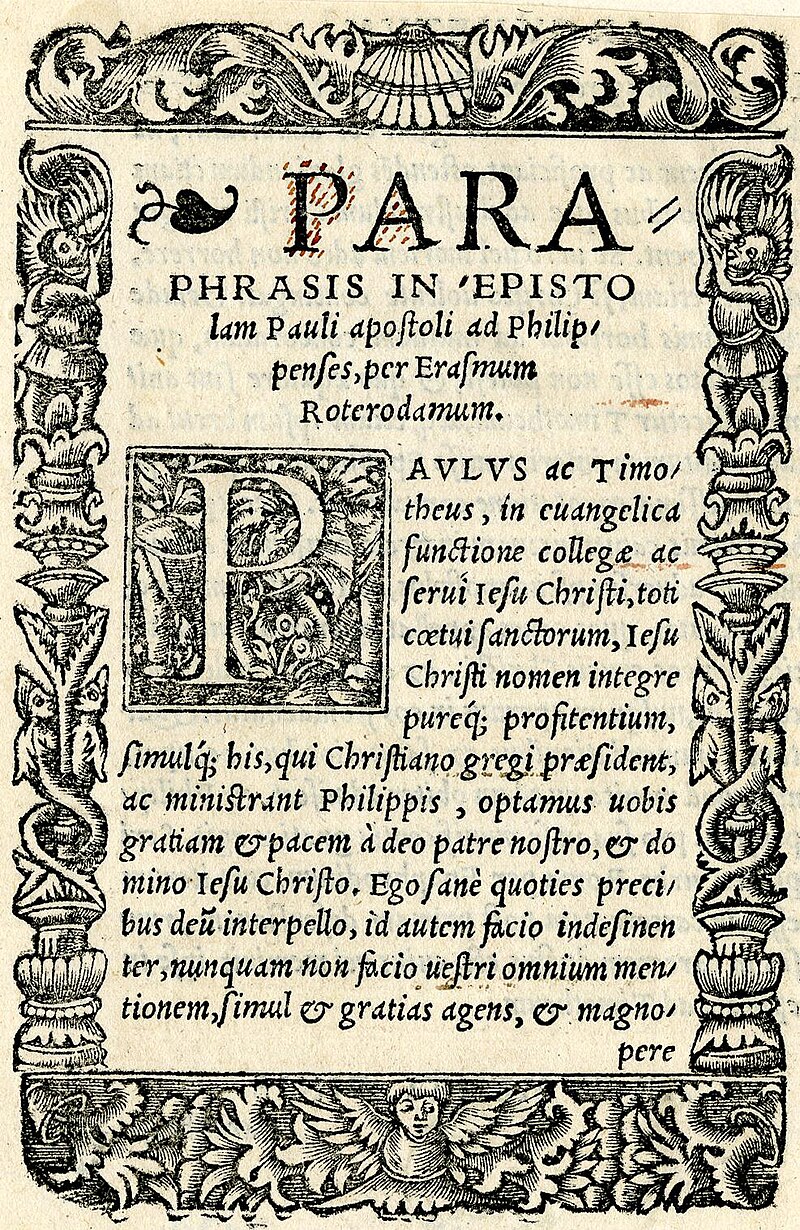 Title page of Paraphrase of Pauline Epistles(1520) Abraham and Isaac lower right, the goat lower left, God the Father top left, the printer's mark top right Paraphrase (1520s), with initial capital woodcut by Hans Holbein Erasmus described his editorial intent with the Paraphrases of the New Testament as philological rather than theological: "to fill in the gaps, to soften the abrupt ones, to digest the confused ones, to develop the developed ones, to explain the knotty ones, to add light to the dark ones, to give (Paul's) Hebraicisms a Roman polish ... and thus to moderate παραφρασιννε παραφρόνησις: that is, 'to say otherwise so as not to say otherwise.'"[note 129] He brought out the Paraphrases progressively: Romans (1517), Corinthians (1519), the rest of the Epistles throughout 1520 and 1521, and the four Gospels and Acts from 1522 to 1524. He did not put out a paraphrase of the Book of Revelation.[201] According to Erasmus: "A paraphrase is not a translation but something looser, a kind of commentary in which the writer and his author retain separate roles."[269]: 557 The Paraphrases allowed Erasmus to amplify the text of the New Testament by integrating philological and theological points from his scholarly Annotations, allowing more of a role for his personal opinions or angles, but in a less scholarly format. Unusually, Erasmus gives paraphrases of the speech of Christ in the persona of Christ in the Gospels, and for each Epistle uses the voice of the Apostle, not Erasmus or a neutral third person as is conventional.[270] Unlike traditional medieval exegesis, which for some authors treated the whole the scriptures as a single unified document of propositions which, because they had the same divine author, could be mixed and matched as necessary, Erasmus treated each individual book as the literary unit that limited intertextual combination.[270]: 24–38 Erasmus wrote his paraphrases of the Gospels at the same time as his study of Luther's work in preparation for 1524's On Free Will, On the Immense Mercy of God, etc. Some scholars see an increased explicit promotion of faith and grace in these paraphrases, with Erasmus attempting to accommodate some of Luther's exegesis, and Protestant thematic requirements, though not their theology.[169] The Paraphrases were very well-received, particularly in England, by most[271] parties. Biographer Roland Bainton nominated this passage as "the essence of Erasmus"[138] (its positivity to natural affection has none of the Lutheran total depravity doctrine, and it accords with the Catholic analogia entis pattern): "Now in the natural love of this father for his son behold the goodness of God, who is far more clement to sinful man, if only he repents and despises himself, than any father to his son, however tenderly he may love him." — Erasmus, Paraphrase of St Matthew Method of True Theology The Ratio seu methodus compendio perveniendi ad veram theologia was originally the Preface to the first edition of his New Testament, but was expanded and had a life of its own. "The Ratio sets out a whole programme of theological thought, and an ideal of spirituality. If there is a Reformism proper to Erasmus—previously sketched in the Enchiridion, later defined in the polemic against Luther in the Hyperaspites, and vulgarized in the Ecclesiastes—then assuredly we must look to the Ratio for its fundamental exposition." — Louis Bouyer[123] Following Origen, Erasmus in effect resuscitates lectio divina as the core activity of real theology.[note 130] Following Tertullian, Erasmus stresses that adoration and reverence were the proper attitudes of a Christian (and therefore any Christian theology) toward God and the sacred mysteries and that all impia curiositas must be eschewed[273]: 44 especially in favour of educated and humble contemplation of Christ's personality and human interactions in the Gospels. Spanish dogmatic theologian Melchor Cano characterized it along the nuanced line "Erasmus believed that for theological education nothing more should be determined than what is contained in the sacred books."[274] Familiar Colloquies (1518-1533) Main article: Colloquies The Colloquia familiaria began as simple spoken Latin exercises for schoolboys to encourage fluency in colloquial Latin interaction, but expanded in number, ambition and audience. The sensational nature of many of the Colloquies made it a prime target for censorship.[275] Notable Colloquies include the exciting Naufragium (Shipwreck), the philosophical and path-forging The Epicurean, and the zany catalogue of fantastic animal stories Friendship. For example, A Religious Pilgrimage[162] deals with many serious subjects humorously, and scandalously includes a letter supposedly written by a Statue of the Virgin Mary, in which, while it first thanks a reformer for following Luther against needlessly invoking saints (where the listed invocations are all for sinful or wordly things), becomes a warning against iconoclasm[note 131] and stripping altars. Amicitia (Friendship) can be considered a sweet companion piece to the vinegary Spongia of the same year. A Sponge to wipe away the Spray of Hutten (1523) As a result of his reformatory activities, Erasmus found himself at odds with some reformers and some Catholic churchmen. His last years were made difficult by controversies with men toward whom he was sympathetic.[note 132] 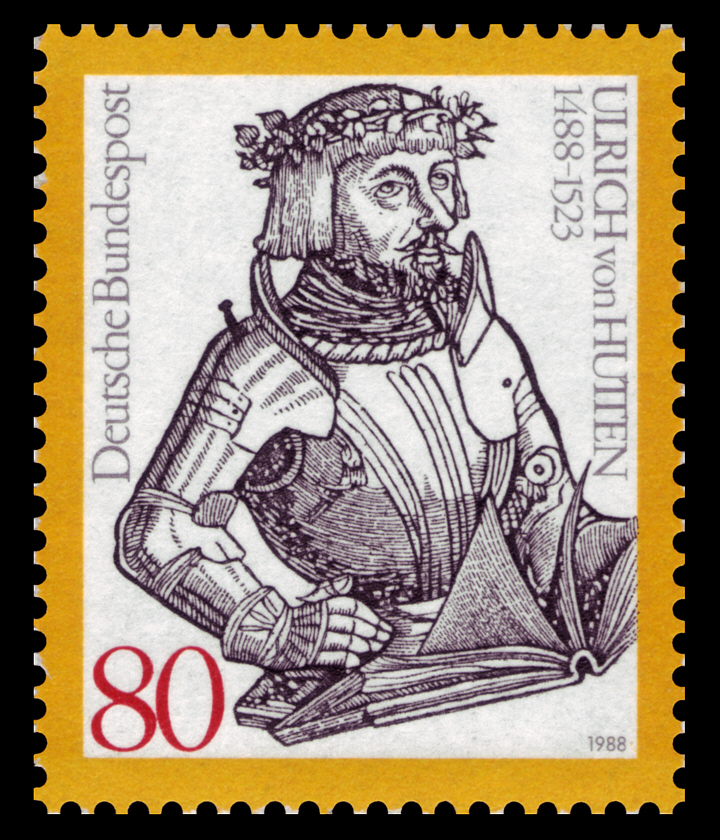 Ulrich von Hutten (1988) Notable among these was Ulrich von Hutten, once a friend, a brilliant but erratic genius who had thrown himself into the Lutheran cause (and militant German nationalism.[276]) Erasmus claimed that von Hutten, who had a long history of adventure, violence and manslaughter, and had proposed a literal war against the clergy, had extorted money from a Carthusian monastery, highway robbed three Abbots, and cut the ears off two Benedictines.[95] Von Hutten declared that Erasmus, if he had a spark of honesty, would throw himself into Luther's cause and help to subdue the Pope. Hutten published a book in 1523 Ulrichi ab Hutten cum Erasmo Rotirodamo, Presbytero, Theologo, Expostulatio. In his reply in the same year, Spongia adversus aspergines Hutteni, Erasmus accused von Hutten of having misinterpreted his utterances about reform and reiterates his determination never to break with the Catholic Church.[277] Erasmus returns multiple times to the issue that old friendships should be maintained (not betrayed) and that scholarly expertise should be acknowledged, but that neither of these should imply agreement or endorsement in total or in part with each other's views. Nor should the acknowledgement of a strained relationship or the absence of some polite title be construed as necessarily an avowal of an opposing view. Erasmus advocated being a moderating friend and a constructive voice of sanity, even to sincere but civil partisans of either side. Historian Francis Aidan Gasquet regarded this book as necessary for understanding Erasmus' true position on Rome, quoting: "I have never approved of (the Roman See's) tyranny, rapacity, and other vices about which of old common complaints were heard from good men. Neither do I sweepingly condemn ‘Indulgences,’ though I have always disliked any barefaced traffic in them. What I think about ceremonies, many places in my works plainly show.… What it may mean ‘to reduce the Pope to order’ I do not rightly understand. First, I think it must be allowed that Rome is a Church, for no number of evils can make it cease to be a Church, otherwise we should have no Churches whatever. Moreover, I hold it to be an orthodox Church; and this Church, it must be admitted, has a Bishop. Let him be allowed also to be Metropolitan, seeing there are very many archbishops in countries where there has been no apostle, and Rome, without controversy, had certainly SS. Peter and Paul, the two chief apostles. Then how is it absurd that among Metropolitans the chief place be granted to the Roman Pontiff?" — Erasmus, Spongia trans, Gasquet[30] Erasmus noted that he would not renounce old friends because they took sides for or against Luther, noting that several had changed their minds again.[30] The paradoxes of Luther are not worth dying for. “There is no question of articles of faith, but of such matters as ‘Whether the supremacy of the Roman Pontiff was established by Christ:’ ‘whether cardinals are necessary to the Christian Church:’ ‘whether confession is de jure divino:’ ‘whether bishops can make their laws binding under pain of mortal sin:’ ‘whether free will is necessary for salvation:’ ‘whether faith alone assures salvation,’ etc. If Christ gave him grace,” Erasmus hopes that “he would be a martyr for His truth, but he has no desire whatever to be one for Luther.” — Gasquet, The Eve of the Reformation quoting Erasmus, Spongia Erasmus' break with the endangering Lutheran poet-scholar-knight von Hutten was complete, even refusing (or making it too difficult) to see him when von Hutten, homeless and dying of syphilis, passed through Basel in 1523 and found refuge with humanists there.[note 133] On Free Will (1524) Main article: De libero arbitrio diatribe sive collatio Erasmus wrote On Free Will (De libero arbitrio) (1524) against Luther's view on free will: that everything happens by strict necessity.[note 134] Erasmus lays down both sides of the argument impartially. In this controversy Erasmus lets it be seen that, from the thrust of Scripture, he would like to claim more for free will than St. Paul and St. Augustine seem to allow according to Luther's interpretation.[279] For Erasmus the essential point is that humans have the freedom of choice,[280] when responding to prior grace (synergism). On the same day as publishing De libero arbitrio diatribe sive Erasmus also published Concio de immensa Dei misericordia (Sermon on the Immense Mercy of God) which presented his positive alternative to Lutheranism: where Grace serves Mercy.[281][note 135] In response, Luther wrote his De servo arbitrio (On the Bondage of the Will) (1525), which attacked "On Free Will" and Erasmus himself, going so far as to claim that Erasmus was not a Christian. "Free will does not exist", according to Luther in that sin makes human beings completely incapable of bringing themselves to God (monergism). Erasmus responded with a lengthy, two-part book Hyperaspistes (1526–27).[note 136] Liturgy of the Virgin Mother venerated at Loreto (1525) 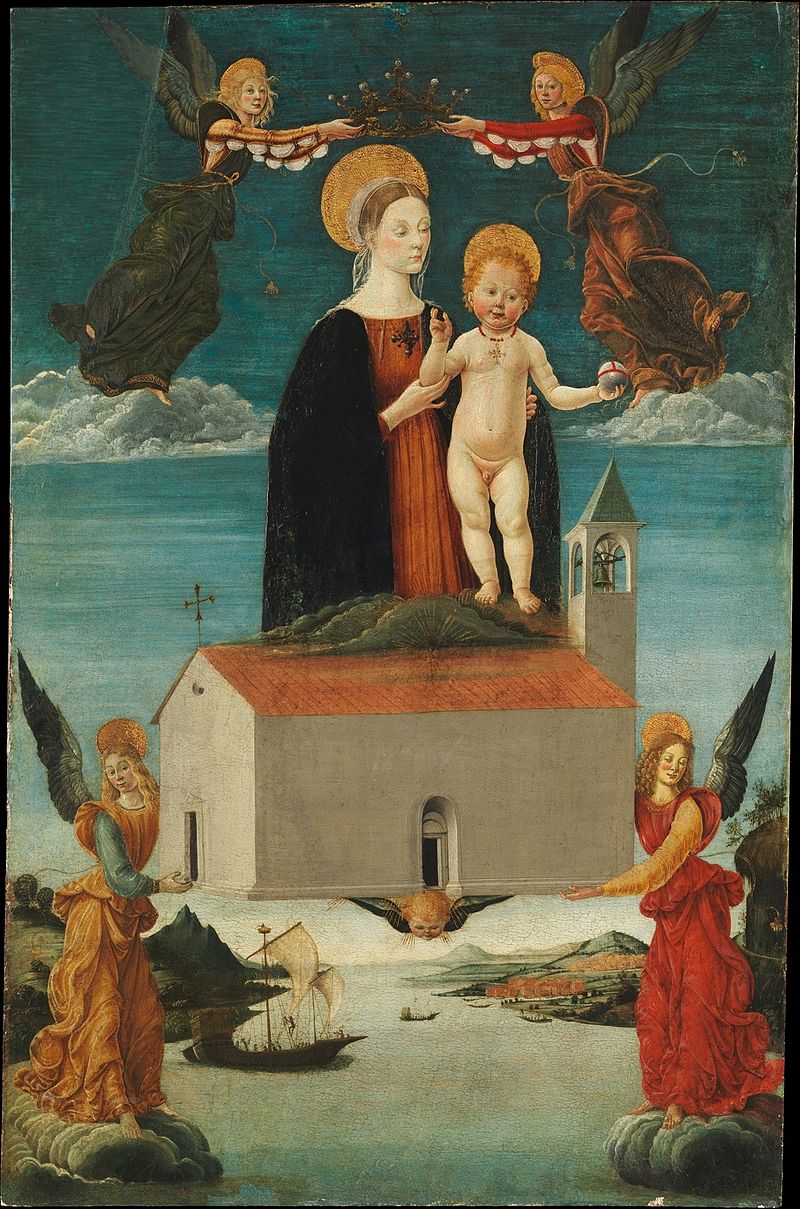 The Translation of the Holy House of Loreto, anonymous, Italian (1510) Editions: 1523, 1525, 1529[281] This liturgy for a Catholic Mass, with sequences and a homily teaching that for Mary, and the Saints, imitation should be the chief part of veneration.[285] Fair choir of angels, take up the zither, take up the lyre. The Virgin Mother must be celebrated in song, in a virginal ode. The angels, joining in the song, will re-echo your voice. For they love virgins, being virgins themselves.[286] The liturgy re-framed the existing Marian devotions: as a substitute for mentioning the Holy House of Loreto,[287] he used the meaning of Loreto as 'laurel', as in the champion's laurel wreath. The work also may have been intended to demonstrate the proper application of indulgences, as it came with one from the archbishop of Besançon.[286] The Tongue (or Language) (1525) The writings of Erasmus exhibit a continuing concern with language, and in 1525 he devoted an entire treatise to the subject, Lingua. This and several of his other works are said to have provided a starting point for a philosophy of language, though Erasmus did not produce a completely elaborated system.[288] It includes a "systematic denunciation of all forms of seditious expression."[172] On the Institution of Christian Marriage (1526) The Institutio matrimonii was published in 1526 as treatise about marriage,[289] and dedicated to Catherine of Aragon, who had befriended Erasmus and More. He did not follow the contemporary mainstream which saw the woman as a subject to the man, but suggested the man was to love the woman similar as he would Christ, who also descended to earth to serve.[289] He saw the role of the woman as a socia (partner) to the man.[289] The relationship should be of amicitia[note 137] (sweet and mutual fondness).[290] Erasmus suggested that true marriage between devout Christians required a true friendship (contrary to contemporary legal theories that required community consensus or consummation); and because true friendship never dies, divorce of a true marriage was impossible; the seeking of a divorce was a sign that the true friendship (and so the true marriage) never existed and so the divorce should be allowed, after investigation and protecting the individuals.[note 138][291] In his Colloquia Erasmus raised issues such as being practical in courtship ("On Courtship"), (arranged) marriages between the very young and the very old, and (forced) marriage to a partner with syphilis ("The Unequal Marriage".) As far as sex in marriage is concerned, Erasmus' gentle, gradualist asceticism promoted that a mutually-agreed celibate marriage, if God had made this doable by the partners, could be the ideal: in theory it allowed more opportunity for spiritual pursuits. But he controversially noted Since everything else has been designed for a purpose, it hardly seems probable that in this one matter alone nature was asleep. I have no patience with those who say that sexual excitement is shameful and that venereal stimuli have their origin not in nature, but in sin.[292] The Ciceronians (1528) Main article: Ciceronianus The Ciceronianus came out in 1528, attacking Ciceronianism, the style of Latin that was based exclusively and fanatically on Cicero's writings. Étienne Dolet wrote a riposte titled Erasmianus in 1535.[293] Erasmus' own Latin style[294] was late classical (i.e., from Terence to Jerome) as far as syntax and grammar, but freely used medievalisms in its vocabulary.[295]: 164, 164 Explanation of the Apostles' Creed (1530) In his catechism (entitled Explanation of the Apostles' Creed) (1530), Erasmus took a stand against Luther's recent Catechisms by asserting the unwritten Sacred Tradition as just as valid a source of revelation as the Bible, by enumerating the Deuterocanonical books in the canon of the Bible[note 139] and by acknowledging seven sacraments.[297] He identified anyone who questioned the perpetual virginity of Mary as blasphemous.[298] However, he supported lay access to the Bible.[298] In a letter to Nikolaus von Amsdorf, Luther objected to Erasmus's catechism and called Erasmus a "viper", "liar", and "the very mouth and organ of Satan".[299] The Preacher (1536) Main article: Ecclesiastes of Erasmus Erasmus had preached, but considered it a better use of his time to write books.[300]: 93 Erasmus's last major work, published the year of his death, is the Ecclesiastes or "Gospel Preacher" (Basel, 1536), a massive manual for preachers of around a thousand pages. Though somewhat unwieldy because Erasmus was unable to edit it properly in his old age, it is in some ways the culmination of all of Erasmus's literary and theological learning and indeed, according to some scholars, the culmination of the previous millennium of preaching manuals since Augustine. It offered prospective preachers advice on important aspects of their vocation with abundant reference to classical and biblical sources.[301] It is also notable for calling for a mission program to outside Christendom to usefully occupy friars, castigating that commercial exploitation was prioritized over the Gospel. It called out the practice of taking criminal religious convicts and transferring them to the New World as missionaries.[103] Patristic Editions See also: § Patristic and classical editions According to Ernest Barker, "Besides his work on the New Testament, Erasmus laboured also, and even more arduously, on the early Fathers. Among the Latin Fathers he edited the works of St Jerome, St Hilary, and St Augustine;[302] among the Greeks he worked on Irenaeus, Origen and Chrysostom."[303] Alleged forgery Further information: Pseudo-Cyprian In 1530, Erasmus, in his fourth edition of the works of Cyprian, introduced a treatise De duplici martyrio ad Fortunatum, which he attributed to Cyprian and presented as having been found by chance in an old library. This text, close to the works of Erasmus, both in content (hostility to the confusion between virtue and suffering) and in form, and of which no manuscript is known, contains at least one flagrant anachronism: an allusion to the persecution of Diocletian, persecution that took place long after the death of Cyprian. In 1544, the Dominican Henricus Gravius [de] denounced the work as inauthentic and attributed its authorship to Erasmus or an imitator of Erasmus. In the twentieth century, the hypothesis of a fraud by Erasmus was rejected a priori by most of the great Erasmians, for example Percy Stafford Allen,[citation needed] but it is adopted by academics like Anthony Grafton.[304][305][306] |
著名な著作 エラスムスは教養のある聴衆のために、キリスト教的な題材と一般的な人間的関心事の両方について執筆した[注釈 118][224] 若い頃からエラスムスは貪欲な作家であった。1530年代までに、エラスムスの著作はヨーロッパにおける全書籍売上の10パーセントから20パーセントを 占めていた[225]。 彼は通常、愚痴、戯言、対話、賛辞、書簡、注釈、典礼、説教など、さまざまな修辞的慣習を持つ特定の古典文学ジャンルで本を書いた。ウルリッヒ・フォン・ ハッテンに宛てたトマス・モアの家庭に関する書簡は、「近代的な意味での最初の本格的な伝記」と呼ばれている[227]。 彼の執筆方法(『De copia』および『De ratio studii』において推奨されている)[228]は、読んでいるものをテーマごとに分類してメモを取ることであった。新しい本を組み立てるとき、彼はト ピックを調べ、使うたびにありふれたメモを消していった。この研究ノートのカタログのおかげで、彼は同じトピックから編まれた本でありながら、迅速に本を 作ることができたのである。晩年、手先が不自由になると、秘書やアマヌエンスを雇い、組み立てや書き写しをさせ、自分の書いたものを書き直し、晩年の10 年間は口述筆記を記録した。 アダージア (1500-1520)  Adagiaにある "honificabilitudinitatibus "についての記述。 主な記事 アダージア 以下も参照: パレミオグラフィ パブリオ・ファウスト・アンドレリーニ(Publio Fausto Andrelini)の協力を得て、ラテン語のことわざや格言集を作成した。その中には、"盲人の国では、片目の男が王である "という格言も含まれている。彼はヘシオドスの『パンドラ』の翻訳で、ピトス(貯蔵瓶)とピクシス(箱)を混同してしまったことから、「パンドラの箱」と いう格言を作った[229]。 アダージュの例としては、「急がば回れ」、「鷲を狩る糞虫」などがある。 その後、エラスムスはヴェネツィアのアルディン出版社で9ヶ月を費やして『アダージア』を3,000項目以上に増補し[230]、バーゼルのフローベン出 版社では27版を重ねて4,000項目以上に増補した。この本は「かなり幅広い読者に古代人の実際の言葉や考えを紹介した」[231]: 81。 英語版はリチャード・タヴァナーによって選ばれ、翻訳された。 キリスト教兵士の手引書 (1501) 主な記事 キリスト教兵法書 より本格的な著作は、早くからEnchiridion militis Christiani「キリスト教兵士の手引書」(1501年、1518年に序文を増補して再発行され、1533年に若きウィリアム・ティンデールによっ て英訳された。) (この短い著作の中で、エラスムスは通常のキリスト教徒としての生き方について概説している。彼は「信仰においては福音主義的であり、実践においては敬虔 主義的である」[注 119][82] と評されている。  ハンス・ホルバイン(Hans Holbein the Younger)による『愚行礼讃(痴愚神礼讃)』の余白に描かれた「市場の女の卵籠を踏む学者」: エラスムスは愚かにも女性に気を取られている。 『愚行礼賛(痴愚神礼讃)』(1511年) 主な記事 愚行礼賛 エラスムスの最も有名な作品は、1509年に書かれ、1511年に『愚行礼讃』(ギリシャ語、ラテン語)と『愚行礼讃』(ラテン語)という二重のタイトル で出版されたものである。イタリアの人文主義者ファウスティーノ・ペリサウリが書いたDe triumpho stultitiaeに触発されて書かれた[233]。ヨーロッパ社会全般、特に西方教会の迷信やその他の伝統に対する風刺的な攻撃であり、タイトルがダ ジャレになっているサー・トマス・モアに献呈された[234][235]。 デ・コピア(1512) 『De Copia』(あるいは『豊かな文体の基礎』または『模倣について』)は、古典修辞学の一面を教えるために作られた教科書である。単語、言い回し、文法形 式を大量に持つことは、特に「法医学的弁論」のために、熟達した新鮮さをもって考えを練り、表現するための入り口である。おそらく冗談だろうが、その完全 なタイトルは「二重の注釈における言葉と議論の二重のコピア」(ラテン語:De duplici copia verborum ac rerum commentarii duo)である[236]: 118, 119 この本は「ルネサンス期に書かれた修辞学の教科書の中で最も多く印刷され、1512年から1580年の間に168版が出版された」[237]。 この本の最初の部分はverborum(言葉)に関するものである。有名なのは、「あなたの手紙は私をとても喜ばせました」の147のバリエーション [238]と、「いつも、生きている限り、私はあなたを忘れないでしょう」の203のバリエーション[注釈 120][236]: 119 本書の第2部は、批判的思考と擁護を学ぶためのrerum(議論)についてである。エラスムスは学生たちに、ある問題(ラテン語ではin utramque parte)の両論を主張し合う手紙を書くことで、コピペの修辞技法を練習するように勧めた。 Opuscula plutarchi (1514)、Apophthegmatum opus (1531)  ロッテルダムのエラスムスの筆跡: プルタークの『敵から利益を得る方法 Adages と同様の流れで、彼はプルタークの『モラリア』を翻訳し、その一部は1512年から出版され、Opuscula plutarchi[239] (c1514) として収集された。 これは1531年の『Apophthegmatum opus』(Apophthegms)の基礎となり、最終的に3,000以上の格言が収録された: 特にディオゲネス(『ディオゲネス・ラエルティウス』より)については、「ルネサンス期における最も充実した、最も影響力のあるキニク派の格言・逸話集」 [192]となった。 そのうちのひとつは、イングランドのヘンリー8世に捧げられた『友人と媚びへつらう者の見分け方』として単独で出版された。 Julius exclusus e coelis (1514) attrib. 主な記事 天国から追放されたユリウス 天国から排除されたユリウス』は、通常、エラスムス[240]の作とされる痛烈な風刺であるが、おそらく個人的に流通させるために書かれたものであろう。 最近亡くなった教皇ユリウスは、死んだ軍勢とともに鎧に身を包んで天国の門に到着し、自分の栄光と功績に基づいて入れてくれるよう聖ペテロに要求する。聖 ペテロは彼を追い返す。 シレニ・アルチビアディス(1515年)  マッシモ・アッレ・テルメ宮殿のシレヌス像  アルキビアデスのヘルン、カピトリーニ美術館 エラスムスの『シレニ・アルキビアディス』は、教会改革の必要性を最も直接的に評価した作品のひとつである[241]: 105 プラトンの『シンポジウム』を引用した1508年の『アダージア』の小さな項目から始まり、数百の文章に拡大された[206]。ヨハン・フローベンは、ま ず1515年に『アダージア』の改訂版として出版し、その後1517年に独立した著作として出版した。 シレニとはシレヌス(Silenus)の複数形(ラテン語)であり、ローマ神話の酒神バッカスにしばしば関連する生き物で、絵画芸術では、酩酊した陽気な 遊興者として、ロバに乗り、歌い、踊り、笛を吹くなど、さまざまな姿で表現されている。特に、エラスムスが言及したシレニとは、小さく、粗く、醜く、ある いは不快な彫刻が施された像のことであり、それを開くと中から美しい神や貴重品が現れるというものであった[242]。 アルキビアデスは紀元前5世紀のギリシアの政治家であり、ペロポネソス戦争の将軍であったが、ここではむしろプラトンの対話篇に書かれたキャラクターとし て登場する。 従って、シレーニという言葉は、特にアルキビアデスの性格と並置されるとき、外見で見えるものよりも内面にあるものの方がその人の性格を表しているという 概念を喚起するものとして理解することができる。たとえば、外見が醜いものが内面では美しいということは、アルキビアデスを主人公とするプラトンの対話篇 や、アルキビアデスも登場する『シンポジウム』の主要なポイントの一つである[注釈 121]。 他方、エラスムスは何人かのシレニを列挙した上で、キリストがその中で最も目立つシレニであるかどうかを論じている。使徒たちは他者から嘲笑されていたの でシレーニであった。聖典もシレヌスである[241]: 105 この作品はその後、教会の高官(特に教皇)が清貧(簡素)という福音主義的な助言に従う必要性を痛烈に支持するようになる。富と権力に対するこの非難は、 宗教改革が始まると想定される時期より丸2年前のことであり、教会は王侯の野心と利己主義を和らげる影響力として機能できなければならない[注釈 122]。 キリスト教王子の教育』(1516年)  フランスのフランシスコ、皇帝シャルル5世、ファルネーゼ枢機卿(後の教皇パウロ3世)のパリ入城 - 1540年(詳細) 主な記事 キリスト教王子の教育 Institutio principis Christiani(キリスト教王子の教育)』(バーゼル、1516年)は、若きスペイン王シャルル(後の神聖ローマ皇帝シャルル5世)への助言として 書かれた。 ラテン語とギリシア語の新約聖書  『新約聖書注解』序文の最初のページ(1521年)。 主な記事 新約聖書 エラスムスは、1516年にバーゼルでヨハン・フローベンの印刷所において、ラテン語とギリシア語の新約聖書を訂正したこの初版を作成し、何度も改訂と版 を重ねた[245][246]。 神学者のグレゴリー・グレイビルは、「忠実な釈義者は、原語の知識だけでなく、文法や修辞学といった重要な学問も習得しなければならなかった」と述べてい る[注釈 123] 。エラスムスは、よりアカデミックでない読者に適した『新約聖書の諸書の言い換え』(Paraphrases of the books of the New Testament)を独自に出版した。 エラスムスは当時としては、詩篇を除けば旧約聖書には比較的関心が薄かった。 [注66]同様に、彼はパラフレーズを作成しなかったヨハネの黙示録にも比較的関心がなく、彼はその正典における地位についての初期ギリシア教会における 疑念を挑発的に報告した[249]。エラスムスには、サヴォナローランやプロテスタントの修辞学を活気づかせた当時の黙示主義がまったくなかった [250]。 新ラテン語訳  エラスムスの『Novum instrumentum omne』タイトルページ エラスムスは神学者を助けるために、ラテン語とギリシア語の文献学的注釈[注釈 124]と新しいラテン語の新約聖書という2つの関連したプロジェクトに何年も取り組んでいた。ラテン語とギリシア語のテキストの文献学的注釈[注 124]と、新しいラテン語の新約聖書である。そして、言葉を磨き上げた。彼は、「パウロがローマ人への手紙を、多少なりともましなラテン語で書くのは当 然である」と宣言した[253]。 新鮮なラテン語訳を出版しようとした彼の意図は明らかであるが[注釈 125]、なぜギリシア語テキストを含めたのかはあまり明らかではない。以前からギリシア語の批評的テキストを作るつもりだったとか、コンプルテンシア ン・ポリグロットを活字にしたかったという推測もあるが、それを裏付ける証拠はない。彼はさらに、自分の著作を弁護する際に、ギリシア語本文を含める理由 を示した: しかし、ひとつだけ事実が叫んでいることがある。それは、盲人の目にも明らかなように、翻訳者の不器用さや不注意によって、しばしばギリシア語が誤って表 記されていることである。 - 書簡337[255]。 256]しかし、最終的な成果物を最初にNovum Instrumentum omne(「新教のすべて」)と呼び、後にNovum Testamentum omne(「新約聖書のすべて」)と呼ぶことによって、彼はまた、ギリシア語とラテン語版が一貫して同等であるテキストを教会の新約聖書の伝統の本質的な 中核であると考えていることを明確に示した。 出版と版  ホルバインによるヨハネス・フローベンの肖像[257]。  マタイによる福音書』の最初のページ、フローベン (1521) エラスムスは、初版の印刷[258]をこう評した: 105版の初版は「出版されたというより、むしろ急がされた」ものであり[259]、その結果、多く の転写ミスが生じた。エラスムスは、彼が使用した写本(その中にはミヌースキュール2も含まれていた)の行間に訂正を書き入れ、それを校正としてフローベ ンに送った[260]。彼のギリシア語写本へのアクセスは現代の学者に比べて限られており、空白を埋めるためにジェロームの4世紀末のヴルガータに頼らざ るを得なかった[261]。 彼の努力は、1516年にバーゼルの友人ヨハン・フローベンによって急遽出版され、そこから初めて出版されたギリシア語新約聖書『Novum Instrumentum omne, diligenter ab Erasmo Rot. Recognitum et Emendatum. エラスムスは、完全な写本を一冊も入手できなかったため、複数のギリシア語写本を利用した。しかし、ほとんどの写本はビザンチン文書系の後期ギリシア語写 本であり、エラスムスが最も古い写本を使用しなかったのは、「彼はその不規則と思われるテキストを恐れたからである」[262]。 第2版(1519年)では、Instrumentumの代わりに、より親しみのあるTestamentumという用語が使われた。これに対し、コンプルテ ンシアン・ポリグロットは600部しか印刷されなかった。この版は、マルティン・ルターがラテン語を理解できない人々のために書いたドイツ語訳聖書に用い られた。初版と第2版のテキストには、ヨハネ・コンマとして知られるようになった箇所(ヨハネによる福音書5章7節~8節)が含まれていなかった [265]。[注126]。 1522年の第三版は、おそらくウィリアム・ティンデールが最初の英語新約聖書(1526年、ヴォルムス)に使用し、ジュネーヴ聖書と欽定訳聖書の翻訳者 が使用した1550年のロベルト・ステファヌス版の基礎となった。エラスムスは1527年に、ギリシア語、ラテン語ヴルガータ、エラスムスのラテン語テキ ストを並列した第4版を出版した。この版でエラスムスは、ヨハネの黙示録の最後の6節のギリシア語テキスト(彼は初版でラテン語からギリシア語に翻訳し直 した)を、ヒメネス・デ・シスネロス枢機卿の『コンプルテンシス聖書』(Biblia Complutensis)から引用した[註 127]。1535年、エラスムスは第5版(最終版)を出版し、ラテン語ヴルガートの列を削除したが、それ以外は第4版と同様であった。その後、エラスム スのギリシア語新約聖書に基づきつつも、他の人々によるギリシア語新約聖書の版が、テクストゥス・レセプタスとして知られるようになった[267]。 エラスムスは、学問の庇護者であった教皇レオ10世にこの著作を捧げ、この著作をキリスト教の大義に対する最大の奉仕とみなした。その直後、エラスムス は、新約聖書の内容を一般に紹介した『新約聖書のパラフレーズ』の出版を開始した。これらは、彼の他の著作と同様、ラテン語で出版されたが、彼の励ましに より、すぐに他の言語に翻訳された。 『平和の訴え』(1517年)  ホルバイン作エラスムス 以下も参照: エラスムス§平和主義 平和の女神が戦争主義に苦言を呈する。本書は、当時フランスとの和平交渉を模索していたブルゴーニュ宰相の要請により、時流に影響を与えるために書かれた [128]。 十字架を特徴とする戦闘標準の使用について:[注釈 128]。 その十字架は、戦うことによってではなく、死ぬことによって征服した者、人の生命を破壊するためではなく、救うために来た者の標準である。十字架を見るだ けで、もしあなたがクリスチャンなら、どのような敵と戦わなければならないか、そしてどのようにすれば確実に勝利を得ることができるかを教えてくれるだろ う。私は、あなたが救いの旗を片手に、もう一方の手には剣を携えて、兄弟を殺害するために突進し、十字架の旗の下で、十字架に救いを負っている人の命を破 壊するのを見る。 - 平和の訴え[129] 平和の嘆願』の最後の段落は、狂気と無意識からの自発的な帰還を意味するresipisciteという命令で終わる: ついに!人間の血も、それが少なければキリスト教徒の血でさえも。相互破壊のために浪費された血はもう十分であり、オルクスと怒りの女神のために、そして トルコ人の目を養うために、すでに十分な犠牲が捧げられた。喜劇は終わりを告げた。ついに、あまりにも長い間戦争の悲惨さを我慢してきたのだから、悔い改 めよ![268]」。 しかし、宗教改革に伴うその後のヨーロッパの宗教戦争は、ドイツの人口の3分の1を含む700万から1,800万人のヨーロッパ人の死をもたらした。  新約聖書のパラフレーズ(1517-1524年、1532年、1534年)  パウロ書簡のパラフレーズ(1520年)のタイトルページ 右下にアブラハムとイサク、左下にヤギ、左上に父なる神、右上に印刷者の印。 パラフレーズ(1520年代)、ハンス・ホルバインによる頭文字の木版画。 エラスムスは、新約聖書のパラフレーズの編集意図を、神学的というよりもむしろ言語学的であると述べている。「空白を埋め、唐突なものを和らげ、混乱した ものを消化し、発展したものを発展させ、結びついたものを説明し、暗いものに光を加え、(パウロの)ヘブライ語主義にローマ語主義的な磨きをか け......。 そして、παραφρασιννε παραφρόνησις、つまり『そうでないと言わないように、そうでないと言うこと』を節制するのである」[注釈 129]。 彼はパラフレーズを順次発表した: ローマ人への手紙』(1517年)、『コリントの信徒への手紙』(1519年)、残りの書簡は1520年と1521年、4つの福音書と使徒言行録は 1522年から1524年である。彼は黙示録のパラフレーズは出していない[201]。 エラスムスによれば 「パラフレーズは翻訳ではなく、より緩やかなものであり、書き手とその著者が別々の役割を保持する一種の注釈である」[269]: 557 パラフレーズによって、エラスムスは、学術的な注釈書から文献学的・神学的な指摘を統合することで、新約聖書のテキストを増幅させることができた。エラス ムスは、福音書ではキリストのペルソナを用いてキリストの言葉をパラフレーズし、各書簡では、従来のようにエラスムスや中立的な第三者ではなく、使徒の声 を用いている[270] 。 エラスムスは、1524年の『自由意志について』、『神の計り知れない慈悲について』などの準備のためにルターの著作を研究すると同時に、福音書のパラフ レーズを書いた。エラスムスは、ルターの釈義の一部や、プロテスタントの神学ではないがテーマ的な要求に応えようとしていた[169]。 パラフレーズは、特にイングランドにおいて、ほとんどの[271]政党から非常に好評を博した。 伝記作家のローランド・ベイントンは、この箇所を「エラスムスの真髄」[138]として推薦した(自然な愛情に対するその積極性は、ルター派の全壊教理を 全く持っておらず、カトリックのanalogia entisのパターンと一致している): 「この父の息子に対する自然な愛において、神のいつくしみを見よ。神は、罪深い人間に対して、もし彼が悔い改めて自分自身を軽んじさえすれば、どんな父で あれ、どんなに優しく息子を愛しているよりも、はるかに寛大である。 - エラスムス『聖マタイのパラフレーズ 真の神学の方法 Ratio seu methodus compendio perveniendi ad veram theologia』は、もともとはエラスムスの『新約聖書』初版の序文であった。 Ratio』は神学思想の全体的なプログラムと霊性の理想を提示している。もしエラスムスにふさわしい改革主義があるとすれば、それは『エンチリディオ ン』において以前に描かれ、後に『ハイペラスピテス』におけるルターとの論争において定義され、『伝道の書』において低俗化されたものである。 - ルイ・ブイヤー[123] テルトゥリアヌスに従って、エラスムスは、神と聖なる秘儀に対するキリスト教徒(したがって、あらゆるキリスト教神学)の適切な態度は崇敬と敬虔であり、 すべてのインピア・キュリシタスは避けられなければならないと強調している[273]: 44 特に、福音書に登場するキリストの人格と人間的交流について、教養ある謙虚な観想が好まれた。 スペインの教義神学者メルチョール・カノは、「エラスムスは、神学教育のためには、聖なる書物に書かれていること以上のことは決定されるべきではないと考 えていた」[274]。 身近な談話(1518年-1533年) 主な記事 談話会 コロキア・ファミリア(Colloquia familiaria)は、口語ラテン語の流暢なやりとりを奨励するため、小学生を対象とした簡単な口語ラテン語の練習として始まったが、その数、野心、 聴衆は拡大した。コロキエスの多くがセンセーショナルであったため、検閲の格好の対象となった[275]。 注目すべきコロキエには、刺激的な『難破船』(Naufragium)、哲学的で道を切り開く『エピキュリアン』(The Epicurean)、奇想天外な動物の物語を集めた『友情』(Friendship)などがある。 例えば、『宗教巡礼』[162]は、多くの深刻なテーマをユーモラスに扱っており、聖母マリア像が書いたとされる手紙もスキャンダラスである。 Amicitia(友情)》は、同年のヴィネガー風味の《Spongia(海綿)》の甘美な伴奏曲と考えることができる。 ハッテンの水しぶきを拭うスポンジ』(1523年) 改革活動の結果、エラスムスは一部の改革派やカトリック教会関係者と対立することになる。彼の晩年は、彼が同情的であった人物との論争によって困難なもの となった[注釈 132]。  ウルリッヒ・フォン・ハッテン(1988年) その中で特筆すべきは、かつて友人であったウルリッヒ・フォン・ハッテンであり、ルター派の大義(そして過激なドイツ民族主義[276])に身を投じてい た、優秀であったが常軌を逸した天才であった。エラスムスは、冒険、暴力、過失致死の長い経歴を持ち、聖職者に対する文字通りの戦争を提案していたフォ ン・ハッテンが、カルトゥジオ会修道院から金を強奪し、高速道路で3人の修道院長から金を奪い、2人のベネディクト会士の耳を切り落としたと主張した [95]。 フォン・ハッテンは、もしエラスムスに誠実さの火種があれば、ルターの大義に身を投じ、教皇を服従させる手助けをするだろうと宣言した[95]。ハッテン は1523年に『Ulrichi ab Hutten cum Erasmo Rotirodamo, Presbytero, Theologo, Expostulatio』を出版した。同年、エラスムスは『Spongia adversus aspergines Hutteni』という返書で、改革に関する自分の発言が誤解されているとフォン・ハッテンを非難し、カトリック教会と決して決別しないという決意を改め て表明した[277]。 エラスムスは、旧交は(裏切られることなく)維持されるべきであり、学問的な専門知識は認められるべきであるが、そのいずれもが、互いの見解の全体的ある いは部分的な同意や支持を意味するものであってはならないという問題に何度も立ち戻っている。また、ぎくしゃくした関係であることを認めたり、礼儀正しい 呼称がなかったりしても、必ずしも反対意見を公言していると解釈すべきではない。エラスムスは、たとえ誠実だが礼儀正しいどちらの党派であっても、穏健な 友であり、建設的な正気の代弁者であることを提唱した。 歴史家フランシス・エイダン・ガスケは、エラスムスのローマに対する真の立場を理解するためにこの本が必要であると考え、次のように引用している: 「私は(ローマ教皇庁の)専制、強欲、その他の悪徳を認めたことはない。また、『免罪符』を全面的に非難することもない。私が儀式についてどう考えている かは、私の著作の多くの箇所で端的に示されている......『教皇を秩序に従わせる』ということが何を意味するのか、私には正しく理解できない。第一 に、ローマが教会であることは認められなければならないと思う。なぜなら、いかなる悪もローマを教会でなくすることはできないからである。さらに、私は ローマが正統な教会であると考える。この教会には司教がいることは認めなければならない。使徒がいなかった国々には非常に多くの大司教がおり、ローマには 論争なく確かにSS.ペテロとSS.パウロがいた。ペトロとパウロは二大使徒である。それなら、メトロポリタンの中で、ローマ教皇に最高の地位が与えられ ることが、どうして不合理なことであろうか。" - エラスムス『スポンジア』ガスケ訳[30]。 エラスムスは、旧友がルターに味方したり反対したりしたからといって、彼が旧友を見捨てることはないと述べ、何人かが再び考えを変えたことを指摘している [30]。 ルターの逆説は死ぬに値しない。信仰の条文に関する問題ではなく、『ローマ教皇の至高性がキリストによって確立されたかどうか』、『枢機卿がキリスト教会 に必要かどうか』、『告解がde jure divinoかどうか』、『司教が大罪を犯してもその法律を拘束することができるかどうか』、『自由意志が救いに必要かどうか』、『信仰のみが救いを保証 するかどうか』、などの問題である。エラスムスは、"もしキリストが彼に恵みを与えたなら、彼はキリストの真理のために殉教者になるだろう。 - ガスケ『宗教改革前夜』、エラスムス『スポンジア』引用 エラスムスは、ルター派の詩人であり学者である騎士のフォン・ハッテンと完全に決別し、ホームレスで梅毒で瀕死の状態にあったフォン・ハッテンが1523 年にバーゼルを通過し、そこで人文主義者たちのもとに身を寄せたときには、彼に会うことさえ拒否した(あるいは会うことが困難であった)[註 133]。 自由意志について (1524) 主な記事 自由意志について』(1524年 エラスムスは、自由意志に関するルターの見解、すなわち、すべては厳密な必然によって起こるという見解に対して、『自由意志について』(De libero arbitrio) (1524)を書いた[注 134]。 エラスムスはこの論争の両論を公平に述べている。この論争においてエラスムスは、聖書の内容から、ルターの解釈によれば聖パウロや聖アウグスティヌスが許 容していると思われる以上の自由意志を主張したいのだということがわかるようにしている[279]。エラスムスにとって本質的なポイントは、事前の恵み (相乗主義)に反応するとき、人間には選択の自由があるということである[280]。 エラスムスは『De libero arbitrio diatribe sive』の出版と同じ日に『Concio de immensa Dei misericordia(神の計り知れない慈悲についての説教)』も出版し、ルター派に対する彼の積極的な代替案、すなわち恩寵が慈悲に仕えるところを 提示した[281][注 135]。 これに対してルターは、『自由意志について』とエラスムス自身を攻撃し、エラスムスはキリスト教徒ではないとまで主張した『意志の束縛について』(De servo arbitrio, 1525)を書いた。ルターによれば、「自由意志は存在しない」のであり、罪が人間を神のもとへ導くことを完全に不可能にする(一元論)。 これに対してエラスムスは、2部構成の長大な『Hyperaspistes』(1526-27)で反論した[注 136]。 ロレートで崇敬される聖母の典礼(1525年)  『ロレートの聖なる家の翻訳』、無名、イタリア語(1510年) エディション 1523, 1525, 1529[281] この典礼はカトリックのミサのためのもので、マリアと聖人に対して、模倣することが崇敬の主要な部分であるべきであると説く説教とシークエンスがある [285]。 天使の公正な聖歌隊、 琴をとり、竪琴をとりなさい。 聖母は歌で祝われなければならない、 処女の頌歌で。 天使たちは歌に加わり あなたの歌声を響かせます。 彼らは処女を愛するからである、 自らも処女だからである[286]。 ロレトの聖なる家に言及する代わりに[287]、王者の月桂冠のように、ロレトの意味を「月桂樹」とした。この作品はまた、ブザンソンの大司教からの免罪 符も添えられていたことから、免罪符の適切な適用を示す意図もあったのかもしれない[286]。 舌(あるいは言語)』(1525年) エラスムスの著作は、言語に対する継続的な関心を示しており、1525年には『言語』(Lingua)という主題に全論文を捧げている。エラスムスは完全 に精緻化された体系を作り上げたわけではないが、この著作と他のいくつかの著作は言語哲学の出発点を提供したと言われている[288]。 キリスト教の結婚制度について』(1526年) Institutio matrimonii』は結婚に関する論考として1526年に出版され[289]、エラスムスとモアと親交のあったアラゴンのカトリーヌに献呈された。エ ラスムスは、女性を男性の臣下とみなす現代の主流には従わず、男性もまた仕えるために地上に降臨したキリストと同じように女性を愛するべきであると示唆し た[289]。 エラスムスは、敬虔なキリスト教徒同士の真の結婚には真の友情が必要であり(共同体の合意や完成を必要とする現代の法理論に反して)、真の友情は決して死 ぬことがないため、真の結婚の離婚は不可能であり、離婚を求めることは真の友情(したがって真の結婚)が存在しなかったことのしるしであり、調査して個人 を保護した上で離婚を認めるべきだと示唆した[290]。 [注138][291]エラスムスは『コロキア』の中で、求婚における実際的なこと(『求婚について』)、非常に若い者と高齢者との(見合い)結婚、梅毒 の相手との(強制的な)結婚(『不平等な結婚』)などの問題を提起している。 結婚生活におけるセックスに関しては、エラスムスの穏やかで漸進的な禁欲主義は、もし神がパートナーにそれを可能にさせたのであれば、互いに合意した独身 婚が理想的であると推進した。しかし、彼は次のように指摘した。 他のすべてのものは目的を持って設計されているのだから、この一点においてだけ自然が眠っていたとは考えにくい。私は、性的興奮は恥ずべきものであり、性 行為の刺激は自然に由来するのではなく、罪に由来すると言う人々には我慢がならない[292]」。 キケロン派(1528年) 主な記事 キケロニアヌス キケロニアヌス』は1528年に発表され、キケロの著作にのみ、狂信的に基づくラテン語のスタイルであるキケロニズムを攻撃した。エティエンヌ・ドーレは 1535年に『エラスミアヌス』と題する反論を書いた[293]。エラスムス自身のラテン語のスタイル[294]は、構文や文法に関しては後期古典主義的 (すなわちテレンスからジェロームまで)であったが、その語彙には中世的なものが自由に使われていた[295]: 164, 164 使徒信条の説明(1530年) エラスムスはそのカテキズム(『使徒信条の説明』と題する)(1530年)において、書かれていない聖なる伝統が聖書と同様に有効な啓示の源であると主張 し、聖書の正典[注釈 139]に申命記を列挙し、7つの秘跡を認めることによって、ルターの最近のカテキズムに対抗する立場をとった。 [297]彼はマリアの永遠の処女性に疑問を呈する者を冒涜者と見なした[298]。 ニコラウス・フォン・アムスドルフに宛てた手紙の中で、ルターはエラスムスのカテキズムに異議を唱え、エラスムスを「毒蛇」、「嘘つき」、「まさにサタン の口と器官」と呼んだ[299]。 説教者』(1536年) 主な記事 エラスムスの伝道者の書 エラスムスは説教をしていたが、本を書く方が時間を有効に使えると考えていた[300]。 エラスムスが亡くなる年に出版した最後の大著は『伝道者の書』または『福音伝道者』(バーゼル、1536年)である。エラスムスが高齢のため適切な編集が できなかったため、やや扱いにくかったが、ある意味ではエラスムスの文学的、神学的学識の集大成であり、またある学者によれば、アウグスティヌス以来の説 教マニュアルの集大成であるという。古典や聖書の典拠をふんだんに参照しながら、説教志願者にその召命の重要な側面について助言を与えている[301]。 また、福音よりも商業的搾取が優先されることを非難し、修道士を有用に活用するためにキリスト教外への宣教プログラムを呼びかけたことでも注目される。ま た、犯罪を犯した修道者を宣教師として新大陸に移送する慣行を非難している[103]。 パトリスティック版 以下も参照: § 教皇庁版と古典派版 アーネスト・バーカーによれば、「エラスムスは、新約聖書に関する仕事のほかに、初期の教父たちに関する仕事にも労を惜しまなかった。ラテン教父の中では 聖ジェローム、聖ヒラリー、聖アウグスティヌスの著作を編集し[302]、ギリシア教父の中ではイレナイオス、オリゲン、クリュソストムに取り組んだ」 [303]。 偽造疑惑 さらなる情報 偽キプリアン 1530年、エラスムスは『キプリアヌス著作集』第4版の中で、古い図書館で偶然発見されたという『De duplici martyrio ad Fortunatum』という論考を紹介した。このテキストは、内容的にも形式的にもエラスムスの著作に近く(徳と苦難の混同に対する敵意)、写本は見つ かっていないが、少なくとも1つの明白な時代錯誤を含んでいる。1544年、ドミニコ会のヘンリクス・グラヴィウス[ド]はこの著作を真正でないと非難 し、その作者はエラスムスまたはエラスムスの模倣者であるとした。20世紀において、エラスムスによる詐称という仮説は、例えばパーシー・スタッフォー ド・アレン[citation needed]のような偉大なエラスムジアンのほとんどによって先験的に否定されたが、アンソニー・グラフトンのような学者によって採用されている [304][305][306]。 |
Legacy and evaluations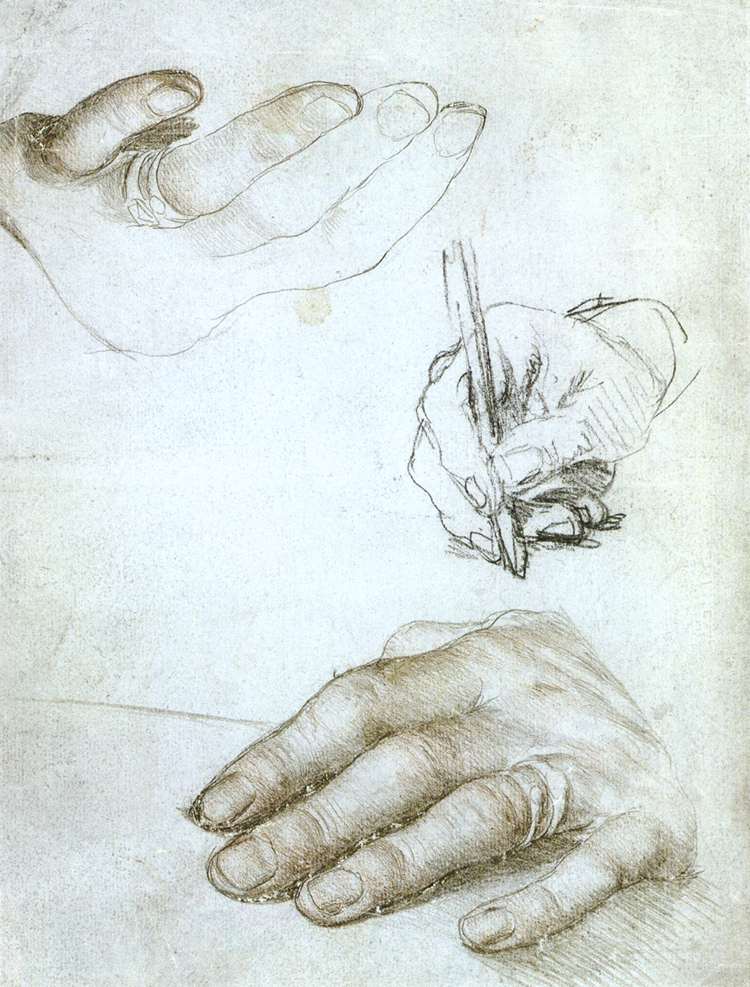 Holbein's studies of Erasmus's hands, in silverpoint and chalks, ca. 1523 (Louvre) Erasmus was given the sobriquet "Prince of the Humanists", and has been called "the crowning glory of the Christian humanists".[307] He has also been called "the most illustrious rhetorician and educationalist of the Renaissance".[205] Since the origin of Christianity there have been perhaps only two other men—St Augustine and Voltaire—whose influence can be paralleled with Erasmus. — W.S. Lily, Renaissance Types[308] No man before or since acquired such undisputed sovereignty in the republic of letters... The reform which he set in motion went beyond him, and left him behind. In some of his opinions, however, he was ahead of his age, and anticipated a more modern stage of Protestantism. He was as much a forerunner of Rationalism as of the Reformation. — 71. Erasmus, History of the Christian Church, vol 7, Philip Schaff French biographer Désiré Nisard characterized him as a lens or focal point: "the whole of the Renaissance in Western Europe in the sixteenth century converged towards him."[205][note 140] However,according to historian Erika Rummel, "Erasmus' role in the dissemination of ideas is therefore less that of a forerunner of the Reformation than that of a synthesizer of many of the currents of thought that fed into the Reformation."[310]: 86 Erasmus's reputation and the interpretations of his work have varied over time. Moderate Catholics recognized him as a leading figure in attempts to reform the Church, while Protestants recognized his initial support for (and, in part, inspiration of) Luther's ideas and the groundwork he laid for the future Reformation, especially in biblical scholarship. However, at times he has been viciously criticized, his works suppressed, his expertise corralled, his writings misinterpreted, his thought demonized, and his legacy marginalized. Erasmianism Not to be confused with Thomas Erastus § Erastianism. Erasmians: Erasmus frequently mentioned that he did not want office[69] nor to be the founder or figurehead of a sect or movement, despite his vigorous branding and self-promotion.[311] Nevertheless, historians do identify de facto "Erasmians" (ranging from the early Jesuits[note 141] to the early reformers,[312] and both Thomas More and William Tyndale)—Christian humanists who picked up on some or other aspects of Erasmus' agenda.[note 142] Erasmianism: This has been described as a "more intellectual form of spiritualized Christianity"[314] that is "an undercurrent of religious thought between Catholicism and Lutheranism."[315] It had a notable influence in Spain.[316] : 39 The near election of Reginald Pole as pope in 1546 has been attributed to Erasmianism in the electors.[317] However, a precise definition is not possible;[note 143] it is not, for example, a set of systematic doctrinal propositions. French historian Jean-Claude Margolin has noted an Erasmian stream in French culture putting "the concrete before the abstract and the ethical before the speculative", though not without noting that it is not clear whether Erasmus influenced the French or vice versa.[14]: 213 Erasmian Reformation: Some historians such as Edward Gibbon and Hugh Trevor-Roper have even claimed an "'Erasmianism after Erasmus,' a secret stream which meandered to and fro across the Catholic/Protestant divide, creating oases of rational thought impartially on either side." For some, this amounted to a third church: or even that "Luther's and Calvin's Reformations were minor affairs" compared to the Reformation of Erasmus and the humanists' which swept away the Middle Ages.[14]: 149 Erasmian liberalism: This has had an enduring run: described by philosopher Edwin Curley[318] that "the spirit of Erasmian liberalism was to emphasize the ethical aspects of Christianity at the expense of the doctrinal, to suspend judgment on many theological issues, and to insist that the faith actually required for salvation was a simple and uncontroversial one."[319] Erasmus has frequently been described as "proto-liberal"[84]: s.3.12 (both, e.g., in the UK "Lloyd George" sense of liberalism as a form of conservatism that wants moderate but real reform to prevent immoderate and destructive revolution, or the ethical sense of socio-economic Socinianism[320]: 70 ) Protestant historian Roland Bainton is quoted "no-one did more than Erasmus to break down the theory and practice of the medieval variety of intolerance."[319]: 4 Other popular or scholarly writers have suggested that Erasmus' tolerant but idealistic agenda failed,[321][322] certainly at the political level, evidenced by the wars and persecutions of the Protestant Reformation. Erasmus was also notable for exposing several important historical documents as forgeries or misattributions: including pseudo-Dionysius the Areopagite, the Gravi de pugna attributed to St Augustine, the Ad Herennium attributed to Cicero, and (by reprinting Lorenzo Valla's work)[323] the Donation of Constantine. Educationalist Erasmus is the greatest man we come across in the history of education! (R.R. Bolger) … with greater confidence it can be claimed that Erasmus is the greatest man we come across in the history of education in the sixteenth century. …It may also be claimed that Erasmus was one of the most important champions of women's rights in his century. — J.K. Sowards [86] Erasmus was notable for his textbooks, his sense of learning as play, his emphasis on speech skills and promoting early classical-language acquisition).[324]: 15 According to scholar Gerald J. Luhrman, "the system of secondary education, as developed in a number of European countries, is inconceivable without the efforts of humanist educationalists, particularly Erasmus. His ideas in the field of language acquisition were systematized and realized to a large extent in the schools founded by the Jesuits..."[325][note 144] In the 1540s, Ursulines founded schools in Rezatto, Brescia, "inspired by Erasmus’s pedagogical programme..." [note 145] His system of pronouncing ancient Greek was adopted for teaching in the major Western European nations. In England, he wrote the first curriculum for St Paul's School and his Latin grammar (written with Lily and Colet) "continued to be used, in adapted form, into the Twentieth Century."[327] Erasmus' curriculum, grammar, pronunciation and de Copia were adopted by the other major grammar schools: Eton, Westminster, Winchester, Canterbury, etc. and the universities[324]: 16, 17 Erasmus "tried to realize a practical goal: a modern education as preparation for administrators from the higher estates."[207] Erasmus was a key part of the humanist program to get Greek and Hebrew taught at the major Universities, inspired by Cardinal Cisneros' Trilingual College of San Ildefonso/Alcalá (1499/1509) and Bishop John Fisher's establishment of Greek and Hebrew lectures at Cambridge: the Trilingual Colleges at Louvain (1517) and Paris (1530) (where students included Loyola and Calvin)[328] spawned programs in Zurich, Rome, Strasbourg and Oxford (c.1566).[329] He has been described as "an unsuspected superspreader of New Ancient Greek."[note 146] Historian and Germanist Fritz Caspari saw education as the core of Erasmus' program: "Erasmus hoped that the education of all individuals, especially of princes and nobles, in the spirit and disciplines of antiquity and Christianity would bring the rational element in them to full fruition. Ratio, reason, was in his mind almost synonymous with "goodness" and "kindness." The rule of reason, achieved through education,would therefore result in men's living together in universal peace and harmony in accord with the lessons of Christ's Sermon on the Mount." — Frtz Caspari (1941)[198] Writer The popularity of his books is reflected in the number of editions and translations that have appeared since the sixteenth century. Ten columns of the catalogue of the British Library are taken up with the enumeration of the works and their subsequent reprints. The greatest names of the classical and patristic world are among those translated, edited, or annotated by Erasmus, including Ambrose, Aristotle, Augustine,[302] Basil, John Chrysostom, Cicero and Jerome.[331] 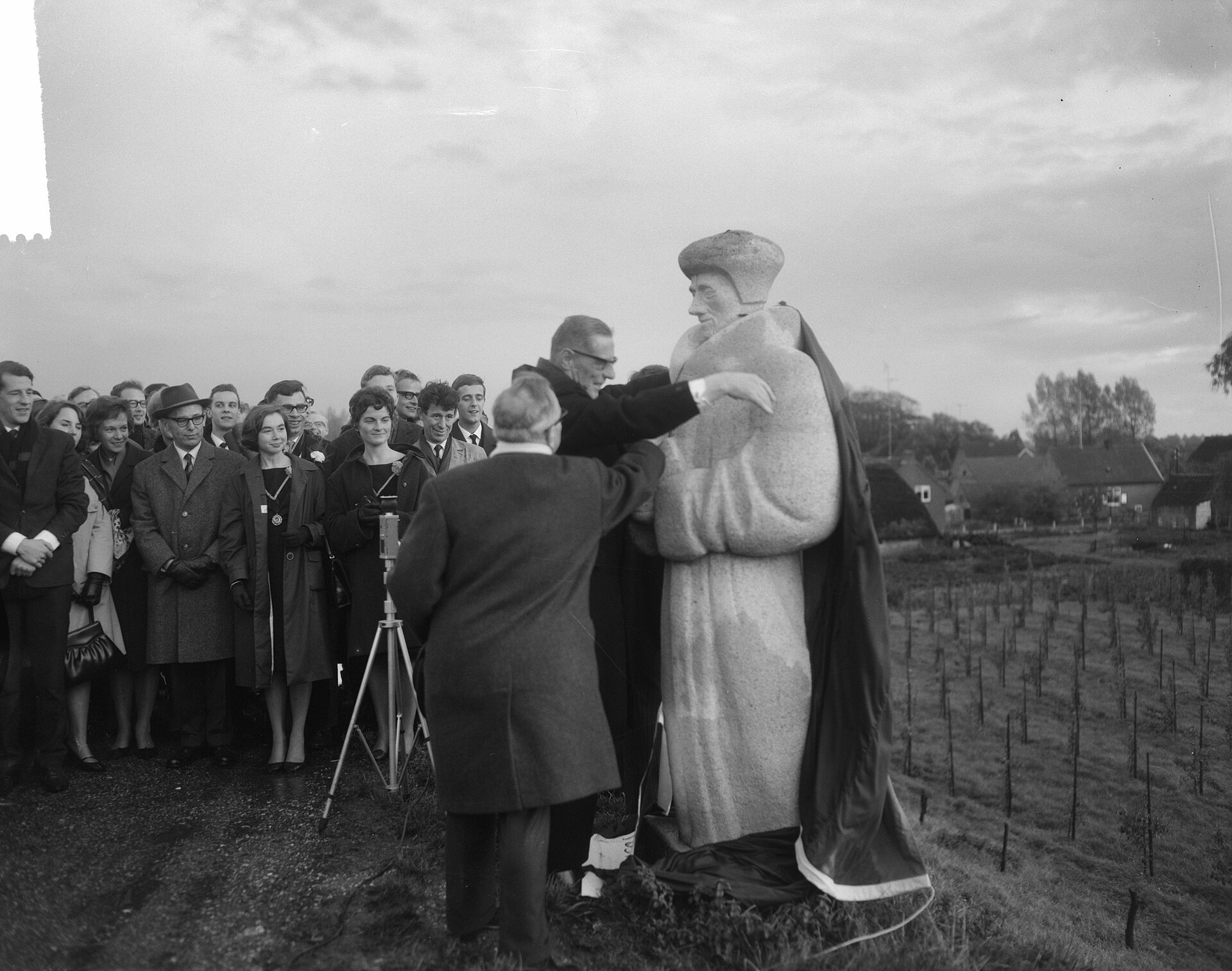 Unveiling of a Dutch statue of Erasmus (1964) In the Netherlands In his native Rotterdam, the Erasmus University Rotterdam, Erasmus Bridge, Erasmus MC and Gymnasium Erasmianum have been named in his honor. Between 1997 and 2009, one of the main metro lines of the city was named Erasmuslijn. The Foundation Erasmus House (Rotterdam),[332] is dedicated to celebrating Erasmus's legacy. Three moments in Erasmus's life are celebrated annually. On 1 April, the city celebrates the publication of his best-known book The Praise of Folly. On 11 July, the Night of Erasmus celebrates the lasting influence of his work. His birthday is celebrated on 28 October.[333] In Spain 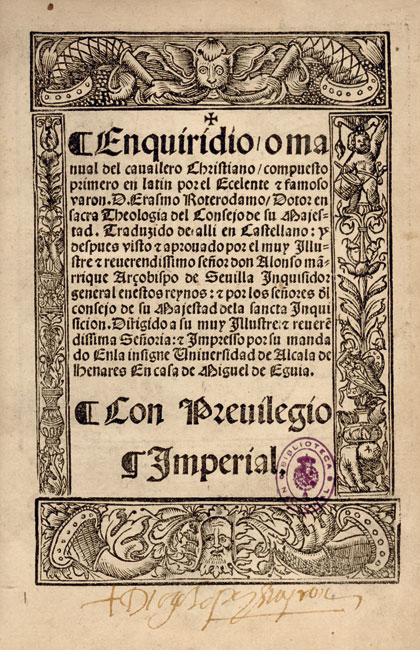 Enquiridio o manual del caballero Christiano, translation by Alonso Fernandez, published by Miguel de Eguía (1528) into Spanish of Erasmus' Enchiridion Erasmus became extraordinarily popular and influential in Spain, including in and around the talent pool (often from converso families) that formed the early Jesuits. There were at least 120 translations, editions, or adaptations of Erasmus' writings between 1520 and 1552,[334] though not The Praise of Folly. However, Erasmians and their associates faced, at times, extraordinary pushback from the theologians at Salamanca and Vallodolid, for being associated with the alumbrado and illuminist tendencies, with many (notably Ignatius of Loyola, who had lived in the house of publisher Miguel de Eguía at the time the Spanish edition of the Enchiridion was being published)[335]: 175 [note 147] resorting to exile rather than facing the Inquisition, house arrest, imprisonment or worse. However, at times the heads of the Inquisition were themselves Erasmians. Erasmus faced a notable semi-secret trial in Vallodolid in 1527, attended by numerous bishops, abbots and theologians. Its records still exist. It disbanded without condemning Erasmus as a heretic, as most of his contentious beliefs were regarded as respectable or useful by at least some important bishops, and the fanciful interpretations of the accusers did not stand up to scrutiny.[336] From the 1530s, historians note the start of a widespread disenchantment with Eradmus' approach: however his ideas and works were still circulating enough that even fifty years later Miguel Cervantes' "Erasmianism" may not have come from him having read any Erasmus directly.[337]: 37, 38 In Poland According to historian Howard Louthan "Few regions embraced Erasmus as enthusiastically as Poland, and nowhere else did he have such a concentration of allies positioned at the highest levels of society including the king himself." [note 148] In England 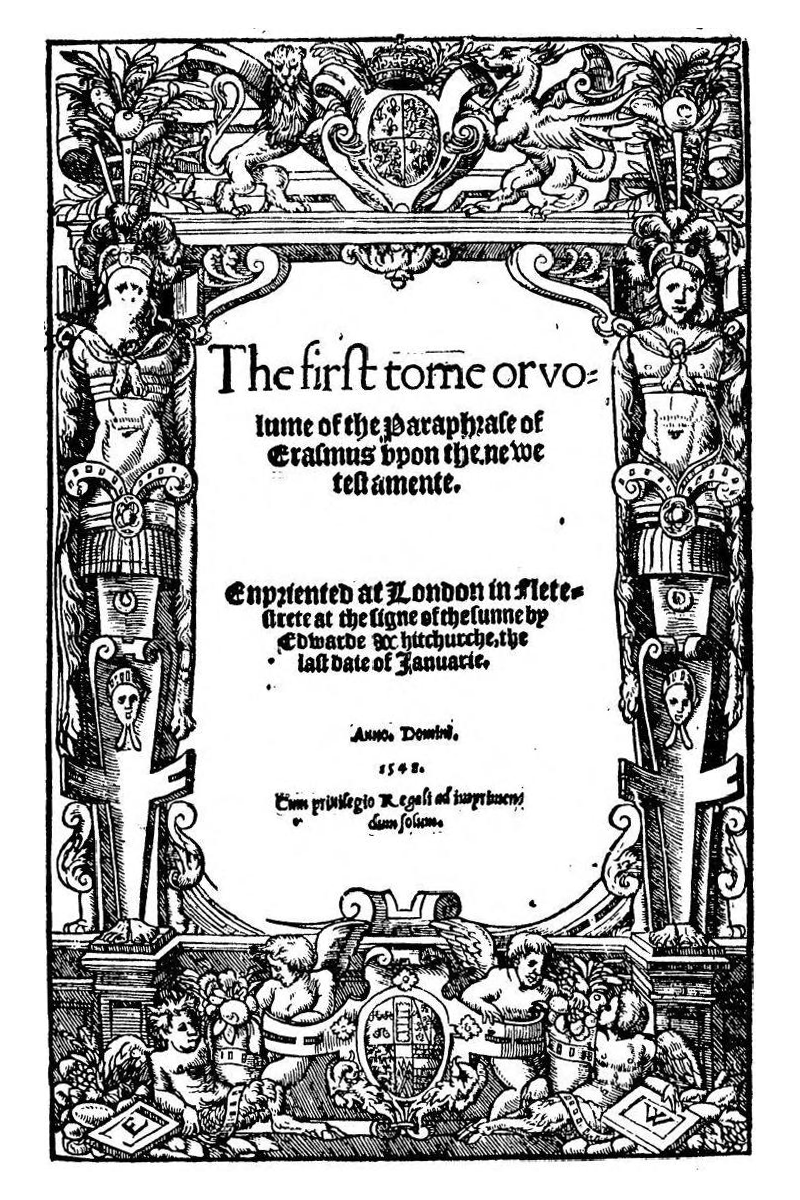 English translation Paraphrase of Erasmus, 1548 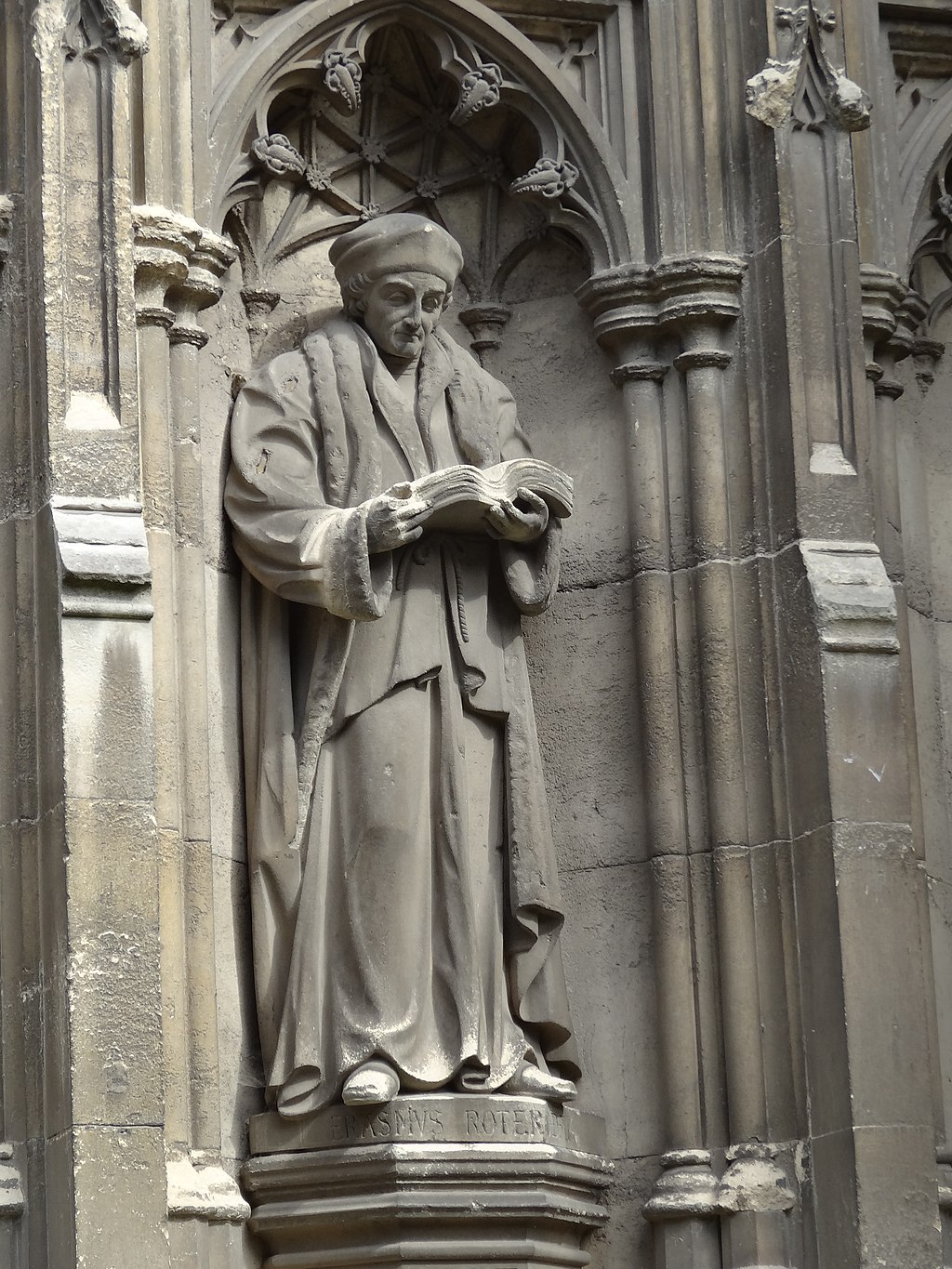 Statue (1870), Canterbury Cathedral Erasmus influenced Catholic and Protestant humanists alike. Historian Lucy Wooding argues (in Christopher Haigh's paraphrases) that "England nearly had a Catholic Reformation along Erasmian lines –but it was cut short by (Queen) Mary’s death and finally torpedoed by the Council of Trent."[note 149] The initial Henrican closure of smaller monasteries followed the Erasmian agenda, which was also shared by Catholic humanists such as Reginald Pole;[163]: 155 however the later violent closures and iconoclasm were far from Erasmus' program. After reading Erasmus' 1516 New Testament, Thomas Bilney "felt a marvellous comfort and quietness," and won over his Cambridge friends, future notable bishops, Matthew Parker and Hugh Latimer to reformist biblicism.[339] Both Lutheran Tyndale and his Catholic theological opponent Thomas More are considered Erasmians.[340]: 16 One of William Tyndale's earliest works was his translation of Erasmus' Enchiridion (1522,1533).[341] Following their deaths in 1536, Tyndale's English New Testament and anti-Catholic Preface was often printed (sometimes omitting Tyndale's name) in diglot editions paired with Erasmus' Latin translation and either his Paraclecis or his Preface to the Paraphrase of St Matthew.[313]: 156–168 In the reign of Edward VI, English translations of Erasmus' Paraphrases of the four Gospels[342] were legally required to be chained for public access in every church. Furthermore, all priests below a certain scholastic level were required to have their own copy of the complete Paraphrases of the New Testament.[note 150] This injunction was to an extent frustrated by delays in printing, but it is estimated that as many as 20,000 to 30,000 copies may have been printed between 1548 and 1553.[343]: 361 Erasmus' grammar, Adages, Copia, and other books continued as the core Latin educational material in England for the following centuries. His works and editions (in translation) are regularly connected with William Shakespeare, to Shakespeare's education, inspirations and sources (such as the shipwreck scene in The Tempest.)[344][345][346] The poet-rhetorician martyr Edmund Campion was educated at St Paul's School using Erasmus' textbooks and Latin curriculum.[324]: 15 Historian of literature Cathy Schrank has written that Erasmus' reputation and status changed over the course of the English "Long Reformation" from "being presented as a proto-Reformer, to problematically orthodox, to irenic martyr."[note 151] For some Restoration Anglicans, both those promoting enforced anti-extremism and latitudinarians, and into the Age of Enlightenment, Erasmus' moderation represented "an alternative to the belligerent Protestantism that characterized English political and social discourse".[348] It has been claimed that William of Orange's Toleration Act (1688) owed to Erasmus' inspiration.[14]: 186 By 1711, English Catholic poet and satirist Alexander Pope pictured Erasmus, following in a sequence of greats from Aristotle, Horace, Homer, Quintillian to Longinusas, ending a millennium of ignorance and superstition:[note 152] ... Much was believ'd, but little understood, And to be dull was constru'd to be good; A second deluge learning thus o'er-run, And the monks finish'd what the Goths begun. At length Erasmus, that great injur'd name (The glory of the priesthood and the shame!) Stemm'd the wild torrent of a barbarous age, And drove those holy Vandals off the stage. — Alexander Pope, An Essay on Criticism[349] For Edward Gibbon, Erasmus was "the father of rational theology."[350]: 157 By 1929, G.K. Chesterton could write "I doubt if any thinking person, of any belief or unbelief, does not wish in his heart that the end of mediaevalism had meant the triumph of the Humanists like Erasmus and More, rather than of the rabid Puritans like Calvin and Knox."[351]: 84 Catholic  Thomas Aquinas inspiring himself on Free Will from the writings of previous theologians such as Augustine. (1652) Erasmus was continually protected by popes,[note 153] bishops, inquisitors-general, and Catholic kings[note 30] during his lifetime.[note 154] The following generation of saints and scholars included many influenced by Erasmian humanism or spirituality, notably Ignatius of Loyola,[note 155][353][354][355] Teresa of Ávila,[356][note 156] John of Ávila,[358][note 157] and Angela Merici.[note 158] However, Erasmus attracted enemies in contemporary theologians in Paris, Louvain, Valladolid, Salamanca and Rome, notably Sepúlveda, Stúñica, Edward Lee,[note 159] Noël Beda (who Erasmus had known in France in the 1490s, but who opposed Greek and Hebrew),[359] as well as Alberto Pío, Prince of Carpi, who read his work with dedicated suspicion. These were theologians, usually from the mendicant orders that were Erasmus' particular target (such as Dominicans, Carmelites and Franciscans), who held a positive "linear view of history" for theology [note 160] that privileged recent late-medieval theology[360] and rejected the ad fontes methodology. Erasmus believed the vehemence of the attacks on Luther was a strategem to blacken humanism (and himself) by association, part of the centuries-long power struggle at the universities between scholastic "theologians" and humanist "poets".[360]: 724 [note 161] A particularly powerful opponent of Erasmus was Italian humanist Jerome Aleander, Erasmus' former close friend and bedmate in Venice at the Aldine Press and future cardinal. They fell out over Aleander's violent speech against Luther at the Diet of Worms, and with Aleander's identification of Erasmus as "the great cornerstone of the Lutheran heresy."[187][note 162] They periodically reconciled in warm personal meetings, only to fall into mutual suspicion again when distant. Erasmus spent considerable effort defending himself in writing, which he could not do after his death.[363] The Council of Trent addressed many of the controversies Erasmus had been involved with: including free will, accumulated errors in the Vulgate, and priestly training,[note 163] and followed his call for a renewed positive focus on the Creed. Erasmus' major ethical complaint that a certain kind of scholasticism was "curiositas" (useless, vain speculation) and artificially divisive was endorsed in the 4 December 1563 Decree Concerning Purgatory which recommended the avoidance of speculations and non-essential questions. Prohibitions 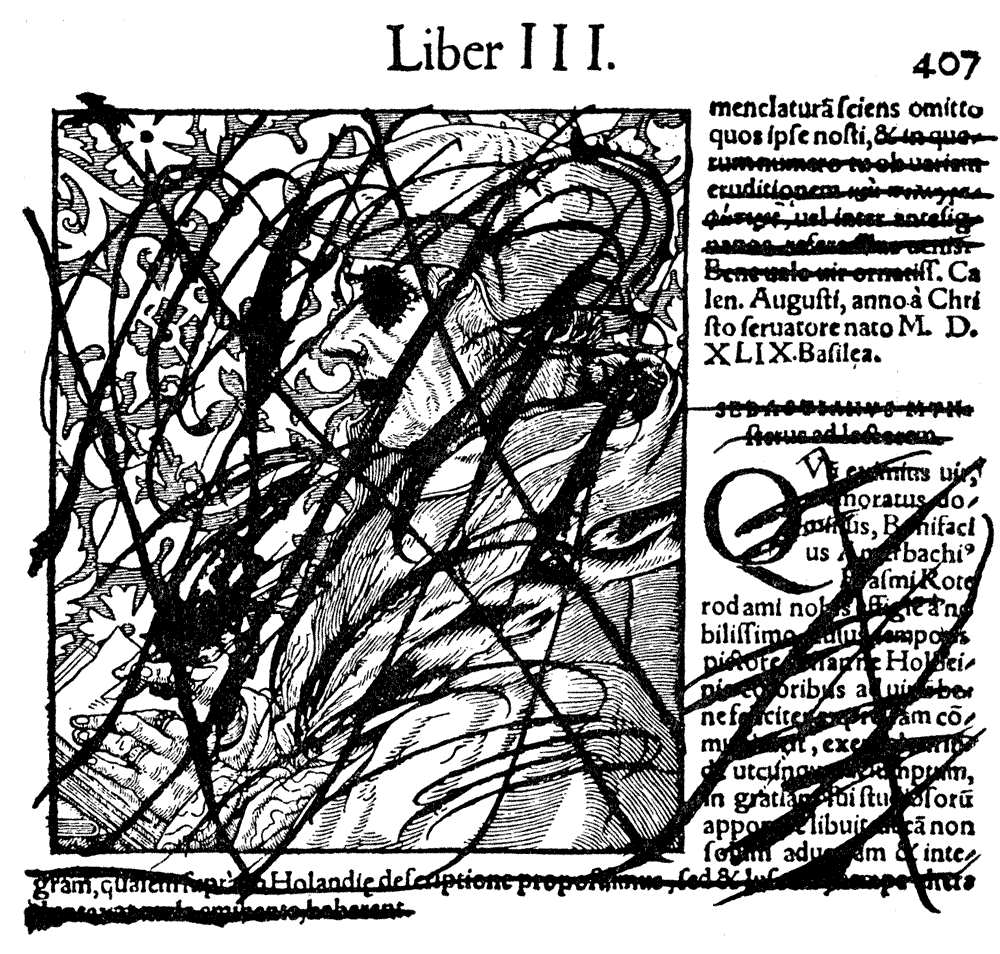 A work of Erasmus censored, perhaps following the inclusion of some works on the Index Librorum Prohibitorum By the 1560s, there was a marked downturn in reception: at various times and durations, some of Erasmus' works, especially in Protestantized editions, were placed on the various Roman, Dutch, French, Spanish and Mexican[365] Indexes of Prohibited Books, either to not be read, or to be censored and expurgated: each area had different censorship considerations and severity.[366] Erasmus' work had been translated or reprinted throughout Europe, often with Protestantizing revisions and sectarian prefaces. Sometimes the works of Martin Luther were sold with the name of Erasmus on the cover. Erasmus' works were to some extent prohibited in England under Queen Mary I, from 1555.[note 164] For the Roman Index as it emerged at the close of the Council of Trent, Erasmus' works were completely banned (1559), mostly unbanned (1564), completely banned again (1590), and then mostly unbanned again with strategic revisions (1596) by the Indexes of successive Popes.[367] In the 1559 Index, Erasmus was classed with heretics; however Erasmus was never judicially arraigned, tried or convicted of heresy: the censorship rules established by the Council of Trent targeted not only notorious heretics but also those whose writings "excited heresy" (regardless of intent), especially those making Latin translations of the New Testament deemed to vie with (rather than improve or annotate or assist) the Vulgate. The Colloquies were especially but not universally frowned on for school use, and many of Erasmus' tendentious prefaces and notes to his scholarly editions required adjustment.[368] In Spain's Index, the translation of the Enchiridion only needed the phrase "Monkishness is not piety" removed to become acceptable. By 1896, the Roman Index still listed Erasmus' Colloquia, The Praise of Folly, The Tongue, The Institution of Christian Marriage, and one other as banned, plus particular editions of the Adagia and Paraphrase of Matthew. All other works could be read in suitable expurgated versions.[369] Because Erasmus' scholarly editions were frequently the only sources of Patristic information in print, the strict bans were often impractical, so theologians worked to produce replacement editions building on, or copying, Erasmus' editions. The Jesuits received a dispensation from the Roman Inquisitor General to read and use Erasmus' work[188] (not kept on the open shelves of their libraries),[370] as did priests working near Protestant areas such as Francis de Sales. Post-Tridentine Early Dutch Jesuit scholar Peter Canisius (fl. 1547 - 1597), who produced several works superseding Erasmus',[note 165] is known to have read, or used phrases from, Erasmus' New Testament (including the Annotations and Notes) and perhaps the Paraphrases, his Jerome biography and complete works, the Adages, the Copia, and the Colloquies:[note 166] Canisius, having actually read Erasmus, had an ambivalent view on Erasmus that contrasted with the negative line of some of his contemporaries: Very many people applied also to Erasmus, declaring: 'Either Erasmus speaks like Luther or Luther like Erasmus' (Aut Erasmus Lutherizat, aut Lutherus Erasmizat). And yet, we must say, if we would like to render an honest judgment, that Erasmus and Luther were very different. Erasmus always remained a Catholic. ... Erasmus criticized religion 'with craft rather than with force', often applying considerable caution and moderation to either his own opinions or errors. ...Erasmus passed judgment on what he thought required censure and correction in the teaching of theologians and in the Church. — Peter Canisius, De Maria virgine (1577), p601[note 167] In contrast, Robert Bellarmine's Controversies mentions Erasmus (as presented by Erasmus' opponent Albert Pío) negatively over 100 times, categorizing him as a "forerunner of the heretics";[372]: 10 though not a heretic.[note 168] [note 169] Alphonsus Ligouri, who also had not read Erasmus, judged that Erasmus "died with the character of an unsound Catholic but not a heretic," putting it all in the context of a dispute between Theologians and Rhetoricians.[note 170] His patristic scholarship continued to be valued by academics, as were un-controversial parts of his biblical scholarship,[226]: 614, 617 though Catholic biblical scholars started to criticize Erasmus' limited range of manuscripts for his direct New Testament as undermining his premise of correcting the Latin from the "original" Greek.[226]: 622 The Jesuit mission to China, led by Matteo Ricci,[374] adopted the approach of cultural accommodation[375] linked to Erasmus.[note 171] The early Jesuits were exposed to Erasmus at their colleges,[376] and their positioning of Confucius echoed Erasmus' positioning of "Saint" Socrates.[377]: 171 Salesian scholars have noted Erasmus' significant influence on Francis de Sales: "in the approach and the spirit he (de Sales) took to reform his diocese and more importantly on how individual Christians could become better together,"[378] his optimism,[379] civility,[380] esteem of marriage.[381] and, according to historian Charles Béné, a piety addressed to the laity, the acceptance of mental prayer, and the valuing of pagan wisdom.[14]: 212 A famous 17th century Dominican library featured statues of famous churchmen on one side and of famous "heretics" (in chains) on the other: those foes including the two leading anti-mendicant Catholic voices William of Saint-Amour (fl. 1250) and Erasmus.[382]: 310 By 1690, Erasmus was also, rather perversely, labelled as the forerunner of the heretical tendecies in the Jansenists. [note 172] From 1648 to 1794 and then 1845 to the present, the mainly-Jesuit Bollandist Society has been progressively publishing Lives of the Saints, in 61 volumes and supplements. Historian John C. Olin notes an accord of approach with the hitherto "unique" method, mixing critical standards and devotional/rhetorical purpose, that Erasmus had laid out in his Life of St Jerome.[326]: 97, 98 By the 1700s, Erasmus' even indirect influence on Catholic thought had waned. Twentieth Century A historian has written that "a number of Erasmus' modern Catholic critics do not display an accurate knowledge of his writings but misrepresent him, often by relying upon hostile secondary sources," naming Yves Congar as an example.[204]: 39 A major turning point in the popular Catholic appraisal of Erasmus occurred in 1900 with rosy Benedictine historian (and, later, Cardinal) Francis Aidan Gasquet's The Eve of the Reformation which included a whole chapter on Erasmus based on a re-reading of his books and letters. Gasquet wrote "Erasmus, like many of his contemporaries, is often perhaps injudicious in the manner in which he advocated reforms. But when the matter is sifted to the bottom, it will commonly be found that his ideas are just."[note 173] Over the last century, Erasmus's Catholic reputation has gradually started to be rehabilitated: favourable factors may include: the increasingly active modern historical and theological scholarship on Erasmus suggested chinks in the traditional partisan characterzations of Erasmus; the retirement of the Roman Index librorum prohibitorum in 1966; 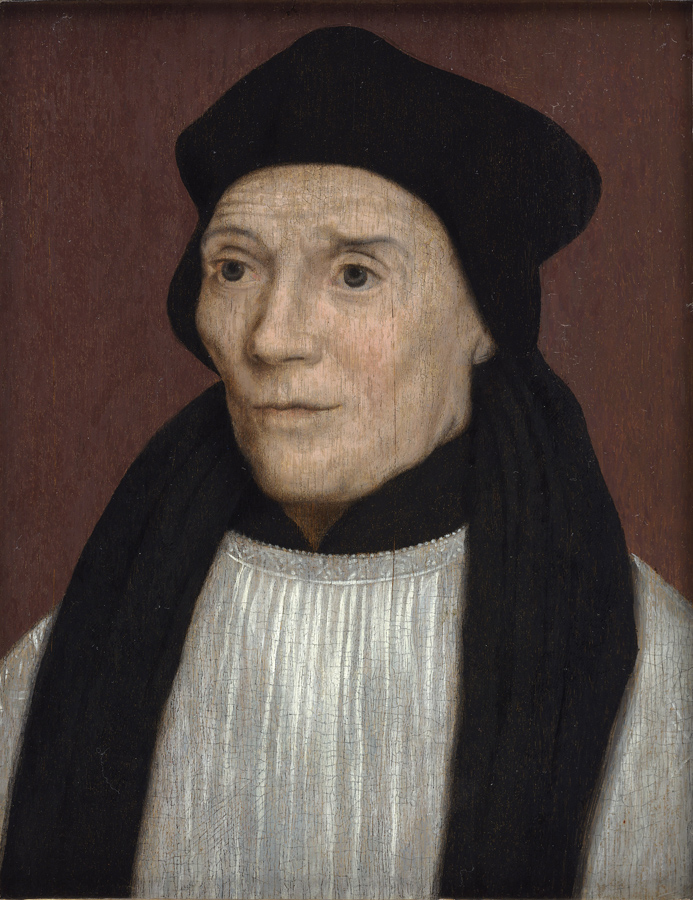 John Fisher, after Hans Holbein increased support for a view of Erasmus that portrays him as a conservative[note 174] endorsed by and responsive to the hierarchy[note 175] as much as a maverick, with him voicing and crystallizing mainstream and respectable Catholic thought of his time[note 176] as much as innovating;[note 177] and to an extent resuscitating Victorine (the Canons Regular of St Victor)[383]: 171–174 and Cappadocian and patristic[123]: 501–505 approaches. his deep friendships and interactions with three Saint-Martyrs Thomas More,[note 178] John Fisher,[note 179] and Brigittine monk Richard Reynolds. his acknowledged or retro-fitted influence on perhaps five Doctors of the Church (Ignatius, Theresa of Ávila, John of Ávila, Canisius, de Sales), the positive normalization of his views in influential new orders such as the Jesuits, Oratorians, Redemptorists, Ursulines[386] and Salesians,[note 180] and an increasing list of exemplary Catholics whose views channel or parallel Erasmus', such as Bartolomé de las Casas' De unico vocationis modo (1537),[387] and De la Salle's Decorum & Civility;[note 181] the acceptance of St John Henry Cardinal Newman's "development of doctrine", to some extent a chick hatched from the egg of Erasmus' theological historicism[note 182] and his appeal to tradition (sensus fidei fidelium) on the Eucharist;[14]: 129 the reinvigouration of patristic ad fontes and a re-surfacing of several ideas associated with Erasmus (but ideas sometimes with a longer, forgotten patrimony, and sometimes from an even more problematic figure than Erasmus)[note 183] by ressourcement and Communio theologians, such as Henri de Lubac[note 184] Hans Urs von Balthasar, who ranked Erasmus with Augustine, Bonaventure, and Thomas Aquinas as the great theologians/exegetes;[390] Oratorian Louis Bouyer, who wrote that the Method of True Theology (or Ratio) of Erasmus "represents, for the first time and in admirable fashion, the use of principles and methods entirely adequate to effect a really fruitful renewal of Catholic faith and theology;"[391] Joseph Ratzinger, whose famous Regensberg Address emphasized the fundamental influence of Hellenic philosophy on primitive Christianity.[note 185] For theologian George Chantraine, Erasus's so-called skepticism was actually a function of his belief that Church defined doctrine not individual theologians.[note 186] his promotion of the recognition of adiaphora and toleration within bounds was taken up, to an extent, by Pope John XXIII: In necessariis unitas, in dubiis libertas, in omnibus caritas.[392][note 187] His instrumentalist approach to Christian humanism has been compared to that of John Henry Newman and the personalism of John Paul II,[note 188]: 151–164 but also has been criticized as treating the Church's doctrines merely as aids to piety.[note 189] The Catholic scholar Thomas Cummings saw parallels between Erasmus' vision of Church reform and the vision of Church reform that succeeded at the Second Vatican Council.[317] Theologian J. Coppens noted the "Erasmian themes" of Lumen Gentium (e.g. para 12), such as the sensus fidei fidelium and the dignity of all the baptized.[14]: 130, 138, 150 Another scholar writes "in our days, especially after Vatican II, Erasmus is more and more regarded as an important defender of the Christian religion."[393] John O'Malley has commented on a certain closeness between Erasmus and Dei Verbum.[note 190] In 1963, Thomas Merton suggested "If there had been no Luther, Erasmus would now be regarded by everyone as one of the great Doctors of the Catholic Church. I like his directness, his simplicity, and his courage."[394]: 146 Notably, since the 1950s, the Roman Catholic Easter Vigil mass has included a Renewal of Baptismal Promises,[395]: 3, 4 an innovation[396] first proposed[397] by Erasmus in his Paraphrases. [note 191] In his 1987 collection The Spirituality of Erasmus of Rotterdam historian Richard deMolen, later a Catholic priest, called for Erasmus' canonization.[31] Protestant 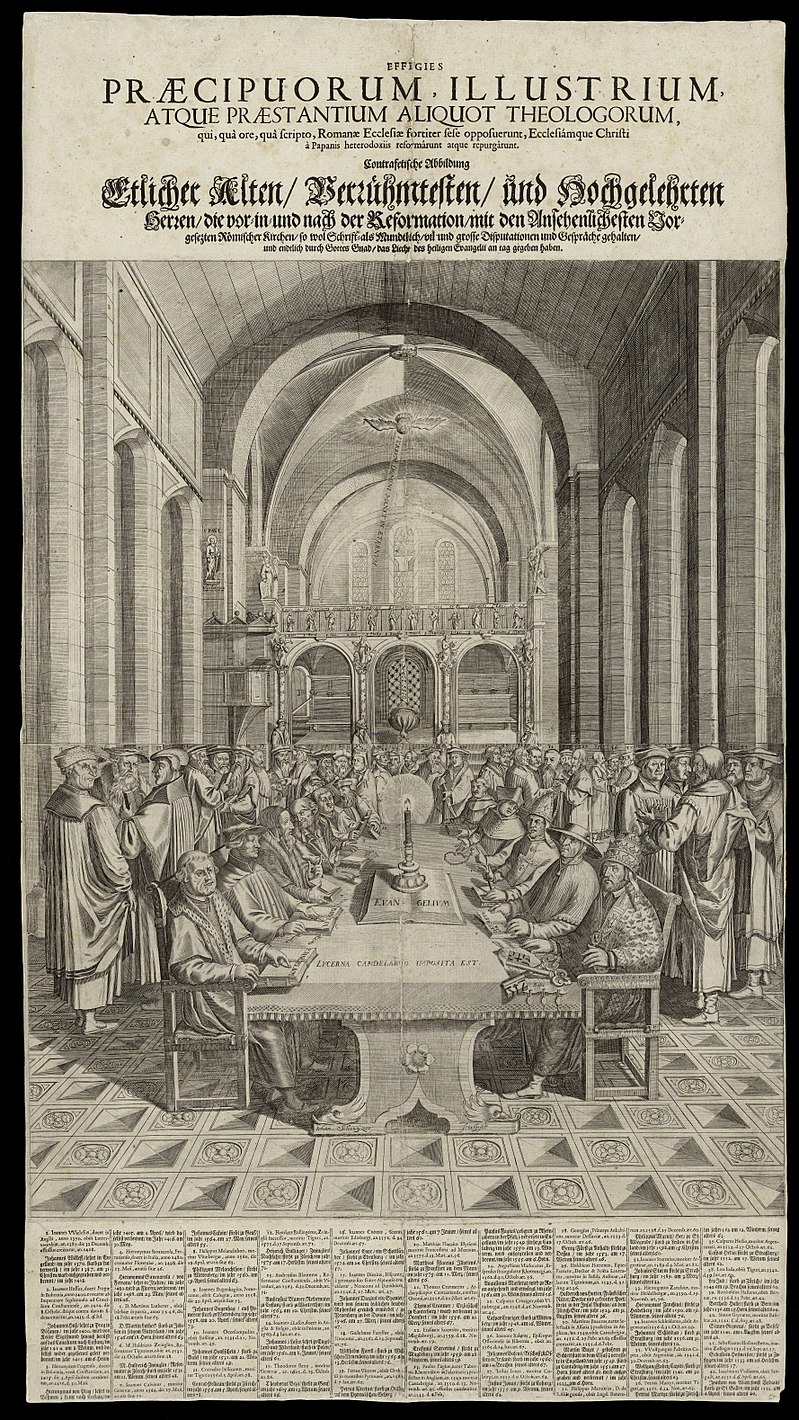 Fictive gathering of notable theologians who "controverted prestigious superiors of the Roman church", at back 1. John Wycliffe, 2. Jan Hus, 3. Jerome of Prague, 4. Girolamo Savonarola; at table from left Martin Luther, Huldrych Zwingli, John Calvin, Philipp Melanchthon, Johannes Bugenhagen, Johannes Oecolampadius, et al. (1650) Erasmus is not shown in this company. Protestant views on Erasmus fluctuated depending on region and period, with continual support in his native Netherlands and in cities of the Upper Rhine area. However, following his death and in the late sixteenth century, many Reformation supporters saw Erasmus's critiques of Luther and lifelong support for the universal Catholic Church as damning, and second-generation Protestants were less vocal in their debts to the great humanist. There was a tendency to downplay that many of the usages fundamental to Luther, Melancthon and Calvin, such as the forensic imputation of righteousness, grace as divine favour or mercy (rather than a medicine-like substance[note 192] or habit), faith as trust (rather than a persuasion only), "repentance" over "doing penance" (as used by Luther in the first theses of the 95 Theses), owed to Erasmus.[note 193] Luther had attempted a Biblical analogy to justify his dismissal of Erasmus' thought: "He has done what he was ordained to do: he has introduced the ancient languages, in the place of injurious scholastic studies. He will probably die like Moses in the land of Moab…I would rather he would entirely abstain from explaining and paraphrasing the Scriptures, for he is not up to this work…to lead into the land of promise, is not his business…" [398] "Erasmus of Rotterdam is the vilest miscreant that ever disgraced the earth…He is a very Caiaphas."[note 194] However Erasmus corresponded cordially with Melancthon until the end.[166] Some historians have even said that "the spread of Lutheranism was checked by Luther’s antagonizing (of) Erasmus and the humanists."[399]: 7 Erasmus' reception is also demonstrable among Swiss Protestants in the sixteenth century: he had an indelible influence on the biblical commentaries of, for example, Konrad Pellikan, Heinrich Bullinger, and John Calvin, all of whom used both his annotations on the New Testament and his paraphrases of same in their own New Testament commentaries.[400] Huldrych Zwingli, the founder of the Reformed tradition, had a conversion experience after reading Erasmus' poem, 'Jesus' Lament to Mankind.' Zwingli's moralism, hermeneutics and attitude to patristic authority owe to Erasmus, and contrast with Luther's.[401] Anabaptist scholars have suggested an 'intellectual dependence'[402] of Anabaptists on Erasmus.[403] According to Dr Kenneth Davis "Erasmus had copious direct and indirect contact with many of the founding leaders of Anabaptism ... the Anabaptists can best be understood as, apart from their own creativity, a radicalization and Protestantization not of the Magisterial Reformation but of the lay-oriented, ascetic reformation of which Erasmus is the principle mediator."[404]: 292 For evangelical Christianity, Erasmus had a strong influence[405] on Arminius. Erasmus' promotion of the recognition of adiaphora and toleration within bounds was taken up by many kinds of Protestants. Erasmus' Greek New Testament was the basis of the Textus Receptus bibles, which were used for all Protestant bible translations from 1600 to 1900, notably including the Luther Bible and the King James Version. Character attacks Writers have often explained Erasmus' failure to adopt their favoured position as manifesting some deep character flaw.[note 195] In historian Bruce Mansfield's words, "a smallness of character in Erasmus stood in the way of his greatness of mind."[14]: 6–10 Luther's antipathy to Erasmus has continued to more recent times in some Lutheran teachers: Oh how Erasmus placed honor above truth! To seek honor is a human frailty. To ever permit it to go to the point of placing honor and for that matter friendship, expediency, or anything else, above truth is to be blinded by the devil himself and to set a snare for others to be entrapped in his delusions. Such delusions Erasmus would support in pride, weakness, vacillation, and false love for peace and harmony." "Erasmus, the Judas of the Reformation" "this cultured and eloquent theological midget — Otto J. Eckert (1955)[399]: 27, 28, 31 The Catholic Encyclopedia (1917) explained "His inborn vanity and self-complacency were thereby increased almost to the point of becoming a disease; at the same time he sought, often by the grossest flattery, to obtain the favour and material support of patrons or to secure the continuance of such benefits."[407] According to Catholic historian Joseph Lortz (1962) "Erasmus remained in the church…but as a half Catholic…indecisive, hesitating, suspended in the middle."[408]: 299 English Jesuit scholar C. C. Martindale wrote "Erasmus really disliked men personally."[note 196] A 1920s American historian wrote "Erasmus's ambitions, fed by an innate vanity which at times repels by its frank self-seeking, included both fame and fortune" yet pulls back on another historian's view that his "irritable self-conceit, shameless importunity,…may lead one to a sense of contempt for the scholar", pointing out the reality of Erasmus' dire poverty in Paris.[409] Another 1920s British historian wrote "one feels nauseated when one reads the great scholar's choice Latin that embalms a beggar's whine without the beggar's excuse of absolute need to justify or palliate it...There is no doubt as to where Dante would have placed Erasmus" (i.e in the outer circle of Hell, with vacillators)[151] An inter-war Anglican historian judges "He is a worm, a pigmy, a sheep able only to bleat when the gospel is destroyed ... Erasmus was a book-man and an invalid.”[313]: 143 A Victorian Scottish biographer of Tyndale contrasted Erasmus' weak constitution with the "more masculine energy" of Luther and Tyndale.[313]: 143 In the 20th century, various psychoanalyses were made of Erasmus by practitioners: these diagnosed him variously as "supremely egotistic, neurasthenic, morbidly sensitive, volatile, variable, and vacillating, injudicious, irritable, and querulous, yet always ... a baffling but interesting chararacter"; a "volatile neurotic, latent homosexual, hypochondriac, and psychasthenic"; having "a form of narcissistic character disorder," a spiritualized, vengeful, "paranoid disposition" driven by "injured narcissism", "repeated persecutory preoccupations...(with) delusional states of paranoia toward the end of his life", repressed anger directed "father figures such as prelates and teachers," needing a "sense of victimization" [410]: 598–624 Huizinga's biography (1924) treats him more sympathically, with phrases such as: a great and sincere need for concord and affection, profoundly in need of (physical and spiritual) purity, a delicate soul (with a delicate constitution), fated to an immoderate love of liberty,[note 197] having a dangerous fusion between inclination and conviction, restless but precipitate, a continual intermingling of explosion and reserve, fastidious, bashful, coquettish, a white-lier, evasive, suspicious, and feline.[411] Yet "compared with most of his contemporaries he remains moderate and refined."[141]: Ch.xiv Name used The European Erasmus Programme of exchange students within the European Union is named after him. The Erasmus Programme scholarships enable students to spend up to a year of their university courses in a university in another European country, commemorating Erasmus' impulse to travel. The Erasmus Journal of Philosophy and Economics[412] is produced at the Erasmus Institute for Philosophy and Economics (EIPE)[413] at the Erasmus University Rotterdam. Rotterdam also an Erasmus Bridge. A peer-reviewed annual scholarly journal Erasmus Studies has been produced since 1981.[414] The Erasmus Prize is one of Europe's foremost recognitions for culture, society or social science. It was won by Wikipedia in 2015. The Erasmus Lectures are an annual lecture on religious subjects, given by prominent Christian (mainly Catholic) and Jewish intellectuals,[415] most notably by Joseph Ratzinger in 1988.[416] The Erasmus Building in Luxembourg was completed in 1988 as the first addition to the headquarters of the Court of Justice of the European Union (CJEU).[417] The building houses the chambers of the judges of the CJEU's General Court and three courtrooms.[417] It is next to the Thomas More Building. Several schools, faculties and universities in the Netherlands and Belgium are named after him, as is Erasmus Hall in Brooklyn, New York, USA. Queens' College, Cambridge, has an Erasmus Tower,[418] Erasmus Building[419] and an Erasmus Room.[420] Until the early 20th century, Queens' College used to have a corkscrew that was purported to be "Erasmus' corkscrew", which was a third of a metre long; as of 1987, the college still had what it calls "Erasmus' chair".[421] From 1997 to 2008, the American University of Notre Dame had an Erasmus Institute.[422] Intellectual Literary theorist Hans Urs von Balthasar listed Erasmus in one of three key intellectual "events" in the Germanic age:[423] Duns Scotus-William of Ockham-Francisco Suárez and Meister Eckhart-Nicholas of Cusa-Ignatius of Loyola Martin Luther-Erasmus-Shakespeare Kant-Hegel-Marx Political journalist Michael Massing has written of the Luther-Erasmus free will debate as creating a fault line in Western thinking: Europe adopted a form of Erasmian humanism while America has been shaped by Luther-inspired individualism.[176] By the coming of the Age of Enlightenment, Erasmus increasingly again became a more widely respected cultural symbol and was hailed as an important figure by increasingly broad groups. In a letter to a friend, Erasmus once had written: "That you are patriotic will be praised by many and easily forgiven by everyone; but in my opinion it is wiser to treat men and things as though we held this world the common fatherland of all."[424] Thus, the universalist ideals of Erasmus are sometimes claimed to be important for fixing global governance.[425] Catholic historian Dom David Knowles wrote that a just appreciation of traditional Catholic doctrine was a necessary condition for appreciating Erasmus, "without which many otherwise gifted writers have repeated meaningless platitudes."[163] According to two Dutch historians, "his legacy irreversibly inspired researchers to a hermeneutical approach that in the end could not but result in irrefutable attacks on the self-evident complete inerrancy of Holy Writ."[226]: 632 Quotes Erasmus is credited with numerous quotes; many of them are not exactly original to him but are taken from his collections of sayings such as Adages or Apophthegmata.[note 198] In the country of the blind, the one-eyed man is king. Adages The most disadvantageous peace is better than the justest war. Adages Bidden or unbidden, God is always there. Adages "When I get a little money I buy books; and if any is left, I buy food and clothes."[426] "Monkishness is not piety" Enchiridion "Christ said (to St Peter) 'Feed my sheep', not 'Devour my sheep'." [citation needed] "All the ups and downs of comedy usually end in marriage. It looks as though the Lutheran tragedy will end the same way."[427] Martin Luther is "a snake without a snakecharmer" Hyperaspistes II "If I have my way, the farmer, the smith, the stone-cutter will read him (Christ), prostitutes and pimps will read him, even the Turks will read him. …If it be the ploughman guiding his plough, let him chant in his own language the mystic psalms." Paraphrase of St Matthew On Scholastics: "They can deal with any text of scripture as with a nose of wax, and knead it into what shape best suits their interest." The Praise of Folly[428]: 75 He is also blamed for the mistranslation from Greek of "to call a bowl a bowl" as "to call a spade a spade",[429] and the rendering of Pandora's "jar" as "box".[430] The Greek epitaph for his young friend Joseph Batt (Greek: Ἰάκωβε Βάττε, θάρσεο·καλῶς θανὼν παλιμφύει) became a popular grave text: "have courage · he who dies well is born again."[330] |
レガシー(遺産)と評価 ホルバインによるエラスムスの手の習作、シルバーポイントとチョークによる、1523年頃(ルーヴル美術館蔵) エラスムスは、「人文主義者のプリンス」と呼ばれ、「キリスト教人文主義者の頂点に立つ栄光」と呼ばれている[307]。 キリスト教の起源以来、エラスムスと並ぶ影響力を持った人物は、おそらく聖アウグスティヌスとヴォルテールの2人しかいない。 - W.S.リリー『ルネサンスの型』[308]。 後にも先にも、文字の共和国においてこれほど議論の余地のない主権を獲得した人物はいない...。彼が着手した改革は彼を超え、彼を置き去りにした。しか し、いくつかの意見において、彼は時代の先端を行き、プロテスタンティズムのより現代的な段階を先取りしていた。彼は宗教改革の先駆者であると同時に、合 理主義の先駆者でもあった。 - 71. エラスムス『キリスト教会史』第7巻、フィリップ・シャフ フランスの伝記作家デジレ・ニサールは、エラスムスを「16世紀の西ヨーロッパにおけるルネサンス全体が彼に向かって収束していった」[205][注釈 140]レンズあるいは焦点として特徴づけている。しかし、歴史家エリカ・ランメルによれば、「したがって、思想の普及におけるエラスムスの役割は、宗教 改革の先駆者というよりも、宗教改革に影響を与えた多くの思想潮流の統合者である」[310][注釈 3]: 86。 エラスムスの評価とその著作の解釈は、時代とともに変化してきた。穏健なカトリック信者は、彼を教会改革の試みの指導的人物として認識し、一方プロテスタ ント信者は、彼がルターの思想を最初に支持し(そして部分的にはそれにインスピレーションを与えた)、特に聖書学において、将来の宗教改革のための基礎を 築いたことを認めている。しかし、時に彼は悪意を持って批判され、彼の著作は弾圧され、彼の専門知識は整理され、彼の著作は誤って解釈され、彼の思想は悪 者にされ、彼の遺産は疎外された。 エラスミアニズム トマス・エラスタス§エラスミアニズムと混同しないように。 エラスミア人: エラスムスは、精力的なブランディングと自己宣伝にもかかわらず、役職[69]を望まず、宗派や運動の創始者や指導者にもなりたくないと頻繁に述べていた [311]。にもかかわらず、歴史家たちは事実上の「エラスミアン」(初期のイエズス会[注釈 141]から初期の改革者たち[312]、トマス・モアとウィリアム・ティンデールの両者に至るまで)、すなわちエラスムスの課題の一部または他の側面を 取り上げたキリスト教ヒューマニストを特定している[注釈 142]。 エラスムス主義: 1546年にレジナルド・ポールがローマ教皇に選出されそうになったことは、選挙人におけるエラスミアニズムの影響とされている[317]。しかし、正確 な定義は不可能であり、例えば体系的な教義命題の集合ではない[注釈 143]。 フランスの歴史家ジャン=クロード・マルゴリンは、「抽象的なものよりも具体的なもの、思弁的なものよりも倫理的なもの」を重視するフランス文化における エラスムスの流れを指摘しているが、エラスムスがフランス人に影響を与えたのか、あるいはその逆なのかは明らかではない[14]: 213。 エラスムスの宗教改革 エドワード・ギボンやヒュー・トレバー=ローパーといった一部の歴史家は、「エラスムス以後のエラスミアニズム、カトリックとプロテスタントの分裂を行き 来し、どちらの側にも公平に合理的な思想のオアシスを作り出した秘密の流れ」とさえ主張している。あるいは、中世を一掃したエラスムスと人文主義者たちの 宗教改革に比べれば、「ルターやカルヴァンの改革は些細なものだった」とさえ言う人もいる[14]: 149 エラスムスの自由主義: 哲学者エドウィン・カーリー[318]は、「エラスムスの自由主義の精神は、教義を犠牲にしてキリスト教の倫理的側面を強調し、多くの神学的問題について の判断を保留し、救いに実際に必要な信仰は単純で議論の余地のないものであると主張することであった」と述べている[319]。 エラスムスはしばしば「プロト・リベラル」[84]: s.3.12と評されている(例えば、行き過ぎた破壊的な革命を防ぐために穏健だが現実的な改革を望む保守主義の一形態としてのリベラリズムの英国「ロイ ド・ジョージ」的な意味においても、社会経済的なソシニアニズム[320]: 70の倫理的な意味においても)。 プロテスタントの歴史家ローランド・ベイントンは、「エラスムスほど、中世のさまざまな不寛容の理論と実践を打破した人物はいない」[319]と引用して いる: 4 エラスムスの寛容でありながら理想主義的なアジェンダは、プロテスタント宗教改革の戦争や迫害によって証明されたように、政治的なレベルでは確かに失敗し た[321][322]。 エラスムスはまた、アレオパギテの偽ディオニュシオス、聖アウグスティヌスのものとされる『Gravi de pugna』、キケロのものとされる『Ad Herennium』、(ロレンツォ・ヴァッラの著作を再版することによって)[323]『コンスタンティヌスの寄進』など、いくつかの重要な歴史的文書 が偽造または誤伝であることを暴いたことでも知られている。 教育者 エラスムスは教育史上最も偉大な人物である!(R.R.ボルジャー) ...エラスムスは、16世紀の教育史において我々が出会った最も偉大な人物であると、より確信を持って主張することができる。...エラスムスはまた、 彼の世紀における女性の権利の最も重要な擁護者の一人であったと主張することもできる。 - J.K.ソワーズ[86] エラスムスは、彼の教科書、遊びとしての学習の感覚、発話技術の重視、古典語の早期習得の促進)[324]で注目された: 15 学者ジェラルド・J・ルールマンによれば、「ヨーロッパの多くの国で発展した中等教育のシステムは、人文主義教育家、特にエラスムスの努力なしには考えら れない。言語習得の分野における彼の思想は、イエズス会によって設立された学校において体系化され、かなりの程度まで実現された......」[325] [注 144] 1540年代、ウルスリー会はブレシアのレザットに学校を設立し、"エラスムスの教育学的プログラムに触発された......"[注 145] 。[注145]。 彼の古代ギリシア語の発音システムは、西ヨーロッパの主要国で教育に採用された。 イギリスでは、セント・ポール校の最初のカリキュラムを執筆し、彼のラテン語文法(リリーやコレットと共同で執筆)は「20世紀まで適応された形で使われ 続けた」[327]。エラスムスのカリキュラム、文法、発音、デ・コピアは、他の主要なグラマー・スクールでも採用された: イートン校、ウェストミンスター校、ウィンチェスター校、カンタベリー校などの他の主要なグラマー・スクールや大学でも採用された[324]: 16, 17 エラスムスは、「上流階級の行政官のための準備としての近代教育という実際的な目標を実現しようとした」[207]。 エラスムスは、シスネロス枢機卿のサン・イルデフォンソ/アルカラのトリリンガル・カレッジ(1499年/1509年)とジョン・フィッシャー司教のケン ブリッジにおけるギリシア語とヘブライ語の講義の設立に触発され、主要な大学でギリシア語とヘブライ語を教えるようにする人文主義的プログラムの重要な一 部であった:ルーヴァン(1517年)とパリ(1530年)のトリリンガル・カレッジ(学生にはロヨラとカルヴァンが含まれていた)[328]は、チュー リヒ、ローマ、ストラスブール、オックスフォード(1566年頃)のプログラムを生み出した。 329]。彼は「新古代ギリシア語の知られざる超普及者」[注釈 146]と評されている。 歴史家でありドイツ語学者であったフリッツ・カスパリは、エラスムスのプログラムの中核は教育であると考えた: 「エラスムスは、古代とキリスト教の精神と規律をすべての個人、特に王侯貴族に教育することで、彼らの中にある理性的な要素が完全に結実することを望んで いた。彼の中では、理性は "善 "や "優しさ "とほぼ同義語だった。したがって、教育を通じて達成される理性の支配は、キリストの山上の説教の教訓に合致した普遍的な平和と調和の中で、人々が共に生 きるという結果をもたらすだろう」。 - フルツ・カスパリ(1941年)[198] 作家 カスパリの著書の人気は、16世紀以降に出版された多くの版や翻訳に反映されている。大英図書館の目録の10列は、その著作とその後の再版の列挙で占めら れている。アンブローズ、アリストテレス、アウグスティヌス、[302]バジル、ヨハネ・クリュソストム、キケロ、ジェローム[331]など、エラスムス が翻訳、編集、注釈を加えた作品の中には、古典と教父学の世界の偉大な名前が含まれている。  オランダのエラスムス像除幕式(1964年) オランダ エラスムスの出身地であるロッテルダムでは、エラスムス大学ロッテルダム校、エラスムス橋、エラスムスMC、ギムナジウム・エラスミアヌムがエラスムスに ちなんで命名されている。1997年から2009年にかけて、ロッテルダムの主要地下鉄路線のひとつがエラスムスリインと命名された。財団法人エラスム ス・ハウス(ロッテルダム)[332]は、エラスムスの遺産を称えることを目的としている。エラスムスの生涯における3つの瞬間が毎年祝われる。4月1日 には、エラスムスの代表作『愚行礼賛』の出版を祝う。7月11日の「エラスムスの夜」は、エラスムスの著作の永続的な影響力を祝う。10月28日にはエラ スムスの誕生日が祝われる[333]。 スペイン  Enquiridio o manual del caballero Christiano, アロンソ・フェルナンデス訳、ミゲル・デ・エギア出版(1528年)、エラスムスのEnchiridionをスペイン語に翻訳。 エラスムスは、初期のイエズス会を形成した人材集団(しばしばコンヴェルソ家出身者)の周辺を含め、スペインで非常に高い人気と影響力を持つようになっ た。1520年から1552年の間に、『愚行礼讃』ではないが、少なくとも120のエラスムスの著作の翻訳、版、翻案があった[334]。 しかし、エラスムス派とその仲間たちは、時に、サラマンカやバロドリッドの神学者たちから、アルムブラードやイルミニズムの傾向と関連しているとして、異 常な反発を受け、その多く(特に、『エンチリディオン』のスペイン語版が出版されていた当時、出版者ミゲル・デ・エギアの家に住んでいたロヨラのイグナ ティウス)は、そのような反発に直面した[335]: 175 [注 147] 異端審問、軟禁、投獄、あるいはそれ以上の事態に直面するよりは、亡命に頼った。しかし、異端審問の責任者自身がエラスムス人であったこともあった。 エラスムスは、1527年にバジョドリッドで、多数の司教、修道院長、神学者たちが出席した注目すべき半秘密裁判に直面した。その記録は今でも残ってい る。この裁判は、エラスムスを異端として断罪することなく解散した。というのも、エラスムスの論争の的となった信念のほとんどは、少なくとも何人かの重要 な司教たちからは立派なもの、あるいは有益なものとみなされており、告発者たちの空想的な解釈は精査に耐えるものではなかったからである[336]。 1530年代から、歴史家はエラスムスのアプローチに対する広範な幻滅が始まったことを指摘している。しかし、彼の思想と著作はまだ十分に流通していたた め、50年後でさえもミゲル・セルバンテスの「エラスミアニズム」は、彼がエラスムスを直接読んだことに由来するものではなかったかもしれない [337]: 37, 38 ポーランドでは 歴史家のハワード・ルーサンによれば、「ポーランドほどエラスムスを熱狂的に受け入れた地域はほとんどなく、国王自身を含む社会の最高レベルに位置する盟 友がこれほど集中していた地域は他になかった」。[注148]。 イングランドでは  英訳『エラスムスのパラフレーズ』1548年  像(1870年)、カンタベリー大聖堂 エラスムスはカトリックとプロテスタントの人文主義者に影響を与えた。 歴史家のルーシー・ウッディングは(クリストファー・ヘイのパラフレーズで)「イングランドはエラスムスの路線に沿ってカトリックの宗教改革を行うところ だったが、(女王)メアリーの死によって中断され、最終的にはトレント公会議によって魚雷が落とされた」と論じている[注 149] 小規模な修道院の最初のヘンリカによる閉鎖は、レジナルド・ポールなどのカトリックの人文主義者たちも共有していたエラスムスのアジェンダに従ったもので あった[163]: 155]: しかし、その後の暴力的な閉鎖とイコノクラスムは、エラスムスの計画とはかけ離れたものであった。 エラスムスの1516年の『新約聖書』を読んだトマス・ビルニーは「驚くべき安らぎと静寂を感じ」、ケンブリッジの友人であり、後に著名な司教となるマ シュー・パーカーやヒュー・ラティマーを改革主義的聖書主義に導いた[339]。 ルター派のティンデールとカトリックの神学的対立者であったトマス・モアはともにエラスミアンであると考えられている[340]: 16 ウィリアム・ティンデールの初期の著作のひとつは、エラスムスのEnchiridionの翻訳であった(1522,1533年)[341]。1536年の 二人の死後、ティンデールの英語版新約聖書と反カトリック的序文は、エラスムスのラテン語訳と彼のParaclecisまたは聖マタイのパラフレーズへの 序文と対になったディグロット版でしばしば印刷された(ティンデールの名前が省かれることもあった)[313]: 156-168 エドワード6世の時代には、エラスムスの四福音書パラフレーズの英訳[342]は、すべての教会で一般に公開されるために鎖でつながれることが法的に義務 づけられていた。さらに、一定の学問的水準以下のすべての司祭は、『新約聖書パラフレーズ』全巻を所有することが義務付けられた[注釈 150]。この命令は印刷の遅れによってある程度挫折したが、1548年から1553年の間に20,000部から30,000部が印刷されたと推定されて いる[343]: 361 エラスムスの『文法』、『格言』、『コピア』などの書物は、その後何世紀にもわたって、イングランドにおけるラテン語教育の中心的な教材として使われ続け た。彼の作品や版(翻訳)は、ウィリアム・シェイクスピア、シェイクスピアの教育、着想、出典(『テンペスト』の難破シーンなど)と定期的に関連している [344][345][346] 詩人・修辞学者の殉教者エドモンド・カンピオンは、エラスムスの教科書とラテン語カリキュラムを用いてセント・ポール学校で教育を受けた[324]: 15 文学史家のキャシー・シュランクは、エラスムスの評判と地位は「改革派の原型として紹介され、正統派として問題視され、敬虔な殉教者として紹介され」と、 イギリスの「長い宗教改革」の過程で変化したと書いている。 「註151]一部の復古聖公会の人々(反過激主義や緯度派を推進する人々)にとって、また啓蒙主義の時代に至るまで、エラスムスの穏健さは「イギリスの政 治的・社会的言説を特徴づけていた好戦的なプロテスタンティズムに代わるもの」[348]であった。オレンジ公ウィリアムの寛容法(1688年)はエラス ムスのインスピレーションによるものであると主張されている[14]: 186 1711年までに、イギリスのカトリックの詩人であり風刺家であったアレクサンダー・ポープは、アリストテレス、ホレス、ホメロス、キンティリアンからロ ンギヌサスに至る一連の偉大な人物に続いて、エラスムスが無知と迷信の千年紀に終止符を打つ姿を描いた[注釈 152]。 ... 多くのことが信じられていたが、ほとんど理解されていなかった、 ...多くのことが信じられていたが、ほとんど理解されていなかった; このようにして、第二の大洪水が起こった、 修道士たちはゴート族が始めたことを終わらせた。 やがてエラスムスは、その偉大な名を傷つけられた。 (司祭職の栄光と恥辱!)。 野蛮な時代の奔流を食い止め 聖なるヴァンダルたちを舞台から追い払った。 - アレクサンダー・ポープ『批評のエッセイ』[349]。 エドワード・ギボンにとって、エラスムスは「理性的神学の父」であった[350]: 157 1929年までには、G.K.チェスタートンは、「中世の終焉が、カルヴァンやノックスのような狂信的なピューリタンの勝利ではなく、エラスムスやモアの ような人文主義者の勝利を意味するものであったことを、どのような信念を持つ者であれ、あるいは信念を持たない者であれ、心の中で願わない者はいないだろ う」[351]: 84と書くことができた。 カトリック  トマス・アクィナスはアウグスティヌスなどの以前の神学者たちの著作から自由意志について自らを鼓舞した。(1652) エラスムスは生前、教皇、[注 153]司教、審問官総長、カトリックの国王[注 30]によって絶えず保護されていた[注 154]。 次の世代の聖人や学者には、エラスムスの人文主義や霊性の影響を受けた者が多く、特にロヨラのイグナティウス[注 153][注 354][注 355]、アビラのテレサ[注 356][注 156]、アビラのヨハネ[注 358][注 157]、アンジェラ・メリチ[注 158]が有名である。 しかし、エラスムスはパリ、ルーヴァン、バリャドリッド、サラマンカ、ローマの同時代の神学者たち、とりわけセプルヴェダ、ストゥニカ、エドワード・リー [注 159]、ノエル・ベダ(エラスムスは1490年代にフランスで知り合ったが、ギリシア語とヘブライ語に反対していた)[359]、カルピ公アルベルト・ ピオなどの敵を惹きつけ、彼らは献身的な疑念をもってエラスムスの著作を読んでいた。これらの神学者たちは、通常、エラスムスが特にターゲットとしていた 托鉢修道会(ドミニコ会、カルメル会、フランシスコ会など)の出身者であり、神学[注釈 160]に対して、最近の中世後期の神学[注釈 360]を優遇する肯定的な「直線的な歴史観」を持ち、アド・フォンテスの方法論を否定していた。エラスムスは、ルターに対する攻撃の激しさは、スコラ哲 学的な「神学者」と人文主義的な「詩人」との間の大学における何世紀にもわたる権力闘争の一環であり、人文主義(そして自分自身)を関連付けることによっ て貶めるための戦略であると考えていた[360]: 724 [注 161]。 エラスムスと特に強力な対立関係にあったのは、イタリアの人文主義者ジェローム・アレアンデルで、エラスムスのかつての親友であり、ヴェネツィアのアル ディン出版社でのベッドメイトであり、後に枢機卿となる人物であった。二人は、アレアンデルがヴォルムス国会でルターに対する激しい演説をしたこと、また アレアンデルがエラスムスを「ルター派の異端の大きな礎石」と見なしたことで対立した[187][注釈 162] 。 エラスムスはかなりの労力を費やして自らを書面で弁護したが、死後はそれができなくなった[363]。 トレント公会議は、自由意志、ヴルガートの累積した誤り、司祭訓練[注釈 163]など、エラスムスが関わっていた論争の多くに対処し、信条に再び積極的に焦点を当てるという彼の呼びかけに従った。ある種のスコラ学は 「curiositas」(無益で虚しい思索)であり、人為的に分裂させるものであるというエラスムスの主要な倫理的不満は、1563年12月4日の「煉 獄に関する法令」において支持され、思索や本質的でない質問の回避が推奨された。 禁止事項  検閲されたエラスムスの著作。おそらく、いくつかの著作が禁書目録(Index Librorum Prohibitorum)に掲載されたためと思われる。 1560年代までに、エラスムスの作品は、特にプロテスタント版において、様々な時期や期間において、ローマ、オランダ、フランス、スペイン、メキシコ [365]の様々な禁書目録に掲載された。 エラスムスの著作はヨーロッパ中で翻訳されたり再版されたりしていたが、しばしばプロテスタント的な改訂や宗派的な序文がつけられていた。時には、マル ティン・ルターの著作がエラスムスの名前を表紙につけて売られることもあった。 エラスムスの著作は、1555年からメアリー1世の時代のイギリスではある程度禁止されていた[注釈 164]。 トレント公会議終結時に出現したローマ教皇のインデックスでは、エラスムスの著作は完全に禁止され(1559年)、大部分は禁止されず(1564年)、再 び完全に禁止され(1590年)、その後、歴代教皇のインデックスによって戦略的な修正(1596年)を伴って再び大部分は禁止されなかった。 [トレント公会議が定めた検閲規則は、悪名高い異端者だけでなく、その著作が(意図の有無にかかわらず)「異端を興奮させる」者、特に新約聖書のラテン語 訳を作成し、ヴルガータに対抗するとみなされた者(むしろヴルガータを改良したり注釈を付けたり援助したりするとみなされた者)をも対象としていた。 スペインの索引では、『エンキリディオン』の翻訳は、「修道は信心ではない」というフレーズを削除するだけで受け入れられた。 1896年まで、ローマの索引は、エラスムスの『コロキア』、『愚行礼賛』、『舌』、『キリスト教的結婚の制度』、および他の1冊を禁書とし、さらに『ア ダージア』と『マタイのパラフレーズ』の特定の版を禁書とした。その他の著作はすべて適切な釈義版で読むことができた[369]。 エラスムスの学術的な版は、しばしば印刷された唯一の教義学的情報源であったため、厳格な禁止令はしばしば現実的でなかった。 イエズス会士たちは、エラスムスの著作[188]を読み、使用するための免除をローマの奉行総長から受けており[370]、フランシス・ド・サレスのよう なプロテスタント地域の近くで働いていた司祭たちも同様であった。 トリデンタイン以後 初期のオランダのイエズス会学者ピーター・カニシウス(fl. 1547年 - 1597年)は、エラスムスの著作に取って代わるいくつかの著作を生み出したが[註 165]、エラスムスの『新約聖書』(注釈と註を含む)、おそらく『パラフレーズ』、ジェローム伝と全集、『アダージュ』、『コピア』、『コロキエス』 [註 166]を読んだか、そのフレーズを用いたことが知られている: エラスムスがルターのように話すか、ルターがエラスムスのように話すか』(Aut Erasmus Lutherizat, aut Lutherus Erasmizat)。しかし、正直な判断を下すならば、エラスムスとルターはまったく異なっていたと言わざるを得ない。エラスムスは常にカトリック教徒 であり続けた。エラスムスは「力ずくではなく、巧みに」宗教を批判し、しばしば自らの意見や誤りに対してかなりの慎重さと節度を適用した。...エラスム スは、神学者の教えや教会において、非難や是正が必要と思われることについて判断を下した。 - Peter Canisius, De Maria virgine (1577), p601[注釈 167]. 対照的に、ロベール・ベラルミンの『論争集』はエラスムス(エラスムスの対立者アルベルト・ピオが提示したもの)について100回以上否定的に言及し、彼 を「異端の先駆者」と分類している[372]: 注168] [注169]同じくエラスムスを読んでいなかったアルフォンサス・リグーリは、エラスムスは「不健全なカトリック信者の性格をもって死んだが、異端者では ない」と判断し、すべてを神学者と修辞学者との論争という文脈に置いている[注170]。 しかし、カトリックの聖書学者たちは、エラスムスが『新約聖書』直訳のための写本の範囲を限定したことは、「原典」のギリシア語からラテン語を修正すると いう彼の前提を損なうものであると批判し始めた[226]: 622。 マテオ・リッチに率いられたイエズス会の中国ミッション[374]は、エラスムスと結びついた文化的融和のアプローチ[375]を採用していた[注釈 171]。初期のイエズス会は大学でエラスムスに触れており[376]、彼らの孔子の位置づけはエラスムスの「聖」ソクラテスの位置づけと呼応していた [377]: 171 サレジオ会の学者たちは、エラスムスがフランシス・ド・サレスに大きな影響を与えたことを指摘している: サレジオ会の研究者たちは、エラスムスがフランシス・ド・サルスに大きな影響を与えたと指摘している。「教区を改革するために、またさらに重要なこととし て、個々のキリスト教徒がどのようにすればともによりよくなることができるかについて、彼(ド・サルス)がとったアプローチと精神において」[378]、 彼の楽観主義、[379]礼節、[380]結婚の尊重[381]、そして歴史家シャルル・ベネによれば、信徒に向けた敬虔さ、精神的な祈りの受容、異教の 知恵の尊重[14]: 212 17世紀の有名なドミニコ会図書館では、一方に有名な教会関係者の像が、もう一方には有名な「異端者」(鎖につながれている)の像が置かれていた。これら の敵には、反托鉢カトリックの代表的な2人の声望者であるサン・アムールのウィリアム(1250年生)とエラスムスが含まれていた[382]: 310 1690年までには、エラスムスはまた、むしろ曲解されて、ヤンセン派の異端的傾向の先駆者としてのレッテルを貼られていた。[注172]。 1648年から1794年まで、そして1845年から現在に至るまで、主にイエズス会のボランディスト協会は、61巻と付録の『聖人の生涯』を順次出版し てきた。歴史家のジョン・C・オリンは、エラスムスが『聖ジェロメの生涯』の中で示した、批評的な基準と献身的/修辞的な目的を混ぜ合わせた、それまでの 「ユニークな」方法とのアプローチの一致を指摘している[326]: 97, 98。 1700年代には、エラスムスのカトリック思想に対する間接的な影響力さえも衰えていた。 20世紀 ある歴史家は、「エラスムスの現代のカトリック批評家の多くは、彼の著作についての正確な知識を示すどころか、しばしば敵対的な二次資料に頼ることによっ て、彼を誤って伝えている」と書いており、その例としてイヴ・コンガールを挙げている[204]: 39 エラスムスに対するカトリックの一般的な評価における大きな転機は、1900年に出版されたバラ色のベネディクト派の歴史家(後に枢機卿となる)フランシ ス・エイダン・ガスケの『宗教改革前夜』であった。ガスケはこう書いている。「エラスムスは、同時代の多くの人々と同様、改革を提唱するやり方において、 おそらくしばしば不正確である。しかし、問題を底辺までふるいにかけると、彼の考えが正当であることがよくわかる」[注釈 173]。 この1世紀で、エラスムスのカトリック的評判は徐々に回復し始めた: エラスムスに関する近代的な歴史的・神学的研究がますます活発になり、従来の党派的なエラスムスの人物像に亀裂が生じたこと; 1966年にローマの禁書目録が廃止されたこと;  ジョン・フィッシャー、ハンス・ホルバイン(?) エラスムスを保守的[注釈 174]であり、ヒエラルキー[注釈 175]に支持され、ヒエラルキーに従順であり、当時の主流で立派なカトリック思想[注釈 176]を革新的[注釈 177]であると同時に結晶化させ、ヴィクトリーヌ(聖ヴィクトールの正教会)[383]をある程度復活させたとする見方への支持の増加: 171- 174、およびカッパドキア派とパトリスティック[123]: 501-505のアプローチ。 3人の聖殉教者トマス・モア、[注釈 178] ジョン・フィッシャー、[注釈 179] リチャード・レイノルズとの深い友情と交流。 おそらく5人の教会博士(イグナティウス、アビラのテレジア、アビラのヨハネ、カニシウス、ド・サレス)、イエズス会、オラトリオ会、レデンプトール会、 ウルスル会などの影響力のある新しい教団における彼の見解の積極的な正常化、 注180]、バルトロメ・デ・ラス・カサスの『De unico vocationis modo』(1537年)[387]やデ・ラ・サールの『Decorum & Civility』など、エラスムスの見解と類似あるいは平行する模範的なカトリック信者のリストが増えている; [注181)。 エラスムスの神学的歴史主義[注釈 182]の卵から孵化した雛であり、聖体に関する伝統(sensus fidei fidelium)に訴えた聖ジョン・ヘンリー・ニューマン枢機卿の「教義の発展」の受容[14]: 129 教父のアド・フォンテスの再活性化と、エラスムスに関連するいくつかの思想(しかし、より長い間忘れ去られたパトリモニーを持つ思想であったり、エラスム スよりもさらに問題のある人物に由来する思想であったりする)の再浮上[注釈 183]。 アンリ・ド・リュバック[注釈 184] エラスムスをアウグスティヌス、ボナヴェントゥール、トマス・アクィナスとともに偉大な神学者/エグゼゲートとして位置づけたハンス・ウルス・フォン・バ ルタザール[390]。 オラトリオ派のルイ・ブーイヤーは、エラスムスの真の神学の方法(あるいはレシオ)について、「カトリックの信仰と神学の本当に実りある刷新を実現するた めに完全に適切な原理と方法を用いることを、初めて、そして見事に表現している」と書いている[391]。 ヨゼフ・ラッツィンガーは、その有名なレーゲンスベルク演説において、原始キリスト教におけるヘレニズム哲学の根本的な影響を強調している[注釈 185]。 神学者ジョージ・シャントレーヌにとって、エラスースのいわゆる懐疑主義は、教会が教義を定義するのであって個々の神学者が定義するのではないという彼の 信念の機能であった[注釈 186]。 彼が推進したアディアフォラの承認と範囲内での寛容は、教皇ヨハネ23世によってある程度まで取り上げられた: In necessariis unitas, in dubiis libertas, in omnibus caritas」[392][注釈 187]。 キリスト教ヒューマニズムに対する彼の道具主義的アプローチは、ジョン・ヘンリー・ニューマンやヨハネ・パウロ二世の個人主義と比較されてきた[注釈 188]: 151-164だが、教会の教義を単に信心深さの補助として扱っていると批判されてもいる[注釈 189]。 カトリック学者のトーマス・カミングスは、エラスムスの教会改革のヴィジョンと第二バチカン公会議で継承された教会改革のヴィジョンとの間に類似性を見出 している[317]。神学者のJ.コペンスは、ルーメン・ゲンチウムの「エラスムス的なテーマ」(例えばパラ12)、例えばsensus fidei fideliumやすべての受洗者の尊厳に注目している[14]: 130, 138, 150 別の学者は「現代において、特に第二バチカン公会議後、エラスムスはますますキリスト教宗教の重要な擁護者とみなされている」と書いている[393]。 ジョン・オマレーはエラスムスとDei Verbumの間のある種の親密さについてコメントしている[注釈 190]。 1963年、トーマス・マートンは「もしルターがいなかったら、エラスムスは今やカトリック教会の偉大な博士の一人として誰からもみなされていただろう」 と示唆した。私は彼の率直さ、単純さ、勇気が好きだ」[394]: 146 注目すべきは、1950年代以降、ローマ・カトリックの復活節のミサには洗礼の約束の更新が含まれていることである[395]: 3, 4は、エラスムスが『パラフレーズ』の中で最初に提案した[396]革新的なものである[397]。[注191]。 1987年に出版された『ロッテルダムのエラスムスの霊性』(The Spirituality of Erasmus of Rotterdam)の中で、後にカトリック司祭となる歴史家リチャード・デモーレンはエラスムスの列聖を求めた[31]。 プロテスタント  ローマ教会の権威ある上位者たちと論争した」著名な神学者たちの架空の集まり。左からマルティン・ルター、フルドリヒ・ツヴィングリ、ジョン・カルヴァ ン、フィリップ・メランヒトン、ヨハネス・ブーゲンハーゲン、ヨハネス・オエコランパディウスら。 エラスムスに対するプロテスタントの見解は地域や時代によって異なり、彼の出身地であるオランダやライン川上流の都市では継続的に支持されていた。しか し、彼の死後、16世紀後半になると、宗教改革支持者の多くは、エラスムスのルター批判や普遍的なカトリック教会への終生の支持を非難するものと見なし、 プロテスタントの第二世代は、この偉大な人文主義者への恩義を声高に主張することは少なくなった。 ルター、メランション、カルヴァンにとって基本的な用法の多く、たとえば義の法医学的付与、(薬に似た物質[注釈 192]や習慣ではなく)神の恩恵や慈悲としての恵み、(説得のみではなく)信頼としての信仰、(ルターが95ヶ条の最初のテーゼで用いた)「懺悔をする こと」よりも「悔い改めること」がエラスムスに負っていることを軽視する傾向があった[注釈 193]。 ルターはエラスムスの思想を否定することを正当化するために、聖書のアナロジーを試みていた: 「彼は、有害な学問の代わりに古代の言語を導入したのである。彼はおそらくモアブの地でモーセのように死ぬだろう...私はむしろ彼が聖書の説明や言い換 えを完全に控えることを望む、彼はこの仕事には向いていないからだ...約束の地に導くことは彼の仕事ではない...」[398] 「ロッテルダムのエラスムスは、これまで地上の名誉を傷つけた最も下劣な不届き者である...彼はまさにカイアファである」[注釈 194] しかしエラスムスは最後までメランクションと友好的に文通していた[166]。 一部の歴史家は、「ルター主義の広がりは、ルターが(エラスムスと)人文主義者と敵対することによって阻止された」とさえ述べている[399]: 7。 例えば、コンラート・ペリカン、ハインリヒ・ブリンガー、ジョン・カルヴァンなどの聖書注解に多大な影響を与え、彼らは皆、新約聖書の注釈とその言い換え を自らの新約聖書注解に用いている[400]。改革派の創始者であるフルドリヒ・ツヴィングリは、エラスムスの詩「イエスの人類への嘆き」を読んで回心し た。ツヴィングリの道徳主義、解釈学、教父の権威に対する態度はエラスムスに負っており、ルターとは対照的である[401]。 ケネス・デイヴィス博士によれば、「エラスムスはアナバプティズムの創始指導者たちの多くと直接的・間接的に多くの接触を持っていた......アナバプ ティストたちは、彼ら自身の創造性とは別に、マイスター宗教改革ではなく、エラスムスが主要な媒介者である信徒志向の禁欲的改革の急進化・プロテスタント 化として理解するのが最善である」[404]: 292。 福音主義キリスト教にとって、エラスムスはアルミニウスに強い影響を与えた[405]。 エラスムスが推進したアディアフォラの承認と範囲内での寛容は、多くの種類のプロテスタントによって取り上げられた。 エラスムスのギリシア語新約聖書は、1600年から1900年までのすべてのプロテスタント聖書翻訳(特にルター聖書と欽定訳を含む)に使用されたテクス トゥス・レセプトゥス聖書の基礎となった。 人格攻撃 歴史家ブルース・マンスフィールドの言葉を借りれば、「エラスムスの人格の小ささが、彼の精神の偉大さの邪魔をしていた」[14]。 ルターのエラスムスに対する反感は、最近のルター派の教師たちの間でも続いている: エラスムスがいかに真理よりも名誉を重んじたことか!名誉を求めるのは人間の弱さである。真理よりも名誉や、友情、便宜、その他何ものかを優先させること を許すことは、悪魔自身によって盲目にされ、他の人々が彼の妄想に捕らわれるように罠を仕掛けることである。そのような妄想を、エラスムスは高慢、弱さ、 空虚さ、平和と調和への偽りの愛で支えている。"宗教改革のユダ、エラスムス" "この教養豊かで雄弁な神学的小人 - オットー・J・エッカート (1955)[399]: 27, 28, 31 カトリック百科事典』(1917年)は、「彼の先天的な虚栄心と自己満足は、それによってほとんど病気になるほど増大した。 「407] カトリックの歴史家ジョセフ・ロルツ(1962年)によれば、「エラスムスは教会にとどまった......しかし、半分カトリックとして......優柔 不断で、ためらいがちで、中途半端だった」[408]:299 イギリスのイエズス会の学者C・C・マーティンデールは、「エラスムスは個人的に人間を本当に嫌っていた」と書いている[注釈 196]。 1920年代のアメリカの歴史家は、「エラスムスの野心は、その率直な自己探求によって時に反発させる生来の虚栄心によって養われ、名声と富の両方を含ん でいた」と書いているが、別の歴史家の「過敏な自惚れ、恥知らずな強引さ、...学者に対する軽蔑の感覚に人を導くかもしれない」という見解には引き下が り、パリにおけるエラスムスの悲惨な貧困の現実を指摘している。 [409] また、1920年代のイギリスの歴史家は、「この偉大な学者の選んだラテン語を読むと、それを正当化したり和らげたりする絶対的な必要性という乞食の言い 訳なしに、乞食の泣き言を具象化したものに吐き気を覚える...」と書いている。 ダンテがエラスムスをどこに置いたかについては疑いの余地がない」(すなわち、空転者とともに地獄の外輪にいる)[151] 戦間期の英国国教会の歴史家は、「彼は虫けらであり、子豚であり、福音が破壊されたときにだけ鳴くことができる羊である」と判断している。エラスムスは書 物好きで病人だった」[313]: 143 ヴィクトリア朝スコットランドのティンデールの伝記作家は、エラスムスの弱い体質を、ルターやティンデールの「より男性的なエネルギー」と対比している [313]: 143 20世紀には、実務家によってエラスムスについてさまざまな精神分析が行われた。それらの診断によれば、エラスムスは「きわめてエゴイスティックで、神経 衰弱的で、病的に敏感で、揮発性で、変わりやすく、気まぐれで、不謹慎で、過敏で、屁理屈をこね、しかし常に......」とさまざまであった。気まぐれ な神経症、潜在的な同性愛者、心気症、精神強迫症」であり、「自己愛性人格障害の一種」であり、「傷ついた自己愛」によって精神化され、復讐心に駆られ、 「偏執的な性格」であり、「繰り返し迫害的な妄想にとらわれる」。 ...(終末期には妄想的なパラノイア状態を伴う)」、抑圧された怒りの矛先は「神父や教師といった父親像」に向けられ、「被害者意識」が必要であった [410]: 598-624 ホイジンガの伝記(1924年)は彼をより同情的に扱っており、次のような表現がある: 和合と愛情を心から切実に求め、(肉体的・精神的な)純潔を深く必要とし、(繊細な体質をもつ)繊細な魂で、自由を過度に愛する宿命を負い、[注釈 197] 傾向と確信の間に危険な融合をもち、落ち着きがないが性急で、爆発と遠慮が絶えず交錯し、潔癖で、はにかみ屋で、コケティッシュで、白痴的で、回避的で、 疑い深く、ネコ科のようである。 [411]しかし、「同時代のほとんどの人物と比べると、彼は穏健で洗練されている」[141]: 第十四章 使用名 欧州連合(EU)域内の交換留学生を対象とした欧州エラスムス計画(Erasmus Programme)は、彼にちなんで命名された。エラスムス計画の奨学金は、エラスムスの旅への衝動を記念して、学生が大学課程の最大1年間を欧州の他 国の大学で過ごすことを可能にする。 エラスムス大学ロッテルダム校のエラスムス哲学・経済学研究所(EIPE)[413]では、『Erasmus Journal of Philosophy and Economics』[412]が刊行されている。ロッテルダムはエラスムス・ブリッジでもある。 査読付きの学術雑誌『Erasmus Studies』が1981年から毎年発行されている[414]。 エラスムス賞は、文化、社会、社会科学に関するヨーロッパ有数の賞である。2015年にはウィキペディアが受賞した。 エラスムス講演会は、宗教的なテーマについて、キリスト教(主にカトリック)とユダヤ教の著名な知識人が毎年行う講演会であり[415]、特に1988年 のヨーゼフ・ラッツィンガーによる講演が有名である[416]。 ルクセンブルクのエラスムス・ビルは、欧州連合司法裁判所(CJEU)本部の最初の増築として1988年に完成した[417]。この建物には、CJEUの 一般裁判所の裁判官の部屋と3つの法廷がある[417]。トマス・モア・ビルの隣にある。 オランダとベルギーのいくつかの学校、学部、大学には彼の名前が付けられており、アメリカ・ニューヨークのブルックリンにはエラスムス・ホールがある。 ケンブリッジのクイーンズ・カレッジには、エラスムス・タワー[418]、エラスムス・ビルディング[419]、エラスムス・ルーム[420]がある。 20世紀初頭まで、クイーンズ・カレッジには「エラスムスの栓抜き」と称される長さ3分の1メートルの栓抜きがあった。1987年現在、同カレッジにはま だ「エラスムスの椅子」と呼ばれるものがある[421]。 1997年から2008年まで、アメリカのノートルダム大学にはエラスムス研究所があった[422]。 知識人 文学理論家のハンス・ウルス・フォン・バルタザールは、ゲルマン時代における3つの重要な知的「出来事」の1つにエラスムスを挙げている[423]。 ドゥンス・スコトゥス-オッカムのウィリアム-フランシスコ・スアレスとマイスター・エクハート-クサのニコラス-ロヨラのイグナチオ マルティン・ルター-エラスムス-シェイクスピア カント=ヘーゲル=マルクス 政治ジャーナリストのマイケル・マッシングは、ルターとエラスムスの自由意志論争が西洋の思考に断層を作ったと書いている: ヨーロッパはエラスムス的人文主義を採用し、アメリカはルターに触発された個人主義によって形成された[176]。 啓蒙主義の時代が到来する頃には、エラスムスはますます広く尊敬される文化的シンボルとなり、ますます幅広いグループから重要な人物として賞賛されるよう になった。 かつてエラスムスは友人に宛てた手紙の中でこう書いている: 「あなたが愛国的であることは、多くの人に賞賛され、誰にでも簡単に許されるでしょう。しかし、私の考えでは、この世界を万人の共通の祖国であるかのよう に人や物を扱う方が賢明です」[424]。 カトリックの歴史家であるドム・デイヴィッド・ノウルズは、伝統的なカトリックの教義を正しく理解することがエラスムスを評価するための必要条件であり、 「それがなければ、多くの才能ある作家は無意味な決まり文句を繰り返してきた」と書いている[163]。 オランダの2人の歴史家によれば、「彼の遺産は、不可逆的に研究者たちを解釈学的アプローチへと駆り立てたが、それは結局、聖書の自明の完全な無謬性に対 する反論の余地のない攻撃に帰結せざるを得なかった」[226]: 632。 引用 エラスムスには数多くの名言が残されているが、その多くは彼のオリジナルではなく、『格言集』や『アポフテグマータ』などの格言集から引用されたものであ る[注釈 198]。 盲人の国では、片目の男が王である。格言 最も不利な平和は、最も正しい戦争に勝る。格言 禁じられても禁じられなくとも、神は常にそこにおられる。格言 「わずかな金を得たら本を買い、少しでも残ったら衣食住を買う」[426]。 "修道者らしさは信心深さではない" Enchiridion キリストは(聖ペテロに)「私の羊を養え」と言われたのであって、「私の羊を食い尽くせ」と言われたのではない。[要出典] 「喜劇の浮き沈みは、たいてい結婚で終わる。ルターの悲劇も同じように終わるように見える」[427]。 マルティン・ルターは「蛇使いのいない蛇」である。 「もし私の思い通りになるなら、農夫も鍛冶屋も石切り職人も彼(キリスト)を読むだろうし、売春婦やポン引きも彼を読むだろうし、トルコ人でさえ彼を読む だろう。......耕運機で鋤を引いている人なら、自分の言葉で神秘詩篇を唱えよう。" 聖マタイのパラフレーズ スコラ学者について 「彼らはどんな聖句でも、蝋の鼻を扱うように扱い、自分の興味に最も適した形にこねくり回すことができる。" 愚行礼賛[428]: 75 彼はまた、「鉢を鉢と呼ぶ」を「スペードをスペードと呼ぶ」とギリシャ語から誤訳したこと[429]や、パンドラの「壺」を「箱」と表現したことについて も非難されている[430]。 若い友人ジョセフ・バットのためのギリシャ語の墓碑銘(ギリシャ語: Ἰάκωβε, Βάττε, θάρσεο-καλῶς θανφύει)は、人気のある墓碑銘となった: 「勇気を持て-よく死ぬ者は生まれ変わる」[330]。 |
| Personal Clothing 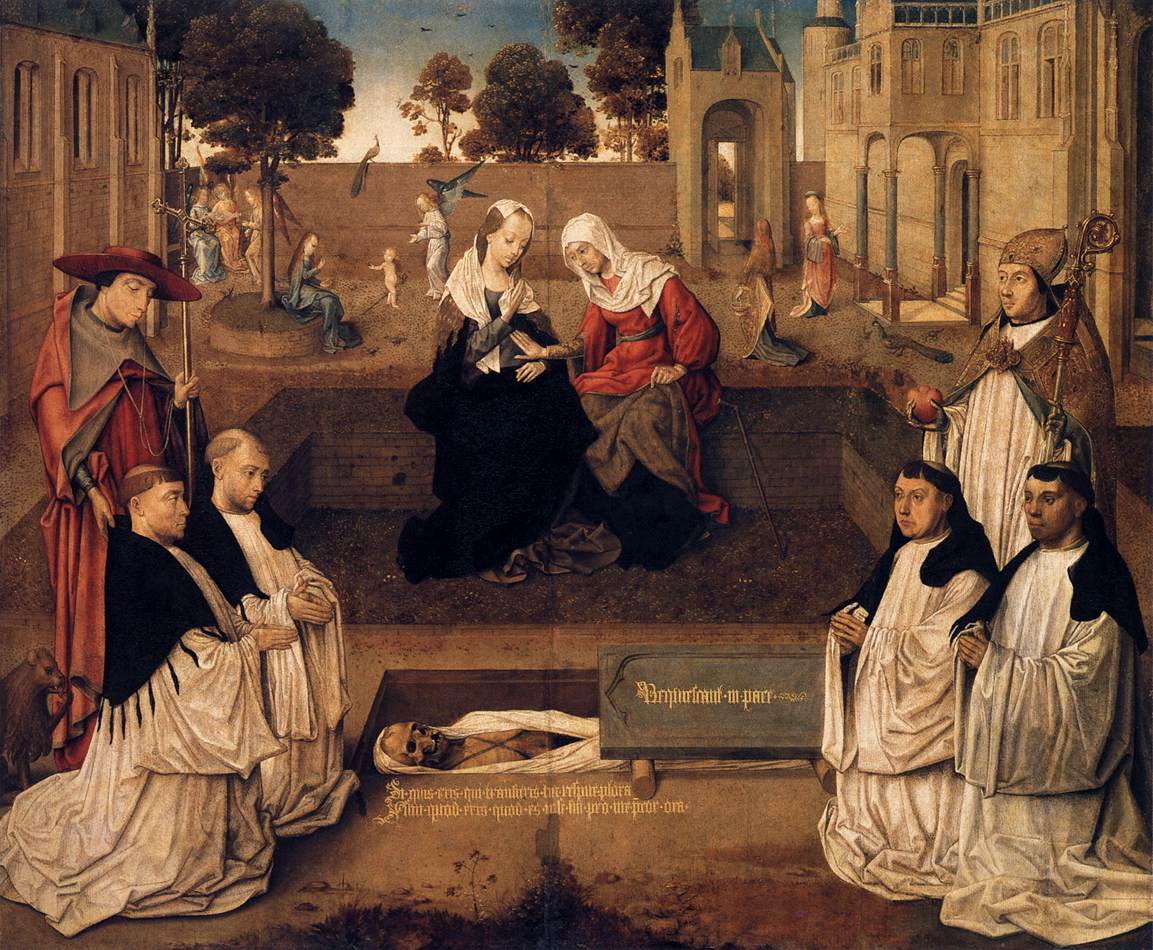 Visitation Momento mori, painter unknown, c.1500, juxtaposing pregnancy and death, with four Augustinan canons regular of the Chapter (Abbey) of Sion. Left, with little lion, is St Jerome; right, holding a heart, is St Augustine. Rijksmuseum[431] Until Erasmus received his (1505 and 1517) Papal dispensations to wear clerical garb, Erasmus wore versions of the local habit of his order, the Canons regular of St Augustine, Chapter of Sion, which varied by region and house, unless traveling: in general, a white or perhaps black cassock with linen and lace choir rochet for liturgical contexts or sarotium (scarf), almuce (cape), perhaps with an asymmetrical black cope of cloth or sheepskin (Latin: cacullae) or long black cloak.[432] From 1505, and certainly after 1517, he dressed as a scholar-priest.[433] He preferred warm and soft garments: according to one source, he arranged for his clothing to be stuffed with fur to protect him against the cold, and his habit counted with a collar of fur which usually covered his nape.[433] All Erasmus' portraits show him wearing a knitted scholar's bonnet.[434] Signet ring and personal motto Signet rings of Erasmus of Rotterdam: Amerbach Kabinett 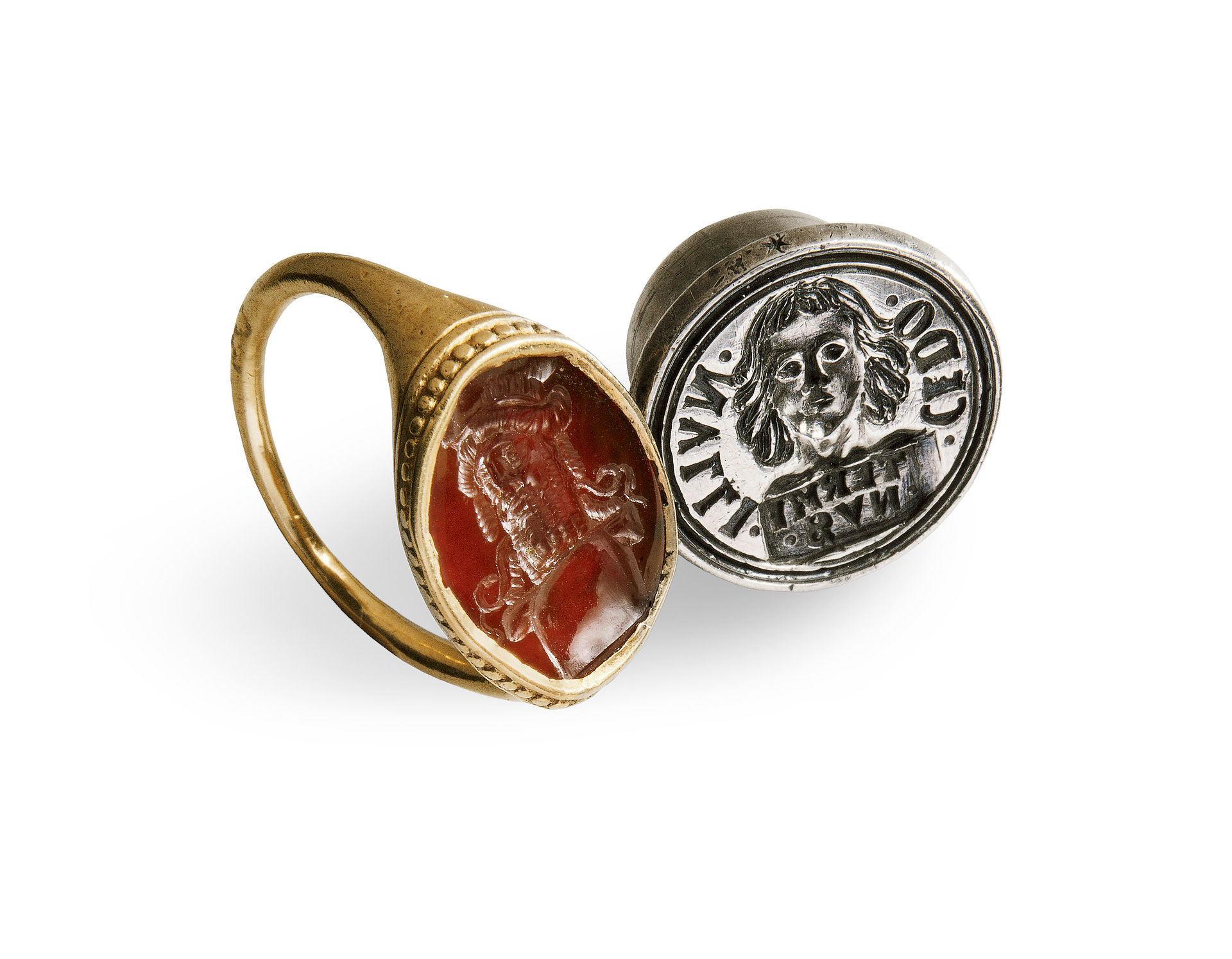 Erasmus chose the Roman god of borders and boundaries Terminus as a personal symbol[435] and had a signet ring with a herm he thought depicted Terminus carved into a carnelian.[435] The herm was presented to him in Rome by his student Alexander Stewart and in reality depicted the Greek god Dionysus.[436] The ring was also depicted in a portrait of his by the Flemish painter Quentin Matsys.[435] 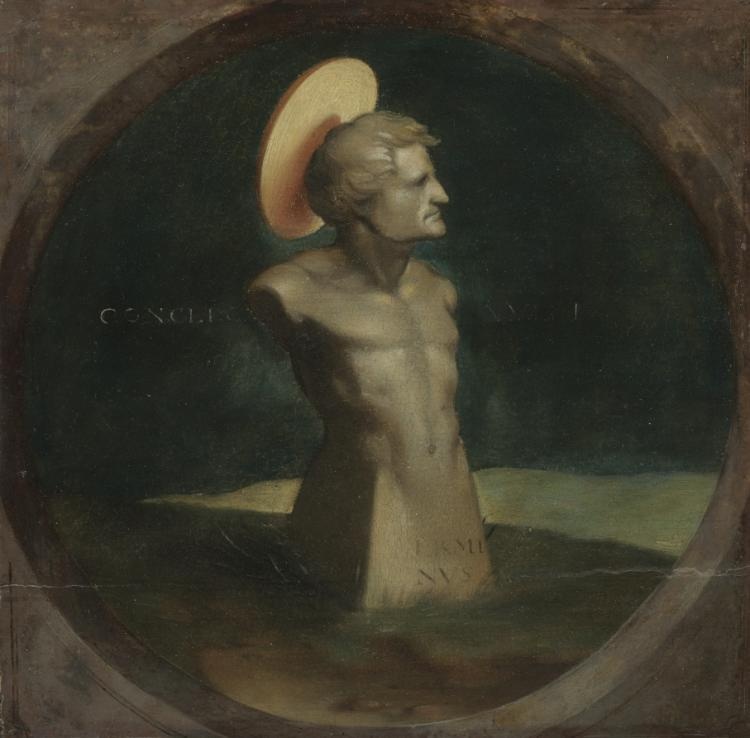 Painting of Erasmus as Terminus by Hans Holbein the Younger[437] The herm became part of the Erasmus branding at Froben, and is on his tombstone.[438]: 215 In the early 1530s, Erasmus was portrayed as Terminus by Hans Holbein the Younger.[437] 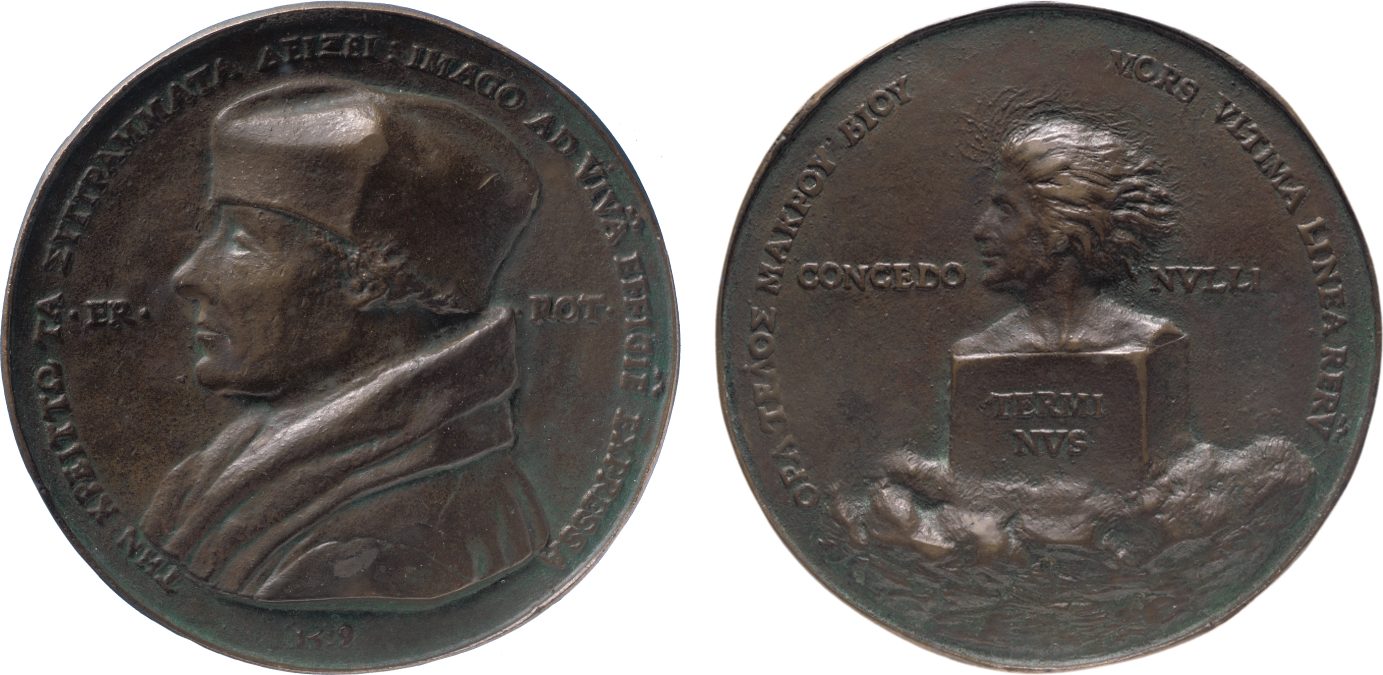 Quinten Metsys (Massijs), medal commissioned by Desiderius Erasmus. 1519, bronze, 105 mm He chose Concedo Nulli (Lat. I concede to no-one) as his personal motto.[439] The obverse of the medal by Quintin Matsys featured the Terminus herm. Mottoes on medals, along the circumference, included "A better picture of Erasmus is shown in his writing",[440] and "Contemplate the end of a long life" and Horace's "Death is the ultimate boundary of things,"[438]: 215 which re-casts the motto as a memento mori. Representations  Portrait of Desiderius Erasmus by Albrecht Dürer, 1526, engraved in Nuremberg, Germany 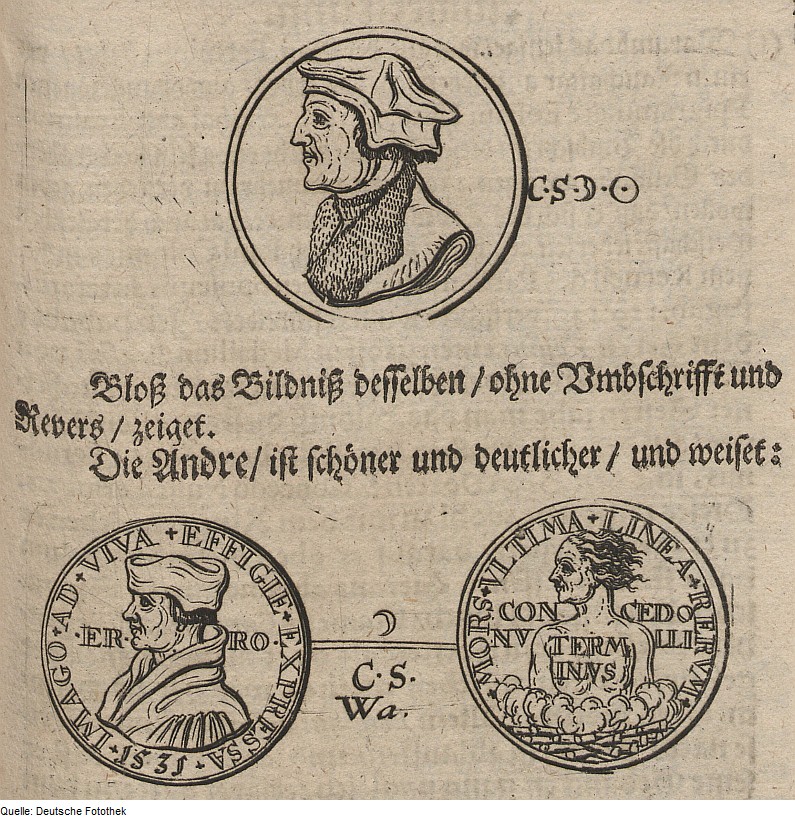 Commemorative coins or medals of Erasmus by Göbel, Georg Wilhelm (1790) Main article: Portrait of Erasmus of Rotterdam Erasmus frequently gifted portraits and medals with his image to friends and patrons. Hans Holbein painted him at least three times and perhaps as many as seven, some of the Holbein portraits of Erasmus surviving only in copies by other artists. Holbein's three profile portraits – two (nearly identical) profile portraits and one three-quarters-view portrait – were all painted in the same year, 1523. Erasmus used the Holbein portraits as gifts for his friends in England, such as William Warham, the Archbishop of Canterbury. (Writing in a letter to Warham regarding the gift portrait, Erasmus quipped that "he might have something of Erasmus should God call him from this place.") Erasmus spoke favourably of Holbein as an artist and person but was later critical, accusing him of sponging off various patrons whom Erasmus had recommended, for purposes more of monetary gain than artistic endeavor. There were scores of copies of these portraits made in Erasmus' time.[441] Holbein's 1532 profile woodcut was particularly lauded by those who knew Erasmus.[80]: 129 Albrecht Dürer also produced portraits of Erasmus, whom he met three times, in the form of an engraving of 1526 and a preliminary charcoal sketch. Concerning the former Erasmus was unimpressed, declaring it an unfavorable likeness of him, perhaps because around 1525 he was suffering severely from kidney stones.[80]: 129 Nevertheless, Erasmus and Dürer maintained a close friendship, with Dürer going so far as to solicit Erasmus's support for the Lutheran cause, which Erasmus politely declined. Erasmus wrote a glowing encomium about the artist, likening him to famous Greek painter of antiquity Apelles. Erasmus was deeply affected by his death in 1528. Quentin Matsys produced the earliest known portraits of Erasmus, including an oil painting from life in 1517[442] (which had to be delayed as Erasmus' pain distorted his face)[80]: 131 and a medal in 1519.[443] In 1622, Hendrick de Keyser cast a statue of Erasmus in (gilt) bronze replacing an earlier stone version from 1557, itself replacing a wooden one of 1549, possibly a gift from the City of Basel. This was set up in the public square in Rotterdam, and today may be found outside the St. Lawrence Church. It is the oldest bronze statue in the Netherlands.[444] In 1790, Georg Wilhelm Göbel struck commemorative medals.' Canterbury Cathedral, England has a statue of Erasmus on the North Face, placed in 1870. Actor Ken Bones portrays Erasmus in David Starkey's 2009 documentary series Henry VIII: The Mind of a Tyrant Exhumation In 1928, the site of Erasmus' grave was dug up, and a body identified in the bones and examined.[433] In 1974, a body was dug up in a slightly different location, accompanied by an Erasmus medal. Both bodies have been claimed to be Erasmus'. However, it is possible neither is.[445] |
パーソナル 衣服  1500年頃、画家不詳。妊娠と死を並置し、シオン修道会の4人のアウグスティヌス修道士が描かれている。左は小さなライオンを持つ聖ジェローム、右は心 臓を持つ聖アウグスティヌス。ライクス博物館[431] エラスムスが1505年と1517年に教皇から聖職者の服装を着用する許可を受けるまで、エラスムスは自分の修道会であるシオン会聖アウグスティヌス修道 会の地域的な習慣を着用していた: 一般的には、白またはおそらく黒のカソックに、典礼用のリネンとレースの聖歌隊のロシェ、またはサロティウム(スカーフ)、アルムーチェ(マント)、おそ らく非対称の黒い布または羊の皮のマント(ラテン語でcacullae)、または長い黒いマント。 [432] 1505年以降、そして1517年以降、エラスムスは学者司祭のような服装を好むようになった[433]。ある資料によれば、彼は寒さから身を守るために 衣服に毛皮を詰め込むよう手配し、彼の習慣には通常うなじを覆う毛皮の襟がつけられていた[433]。 エラスムスの肖像画にはすべて、ニットの学者用ボンネットをかぶった姿が描かれている[434]。 シグネットリングとモットー  ロッテルダムのエラスムスのシグネットリング: アメルバッハ・カビネット エラスムスはローマ神話の国境と境界の神テルミヌスを個人的なシンボルとして選び[435]、テルミヌスを描いたと思われる紋章がカーネリアンに彫られた シグネットリングを持っていた[435]。この紋章はローマで弟子のアレクサンダー・スチュワートから贈られたもので、実際にはギリシャ神話のディオニュ ソスを描いていた[436]。  若きハンス・ホルバインによるテルミヌスとしてのエラスムスの絵画[437]。 この絵はフロベンのエラスムス・ブランドの一部となり、エラスムスの墓碑にも刻まれている[438]: 215 1530年代初頭、エラスムスはハンス・ホルバインによってターミナスとして描かれた[437]。  デシデリウス・エラスムスの注文によるメダル。1519年、ブロンズ、105mm クィンティン・マツィスによるメダルの裏面には、テルミヌスの紋章が描かれている[439]。円周に沿ったメダルのモットーには、「エラスムスのより良い 姿は彼の著作に示されている」[440]、「長い人生の終わりを思い浮かべよ」、ホレウスの「死は物事の究極の境界である」[438]などがある。 表象  アルブレヒト・デューラーによるデジデリウス・エラスムスの肖像、1526年、ドイツのニュルンベルクで彫られたもの。  ゲーベル、ゲオルク・ヴィルヘルムによるエラスムスの記念コインまたはメダル(1790年) 主な記事 ロッテルダムのエラスムスの肖像画 エラスムスは、友人やパトロンに肖像画やメダルを頻繁に贈っていた。 ハンス・ホルバインは少なくとも3回、おそらく7回もエラスムスを描いたが、ホルバインが描いたエラスムスの肖像画のいくつかは、他の画家による模写とし てのみ現存している。ホルバインの3枚の横顔の肖像画は、2枚(ほぼ同じ)の横顔の肖像画と1枚の四分の三姿の肖像画で、すべて同じ年の1523年に描か れている。エラスムスはホルバインの肖像画を、カンタベリー大司教のウィリアム・ウォーハムなどイギリスの友人への贈り物として使った。(贈られた肖像画 についてウォーラムに宛てた手紙の中で、エラスムスは「神がこの地から彼を召されるとき、彼はエラスムスの何かを持っているかもしれない」と口にしてい る)。エラスムスはホルバインを芸術家として、また人間として好意的に語ったが、後に批判的になり、芸術的な努力よりも金銭的な利益のために、エラスムス が推薦した様々なパトロンから金を巻き上げていると非難した。エラスムスの時代には、これらの肖像画の複製が数多く制作された[441]。ホルバインの 1532年の横顔の木版画は、エラスムスを知る人々から特に称賛された[80]: 129 アルブレヒト・デューラーもまた、1526年のエングレーヴィングと木炭による下絵という形で、3度会ったエラスムスの肖像画を制作した。前者についてエ ラスムスは、1525年頃、腎臓結石にひどく悩まされていたためか、自分の似顔絵としては好ましくないと断じ、感銘を受けなかった[80]: 129 それにもかかわらず、エラスムスとデューラーは親密な友情を保ち、デューラーはルター派の大義への支援をエラスムスに求めるまでになったが、エラスムスは 丁重に断った。エラスムスはこの画家について、古代ギリシャの有名な画家アペレスになぞらえて熱烈な賛辞を送っている。エラスムスは1528年の彼の死に 深く心を打たれた。 クエンティン・マティスは、1517年[442]にエラスムスの肖像画を制作している(エラスムスの痛みが顔を歪ませたため、制作が遅れた)[80]: 131と1519年のメダル[443]がある。 1622年、ヘンドリック・ド・カイザーは、バーゼル市から贈られたと思われる1549年の木製の像に代わって、1557年の石造りの像に代わる(金色 の)ブロンズのエラスムス像を鋳造した。これはロッテルダムの公共広場に設置され、今日では聖ローレンス教会の外に置かれている。オランダ最古のブロンズ 像である[444]。 1790年、ゲオルク・ヴィルヘルム・ゲーベルが記念メダルを鋳造。 イギリスのカンタベリー大聖堂の北壁には、1870年に設置されたエラスムスの銅像がある。 俳優ケン・ボーンズは、デヴィッド・スターキーが2009年に制作したドキュメンタリーシリーズ『ヘンリー8世:暴君の心』でエラスムスを演じている。 埋葬 1928年、エラスムスの墓の跡地が掘り起こされ、遺骨の中から遺体が確認され、調査が行われた[433]。1974年には、エラスムスのメダルととも に、少し別の場所で遺体が掘り起こされた。どちらの遺体もエラスムスのものであると主張されている。しかし、どちらもエラスムスのものではない可能性があ る[445]。 |
| Works The Catalogue of the Works of Erasmus (2023)[446] runs to 444 entries (120 pages), almost all from the latter half of his life. Complete editions The Collected Works of Erasmus (or CWE) is an 89-volume set[447] of English translations and commentary from the University of Toronto Press. As of May 2023, 66 of 89 volumes have been released.[448] The Erasmi opera omni, known as the Amsterdam Edition or ASD, is a 65 volume set of the original Latin works. As of 2022, 59 volumes have been released. This set does not include the correspondence, which has been collected in a Latin edition by P.S. Allen. Letters 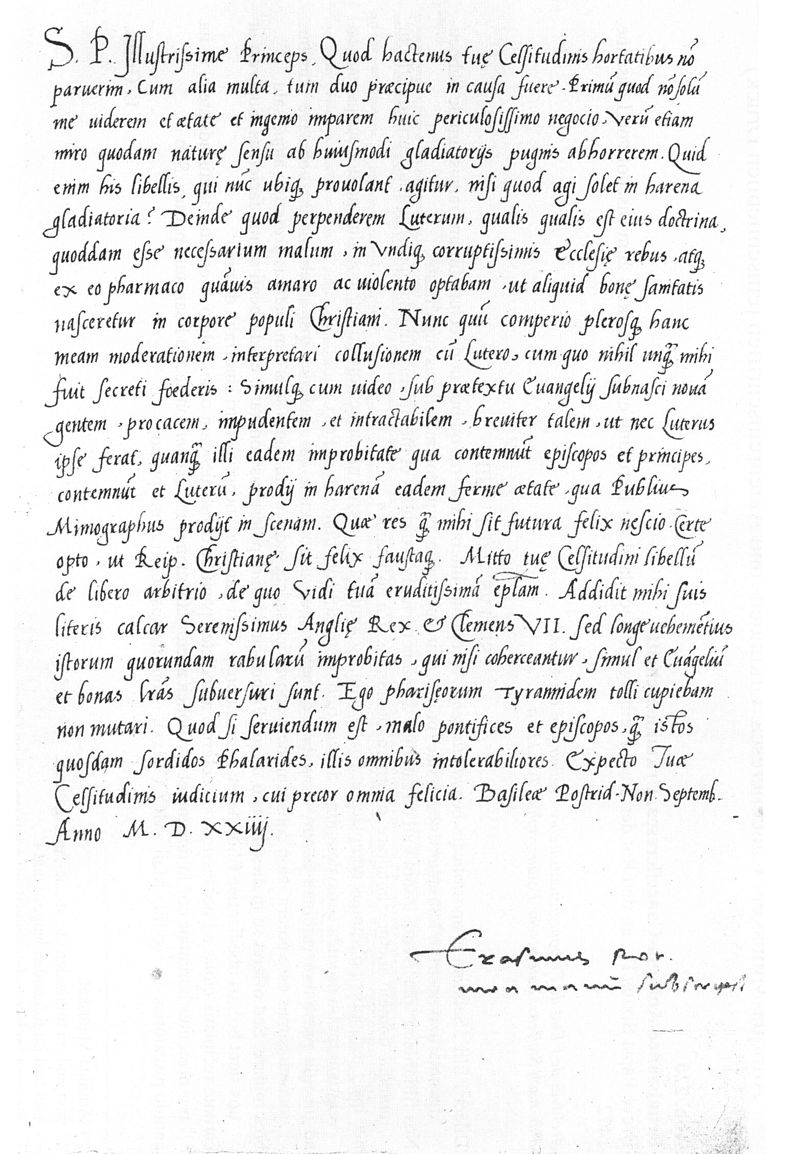 Erasmus, Letter to George, Duke of Saxony, (1524) giving Erasmus' view of Luther and the Reformation Main article: List of Erasmus's correspondents The best sources for the world of European Renaissance Humanism in the early sixteenth century is the correspondence of Erasmus. — Froude, "Preface", Life and Letters of Erasmus Erasmus wrote or answered up to 40 letters per day,[30] usually waking early in the morning and writing them in his own hand. Over 3,000 letters exist for a 52-year period, including to and from most Western popes, emperors, kings and their staff, as well as to leading intellectuals, bishops, reformers, fans, friends, and enemies. His letters have been published in translation in the Complete Works of Erasmus. This has been accompanied by a three-volume reference book Contemporaries of Erasmus giving biographies of the over 1900 individuals he corresponded with or mentioned.[449] His private letters were eventually written in the knowledge that they could be intercepted by hostile opponents; he revised and rewrote letters for publication; his letters have a high amount of accommodation of his correspondents' views and strong irony, and a tendency to muddy the waters where danger is involve. "I have never censured anything but human superstition and abuses. I only wish that I could drag the universal church to where I was struggling to lead it, so that, throwing off superstition, hypocrisy, worldly attachments, and frivolous little questions, we would all serve the Lord with pure hearts, each in his own vocation." — Erasmus, Letter to Jean de Carondelet (1534)[450] Religious and political 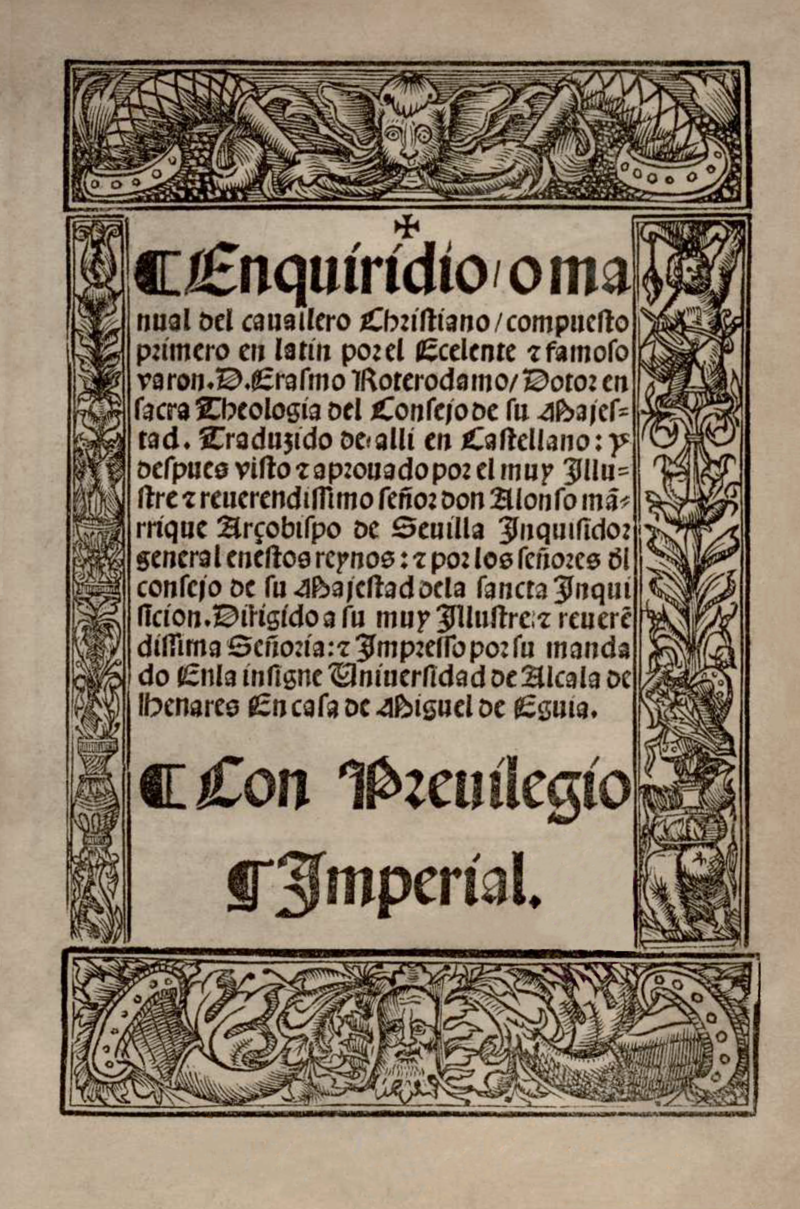 Enchiridion militis Christiani (1503). Enchiridion militis Christiani (1503), Spanish translation 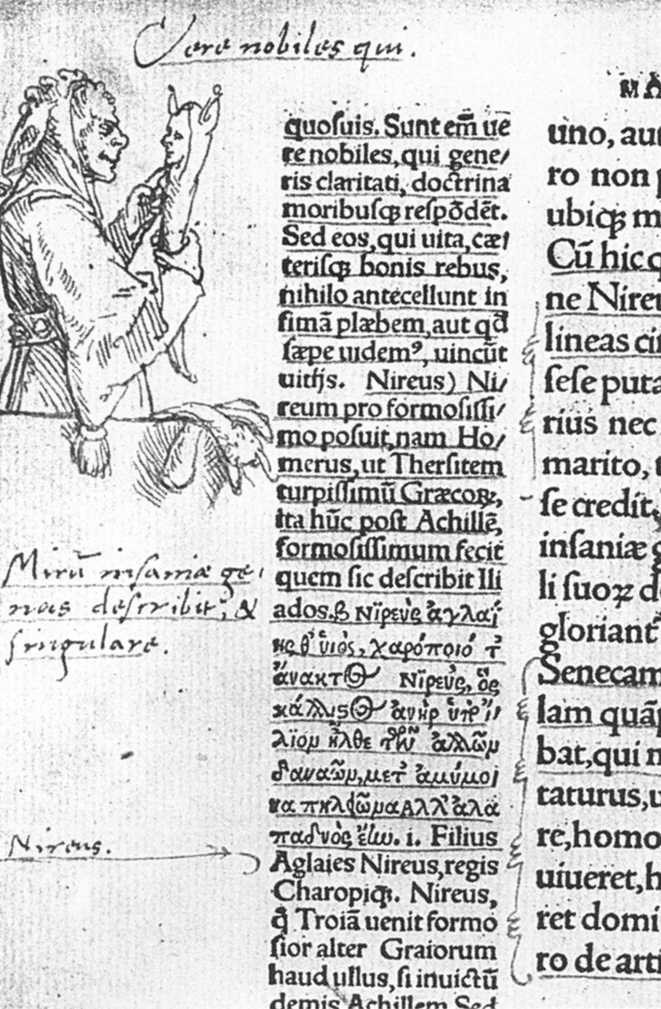 Marginal drawing of Folly by Hans Holbein in the first edition of Erasmus's Praise of Folly, 1515 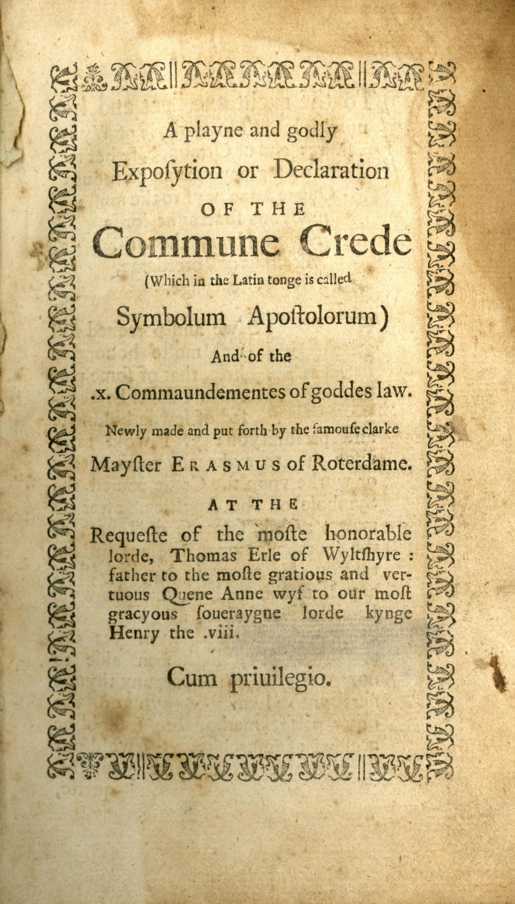 A Playne and Godly Exposition or Declaration of the Commune Crede, 2nd edition, 1533, English translation of Symbolum apostolorum Handbook of a Christian Knight (Latin: Enchiridion militis Christiani) (1503) The Silenus of Alcibiadis (Latin: Sileni alcibiadis (1515) The Education of a Christian Prince (Institutio principis Christiani) (1516) The Quarrel of Peace (Latin: Querela pacis) (1517) (English translation[451]) On the Immense Mercy of God (Latin: De immensa misericordia dei) (1524) On Free Will (Latin: De libero arbitrio diatribe sive collatio) (1524) Hyperaspistes 2 volumes (1526) The Institution of Christian Marriage (Latin: Institutio matrimonii) (1526)[289] Consultations on the War on the Turks (Latin: Consultatio de bello turcis inferendo) (1530) On the Preparation for Death (Latin: De praeparatione ad mortem) (1533) On the Apostles' Creed (Latin: Symbolum apostolorum) The Preacher (Latin: Ecclesiastes) (1535) Comedy and satire The Praise of Folly (Greek: Moriae encomium - Latin: Stultitiae laus) (1511) (English translations[452]) Preface to Plutarch's How to tell a Flatterer from a Friend (1514) (Dedication to Henry VIII) Julius Excluded from Heaven (1514) (attrib.) Colloquies (Colloquia) (1518) (English translation [453]) Ciceronianus (1528) Culture and education Adages (Latin: Adagiorum collectanea) (1500) all editions usually called Adagia Three Thousand Adages (Latin: Adagiorum chilliades tres) (1508) Four Thousand Adages (Latin: Adagiorum ciliades quatuor) (1520) Foundations of the Abundant Style (Latin: De utraque verborum ac rerum copia) (1512) often called De copia Introduction to the Eight Parts of Speech (Latin: De constructione octo partium prationis) (1515) - Erasmus' version of Lily's Grammar, sometimes called Brevissima Institutio Language, or the uses and abuses of language, a most useful book, (Latin: Lingua, Sive, De Linguae usu atque abusu Liber utillissimus) (1525) On the Correct Pronunciation of Latin and Greek (Latin: De recta Latini Graecique sermonis pronuntiatione) (1528) On Early Liberal Education for Children (Latin: De pueris statim ac liberaliter instituendis) (1529) On Civility in Children (Latin: De civilitate morum puerilium) (1530) Apophthegmatum opus (1531) includes Opusculi plutarchi (c.1514) includes How to tell a flatterer from a friend New Testament The 1516 edition had Erasmus' corrected Vulgate Latin and Greek versions.[454] The subsequent revised editions had Erasmus' new Latin version and the Greek. The 1527 edition had both the Vulgate and Erasmus' new Latin with the Greek. These were accompanied by substantial annotations, methodological notes and paraphrases, in separate volumes. Novum Instrumentum omne (1516) Novum Testamentum omne (1519, 1522, 1527,1536) In Novum Testamentum annotationes (1519, 1522, 1527,1535) Paraphrases of Erasmus (1517–1524) The first tome or volume of the Paraphrase of Erasmus vpon the newe testamente (1548) Patristic and classical editions 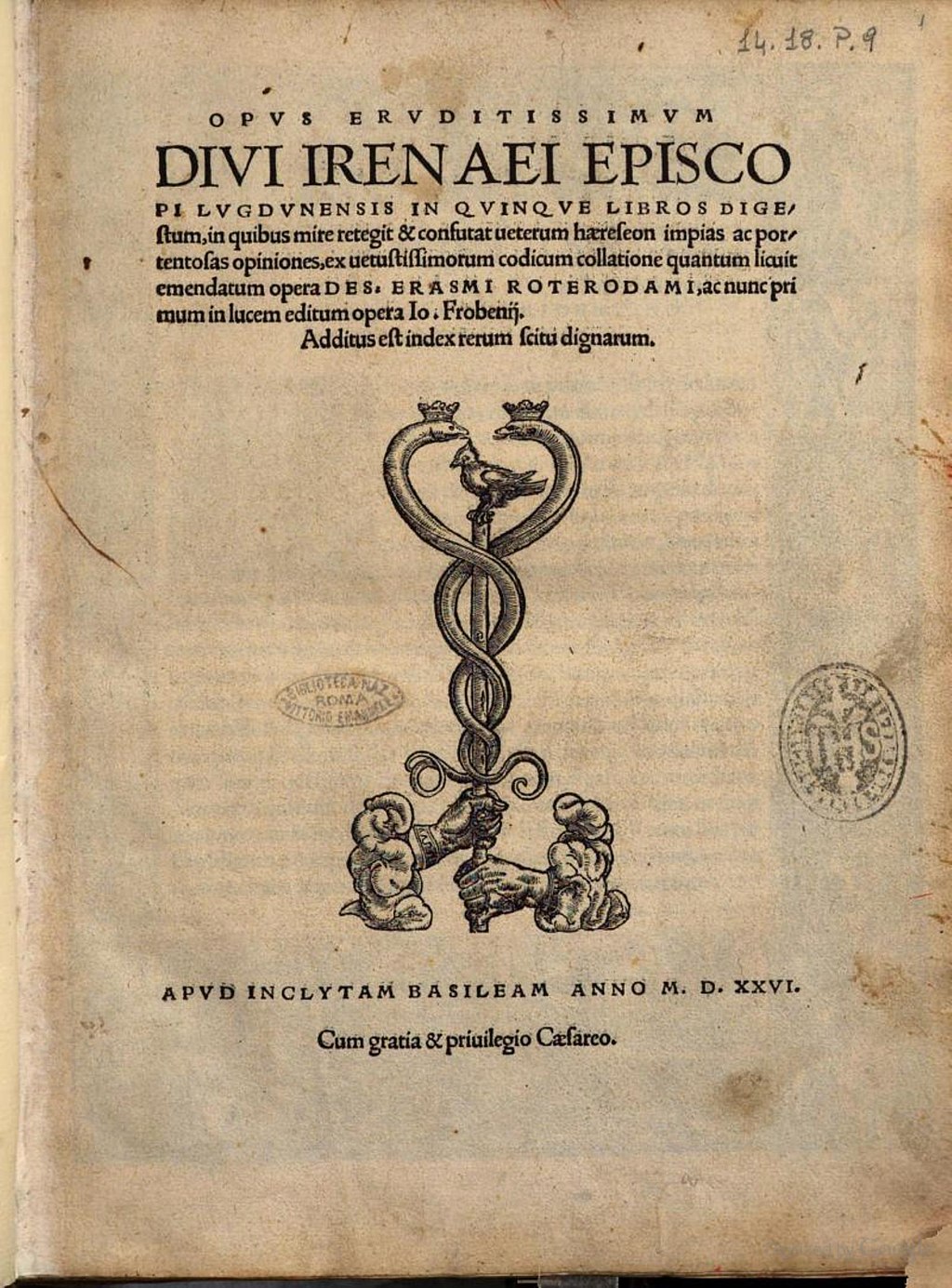 The title page of the princeps edition of Irenaeus's Against heresies, which was published by Erasmus at Johannes Froben's, Basel, 1526. Froben was keen to exploit Erasmus' name as a brand: for the patristic and classical editions that came out under his name[455] Erasmus was variously commissioning editor, acquisitions editor, and supervising editor often working with others. He was usually the primary translator and contributed at least prefaces, notes and biographies.[456] Complete Works of Jerome, nine volumes (1516) with biography, ed. ii (1526), ed. iii (1537, posthumous) Complete Works of Cyprian (1520–21) Commentary on the Psalms Arnobius the Younger (1522) Complete Works of Hilary of Poitiers (1523) Against Heresies, Irenaeus (1526) Complete Works of Ambrose (and Ambrosiaster), four volumes (1527) Origens Fragments on Matthew (1527) Works of Athanasius of Alexandria (1522–1527) On Grace (De gratia or Latin: De gratia Dei et humanae mentis libero arbitrio opus insigne)[223] Faustus of Riez (1528) Complete Works of Augustine (1528, 1529) Works of Lactantius (1529) Epiphanius (1529) Complete Works of John Chrysostom, five volumes (1525–1530) with biography Works of Basil of Caesarea (1530) Homilies of Gregory of Nazianzus (1531) Complete Works of Origen, two volumes (1536) with biography (posthumous) Late in his publishing career, Erasmus produced editions of two relatively obscure pre-scholastic but post-patristic writers: On the sacrament of the Lord's body and blood (Latin: De sacramento corporis et sanguinis Domini) Alger of Liège c.1111 (ed. 1530)[note 199] Commentary on Psalms of Haymo of Halberstadt attrib. c.835 (ed. 1533) Classical writers whose works Erasmus translated or edited include Lucian (1506), Euripides (1508), Pseudo-Cato (1513), Curtius (1517), Suetonius (1518), Cicero (1523), Ovid and Prudentius (1524), Galen (1526), Seneca (1515, 1528), Plutarch (1512–1531), Aristotle (1531, Introduction to edition of Simon Grynaeus), Demosthenes (1532), Terence (1532), Ptolemy (1533), as well as Livy, Pliny, Libanius, Galen, Isocrates and Xenophon. Many of the Adagia translate adages from ancient and classical sources, notably from Aesop; many of Apophthegmata are from Platonists or Cynics. |
著作 『エラスムス著作目録』(2023年)[446]は444項目(120ページ)に及び、そのほとんどが生涯の後半に書かれたものである。 全集 The Collected Works of Erasmus (CWE)は、トロント大学出版局による英訳と解説の89巻セット[447]。2023年5月現在、89巻中66巻が発売されている[448]。 アムステルダム版またはASDとして知られるErasmi opera omniは、オリジナルのラテン語作品の65巻セットである。2022年現在、59巻がリリースされている。このセットには書簡は含まれておらず、 P.S.アレンによってラテン語版が出版されている。 書簡  ルターと宗教改革についてのエラスムスの見解を述べた、ザクセン公ジョージへの書簡(1524年) 主な記事 エラスムスの文通相手リスト 16世紀初頭のヨーロッパ・ルネサンス人文主義の世界を知るための最良の資料は、エラスムスの書簡である。 - エラスムスの生涯と書簡』フロイド「序文 エラスムスは1日に40通もの手紙を書いたり、返事を書いたりした[30]。52年間にわたる3,000通を超える手紙は、西洋のほとんどの教皇、皇帝、 国王とそのスタッフ、また一流の知識人、司教、改革者、ファン、友人、敵との往復を含む。 彼の書簡は、エラスムス全集として翻訳出版されている。また、3巻からなる参考書『Contemporaries of Erasmus(エラスムスの同時代人)』では、エラスムスが手紙のやり取りをした、あるいは言及した1900人以上の人物の伝記が掲載されている [449]。 彼の私的な手紙は、敵対する相手に傍受される可能性があることを承知の上で書かれたものであり、出版のために手紙を修正し、書き直したものである。 「私は、人間の迷信や乱用以外のものを非難したことはない。迷信、偽善、世俗的な執着、軽薄な小さな疑問を捨て去り、それぞれが自分の召命において、純粋 な心で主に仕えることができるように。" - エラスムス、ジャン・ド・カロンドレへの手紙(1534年)[450]。 宗教と政治  Enchiridion militis Christiani (1503). Enchiridion militis Christiani (1503) スペイン語訳  ハンス・ホルバインによるエラスムスの『愚行礼讃』初版(1515年)の「愚行」の傍線画  コミューン・クレデの戯曲的かつ神学的な説明または宣言』(第2版、1533年)、Symbolum apostolorumの英語訳 キリスト教騎士の手引書(ラテン語:Enchiridion militis Christiani) (1503) アルシビアディスのシレヌス (ラテン語: Sileni alcibiadis (1515)) キリスト教王子の教育 (Institutio principis Christiani) (1516) 平和の喧嘩 (ラテン語: Querela pacis) (1517) (英訳[451) 神の慈悲について (ラテン語: De immensa misericordia dei) (1524) 自由意志について (ラテン語: De libero arbitrio diatribe sive collatio) (1524) ハイペラスピステス 2巻(1526年) キリスト教の結婚制度(ラテン語: Institutio matrimonii)(1526年)[289]。 対トルコ戦争に関する協議 (Consultatio de bello turcis inferendo) (1530) 死の準備について(ラテン語: De praeparatione ad mortem) (1533) 使徒信条について(ラテン語: Symbolum apostolorum) 説教者 (ラテン語: Ecclesiastes) (1535) 喜劇と風刺 愚行礼賛(ギリシア語: Moriae encomium - ラテン語: Stultitiae laus) (1511) (英訳[452) プルタークの『友人と佞臣の見分け方』への序文(1514年)(ヘンリー8世に献呈) 天国から追放されたユリウス』(1514)(帰属) 談話集(コロキア) (1518) (英語訳[453]) キケロニアヌス (1528) 文化と教育 アダージェ (ラテン語: Adagiorum collectanea) (1500) 通常アダージェと呼ばれるすべての版 三千の格言 (ラテン語: Adagiorum chilliades tres) (1508) 四千のアダージェ(ラテン語:Adagiorum ciliades quatuor) (1520) 豊かな文体の基礎 (ラテン語: De utraque verborum ac rerum copia) (1512) しばしばDe copiaと呼ばれる。 八品詞序説(ラテン語:De constructione octo partium prationis)(1515) - エラスムス版『リリーの文法』、Brevissima Institutioと呼ばれることもある。 言語、または言語の使用と乱用、最も有用な書物、(ラテン語:Lingua, Sive, De Linguae usu atque abusu Liber utillissimus) (1525) ラテン語とギリシア語の正しい発音について (Latin: De recta Latini Graecique sermonis pronuntiatione) (1528) 子供の早期教養教育について (Latin: De pueris statim ac liberaliter instituendis) (1529) 子供の礼節について (Latin: De civilitate morum puerilium) (1530) 黙示録(1531年) プルタルキ作品集(1514年頃)を含む お世辞を言う人と友人を見分ける方法(How to tell a flatrer from a friend)を含む。 新約聖書 1516年版は、エラスムスの修正したヴルゲート語のラテン語版とギリシア語版であった[454]。その後の改訂版は、エラスムスの新しいラテン語版とギ リシア語版であった。1527年版には、ヴルガータ版とエラスムスの新しいラテン語版とギリシャ語版の両方があった。これらには、かなりの注釈、方法論的 注釈、パラフレーズが別巻で付されていた。 ノヴム インストゥルメンタム オムネ (1516) Novum Testamentum omne (1519, 1522, 1527,1536) Novum Testamentum annotationes (1519, 1522, 1527,1535) エラスムスのパラフレーズ (1517-1524) 新約聖書に関するエラスムスのパラフレーズ第1巻 (1548) 教皇庁版と古典版  1526年、バーゼルのヨハネス・フローベンでエラスムスが出版したイレナイオスの『異端への反論』(Princeps edition)のタイトルページ。 フロベンはエラスムスの名前をブランドとして利用することに熱心で、エラスムスの名前で出版された教父学的・古典的版[455]では、エラスムスは委託編 集者、アクイジション・エディター、監修編集者などさまざまな役割を担い、しばしば他の編集者と共同作業を行った。彼は通常第一の翻訳者であり、少なくと も序文、注、伝記を寄稿した[456]。 ジェローム全集』全9巻(1516年)、伝記付き、第2版(1526年)、第3版(1537年、遺稿)。 キプリアン全集(1520-21年) 詩篇解説 若きアルノビウス (1522) ポワチエのヒラリー全集(1523年) イレナイオス『異端論に抗して』(1526年) アンブローズ(とアンブロシアスター)全集 全4巻(1527年) マタイに関するオリゲンス断片(1527年) アレクサンドリアのアタナシウス著作集(1522-1527) 恩寵について(De gratiaまたはラテン語: 邦訳『恩寵と人間の精神的解放』(De gratia Dei et humanae mentis libero arbitrio opus insigne)[223] リエスのファウストゥス (1528) アウグスティヌス全集(1528年、1529年) ラクタンティウス著作集(1529年) エピファニウス(1529年) ヨハネ・クリュソストム全集 全5巻(1525-1530)伝記付 カイザリアのバジル著作集(1530年) ナジアンゾスのグレゴリウス講話集(1531年) オリゲン全集 2巻(1536年)伝記付き(死後) エラスムスは、出版活動の後半に、スコラ学以前の、しかし教父時代以降の、比較的無名の2人の作家の版本を出版した: 主の身体と血の秘跡について(ラテン語:De sacramento corporis et sanguinis Domini) 1111年頃のリエージュのアルジェ(1530年編集)[註 199] 。 ハルバーシュタットのヘイモの詩篇注解 835年頃(1533年版) エラスムスが翻訳・編集した古典作家には、ルキアヌス(1506年)、エウリピデス(1508年)、カトー擬(1513年)、クルティウス(1517 年)、スエトニウス(1518年)、キケロ(1523年)、オウィッドとプルデンティウス(1524年)、ガレノス(1526年)、 セネカ(1515、1528)、プルターク(1512-1531)、アリストテレス(1531、シモン・グリネウス版序文)、デモステネス(1532)、 テレンス(1532)、プトレマイオス(1533)、さらにリヴィ、プリニウス、リバニウス、ガレノス、イソクラテス、クセノフォンなど。Adagiaの 多くは、古代や古典、特にイソップからの格言を翻訳したもので、Apophthegmataの多くはプラトン主義者やキニクスのものである。 |
| https://en.wikipedia.org/wiki/Erasmus |
リンク
文献
その他の情報
Copyleft, CC, Mitzub'ixi Quq Chi'j, 1996-2099
☆
 ☆
☆